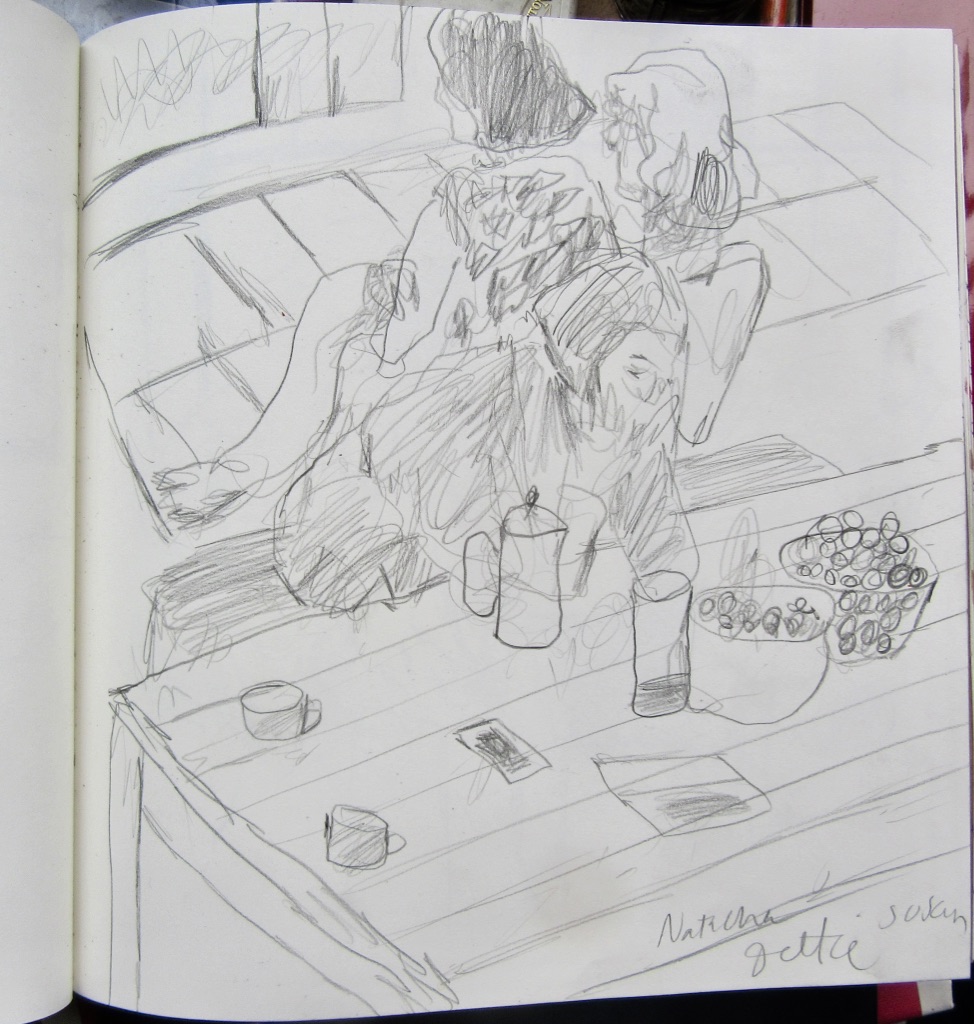Liza Dimbleby
April 2nd to April 9th
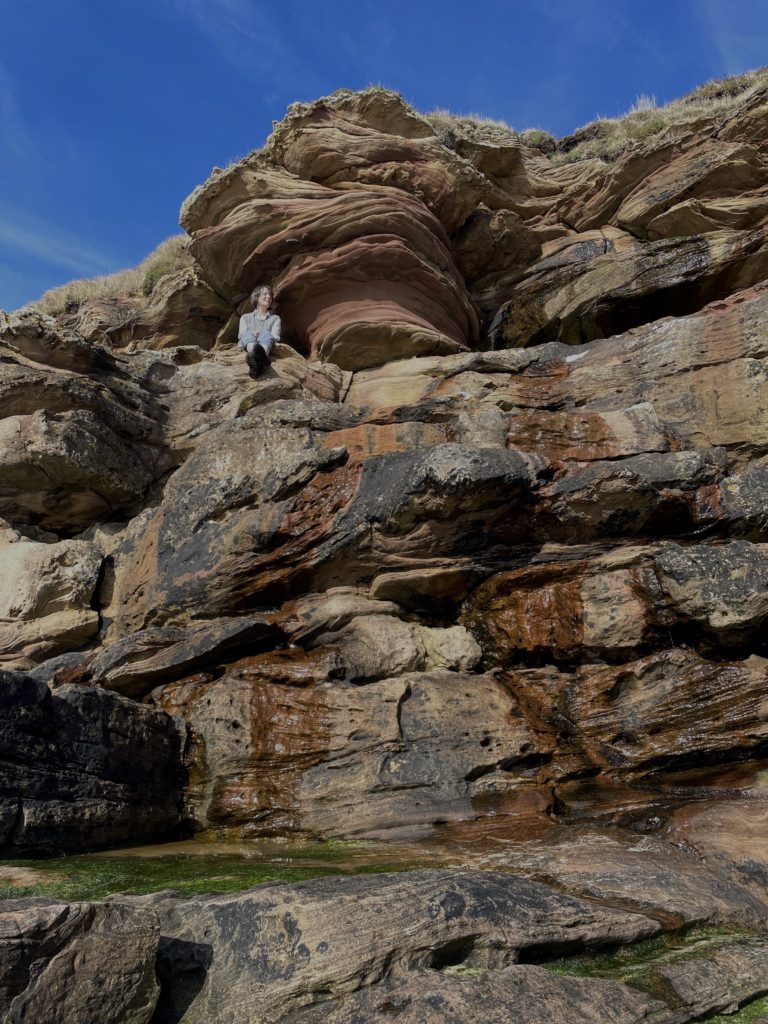
///cheeses.quarrel.poorly is the WHAT3WORDS location of Peedie Sands in Caithness, Scotland.
58°40′21″N03°22′31″W
January 16th to January 23rd
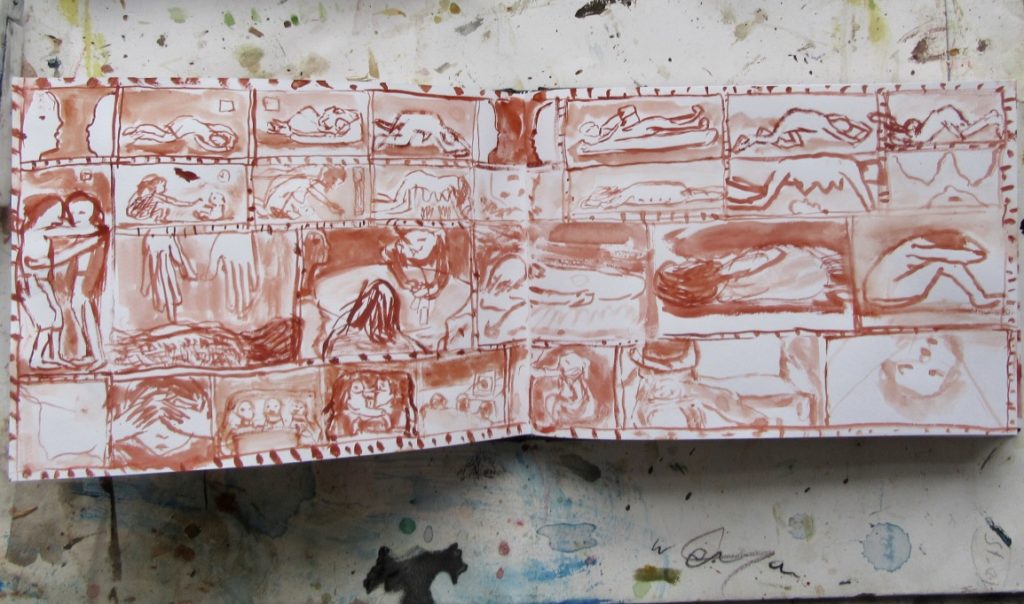
January 9th to January 16th

December 12th to December 19th
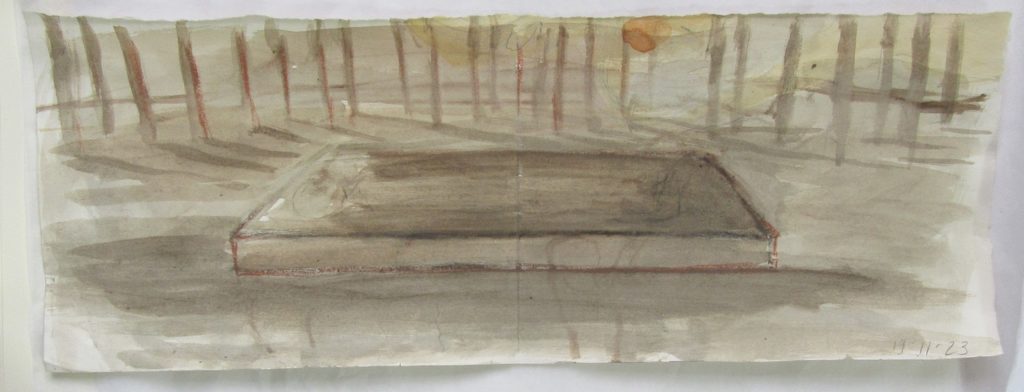
December 5th to December 12th
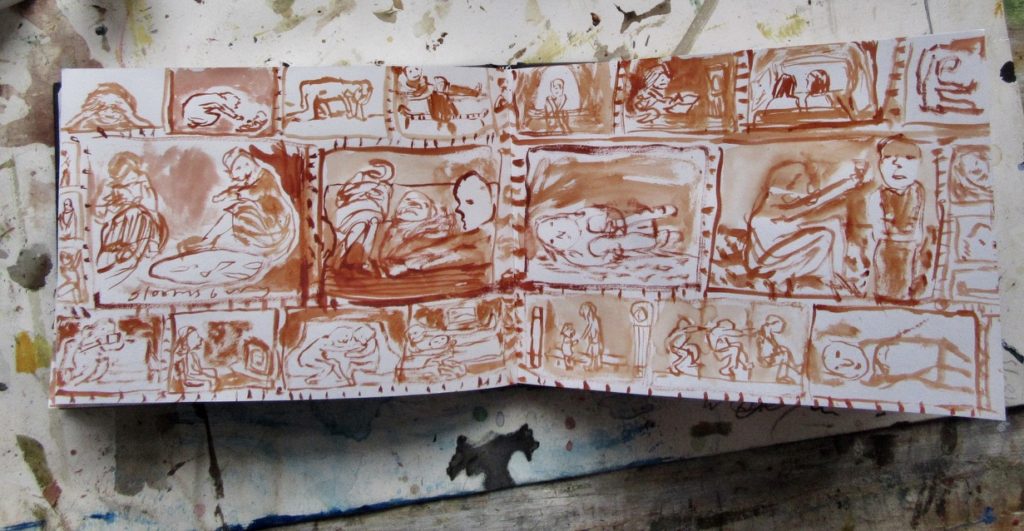
November 28th to December 5th

November 14th to November 21st

October 23rd to October 31st
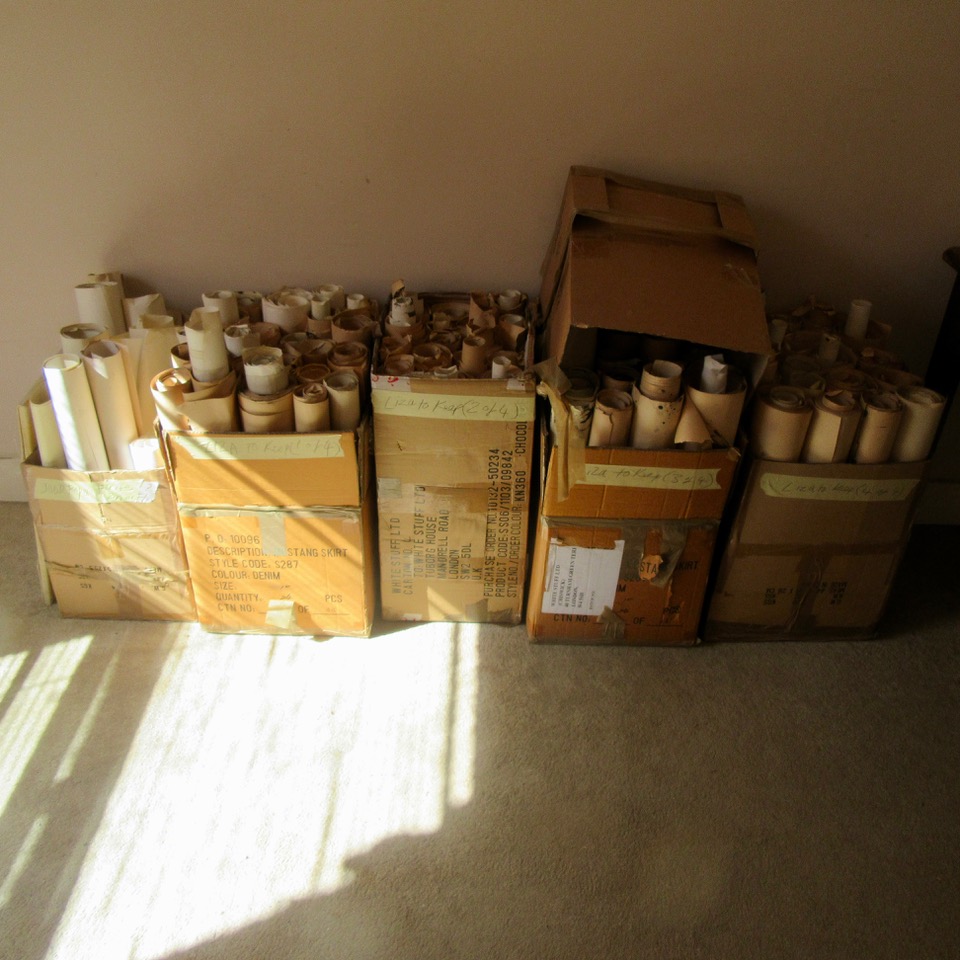
Letter from Glasgow: The Forgotten Music
I was in a charity shop with my daughter, rummaging among old coats at the end of the rail. Suddenly a song came on — a song I knew once but hadn’t heard for ages, it was sort of Northern Soul but it soared with a refrain that came back three times and felt like free-wheeling, soaring to the edge of a landscape. It thrilled me. It gave generously. I was surprised how good it felt to be away from my desk, chancing on songs amongst old clothes. I went to the counter and paid a few pounds for a striped sheet, a check tablecloth and a cellular wool blanket, the song was free.
We left the shop and were walking along the pavement when I realised that I couldn’t recall the song. The strength was not its words but the tune without words and I could not hook it back in. I wondered how to find it this song without words, without a title. How could I remember it?
We went to a performance at a gallery, where daubed canvases were raised on pulleys and women were rolled up and falling out of them, to a soundtrack of looped scrapes and cries. After the earnest discussion that followed we left the gallery. Just before we left, as I was washing my hands at the toilets, the song came bouncing back to me.. All of it. I was so happy, there it was inside me and it had decided to return to me, to cheer me along. I stepped out onto the pavement humming my song. At the bottom of a stone stairwell we stopped and I sang it to my daughter’s phone, as people passed by, to an app that recognises tunes, but to no avail. The app stayed blank and pulsing. So I kept on singing as we walked through the city to meet my friend. My daughter sang me a line of Bach back, we made a song between the two, call and response. We crossed the road, my friend was waving to us, and then suddenly — the song was gone! It had vanished as subtly as it appeared, and I had no trace of it. I kept trying, but all I got were the more obvious, less brilliant, tunes of the era. This one was not mine to summon. I had not heard it for so many years and now I didn’t know when I would hear it again. I had no clues by which to bring it back.
I think about it inside me, biding its time, resisting my call for it — this song that so delighted me, that returned to me twice, unbidden, yesterday, and then went on its way, went back inside me, perhaps never to return. When it was there I wanted to carry it, be carried by it. I did not think of recording the notes, making a digital imprint by which to catch and hold it. I thought that it was a part of me, that it would last forever. Now I’m waiting, wondering where within me it is hiding.
October 10th to October 17th
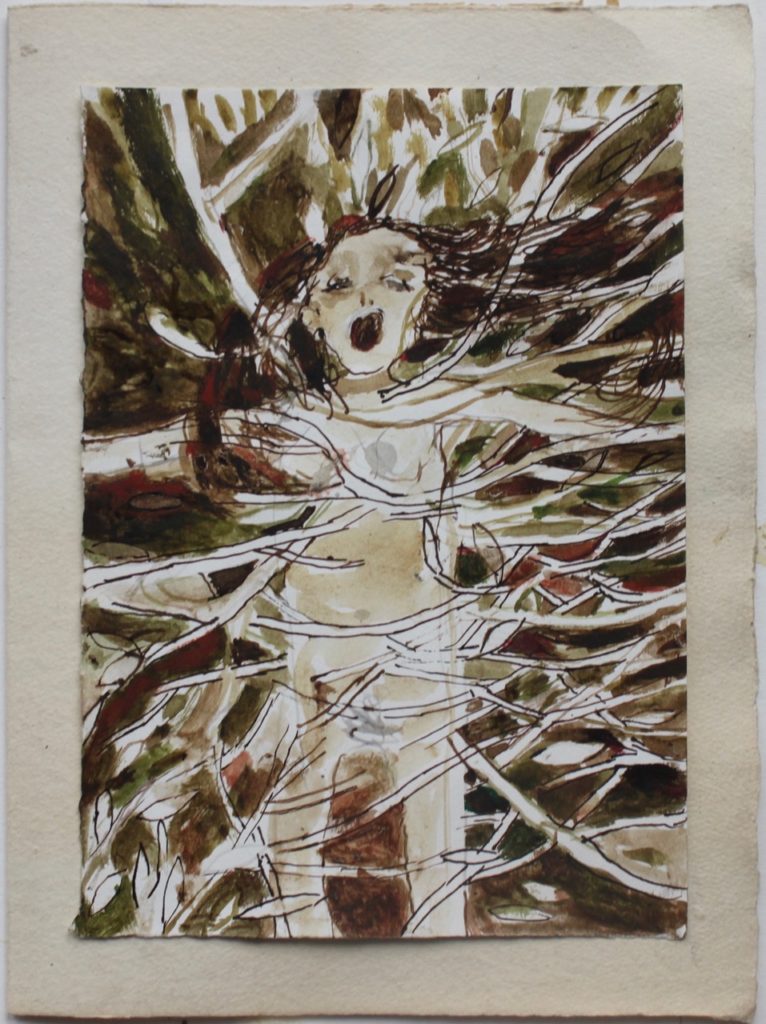
Letter from Glasgow: L’ Avenir au Bois Dormant or Philomela’s Cry
I spent much of the summer sorting — endless piles of paper, scrawled pages of notes and beginnings, false starts and interruptions, and hundreds of rolls of drawings that had been stored in an attic, unseen for thirty years. It was so hot in the small space that I unfurled the scrolls in my underwear and soon became trapped inside them, submerged by these unruly curls and screeds of yellowed paper, that sprung out and fast piled up about my body and over my head — a snaking chaos inscribed with thousands of drawings. I was afraid of not being able to escape and tore through some in my efforts to disentangle. When I managed to unravel myself, what surprised me was the consistency of the impulse that drove these inscriptions. My concerns, my reasons for marking paper at all, have not changed much. The difference is that thirty years ago I might have thought that all this restless writing and drawing would add up to something like an answer — that would prove ultimately freeing, and allow me to step out into a brave new and resonant world. I no longer expect this, and I let my drawings lie dormant. The violence of their release, their still-aliveness, took me by surprise.
I dreamed that I was standing in a group, we were playing chamber music. It was my turn to join the sound. I began my note, I knew the music. I thought, this may sound dissonant but soon it will find its place, it will join with the notes of the other players, we will find our harmony and be carried forth in one continuous many-layered sound. Together, we will sound. I opened my mouth. But my note jarred loud and uncomfortably discordant against the others, and I could not shift it. The sound came from my mouth but it was rough and plangent, it would not join the tune. I thought of the musical term stringendo which suggests not actual strings, nor stridency but rather an urgency, a gripping or tightening, a rushing towards the end, even a strangling.
Will we still want to dance tomorrow? It depends on what music is playing.
October 3rd to October 10th
Will we still want to dance tomorrow? It depends on what music is playing.
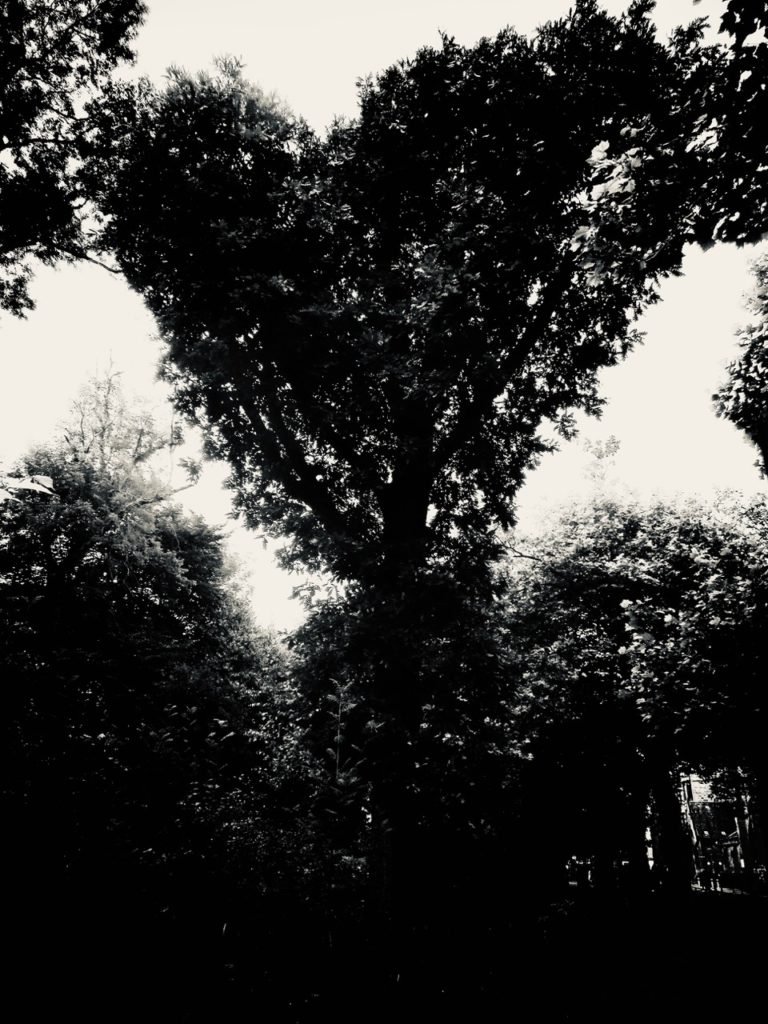
Dancing Oak, Glasgow 2023
That evening, when I had finished the drawing, I walked down the hill by my house. I stopped by a tree at the bottom of the hill. A tall oak, with arms raised up as if in greeting. Exultant. You could not hide in this one’s skirts, but her head is almost heart shaped.
Darach — the Celtic name for oak, or oak grove
She seemed to see all the oaks around her dancing, their lightning fork branches fizzing outwards with life.
My tree seemed to grow arms
how wonderful these oak trees were — like being hidden under your mother’s skirts
We sat under that huge skirt and were sheltered, a short while, from the future, as we looked across the field.
September 12th to September 19th

July 25th to August 1st
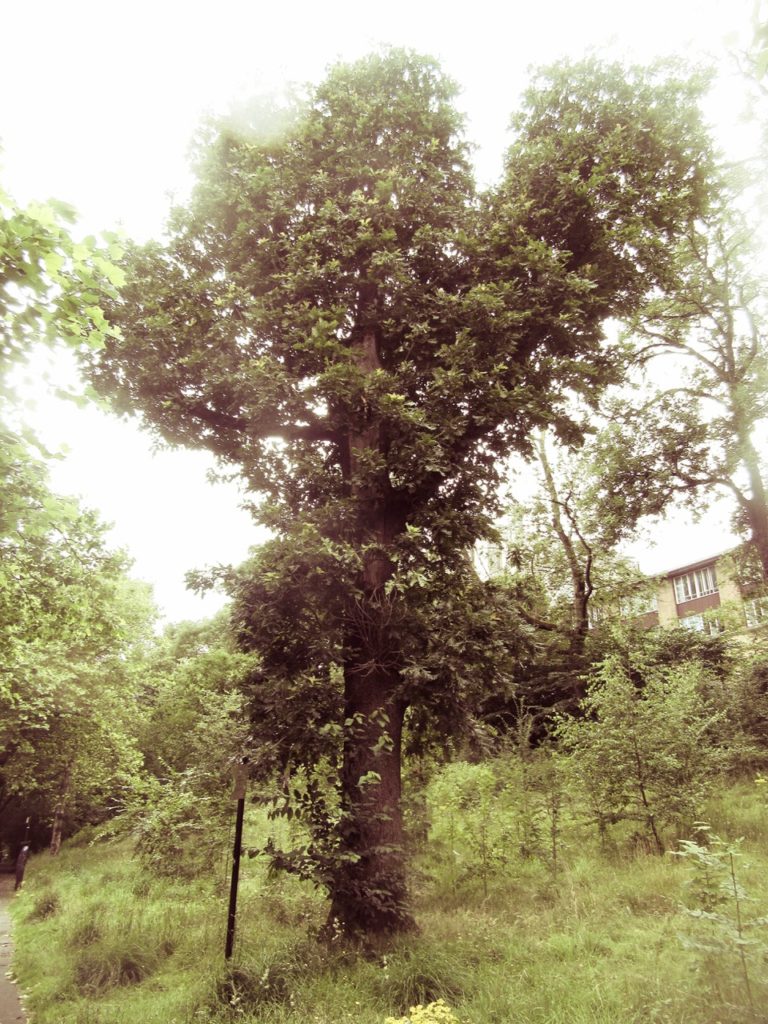
Letter from Glasgow: Living Oaks
Last month I went to visit my uncle in Devon. He is a sculptor, the only artist on my father’s side of the family, and he has always been important to me, a person who goes about things differently from his broadcasting brothers, an ally in the family fray. He showed me another way of speaking and thinking, and he works with clay. I used to model for him as a teenager, complex three-quarter reliefs, for which I often had to suspend my arm on a rope, but as I sat for him in his studio on long hot midsummer days we would talk about many things that I could not find words for, was unable to articulate, at home. We would spin metaphors back and forth as we tried to get closer to the oddities of experience. I relished his mixture of wit and awe, his willingness to risk pretension in our wayward speculations about what art might do, while remaining alert against snobbery or pomposity, attentive to ordinary pleasures — of family meals, or the light on the trees outside the window.
Now he is very ill, and I made this visit in urgency and trepidation. I did not know how long he would have energy to see me for but we spent all of Midsummer’s Day together, with his family. We ate lunch outside, at a trestle table under one of the huge oak trees that surround his house. He reminded me how wonderful these oak trees were — like being hidden under your mother’s skirts, he said, as we sat at the table. We sat under that huge skirt and were sheltered, a short while, from the future, as we looked across the field.
On my way home I went to visit some friends in London, a mutual artist friend of ours had died the day before, they had been close to him for years. I sat at their kitchen table and noticed how alive the drawing on the wall behind was. It was a large framed pencil drawing, made by the artist who died, Peter Darach. His line is distinctive, nerved and almost in motion, a line of imaginative vibrancy and conviction, unlike any other — it takes you into his world. I was not surprised to see the drawing reverberate as it did, if Darach’s spirit was hovering anywhere in these limbo days just after his death, it would be in his drawings. He was an artist recluse, had almost never exhibited, but had lived modestly on the outskirts of London, moving further out from the centre to raise funds against the escalating property prices when it proved necessary, and had brought his two sons up alone after the death of his wife.
Peter had changed his surname long ago to Darach — the Celtic name for oak, or oak grove. He was keen on Celtic mythology and lore. His conviction about art, of its mysterious spiritual power, was catching. His sons had asked for friends to make drawings or write messages on paper, to be stuck in a sort of collage on to his cardboard coffin before the burial. I realised that my drawing would need to be a tree. Not the birch trees I have been making paintings of, laid out like dead men on family dining tables, but the broad oak, something upright and living, and powerful, and of course because Peter himself had chosen the oak for his name.
As I tried to draw an oak tree I remembered another artist mentor of sorts, a sculptor, like my uncle. He died over twenty years ago. We had been good friends in the nineties, when I was starting to draw. He had enthused and encouraged me. One afternoon he had brought me to Richmond Park to see the oak trees. He told me of the revelation he had had there one day, at a crisis point in his work, when he seemed to see all the oaks around him dancing, their lightening fork branches fizzing outwards with life. For over three years he made drawings and sculptures from the trees, they kept him company. I looked at his drawings in a book as I made my drawing for Peter Darach — the trees were like bodies. My tree seemed to grow arms, and a face appeared in the trunk, with branches like antlers — an oak spirit.
That evening, when I had finished the drawing, I walked down the hill by my house. I stopped by a tree at the bottom of the hill. It is a tall oak, with arms raised up as if in greeting. You could not hide in this one’s skirts, but her head is almost heart shaped. A plaque says that this is a Hungarian oak, planted in 1918 to celebrate the granting of votes to women. I think of it as a tall woman. Young, by oak standards. Oak trees can live a thousand years. Two thousand, according to Pliny the Elder.
My uncle once sculpted a relief of a man’s head, emerging half-formed from oak leaves. The leaves were his face and his face came out of the leaves. It was a commission, a sort of oak spirit or Green Man, and underneath was the inscription Semper Virens: Ever green, or Always living. Inscriptions or mottos were often part of his work; the one I remember most was from Shakespeare, King Lear: Ripeness is All. “Ripeness is all, Lizzie”, he said, grinning at me, exhilarated by the thought, as if it had only just hit him as he spoke it out loud, delighting in the realisation. Ripeness may be all, but just now, I would prefer Semper Virens, or “Ever living” or just, no death, no going hence — at least please not for two thousand years.
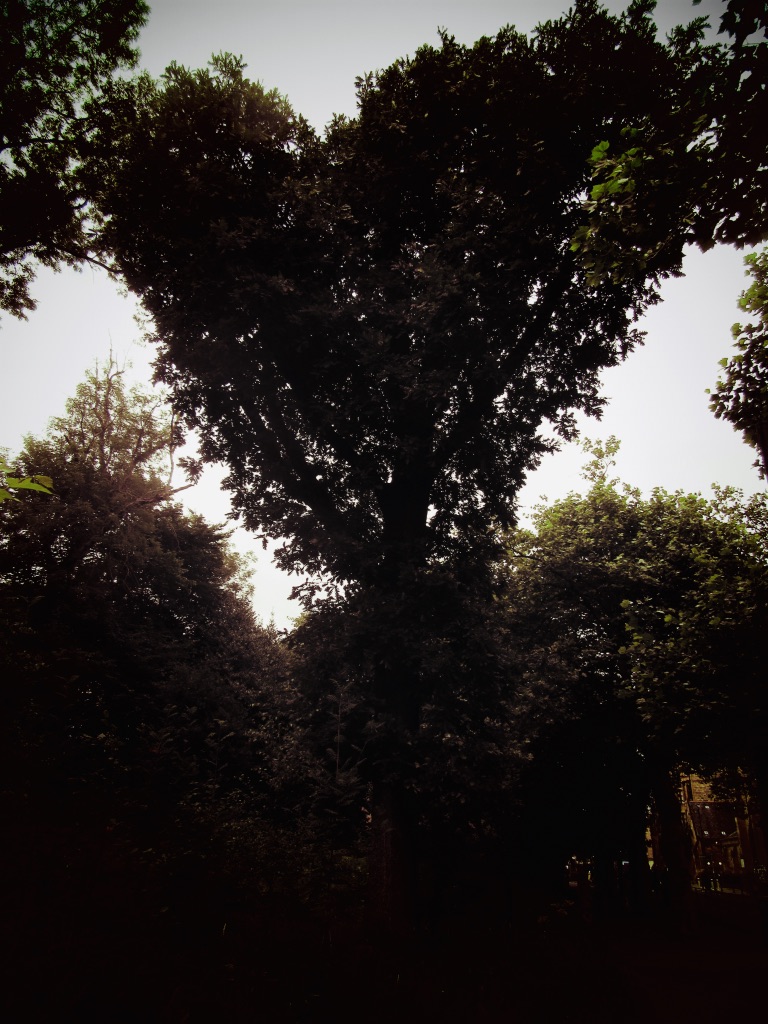
July 18th to July 25th
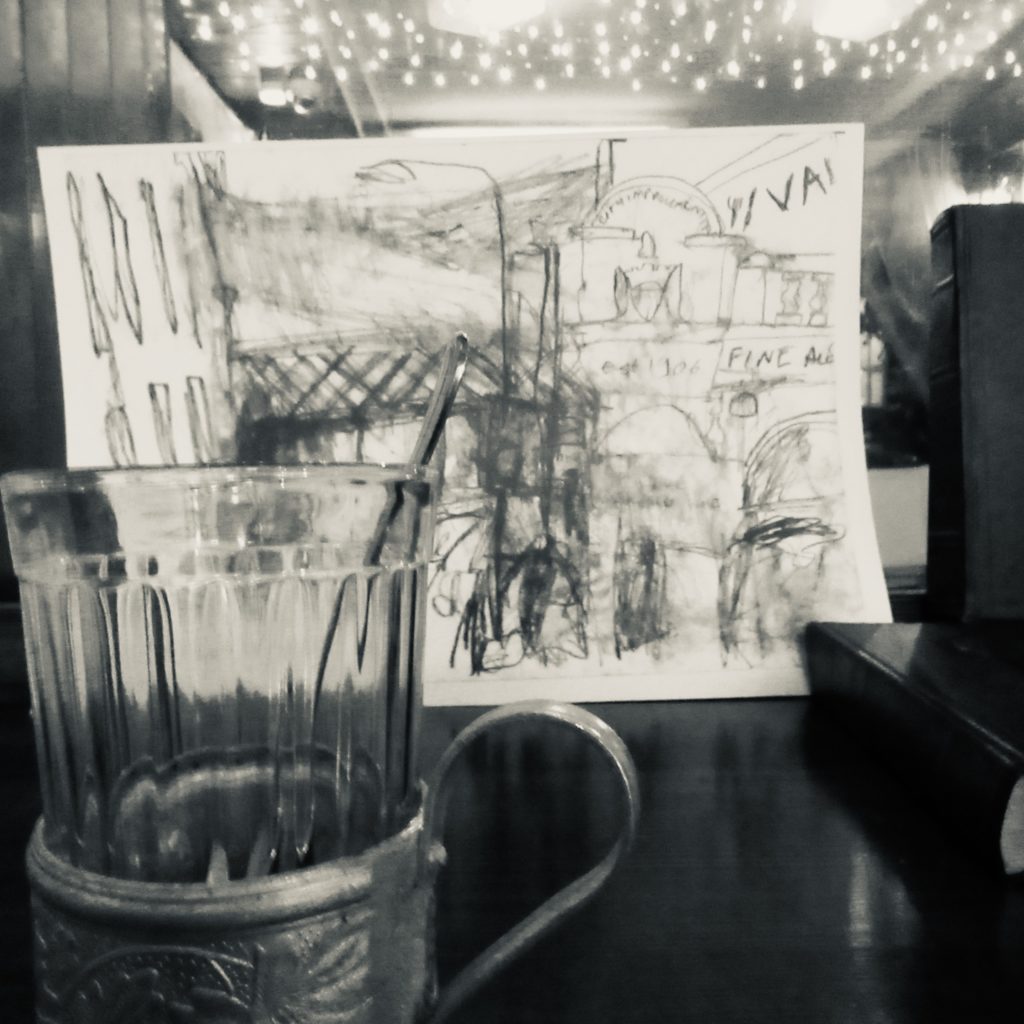
Letter from Glasgow: Train to the Future
The last time I was in Prague was February 1990. I made the journey from Russia, by train. Ruth and I were part of a group of ten UK students, studying in Moscow on special visas, for ten months. We each quickly absconded from the interminable four hour grammar lessons and disappeared into different groups of artists in the city, sensing a vocation that was to prove enduring. But February was our official break from the Institute and people were eagerly heading home, planning feasts of pizza and beers in the pub after the spartan consumer restraints of late Soviet Russia. I could not face breaking the spell of this other world I had found myself in, a world in which I felt suddenly and strangely at home, among the artists, in this other language, and so I decided to take a train to Prague, as far west as felt permissible from my new centre of gravity.
The immediate spur was provided by a visitor, an older research student from my English university, M., who was also making the journey. He said why not come with me? I said why not. Sveta, the mother of my new Moscow friend, made me mustard sandwiches for the journey which she assured me were the fuel of her student escapades when she was studying at the Polygraphic Institute in the 1950s. She sat at the table slathering slabs of black Borodinsky bread with cement-like grey brown paste from jars of stinging hot mustard, produce of factory (kombinat) 61. Then my university friend turned up, dangling a white cake box on a string. Time to go, he said. And off we went.
I began to realise our differences on the train, as he sat, consulting his watch, declaring that we could eat cake at four o’ clock. I didn’t have a watch. What point a watch in the crazy mixed up time and place of Eastern Europe at the start of the nineties ? Anyhow, we were on the train, inside train time, that was relayed hourly from the radio on loudspeakers with the spooky opening chimes of the song Moscow Suburban Evenings, a familiar and slightly chilling ten note sequence, in a extra minor key, relaying “Moscow time”. So we waited, twenty to four, five to. I ate up Sveta’s mustard sandwiches. We got glasses of clear brown tea from the carriage attendant. And at precisely four pm he opened the box, with slow ceremony. But the bland piped cream was no match for Moscow’s industrial mustard.
It was a slow journey, a night and a day. The train went across Ukraine. Wide fields on each side. A Ukrainian girl joined our carriage, she looked a little younger than me, she was heading to Prague to buy a wedding dress. She told us about her wedding, about the different styles of wedding dress in Ukraine and in Russia, about her plans for the future, and she wrote down her name and address on a piece of paper. Oksana. She lived in Zhytomyr. I can’t remember her surname, although I kept the paper for many years, as I have kept all scraps from such chance encounters, notes of people’s names and addresses, each in their own handwriting, like a part of them, fearing that it would obliterate something to throw them away,
The Soviet border was at Chop. We all got off the train and filed into a large crowded waiting hall. We showed passports, visas, tickets, held our faces out to receive the slow stare of the officials, and our passports to be stamped with violence. I can’t remember anything about Chop apart from the platform, the rail tracks and this large high ceilinged room, a holding room, with rows of seats and people waiting.
I enjoyed hearing about Oksana’s wedding plans, but I was wearying of my travel companion, increasingly impatient with what I perceived as his pedantry, a didacticism that seemed to hem me in. I shivered when he questioned me on what subjects I was considering studying for my final year in Oxford. Did he really think I was going back? What a ridiculous thought. England, and university finals, seemed an impossible prospect. I wanted just to stay on the train, to stay inside my new incarnation, daydreaming a future. We arrived in Prague in the evening and went out to a café to eat. I was walking along, behind M., staring at the walls of buildings, taking in their textures and only half-listening as he outlined our cultural programme for the days ahead. I sat at the meal, watching his fastidious eating, waiting until we could go. I asked for the bill, waited as he carefully checked each item and calculated my exact contribution. I went to pull out my purse and.. it wasn’t there ! I stood up began frantically looking through my rucksack. The commotion drew attention from some people in the corner of the room, then one of them came bounding towards me and locked me in a jubilant embrace. It was my old friend from Paris! He was here, with his friend, making a film. How could it be? I thought you were in Moscow, he said. Exclamations, joy, relief, and of course my friend would lend me money and of course we must spend as much time together as we could.
I was saved from cultural and worse, financial dependence on my fellow traveller. And M. trudged off to the museums alone while I rode tramcars shuttered with sunlight, my Paris friends filming the passengers as we rode to the end of the line. Prague was full of Spring — after the long dark months of the Soviet Moscow winter it was truly spring like, that February in Prague, there were lemons, and flowers for sale, and the air smelt fresh like lemons. There was cold Czech beer that seemed impossibly western, and cafés with terraces that looked like real European cafés not the windowless canteens with dirty melting snow across the floor, where you felt grateful to stand at a counter stirring a glass of muddy coffee extract, already sweetened, with a nickel spoon. Spring, or February, had never seemed so sharp and clear and alive.
There were flowers and candles on the pavements, remembering the “Velvet” revolution of the previous November. On my last day, I walked past some government buildings and saw Vaclav Havel on a back balcony waving at a delegation of nuns in the courtyard below. M. and I parted politely enough, but it was my Paris friends who saw me off. They wanted to film in the country so they decided to take the Moscow train with me, and get off before the border. They decided to get off at Olomouc. It was night, and as the train drew in we embraced and they jumped down to the platform. They waved to me as I stood behind the window, waving back. I seem to see it, my face almost indecipherable behind the dark glass, staring out under my dark cap, although I don’t think that I ever saw their film. That image, of me leaving on the train back to Moscow, is clear and distinct in my mind, as though it were me behind the camera.
I had hoped to go back to Prague for the last month’s residency, to see what remained of my memories, but it turned out that I could not. I had wanted to approach the city by train again, from the other side, thirty three years later. There would be no radio chiming the hours, no polished wooden corridors or jars of tea in metal holders, perhaps no mystery. A journey of nostalgia, of curiosity? Certainly not the journey of my twenty one year old self, whose trace or ghost lies somewhere on frames of celluloid, heading back East to a still unthawed Moscow, full of resolve, to meet the unknown future.
July 11th to July 18th
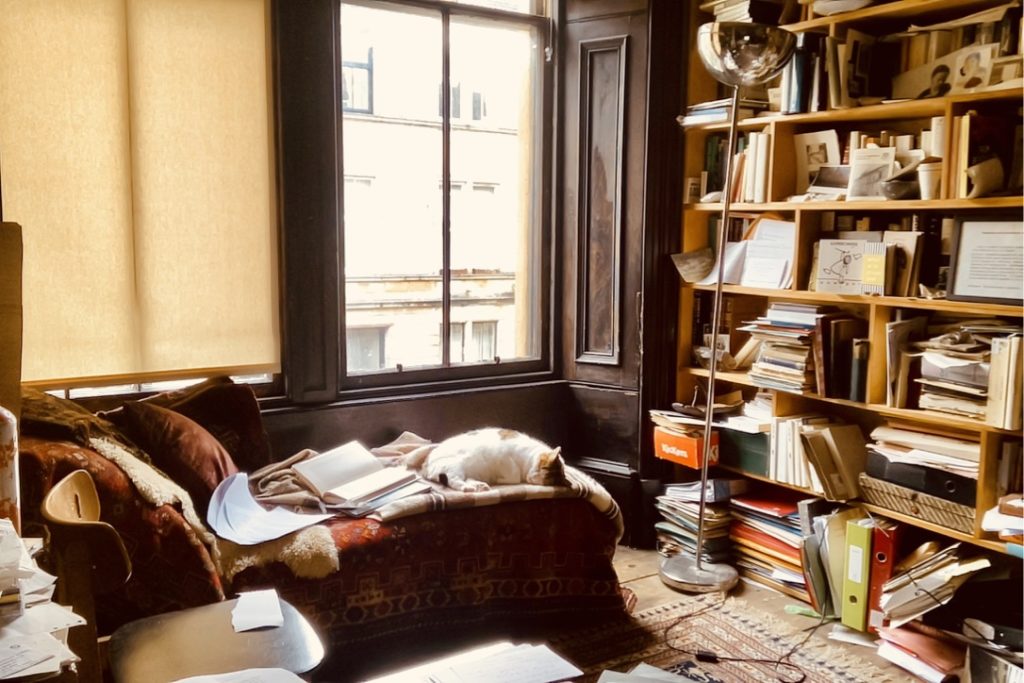
Letter from Glasgow: Drawing and Losing
It is end of term at the Drawing School where I teach. My children are away and I am alone in the house. It should be the chance for the solitary work I have wanted all year, but I am exhausted. The first two days I lie on the slightly uncomfortable but very Freudian couch in the corner of my room, staring at my bookshelves. I acquired the couch last month, a friend was getting rid of it. I had assumed that it originally belonged to his mother, a psychoanalyst, after all it used to sit in his flat under a shelf of her complete first edition of Freud in English, that he inherited when she died. But I was wrong, my friend said. The couch, that I had always imagined to be saturated with residues of dream narrations, had in fact a sadder tale. It had belonged to a university friend who killed himself, and bequeathed the couch to my friend. Only it turned out that my friend’s friend had had a completely different name, to the astonishment of his contemporaries. They had never really known him. He said that it was a relief in a way, to give the couch up.
I covered the couch with a Qashqai rug, a worn runner that my mother no longer wanted, but which was too long for my hallway. It fitted just right. I added some cushions and a blanket. It made a pretty good near relative of the couch in London, at the Freud Museum. It was somewhat creaky, being over a hundred years old, and had un-sprung itself in places, but I like to lie there and stare, out of the window, along my bookshelves, daydreaming.
On the third day I began to grapple with the piles of paper on the shelves at the end of the couch. I sat on it and sorted old drafts into some sort of pattern. Notes on drawing, lost and forgotten drawings and writing — they disappear and re-surface, always I am trying to find some better way of putting them in order, of finding what I need.
As I sorted and re-arranged, a quote from Chagall surfaced, that I had copied out several years ago. He is writing about the one million Jews forced from their homes on Russia’s western front in 1914, through a combination of state ordered deportations, local pogroms and massacres. Chagall wrote of these figures without homes, walking east: I longed to put them down on my canvases, to get them out of harm’s way. It happened again all too soon, with the terrible pogroms of 1919 that took place in Ukraine during the civil war. This time Chagall made a drawing that shows a raft of rooftops, a whole town, being carried on a man’s naked legs. The Town Walking (sometimes called The Village Walking) was drawn in black ink, in 1922, to illustrate a Yiddish poem of lament for these atrocities, Troyer (Grief). The poem-pamphlets were sold to raise money for orphans of the pogroms, who Chagall taught drawing to. A figure looking out of the window of the house on legs emits a scroll of Yiddish letters, a speech bubble: What Use to Me the lucidity, the clarity ? I had thought about this drawing at the start of the war last year, as people were displaced once again, the towns walking across Ukraine a hundred years later.
To get them out of harm’s way. Chagall’s wishful intent reminded me of Sudha Padmaja Francis’ last Crown letter from India, showing the drawings she had made of her friends. She wrote that she isn’t interested in fluency or strong lines, but that her drawings are a way of keeping company with friends, often absent, a way to bear witness to them, perhaps hold them, when she is unable to actually reach them physically. Drawing as a way of protecting.
I have never met Sudha but the warmth of the writings, films and drawings she sends to the Crown Letter makes me feel that I have been inside her family courtyard, with the fallen mango leaves on the ground. It feels like a protective space. I think about about Sudha, about Chagall, about drawings made as a way of bearing witness, a charm against loss. Like the old myth of drawing’s origin, which features a woman, a sculptor’s daughter, drawing a line in charcoal around the shadow of her lover before he leaves her for a long journey, a way of holding a trace of that which is about to vanish. I am glad that Pliny the Elder records that this initial impulse came from a woman, the only female creator he acknowledges in his Natural History. Although her work was completed by the father, who made her drawn image into a clay relief, it was she who had the instinct to catch the shadow of a loved person with a drawn mark.
What use to me the clarity, the lucidity? Classification continues to elude me, and the re-arranged papers form a new pattern on the carpet covered couch, in this endless circle of losing and finding. I wait there, to see what might emerge from the shadow traces, in the daydreams, resisting a definite outline, remembering friends, dreaming of ones I cannot reach, of places that cannot be got to, the places in dreams, that hold the best of what we can be together.

June 27th to July 4th
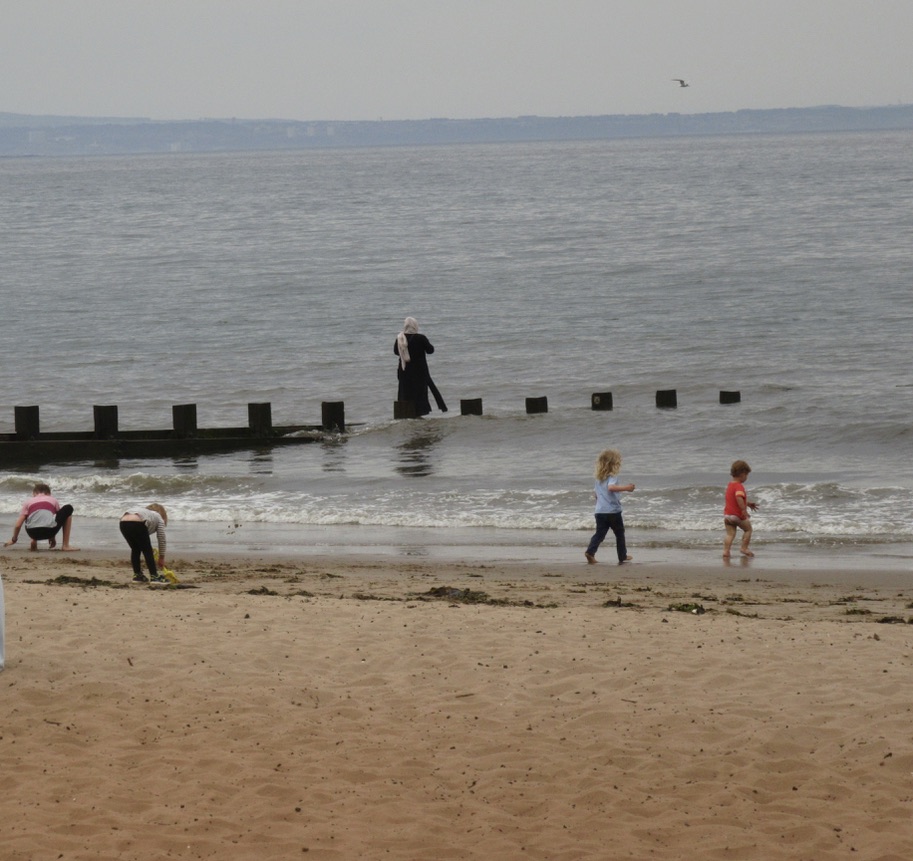
Letter from Glasgow: Looking to Sea
Last weekend we went east, to the capital, for the exhibition of a friend’s paintings. It was a morning opening. The sun came in to the large square room through a domed glass roof, the tracery dappling light on the surfaces. The canvases were large and square, you could swim about in them. One was an underwater picture, a mosaic floor with the shadow of goldfish across the tiles, a suggestion of fish. The room was full of watery light.The paintings were inflected by the light and the light by the paintings. The paintings were so big you could be inside a painting and among the people in the room at the same time.
Afterwards we went swimming. The city is on a curve, lapped by the north sea, so the streets go down to meet the beach. The beach was full after days of hot weather, although the sky was now overcast. There were many of us. Mostly painters, we had shared the same studios in Glasgow for twenty years or more. We had seen each other through break ups and births, deaths, and threats of death. Most of us were still painting when life allowed it. Our friend had become quite famous, but we were glad for him. His painting made you want to paint.
We walked to the water’s edge where a line of dead seagulls, some of them picked to the bone, were washed up on the tide. It was said that the North Sea was five degrees warmer than usual. Last week a humpback whale was seen in the Clyde. The sky was dense as before a storm. The browny light of it reflected in the cloudy brown of the sea, or was it the other way round?
I swam out, leaving my friend paddling on the shore with her young daughter. It had been some time since we had all been gathered together like this, with children, in a holiday mood. The teenage boys were now taller than their fathers, and looking from this distance, their fathers were suddenly more frail, scanty haired, and the boys were men. We had all grown older. I swam out for a while, backwards, watching my friends on the shore and their children becoing smaller as I swam further, and then I turned around, and swam back in, keeping my eyes on the empty horizon across the warm brown sea.
June 20th to June 27th
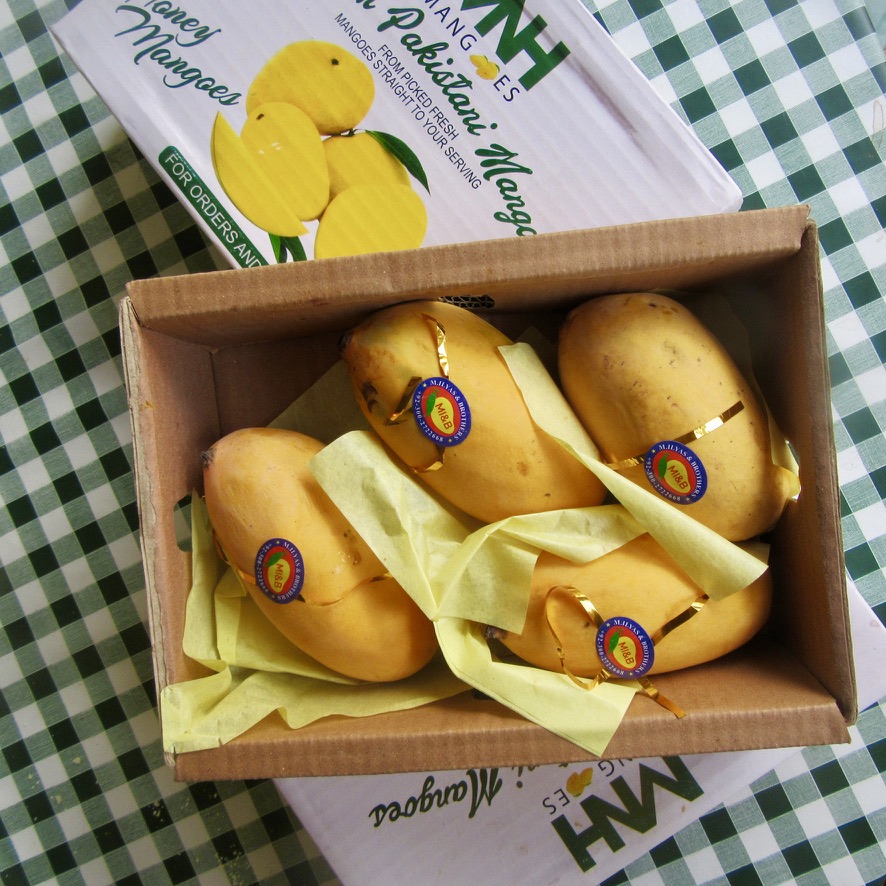
Letter from Glasgow: Instructions for a Heatwave
It is a heatwave, almost midsummer. I’m at the Tramway art centre on the south side of the city, to hear my daughter play music at the opening of an exhibition of children’s art. I’m early but I can hear the sounds of strings, so go up to the roof space where they are practicing. They are playing in front of an arched window and through the window there is the distant outline of the Campsie hills beyond the city, almost dissolving in the blurry haze of heat. This was the same view that I saw, in another heatwave, in the summer of 1994, when I first came to Glasgow. There was a performance of Dostoevsky’s Devils by the Maly theatre, on tour from Moscow. My friend was translating for the company. I booked a train.
The play was performed over a day, in three sections, with substantial breaks in between to eat and draw breath. The audience sat out in a line, seeking shade under the awning at the back of the building, that was still being converted from the original tram depot. We stared into the heat, sipped water and ate snacks. On the second break I went out of the building, in search of a samosa, and a pencil, from the local shops. I crossed the railway bridge and looked out, my gaze held suddenly by the line of hills beyond the city in the soft evening light. From the bridge I could see the city, the high flats and the university towers and beyond them, the now familiar outline of hills.
I thought, I could live here. I walked on to a small newsagent further up the street and imagined myself to be walking in my own city. A sort of premonition. The next day, waiting to board my train back to London at Glasgow Central, I drew the tented glass-paned roof of the station and knew that I would be back. It was as though I recognised something about the station, or the view from the railway bridge, as if it had managed to inhabit me already — my future held within me. My future at my back as the Tuvan saying has it.
But it shocked me to realise it — that future, now present, and suddenly overlain by the first sighting of it almost thirty years ago, to realise how I had taken my premonition at its word. How stubbornly I had persisted with this city, following that early summons, in spite of disappointment, a love affair and its demise, a future that felt unfathomable. I had stuck with the city and gave birth to two children here, and now here was the youngest, my teenage daughter, dressed in black, playing a violin — a silhouetted figure against the exact view that I had felt the future in, as close as that, with almost no space for all the labour in between.
After the music, my daughter came up to me. She said, I saw you looking sad. Was I ? I asked, I was just looking.
In the enormous downstairs space the concrete floor is grooved with shiny curving tramlines. There is a show of sculpture by an artist from a Sikh family, she was born a few streets away from the gallery in 1986, a child when I first came to this space and walked through Christian Boltanski’s Lost Property exhibition, in one of the breaks in the Russian play. The gallery attendant has left the room, a clipboard with her list of visitor numbers lies on her chair, and a book, Instructions for a Heatwave. It looks like a novel, not a handbook. Although we could do with both. The heatwave is much hotter than the one thirty years ago. It is still swelling when my daughter and I leave the building at ten to six. We cross the railway bridge and walk along the pavement, keeping inside the shade. A little further down we see boxes of new season mangoes piled up on a makeshift stall in the street. The stall stands almost exactly at the spot where I had bought the pencil, samosa and small red paper notebook that early evening almost thirty years ago. It’s a short season I say, we should get some. By the time I have paid a small queue of people has formed behind us, trailing back into the road, men in turbans and women in glittering cloth. We walk along the street balancing mangoes, violin, and a heavy school bag. The buildings are almost whited out, over-exposed, the sandstone that looks gentle against a storm sky is suddenly insistent, it hurts the eyes, the light is too bright.
Instructions for a heatwave ?
Walk more slowly. Don’t look back.
June 13th to June 20th

Letter from Berlin: Ghosts
We were late for the film and the box office had just closed. They said we could have a drink instead. And so we ascended the stairs into the wide space of the bar of Kino International, which was completely empty. A small person appeared at the counter and poured us glasses of Riesling. The great glass windows held the deserted streets of old East Germany, looking more than ever like the past on this Whitsun weekend. Opposite was the MOSKVA café and cultural centre. My friend said it was closed at the moment. The writing on the building and the wide empty street reminded me of the road of Moscow’s New Arbat, that I would cross and re-cross several times a day whenever I visited, as my closest friends lived on each side of it. On some visits the walk between their two kitchen tables was all I would do. I know the wobbly line of streets that join them in every weather and at every time of day.
Kino International was built in 1961, the same year as the Berlin Wall. It was the main cinema for premieres and award ceremonies under Communism. You could picture it, the slightly sweaty dignitaries in brown suits and shoes of turgid grey fake leather lined up for speeches under the extravagant chandeliers. But this evening there was nobody. The huge yet undaunting space, the rippled wood walls, shiny black tables and red chairs were perfect. This enormous empty room was proportioned for optimism, it was a place to be happily human, for a while at least. I was glad we had missed the film. I looked across the street to the high Soviet scale arch of a metro exit, the only lit building on the street, and watched a couple pause, pace about, embrace. They were tiny under the space of the arch and yet every small gesture was legible.
That afternoon we had cycled to the far west of the city, we had stopped at a flea market, or rather I leapt from my bike, spotting a pile of old photograph albums on a table next to the cycle lane. A box under the table held postcards, letters, photographs. There were letters from Russia with the imperial eagle on them, sent before the revolution, and letters in German, from wartime, dated 1942, and then from the divided post war country, written in ink or whispery pencil. Photographs of groups of young people, smiling in mountain landscapes, or wearing swimming costumes at seaside resorts, from the 1930s, full of Aryan health. What did they know, what were they thinking about? I thought about the Russians writing letters to Germany, about the endless configurations of families and the handwritten news travelling to and fro. We stayed for ages, I needed to go through every envelope and every image, as if I was looking for something.
Occasionally, the strong face of a young woman looked out, distinct, thoughtful, a lone portrait between the robust groups. I wondered what she was reading, who she wanted to be. I was tempted to ask if I could buy one of these photographs, but I did not want to separate them from their company. Also, what if someone else was looking for them? Someone who they belonged to. Even the letters in Russian, that I could read, were not addressed to me, and might yet be awaiting their rightful recipient. The men running the stall seemed uninterested in what they had, the envelopes, photos and albums were piled up in a careless heap, they were doing a brisker trade in a pile of shiny modern ceramics. I straightened the albums into some sort of order. I put back the pages that were crumpled or falling out. I felt it was my duty to look at every bit of handwriting, each photograph, just in case, but I did not feel I could buy any. They were not for me to take, however beguiling the faces, intriguing the handwritten pages.
When I lived in Moscow, I used to go with my friends to the “Cinema of the Repeated Film”, near their flat. It showed old films, Soviet and a few European ones. In the autumn of 1989, as the Berlin Wall came down, we went to almost every screening at a festival of Soviet silent movies: Boris Barnet, Dovzhenko and Abram Room. The faces were compelling — a sudden lit proof of real people and rooms in a real and urgent time, that had since become history. Like the faces in the albums, in the boxes, they are so many. They look back at us as we move forwards into the past. What should we do with them, with these shadows, these flickering urgent ghosts?
May 30th to June 6th

May 23rd to May 30th

Letter from Glasgow: Written on birch
The first letter my father sent me was written on birch bark, paper thin, in black ink. He posted it from America, or Canada, where he was away working. I was too young to read it, only two or three, but my mother must have read it to me, and she put it in her scrapbook where it remains intact.
Every week I walk through a tunnel of birch, the long trunks seem to have eyes, mouths and other orifices. They look back at me, and I mark my journey by them, the big staring eye, the shape like a gaping vulva, a sheela na gig. The trees feel alive, watchful, warding off trouble. In spring their high thin leaves dapple the light and enclose me.
Birch trees seem to like railways, you travel through them as you enter Glasgow, and Berlin and then east to Moscow and Siberia. An endless shuttering of birch trunks through the train window, their verticals marking the space. It isn’t monotonous, it is even reassuring. They accompany my journeys, anticipated and remembered. I look them in the eye.
Recently these tree trunks have begun to people my paintings and drawing. They sit about a dining table. A felled tree between them like a family secret, or a dead man laid out. What do they do with something that is part of them? The trees are cut at different heights and sit at seats or on plates. Some places are empty. Generations of birch, you could find the continuity consoling. I find it frightening, such inescapable belonging.
May 16th to May 23rd
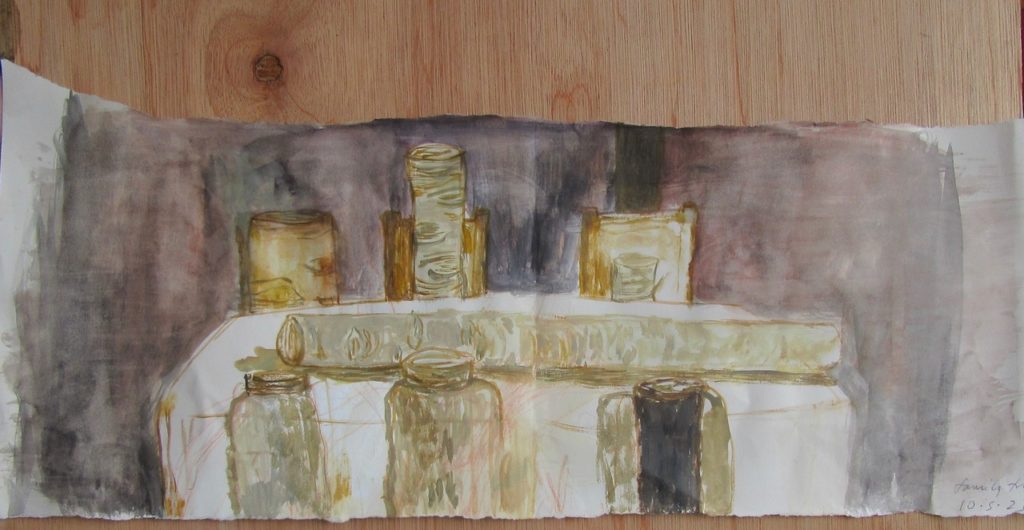
Letter from Glasgow: A bed of lichen, a table of moss.
This morning I was woken by a text from Paris. My old friend Anna-Louise is making a headdress to wear to a carnival this afternoon, planned by the locals of her area, with and without papers, who she has worked alongside for many years making breakfasts, music, and street parties for those forced to inhabit make-shift camps that surface and are just as swiftly cleared on spaces of land between the expensive square metres of the once shabby 18th arrondissement, where she lives.
It’s going to be a Bibiliotheque Imaginaire, she writes, an imaginary library, to wear on her head. Can you send me the title of a book, real or imagined? The first thing that surfaces is moss. My book would be a bed of moss, but I need another syllable. A mattress of moss? No, a mattress feels too awkward and practical, a table then. She likes it. A Table of Moss and Other Stories? Yes, it might include Un Lit de Lichen, I text back.. Something solid and permanent like moss, or lichen. But my predictive text wants to write libido, not lichen. Although it is true my devotion to lichen might have something libidinous in it. And I have long dreamed of beds of lichen and moss, and sometimes trees are asleep in these beds.
As I was day-dreaming titles I had not been thinking of the camps or of the actual, not mossy, but decidedly urban mattresses that are left behind after each clearance, the one thing that people cannot run away with. The mattresses are always the first things to be brought, dragged over pavements, and the things that remain after everyone has been moved on. The beds of moss, or lichen, indicate a world where it is safe to lie down anywhere, where nobody claims possession of the territory and where you can gently dream. A sort of permanence, old as lichen, as libido.
May 9th to May 16th
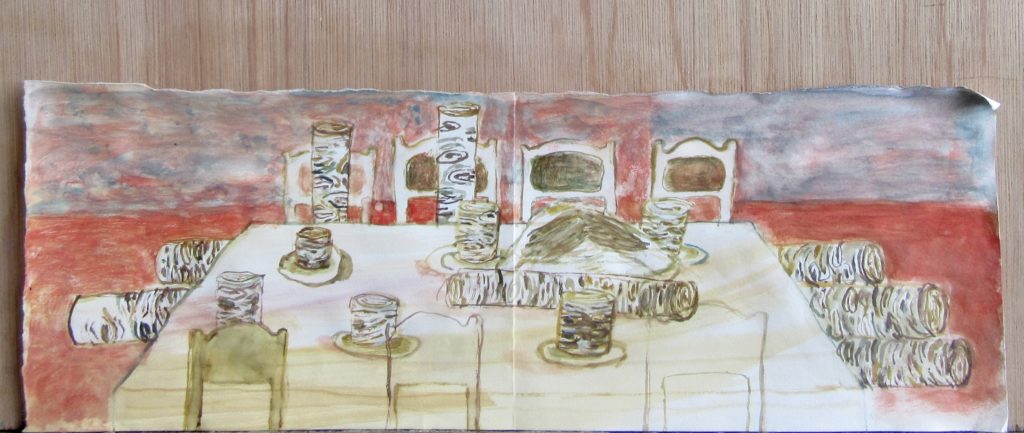
Letter from Glasgow: Notice of Death
How do you spell bereavement? My friend asks. I’m sitting in my kitchen spelling the letters out loud down the phone: B_E_R_E_A .. and then I pause, for I can’t remember if there is another ‘e’ after the V. My friend’s father had died in his sleep, but still it was sudden. I saw the text when I woke up. I rang him as soon as my daughter left for school. He had already made it home. His mother asked him to make a sign to put up in the window of the shop. She is in her late eighties but still runs a busy dressmaking and alteration business in the local town.
How many Es in bereavement? I think I was one short. But I hoped it wouldn’t matter. Closed due to a Bereav(e)ment. “Closed until further notice due to a bereavement..” that was the sign we saw in the window of a garage in Orkney, where we had been hoping to buy some food. It’s possible it was also misspelt. The sign was so old and faded it looked like no-one had ever come back. The bereavement was interminable. The crisps we had hoped for and the packets of tea going out of date on the shelves, the petrol pumps rusted and faded. We walked to the nearby bus shelter and stood there for an hour out of the gale, waiting for a bus.
How many Es in Bereavement? The spell check on my computer keeps adding in an extra e when I type it, so I think I told him wrong. There had seemed something absurd, yesterday morning, ringing my friend to condole him and sitting there spelling out B_E_R_E_A, spelling out the facts of the matter, and the spelling being the only thing I could help with at that distance, and still I got it wrong. And he would have trusted me as well, to spell it right, me having an academic education and two university degrees. I usually can spell, but I left out the E. It felt like there were too many. I made it more abrupt.
People wouldn’t mind, they almost expect mistakes. There is something so abject about those handwritten signs, put up in haste and the door shut indefinitely. “Maybe he got out by the side door.. ”, my friend had said about his dad. I had to pause to take in what he meant. He meant, I suppose, that his father, who had recently been diagnosed with a horrible neurological condition, had died peacefully, without even waking his wife, who slept beside him, and so had avoided a more torturous end. My friend had also said, about the grief, “maybe it’s in the post”. I wondered what, but he meant that he still felt numb, he was waiting. Death had been expected, but it had arrived early.
“I didn’t draw him” he said. I said it didn’t matter, he had drawn such beautiful portraits of his father when alive. “I thought it would be disrespectful”, he said. “And they are taking the body away now..” As if he slightly regretted it. He said that maybe he would draw something from memory. That had been the name of the book of prints he had made, images of his family, he had bound them in a hand-made book. Io ricordo was the title printed on the front, in the language of his parents. And then we finish composing the sign. “Completed alterations can be collected from Giovanna, at the Florist next door.” That seemed enough. Then he had to go, to put it up before opening time.
May 2nd to May 9th
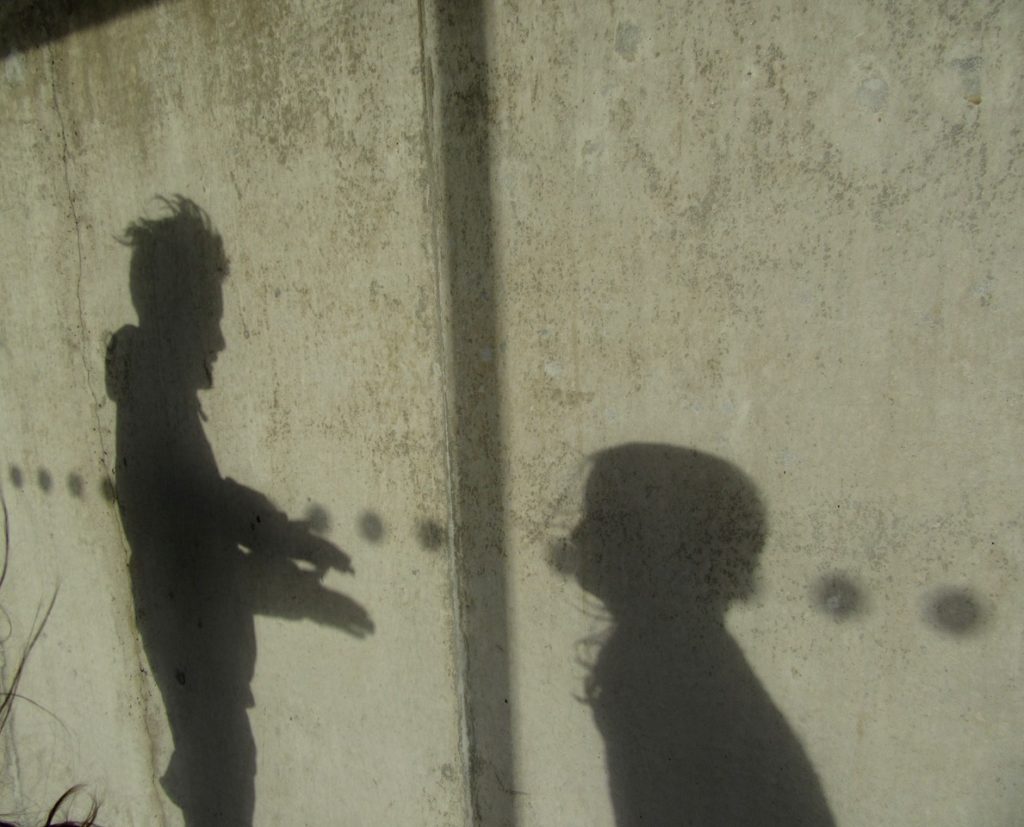
Letter from Glasgow: Shadow Boxing
Last week in London, spring was fizzing through branches of willow and lime, leaves unfurling in brightest yellow-green. I got off the train at Kings Cross and took a bus up the hill to Angel, through the blossom and the new leaves. I met my aunt at the top of the hill and she led me to a pub with a high-ceilinged back room, out beyond the bar and the noise, where we could talk. Sunlight striped the dark wood floor and the almost empty space was a relief.
My aunt bought us drinks and we sat at a table in the corner. She sat beneath the window, a dark figure against the sun, but light fell also from a smaller window at the opposite diagonal of the room. We were talking about death and of people close to us who found themselves suddenly in its shadow. My aunt was speaking and as she spoke I watched the clear shadow across her — the great bowl shape of her glass and the straight straw coming out of it, enlarged on the front of her tunic, cutting a fine silhouette against the white-green brightness of the sunlight. The shadow focused the brightness of the light, this new spring brightness, or the light focused the shadow. I watched the way that its edges hardened and relaxed, sharp and then soft. I took it inside me, as I took in the sad drudgery in her words, as we circled the inescapable. The shadow was a surprise — the April light so clear and precise, the shape made by it so unexpected. I held onto it like a rope that you grasp when the space ahead is uncertain or treacherous. That strong and playful shape was a gift and comfort, as was the looking, a more hopeful conjuring than the words with which we tried to muffle our dread.
A week earlier I sat with Ruth in the old stone church at Dunnet on the edge of Scotland, on Easter morning. Ruth had been married in this Church. I sat, like a child, between her and her husband. The visiting preacher asked us to imagine Jesus walking down the aisle in a blaze of glory but we were concentrating on the shadows behind the blinds on each side of her head. The shadows were moths, caught between the blinds and the long coloured glass windows in the side wall.
The glass in the windows was pale pink and a warm yellow. Their gentle warmth made a pleasing contrast to the more austere dark red and blues that are usual in church glass. There was no lead tracery, simply ordinary panes of coloured glass, slightly rippled as might be found in a school or nursery. The colour was like blancmange or custard, a nursery pudding or a children’s book. Something simple and benign, reminding of school halls, of childhood spaces. They were soothing. On three of these windows the blinds were drawn shut against the sun, but the light through the blind was tinted by the coloured glass.
The sun had just come out and drew a silhouette of the moths between the glass and blind, a shadow shape that sharpened and blurred with the stir of the breeze, their edges lost then found, as they flitted against the glass. I no longer regretted the sermon, nor not being outside in the sunlight, I was with the moths and the blinds that twitched and shifted slightly in the wind, focusing and dissolving with the light and air.
I thought of Ruth’s drawing of moths in a recent Crown Letter and of Virginia Woolf’s fondness for moths, a motif in her work for flashes of imagination and intuition. The Moths was Virginia Woolf’s original title for the book that became The Waves:
The contrasts might be something of this sort: she might talk, or think, about the age of the earth: the death of humanity: then moths keep on coming. (Virginia Woolf’s Diary, Saturday 18th June, 1927)
The waves crashed below us. The church was an unusual shape, the pews set in three directions to form a T. Ruth told me about her wedding and about walking in down a side aisle and seeing her uncle and her brothers sitting facing towards her, all of them crying, even the one who never cried. I could picture Ruth entering the church and drawing tears far more easily than I could Jesus. The service ended. We went out into the light. We walked through the graveyard at the top of the cliff. We looked at the headstones and the carved names, archaic and familiar, at the crispy bright lichen on the stone. One grave had fallen and broken on the ground. I thought of a dream I had had about dying — people were moving through a landscape but as they vanished, or were claimed by death, their shadows stayed behind, they kept moving, darting over the empty ground. The shadows held the specific trace of the vanished person, these markings on light became their permanence.
I had been surprised by the dream at the time and I still wasn’t sure what it meant. It was something to do with wanting to hold fast to life, a longing for permanence — but knowing that permanence cannot be set in stone. Sepulchres and monuments do not return a person from death, but perhaps, if we concentrate, we might sense their shadow. Shadows seem so calmly articulate, their movement compels because they seem to be saying, or showing us something, patterning the pile-up of objects through which we stumble each day. We can follow their movement when we don’t know where to look, or which way to turn.
Perhaps they are showing us a way to give up our fixation with monuments, our need to counter loss with solid objects, reminding us that nothing can be caught or held, but that shadows are a sort of constancy. They comfort with their ebb and swell, the soft valve of their play like a promise, a stilling, a way to be carried, or at least a way to wrong-foot our fear.
April 25th to May 2nd
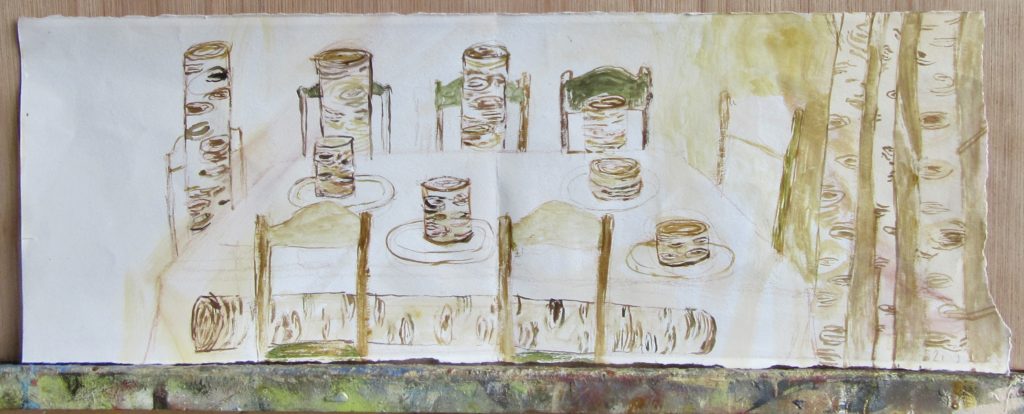
Letter from Glasgow: April around the tables
April. It was Passover, it was Easter. Then it was Orthodox Easter.
We spent Passover week travelling, setting out on the first day and taking the long train north through Scotland, from Glasgow to Inverness and on to Thurso, the furthest point of the Scottish mainland. I had been invited to a seder but had had to say no as we would be travelling. I was curious as I have never been to a seder, although a friend once shared with me the hard boiled eggs in salt water and bitter herbs, one April in the Hebrides.
In Caithness on the north-eastern edge of Scotland we feasted each day of the Easter weekend on roast meats and puddings, cooked by my friend’s mother. The long oak dining table was laid neatly each evening with wine and water glasses, napkins and place mats. It was reassuring. We sat about it with our children, my friend’s husband and her mother. My children enjoyed the company of my friend’s mother, and so did I. We relished her wit and grace, as well as her New England cooking. She told us snippets of her childhood in Boston, during the war. On Easter day my daughter and I made a small mossy garden that we put on the table. At the bottom of the actual garden, beyond a low stone wall, was the sea, and a beach where seals bask. We painted hard boiled eggs and rolled them down the cliffs at Dunnet Head, the most northerly point, in a gale that came from every direction.
On Easter Monday we took the boat to Orkney, the spreading islands and lakes across the firth from this end of Scotland. We visited my painter friend, whose tiny house is so full of her paintings that there is no dining table. She prepared us delicious meals, fish cooked in envelopes of paper, home-made pasta pillows that she rolled out from a pasta machine clamped to her worktable, adjusting the side ratchet of it to achieve the right thickness, just as she had adjusted the ratchet on the printing press earlier to get the perfect pressure for printing lino cuts. We hardly noticed the transition from making prints to making food — the improvised precision of art and cookery felt seamless. We ate on chairs about the room.
On our last evening in Orkney, also the last night of Passover, we went to visit an ancient tomb by a lake. It was almost dark but you could go freely in and out of the chambered tomb and we sat in the silent arched stone space for a while. The burial chamber was at the bottom of a path through the garden of a house. A light was on in the house. My friend knocked on the door and an older woman answered. She was a friend of my friend and she asked us in immediately, and we sat about her round kitchen table, drinking tea and eating biscuits as the skeletons of the bushes beyond the window blackened against the space of the lake. There was a glint of moon on the water, defining raised ripples on its surface. Inside, the kitchen light was yellow on the table. The kitchen itself was also yellow, thickly varnished pine, darkening with age, reassuringly messy and un-renovated. We sat and talked about the biscuits, and Easter food, and I found myself telling of Easters in Moscow, describing the kulich and pashka — the long white table-clothed trestles outside the church where they were laid out in lines by head-scarved women for the priests to bless by sprinkling holy water. I tried to tell of the sweet mix of spice and dried fruit and grainy curded cheese that went into the pashka, and of how we used to go from house to house for a week after Easter to taste the different baked kuliches and pashkas, fresh from their wooden presses. It was important to try everyone’s — you could devote hours to it, and drinking tea about the tables, in April, and we were so hungry after the long winter.
We parted warmly as though we were now all friends. As we left my daughter said “I’ve never heard you tell those stories before”. But the woman’s table had inspired it somehow, the going back, and everyone had leant in and listened. It was very dark once the sun went down. As the vertical light vanished with the closing door there was just the yellow rectangle of the kitchen window and the black silhouette of the house, low reedy bushes, the lake and the grassy curve of the burial chamber. I thought of the long winters here when there are only a few hours of daylight. The woman’s man (she called him that, “my man”, for they had never married) had died early in the pandemic and now she lived with two cats and the burial chamber at the bottom of her garden as her guardians and company.
We took the boat back at six the next morning, and then the long slow train the length of Scotland, down the east coast. We travelled over moorland and through forests of birch. The light was silvery white through the trees, and the birch bark was inflected with shades of pale lilac and the brightest mineral green of lichen. There were also reedy shoots of dark red. It was exciting to see all the trees after the barren treelessness of Orkney and Caithness. The journey took sixteen hours but the pace of it felt right. I was never impatient with it. It felt almost like a long walk.
And then it was Easter again. Orthodox Easter, back in the city. I exchanged email greetings with the friends I cannot see in Moscow and I went to feast on lamb, slow-cooked in brown paper, at the house of a Greek friend. We sat around tables with white cloths, laid out in her living room. I saw people I had not seen for some years. Still these reunions, this novelty, about tables, after the pandemic. And I remembered the Pasternak poem, Earth (1930). It’s almost corny, except it wasn’t when my friend’s mother recited it aloud at the small round kitchen table in Moscow, and it’s not so corny any more now that gatherings still feel sudden and vivid, not a given, this renewed sense of feasts with friends being something crucial yet almost illicit:
Dlia etogo vesnoiu rannei
So mnoi skhodiatsia druzia
I nashi vechera proshanii
pirushki nashi – zaveshchania
chtoby tainaia struia stradaniia
sogrela kholod bytiia.
That’s why when spring arrives
We come together, my friends and I,
And our evenings are goodbyes,
our festive rites — last wishes
so that sorrow’s secret stream
might gently warm the cold of life.*
My Moscow friend Ira’s mother, Sveta, taught me that poem — slowly imparting its rhythm and consonants, sounding it out and at the same time disclosing the objects from corridors and cupboards of a dark Moscow apartment, the furs and old hats that have been stored with camphor, emerging from hibernation into the sudden brightness of spring and its too sharp sensitivity. The evocation of clothes coming out of storage gives way to ritual gatherings of friends about tables, and the knowledge that repetition is reassuring but not a guarantee of permanence. Life and the pain of being sharply alive, a hot stream cutting through the numbness of winter: a poem of endings and not knowing when things will end but being vividly aware that it could be anytime now.
*With thanks to Christine Bird for her excellent translation suggestions
April 11th to April 18
Letter from Dunnet Head: cosmic egg rolling.
I saw a huge form, rounded and shadowy, and shaped like an egg… Its outer layer consisted of an atmosphere of bright fire with a kind of dark membrane beneath it… From the outer atmosphere of fire, a wind blew storms. And from the dark membrane beneath, another membrane raged with further storms which moved out in all directions of the globe. Hildegard of Bingen, Scivias
Hildegard of Bingen, the medieval mystic and nun, had a vision of the world as a Cosmic Egg. She depicted the earth as a chaotic ball of confusion, contained within an egg-shaped universe. The four winds blow through this universe, concealing and revealing the heavenly bodies. Hildegard believed that the winds would eventually articulate a harmony with this chaotic world and the people in it, establishing calm and clarity, inside and out.
On Easter morning we painted the eggs that we had hard-boiled, then placed them in a box, and drove with our children to the nearby cliffs where the lighthouse stands, on the most northerly point of Scotland. The winds were blowing hard from all directions. The islands of Orkney were hidden by mist and the curved horizon was all sea and sky. We pushed our way through the fat and tearing gales and rolled our painted eggs at the edge of the world, through the slopes of heather, putting our hope in ritual, repetition, and the force of the winds.
March 28th to April 4th

Letter from Glasgow: Poisoned Ground (II), Burial
After I wrote last week’s letter I was thinking about waiting, and not being able to paint, about poisoned grounds and potential. I remembered a field in Ireland with a sign roughly painted by hand saying POISON, and an arrow pointing down. I took a photo of it, over thirty years ago. In London I used to live at the end of a long park that replaced the industrial paint factories obliterated by bombs during the war. The land was deemed too dangerous to churn it up for building on and so a luxurious swathe of un-monetised land was allowed to stretch all the way from Hackney to the river Thames, the long grass growing over it. In the summer it is full of people walking, sitting, having picnics, saris glittering in the sun, along the opaque green slow water of the canal. I was thinking about the relation between poison and colour and paint, of how the best colours are often the most poisonous: lead white, cadmium yellow and red, cerulean.
I remembered Antonioni’s Red Desert, his first colour film. The heroine says she is afraid of streets, factories, people and colours. The colours in the film are highly keyed — an intense pitch of yellow, reds and blues set against muted chalky grey monotones of the old world. Antonioni hand-painted objects for the set, in dusty off-whites and greys, like Morandi hand-painting the surfaces of his vases and bowls before setting them up as still life to make paintings from, at around the same time, and in the same country.
In Red Desert, concrete cooling towers and refineries sit like Poussin’s hill towns against classical silhouettes of pine trees. The camera blurs and it is hard to disentangle the two. Italian pastoral becomes industrial wasteland and a new beauty is made from sulphurous yellow smoke, the chrome irridescence of poisoned rivers or orange metal containers. Antonioni looked closely at painting and thought about the colour in his film as a painter might.
In the film, the mother walking the edge of the land which can no longer be cultivated points out a bird to her son, see she says, they learn how to fly out of the way of the poison. There is no sense of a possible return to the pastoral, yet the colours of poison are a visual solace. The landscape is desolate, impenetrable, but the new shapes and colours are also satisfying. The richest paints are the most poisonous. Poisoned ground begins a canvas.
Now I have my own plot of land for growing on, at the edge of an abandoned industrial wasteland. A row of scraped rusting containers in turquoise-blues and reds border the space, wild deer roam the overgrowth among burnt out cars and old mattresses. There are sixty plots on this land that has been reclaimed from an abandoned site, for many years unofficially controlled by a local villain rumoured to be gun runner for the IRA. He used to host dog fights on the space. He said that he wanted to make Glasgow the dog-fighting capital of Europe. It was a dangerous space and the last remaining sheds had been burnt to the ground. In May 2000 Frank McPhie was shot dead by a sniper on the street by his home. The shooting was clean and professional. The single bullet removed from his body indicated a Czech Brno rifle, a popular choice among terrorist gunmen, apparently, for its accuracy. Many of these particular rifles are buried in the ground in Ireland, in hidden weapon dumps.
The council have tried to regenerate the space for more benign purposes. The plots are rented by a mix of locals, refugees and bohemian blow-ins, like me. The locals are important, and help to maintain respect from local gangs who come to smoke and drink on summer evenings. The land is overgrown and wild, with willows and long grass, and suit those of us who have a more relaxed attitude to weeds. I come here intermittently to shovel almost un-shiftable wheelbarrow loads of horse shit until I am sweating and empty-minded, able to see properly again: the trees, the bumpy horizon, the light of sun through mist and the feel of rain beginning. It calms me and wakes me up.
The soil on my plot is rich and black. As I dug it for the first time last year I uncovered odd pieces of bone and brick, crushed metal and plastic, then long reels of exposed 35mm camera film, buried in the ground. I pulled out these crooked ribbons entangled with soil. I thought of my own cartridges of un-developed films twenty five years old, coalescing back to their original darkness. Of how I had always put off getting them developed, how I feared seeing the images that I had shot, leaving that encounter until later, and later, and too late, until the images would have quietly closed over once more. I still have those film cartridges and now I cannot develop them for the proof of disappearance would be too definite. I would have to confront the dark unreadable space of losses incurred by obstinate deferral. I like the thought that some traces of past light might still lie inside the coils of film, hidden from view, but I do not want to disrupt them. I thought of the way that sometimes things can’t be said, or depicted, for a long time. Gestation is an unknown quantity, it demands darkness, hiddenness, but this can be overdone, risking the permanent obliteration of the image, oblivion.
I wondered about poison. The fairy tales where a pricking or a poisoning can put a person to sleep for years — but eventually they awake to a new life, a fairy tale ending, and the awakening cannot happen without the poisoning, and the long sleep. I remembered how I poisoned my own drawing finger, a year ago, while gathering the rich orange berries of sea buckthorn, and of how after the operation to try and flush out the poisoned thorn the Doctor had told me I would never be able to fully flex my right index finger again, the finger that holds my brush or pencil, and I nearly fainted, and then was surprised to realise how much I cared. But slowly my finger regained its responsiveness, and only a slight numbness remains.
And the potatoes that I planted last year in the darkness multiplied, and generated many more, and were eaten. A simple lesson in surprise. Now this year’s seed potatoes sit in my study on top of the paintings I have made from films, from Red Desert and Lord of the Flies, slowly putting out their shoots in the blue March light.
March 21st to March 28th
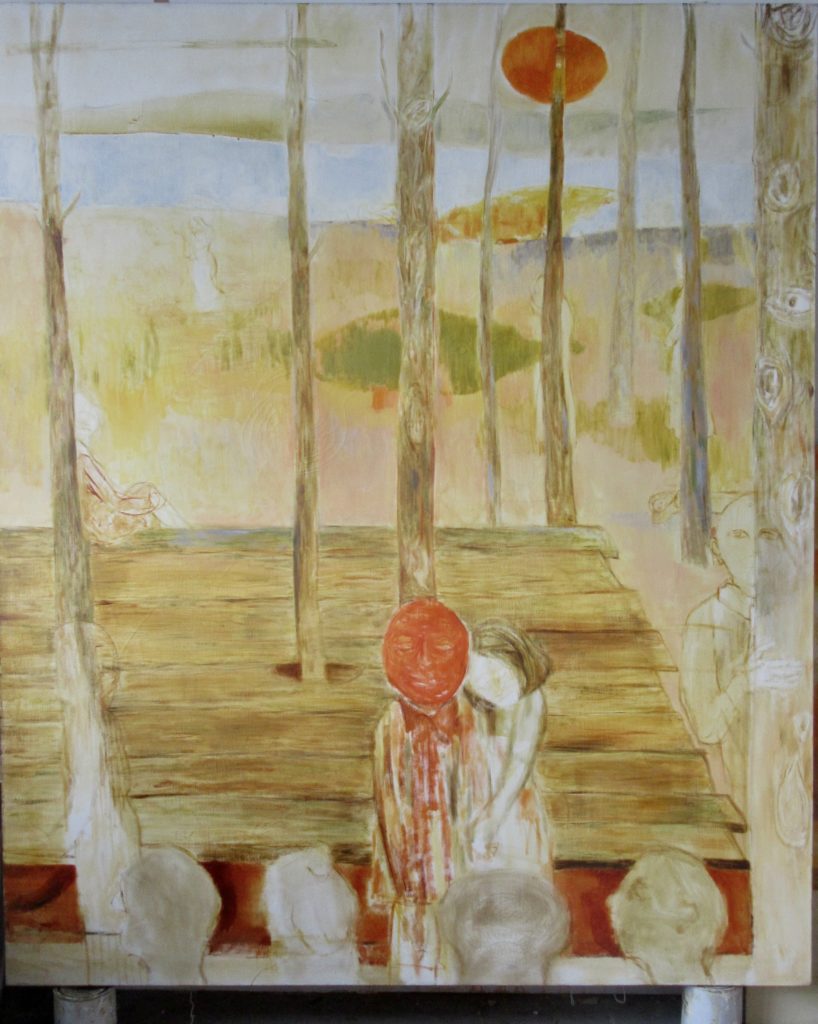
Letter from Glasgow: Poisoned Ground.
Twenty years ago I covered a large canvas with lead white primer. This paint has been banned for over thirty years for its potentially poisoning qualities, but I had a big pot, two and a half litres, bought just before the ban. The linseed oil and pigment paste were separating, so I stirred them round with a stick. The paint is made with shaved coils of lead and has a rich body, unlike any other oil paint. I can still see it falling into itself in thick folds, metallic and yellowish, not unlike the shiny emulsion of raw meringue. I miss it.
A lead ground has to sit on the canvas for six weeks in indirect light before it is ready to be painted on. It is a slow process. First, the building of the stretcher, with saws and chisels — marking the half-way point with a small mallet-shaped gauge and piercing the wood with a bradawl to make lap joints, then attaching lengths of beading to the bars with glue and panel pins. Then stretching the canvas, folding and pinning it, not too tight, with the heavy metal staple gun. Grains of dried rabbit skin are melted in a double boiler to form a pungent viscous glue, applied lukewarm and not too strong (“the texture of apple sauce”), and brushed into the canvas weave. Lastly the lead paint, brushed out in all directions, two coats. And wait.
Six weeks became six months, then years, more than six. The canvas was the largest I had ever made, six foot by five, and as the time grew, so did my doubts about whether I could do justice to that huge, confidently constructed surface, to that open ground — whether indeed I knew what to paint, or how.
I set the canvas aside. Meanwhile I moved to London and back again. I had two children and for a while, no studio. The canvas was stored, blank, against the wall of a small spare bedroom and the children scribbled some spirals on it. When the boy and the girl could no longer share a bed the spare room became my daughter’s room and I had to move the canvas to my new studio, where it stood for six more years. I used to steal glances at it from the corner of my eye, as though avoiding its gaze, but whenever I wanted to paint big I would use paper. I could not face the thought of the painting going wrong on that last lead canvas and I did not know what to paint.
This February, after many months of painting shelters on small strips of old torn-up drawings I suddenly needed more room. Without a thought I pulled out the large canvas, propped it up on two old paint tins, and began. A thin spiralling crack had emerged over the years, like a spider’s web, in the lower part of the paint surface, but that helped me to start. I forgot about the canvas as a structure and it became a space. I painted a stage, a shelter on the ground, with trees. And people — faces in the trees or half-emerging from the trees. They wanted to be painted and I was ready for them. I knew what to do. In the foreground a girl, leaning her head on the shoulder of a strange masked man with a face as red as the sun setting over the water behind. The girl is not unlike my daughter. I’m not sure what will happen next in this landscape that has grown up, after so many years waiting, from this rich and poisonous ground.
March 14th to March 21st
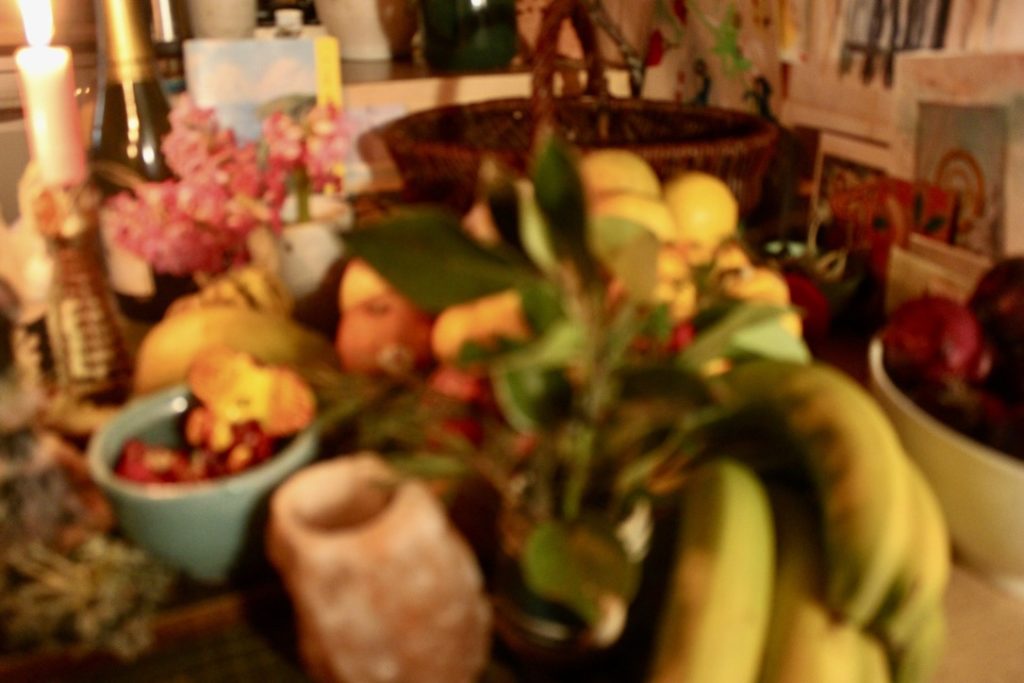
“What else does she like?” Said Mr. Rabbit.
“Well, she likes yellow,” said the little girl.
“Yellow,” said Mr. Rabbit. “You can’t give her yellow.”
“Something yellow, maybe,” said the little girl.
“Oh, something yellow,” said Mr. Rabbit.
“What is yellow?” said the little girl.
from Mr. Rabbit and the lovely present (1962), by Charlotte Zolotow
March 7th to March 14th
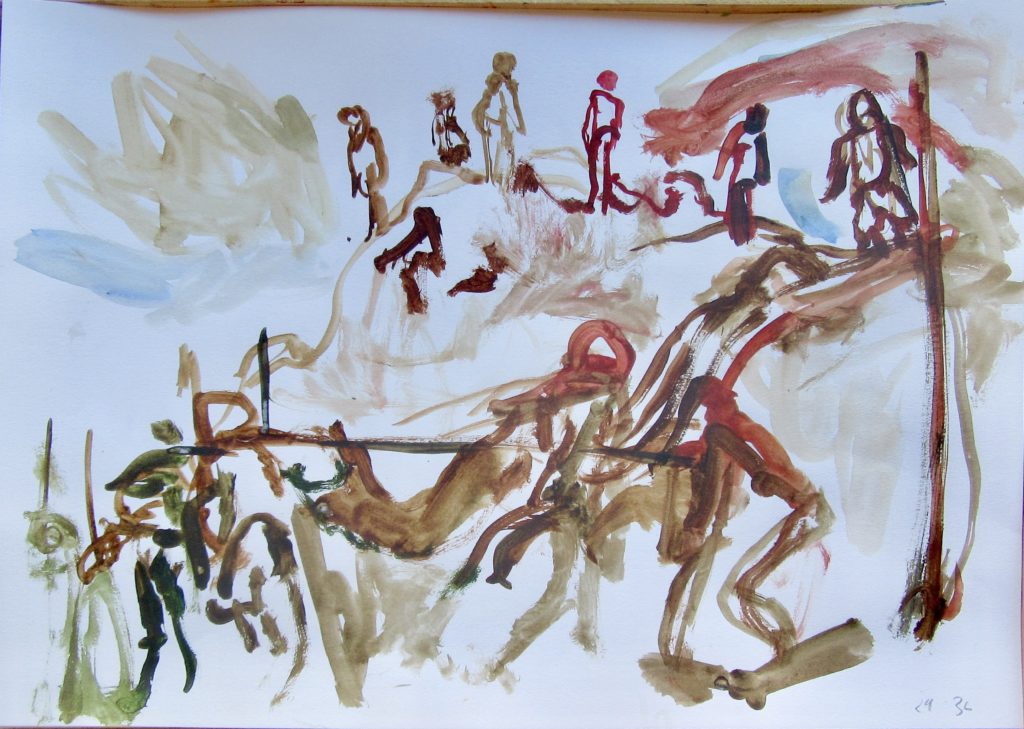
Letter from Glasgow: Impossible City (rite of Spring)
The spring is edging in. On Sunday I crossed the river to visit my friend Maud. On the way I met two other friends, both painters. I hadn’t seen them for a long time as their paintings had become successful, much in demand, and they had moved to a bigger flat further out of the city. I was glad for this sudden sighting in their old neighbourhood and mine. I was carrying a lemon for Maud. She had asked for some fruits to paint and so I chose this rather expensive, unwaxed lemon, with curving green leaves on a tall stem. I sniffed it, and held it out for my friends to smell.
They walked me across the bridge to the subway station. As we passed a parked yellow car my friend remarked on the way that my lemon had all but disappeared into the yellow of the car. Her paintings are strong with colour and of course she would see that, all the gradations of yellow. I like the idea of my lemon becoming invisible in my hand as it passed over the slightly more acid yellow background. As I turned to leave them the other painter warned, watch out for the football. There was a big game on he said. Old Firm. That is to say, Protestants v Catholics. A fixture for which this city is famed.
I stood on the platform and the incoming train blew a leaf from my lemon’s stalk. I picked it up. I cradled my lemon all the way to the Southside. Coming out of the station I missed the crossing lights, and heard a low growling. Out from under the flyover came police, and then a crowd of men, a seeming endless procession of men all with bright blue bandanas tied across their faces, just the eyes showing. They were shouting, Fuck the IRA! I stayed where I was and let them cross. The police went before them and followed behind them, holding them in. The procession went on and on up the hill, filling the wide road ahead. I held my lemon and watched them walk into the sun.
My phone went and it was my god-daughter, newly settled in Scotland after growing up in France and New York. I tried to explain the crowd before me to her. I said that they sang lines like We’re up to our necks in Fenian blood. And that the Catholics had a few provocative lyrics of their own, not all romantic longing. She said, so are the Protestants the richer ones? I said no, often they were just as poor if not poorer these days, that was part of the problem. Engels and Marx were on to it early —religion dividing people more surely than class, especially in Ireland.
At last I got to my friend’s house. We sat at her kitchen table and painted. Lemon in lemon yellow gouache. The sun was shining but it was dark in the kitchen so we decided to go to the park. We climbed up the hill to the flagpole into the line of light, through the small crowds of people busy at their games, pushing prams, swinging swings, glittering in this bright about-to-be March sun. At the top of the hill we stood and looked out on the city, filling the whole wide horizon, and the hills behind it, the light flitting across the roofs.
We looked down the path at the people, the trees and the broad boating lake with swans. We felt the sun on our face after all the blank days without it. Suddenly, we heard a noise, a low drone that rose to a rumble, gathering force and enclosing us like a cloud. It was the unseen football stadium at the end of the park. The voice of the crowd stirring, chanting, roaring and pushing like a wave, blasting exultant with a goal.
We could not see them but at once they had got inside the brightness of day. Insisting, growling. The sun itself had moved on and there was ice in the shadowed air. We went back down the hill, past the tree with roots like fat entwined snakes on the surface, past the lit up lichen and moss on the trunks. The game is nearly over, we said. I had better hurry to get ahead of the crowds.
But I was too late. We paused too long and by the time I left my friend and got to the subway it was ten past six and shuttered up. I keep on walking, hopeful that a bus might pass. I walk through the no-man’s land near the river, a territory of breaking-down buildings and wastelands boarded by hoardings, between wide empty roads and the edges of motorways. I’m intrigued, picking my way through a landscape made for cars, to see how far I might get. It is getting dark but I am hopeful, seeing the motorway bridge blocking the space above the river ahead. There must be a lower bridge I think, for people, and buses to cross.
But as I get nearer, the motorway bridge grows enormous, rising up on its tall cement pillars. It becomes vast as a jaw and I am miniscule inside it, hidden and obliterated. The cars speed high above me and below there is nothing but scraps of grass and litter, empty roads and crossings where I must pick my way. And the river itself so black and wide, and I can’t get over. I will have to keep walking, turn upstream or down, a good distance, until I can reach a bridge. So I go back in the direction I came from, downstream, west towards the sun sinking a garish red band against the water. I keep walking, trying to enjoy it, black river and red sun, and the electric blue lights on the buildings by the water, trying to spring my step, until the path becomes high locked railings, and the bridge still a long way off. I must turn back again, back through a car park for a complex of amusement arcade and bowling and cinemas and chain restaurants. I look in at people who don’t seem to be real people, eating in rows. They look as though they are trapped, but I am the one who is trapped — by the car park, the lack of Sunday transport, the town planning and not knowing my way.
I want to stop, to lie down right in the middle of the car park, and protest: this is impossible! But I have to go on, back through this made-up place and back along the road to find a bus stop. And then, the roar again. And the sound of marching, the sound of hundreds of police marching four or six deep in a long steady procession. Police on horseback too, and behind and in front of them sixteen police vans trailing with grills and flashing blue lights, the lights are flashing silently, and the vehicles move slowly, at the pace of the police feet and the horse’s hooves, taking up the whole of the road, to meet the distant roar of men we cannot see.
I’m exhausted. I find the bus stop and wait for a bus which will take me one stop across the river for £1.70. Where I will need to walk again and wait half an hour for another bus to take me home. I am feeble and tired, and powerless against this city configured for cars. My phone is not smart, and anyway I like to walk without maps: the map denies the pleasure of physically outwitting the city, navigating by physical memory, instinct and guesswork. A digital map would intervene, disconnect me, and be only a sop to inclusivity — a coded proof of the city’s impassability for a person on foot, a timetabled notification of the lack of buses. But I am unused to finding myself at the mercy of the city’s scale. The impossible space of this city of motorways and concrete bridges and wasteland, this un-navigable city. I am not used to such powerlessness.
And when I get home at last I lie on my bed and realise that the city I walked is inside me, all of it, the great black space of water and the dark enormous cavern of the bridge, the empty roads and marching police. All of these are now inside me, that had threatened to engulf me. I can do what I like with them. I hold the impossible city. It sinks down inside to join the other cities and other streets, some of which I will never walk again.
February 28th to March 7th
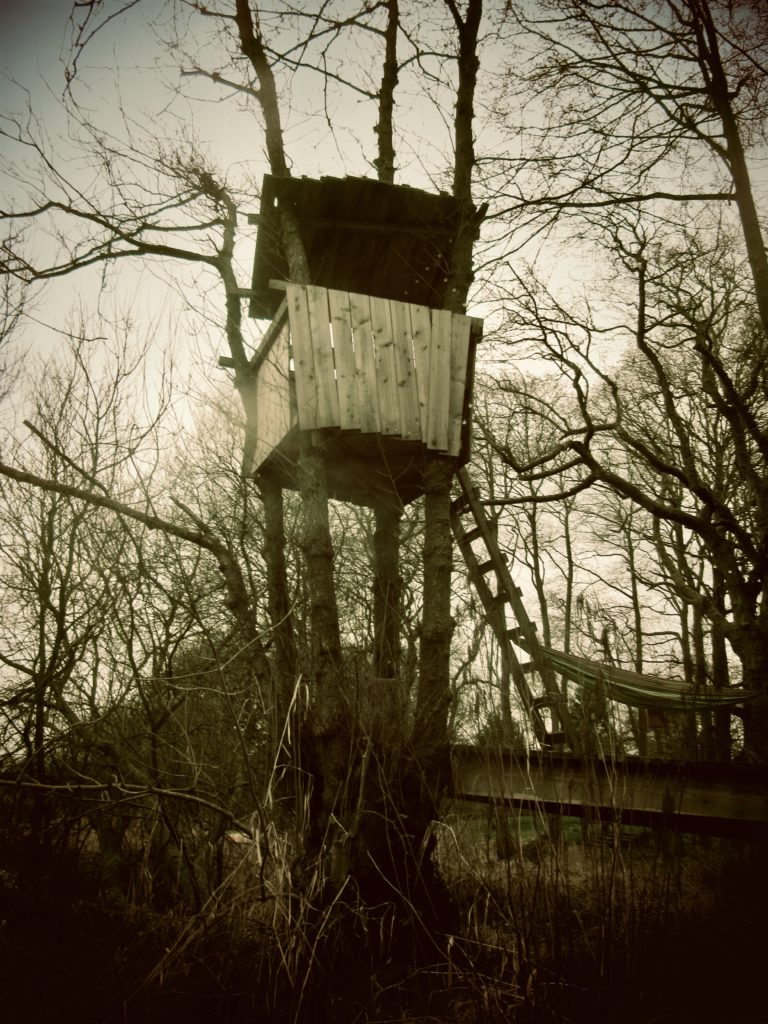
February 14th to February 21st
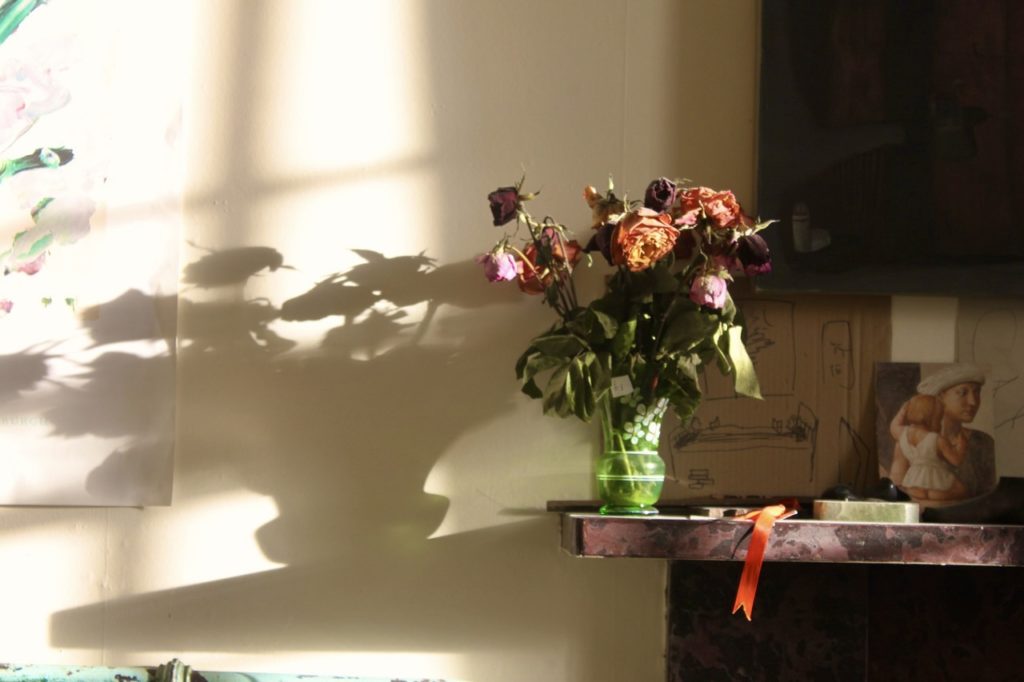
Letter from Glasgow: Shadow and Ice
A fortnight ago, Dettie and I each chose photographs we had taken of imaginary mountain ranges for our contribution to the week’s Crown Letter. It was a surprise to us both to find this echo — our miniature details, imagined enormous. Her mountains were made of ice and mine were shadows. Both were subject to the passage of the sun for their fleeting life. Impermanent mountains pointing at the return of the sun after a long winter.
The following day I met Dettie in my dream. I said to her, I can’t understand why I am so tired. Then I remembered. I had given birth to a child in the night. And it had taken ages. A long slow labour, like an endless drive in the dark.
Isn’t it nice to have a child? I say to Dettie. She says that she too has just given birth but she was so tired she has sent her child away to a hot country until they are weaned. I don’t know what came over me, she says. I think she means the child and not the sending away. At that moment a big grown up daughter climbed into her lap.
How strange, we say, to have this late chance. For Dettie and I were born in the same year, 1968, and by any normal reckoning it would be fairly miraculous for us to spontaneously give birth like this.
I woke up, and the child melted from me like ice, like shadow. But the memory of that fierce beginning love clung to me and stayed for at least the rest of the morning.
January 31st to February 7th
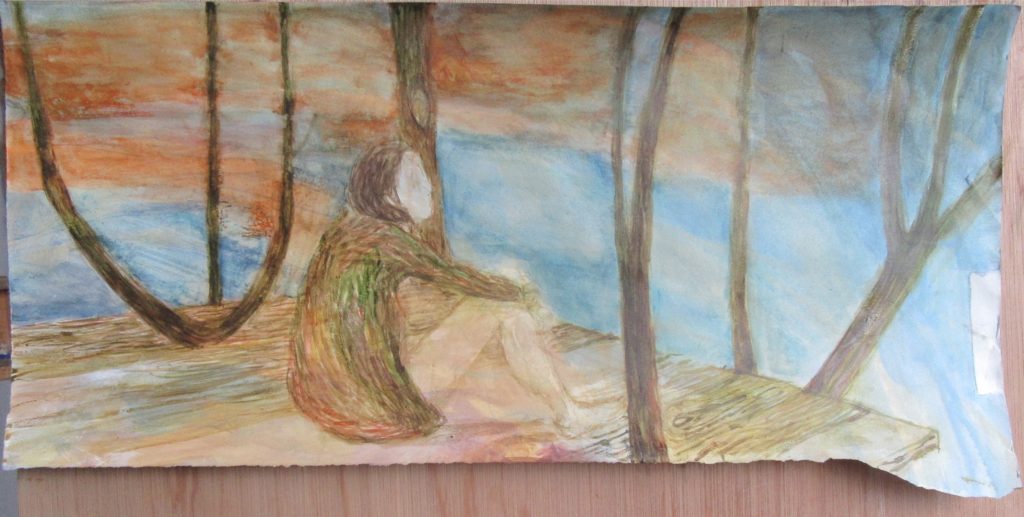
Letter from Glasgow: Looking Out
It’s the last day of January. The low red light outside meets the red sap rising inside, in the reeds and branches on patches of unbuilt ground in this city. Red is for readiness. The year is about to kick into place and it is time to wake up. It would be tempting to stay warm inside, wrapped in the dark, looking in, but it is a swift stride from spring to autumn, the time when the lights inside go on again, to pattern the dark. It is as well to wake up now, look out, reach out for whatever presents itself in daylight. And the possibility that this might not be the same thing, that things might be said differently, heard new, seen, as if for the first time, if we allow them.
January 24th to January 31st
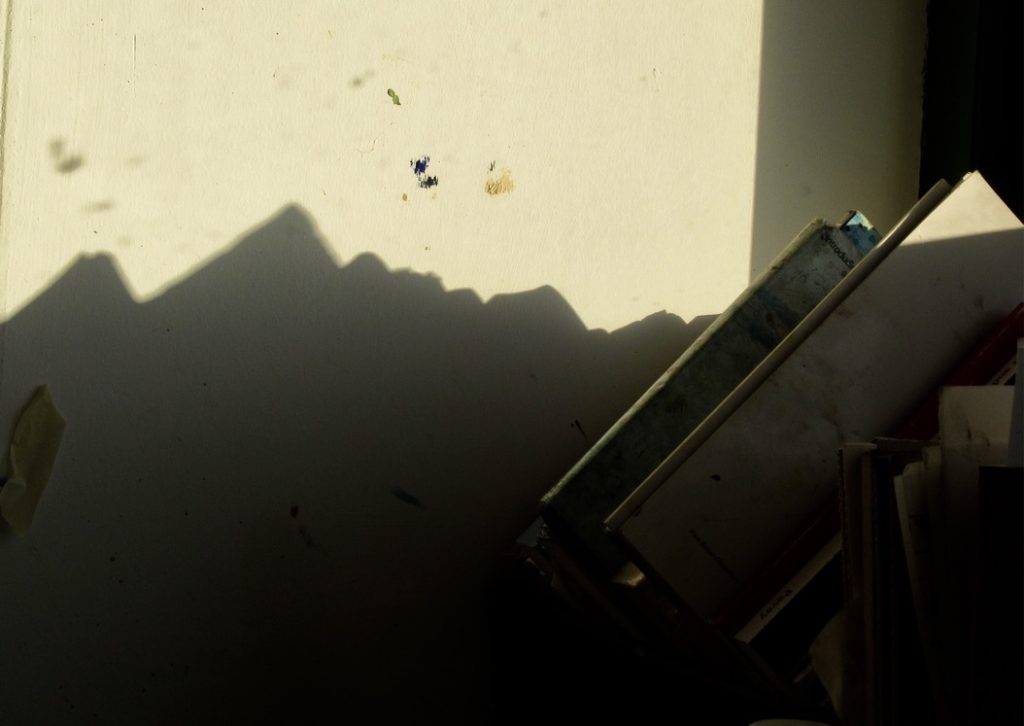
January 17th to January 24th
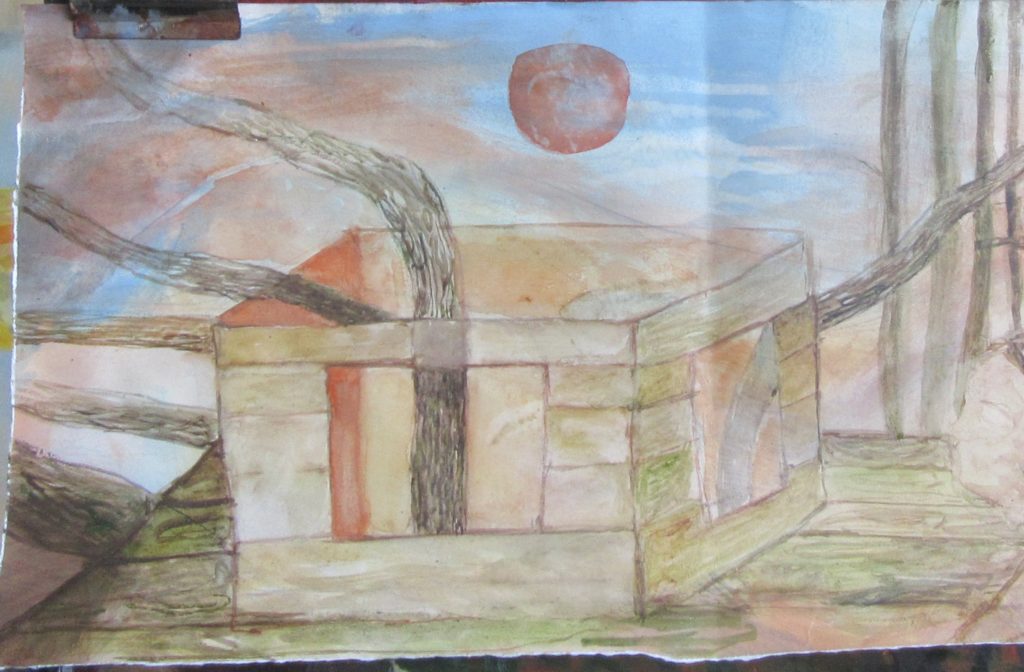
Letter from Glasgow: Still Refuge
My best friend’s mother, who found refuge in London from Iran in the nineteen seventies, used to tell us how in midwinter, in Iran, the seeds of many pomegranates are extracted from their shells to make a glittery red heap, she told us it was to invoke the light of the sun on the darkest day of the year. I pictured vast metallic bowls of shining deep red seeds under pools of light in dark rooms. We never shared such a feast, but she did share her copy of the Persian poet Hafez, opening it at random to let it fall at lines that might have special wisdom or importance for us, which she would seize on with excitement or a resigned nod.
Last Midsummer in Glasgow a Yemeni refugee poet came to my flat, brought by a friend. She recited a poem that held us — it was about the sharpness of light on a table, and we looked at the table we were sitting at and listened to her say how it would be enough to be just half of who we are, for to feel in full, even half of the things that strike us, is more than enough. The brightness of light suddenly entering a room, how even half of such strength would be enough.
We sat about the table listening to the leaps of her voice. I thought about belonging to this table, about points of light, longing and belonging. I was thinking of longing as a sort of lassoing, a sort of looking — casting your gaze, casting out towards, a setting forth. An chiad lar as the setting out, the starting movement of the tune is called in Gaelic pipe music.
And now it is Midwinter, already three weeks past the shortest day. It is time to throw yourself forward, cast yourself off into the year, like a rope — except that here in Glasgow the lid of early morning dark remains firmly on, even as light creeps in at the end of the day. We hold fast to sleep, waking in disbelief at the darkness each morning as if in the midst of night. We lie low in tunnels of sleep for as many hours as we can muster, ten, twelve, staying safe inside the variegated bright motion of dreams.
But it is time to get going, to throw yourself in. I have held off as long as I could. I have celebrated every feast there is — Christmas was just the warm up act, then there was New Year and Russian Christmas a week later and even Old New Year this weekend. The old Orthodox calendar feels more suited to Scotland for it is only now that the sun begins to show itself, a slow bleed. It finally entered the kitchen this morning, and my friend who was staying said, this flat is like St Petersburg, or really she meant Leningrad, for it was the old flats we had known from the 80s and 90s that she was thinking of, the decrepitude, the chaos, and the high ceilings.
This morning, for the first time, a thin line of light enters the dark corner kitchen, unfolding the space, opening it up. And on the radio, the delicate dirge of Gavin Bryars’ found recording of a homeless man in a London shelter singing — Jesus’ blood never failed me yet .. on a loop. A daring choice by Kate Molleson for Radio 3 breakfast, I’ve heard it before but late at night, Monday at ten past 8 it is more likely to be Bach, Purcell or maybe Britten. The light is a slow bleed and Jesus’ blood, never failed me.. yet, turning round and round.. The melancholy of this pale mid January morning, and my friend saying this is St Petersburg.
We had toasted old New Year at the weekend, both of us remembering our friends left behind in Moscow, and others scattered in Tbilisi, or Erevan, those who had left their homes suddenly, to avoid conscription or in despair at making any future in their country. We wonder when we will ever get back to the city that has been so central to our bearings, and who we will find if we do. We sat at the table and chopped up hard-boiled eggs, potatoes, gherkins, herrings, dill, to make a modest feast with which to see in the old new. Again in this kitchen in the half dark of early morning we permit ourselves a small indulgent nostalgia for the things we have loved about this now pariah country and for the love that was shown us there. A love that is now not really speakable in the face of the unbounded and relentless violence. We turn over our last visits to Moscow before the pandemic, wondering if we might have anticipated this.
We are walking through Glasgow, in the rain, remembering Moscow. We are talking about love as work, how love is never a given, how it must continually be renewed, be re-made. Love as a task. I remember the lectures I followed so intently thirty years ago on the internally exiled Russian philosopher-philologist Mikhail Bakhtin, on his distinctions between the hard given facts of the world and that which lies before us as potential — the things that are conceived or made from these inert presences. The connection between the mute existences of the world (dannost’ ) and the perpetual task or work (za-danie) to make something of them in words or action, in “speech acts”. The world before us is not enough, it must be set in motion through our seeing and our speaking. And this is something true also for the making and re-making that is our daily work, by which we orientate our way through the empty spaces that present themselves each morning — that must be inhabited and walked through.
It is time to begin work, to resume the work, to resume the wait and the hope that things cannot remain as they are, that these slow and stubborn shifts of weight will yield sudden lines of sight, new configurations, ways of being different.
December 13th to December 20th
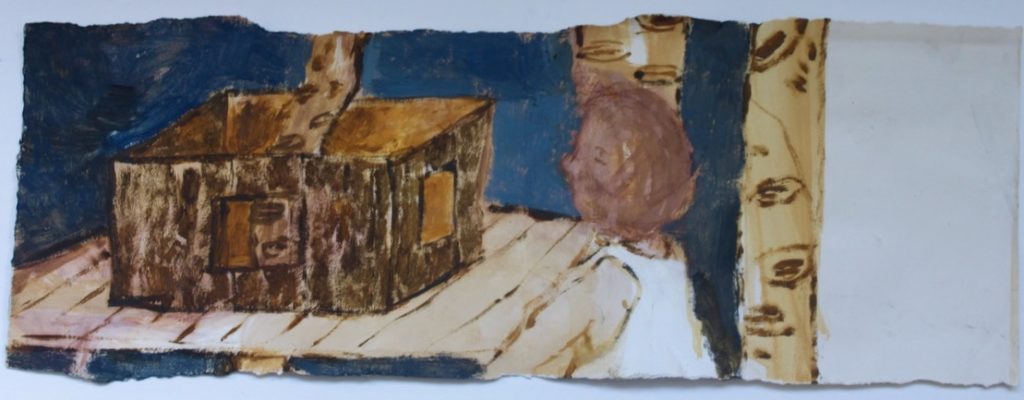
November 29th to December 6th
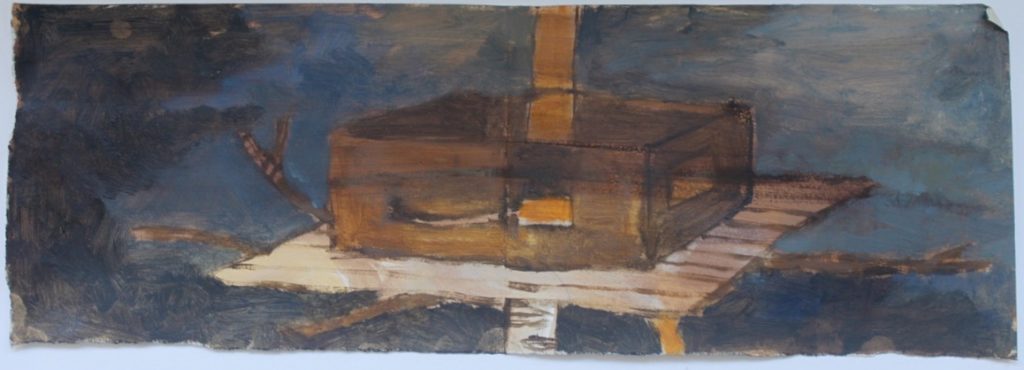
November 22nd to November 29th

Postcard from Glasgow: Shelters
I started making these small drawings of shelters, and trees, last November, as the trees shed their yellow. They were about inhabitable spaces, in the mind’s eye, and in the drawing. I made them on torn up strips of old life drawings from twenty years ago, that I did not want to throw away, regretting the waste of good quality paper. The images kept on coming, as if wanting to be painted. When I taped them to the wall in the spring, they seemed somehow to fit the awful circumstances in which they were now situated. Not a direct depiction, but not unrelated to the bleakness. And at the same time they were about a sort of refuge, a waiting or suspension. It’s November again. And the war is relentless, still. And I am still painting shelters.
November 15th to November 22nd

Letter from Glasgow: Our Fathers
Friday was Armistice Day, marking the truce that signalled the end of the First World War. As I watched the television Remembrance ceremony on Sunday morning I was thinking of writing something to do with war for my Letter from Glasgow. Just after the eleven o’clock silence a message flashed on the screen from Manuela. Dettie’s father had died, on November 11th, this Friday, and the suggestion was to make this week’s Crown Letter an Hommage to Fathers in recognition of her loss.
I was reading this mail, and listening to the voice of my own father, who has commentated on television broadcasts of the Remembrance ceremony for several decades. He does other public broadcasts as well: State Funerals, the Opening of Parliament, and General Elections. He is known as a “voice of the nation” but I listen in for my father’s voice. I am not a poppy wearer, nor a monarchist, but on dark November remembrance weekends in Glasgow I have usually listened to the Cenotaph and watched the blue sky, plane trees and sun on the grand white stone facades far off in London. I turn on the TV and my father’s voice enters the flat for two hours. I light the fire, and when I go through to the kitchen to make tea I can hear the muffled pitch and cadence of his voice across the hall, as if it was still my childhood home, and he was there in the next room talking.
This morning I am watching with my daughter, in bed on a laptop. His voice is good isn’t it? I say. Yes it’s warm, she says. The voice is a public voice, doing a public broadcast. We don’t speak very often in private. My Dad is very busy and I live far away. He doesn’t like the telephone and if he does answer a call he soon has an excuse to break off. He says himself that he feels easier speaking in public than in private. At eighty four, it is his work that drives him. So it is from these public broadcasts that I gather in the comfort and the intimacy I still seek.
My father’s voice, that sends me straight back to childhood. The voice as it enumerates these marching regiments with their medals, their histories, colours and clothing, is simply the voice of my longed for father; it is the same voice that made up stories for my brother and I as children, that compelled our earliest imagination, a voice that is solid and warm and holds me, keeping the more frightening things of the world at bay for a while. A voice so familiar to me that it is already inside me. A measured voice, careful and without cliché in his choice of words, his narration of this particular story, and a voice in which I hear echoes of my earliest love and attention, no matter if I must now share it with millions of other people listening. I listen in to every last syllable, I take it in. I hold on to these traces of his voice, the slight breaks in its rise and fall, the pauses, as marked on my memory as the rhythm of creaks on the stair in the house I grew up in, where I lay in bed and heard him climb the stairs to his study at night, to prepare for his performances.
The marching, the laying of wreaths, to mark a truce. Before I heard the news about Dettie’s father from Manuela, I had written down my Father’s words about the dead, in Ireland, and elsewhere. The dead in Ireland, “who paid the price for our failure to resolve conflict” . I think that this is a good sentence, and approve the our. I note it down, perhaps to speak to him about it one day. Later I think about truces and conflicts, in families as well as in war, and the ways that we try to resolve them. I think of the encumbrance of having a well-known surname, but of how this matters less in Scotland, and even less in the international collaboration of our Crown Letter, remembering how glad I was when Dettie first mispronounced my surname, the relief of remaining unrecognised, keeping me safe and hidden, distinct from my father’s name. And yet she always addressed me by my full name and surname when writing to me privately about things that I had written, making me feel that this name was also my own.
When someone dies it is strange how their voice can surface. A long familiar voice calling out from deep inside us, as if summoning us. A voice that we have harboured without being aware of it but that suddenly speaks, as though to comfort, to question, to seek our response? Catchphrases, snatches of tunes, nicknames, our name — called, a voice suddenly loud inside us with the exact timbre and texture of the living person — ricocheting about in the deep unfathomable tunnel of everything that we contain. We hoard so much of the people that we have loved, without being aware of the way their traces are laid down inside us — voices, words and phrases, the rhythm of their movements, the sound of their tread through the house, the smell of their tobacco, their cough or sniff or sigh or the way that they shudder. As if to guard against their going. As if they were still there.
Lest we forget. For Dettie’s father and for our fathers.
October 25th to November 1st

Postcard from Glasgow for Sudha Padmaja Francis (Week 119)
You can never have too much yellow Pierre Bonnard
October 11th to October 18th
Letter from Glasgow: Noble Pianos
In March my friend Nadia sent me this video of a bombed out house in Ukraine. I thought it was someone she knew, but it turns out the clip was widely circulated at the start of the war. A woman returns to her house after a bombardment. The first thing she does is to dust down her piano and start to play. As she plays, the other person filming moves the camera about the room and then out through the door and through the house. The camera swings and swoops with the expansive runs of the keyboard, the player’s hands gaining force and confidence with the cadences that ripple out as the camera tracks a trail of rubble and destruction, in every room and down the stairs. At the foot of the stairs the ordered line of shoes by the radiator by the front door is only slightly disrupted. The pair of felt boots with rubber toes have fallen separately, valenki. Valenki, tapki, the ubiquitous out and indoor footwear of Ukrainian and Russian homes. Such lines of shoes are the first things that greet you as you cross the threshold into the private space of a house. Down the corridor, smashed glass, the washing up still in the sink, a whisk in a milk pan, and below the window, a child’s toy hard hat on the floor with the real rubble. We hear news of bombardment, and we see the cities with their half-collapsed and burnt out buildings, but it is shocking to see the everyday interior, the fine detail of doors and wardrobes and windows, smashed and fallen. To think of this multiplied endlessly — all the rooms, all the sad belongings — shoes, clothes, pictures, chairs and tables, scattered and crumbled.
Last month I went to Paris. I saw the daughter of my oldest Moscow friends. I used to babysit for her in Moscow when she was a child, thirty three years ago. Masha left Moscow as a teenager and now has her own children, in Paris. Nadia lives across the street from her, she left around the same time. Masha’s parents introduced Nadia and I in those early Moscow days, when we were both obsessed by painting, and we sat about the kitchen table shyly, in the flat where they still live — a top floor flat in a building without a lift, a flat almost entirely unchanged from Soviet times. There are four rooms, with books to the ceiling, old postcards and photographs curling along the shelves, dusty plants in broken baskets, unvarnished parquet with some of the tiles coming loose or missing. The papered walls are torn in parts where the children’ beds used to be placed, and you can see back through the layers. The window frames are raw and peeling, but are the old-fashioned capacious sort of double-glazing, with space enough to store things in between the two frames of glass. I found this flat deeply reassuring when I lived in Moscow as a student, and loved the many times when we sat about until it was late and they said to stay the night, and made up the narrow hard bed in the far room under the shelves of Mandelstam and Gumilev, where I slept and dreamed much more deeply than at our student hostel, anticipating the languorous next day of slowly getting up and drinking tea, and more and more conversation. This flat reclaimed me many times after I was no longer living in the city, and each return felt like going back to a profoundly private home that I had forgotten was there. My life between felt like restless wandering and this the true centre, where I was held.
Masha doesn’t agree. She does not regret Moscow or even the flat where she grew up. And I concede that nostalgia is not in order at the moment. Masha’s brothers have left the country, one to Israel and the other just a few weeks ago, leaving behind his job, wife and children and crossing to Georgia via Armenia. His family will join him soon she says. My Moscow, that I cannot reach, is fast diminishing. Only the elders are left. Yet I miss them badly and sometimes think I would chance crossing the border at Finland for the sake of being back for a few hours in those flats, inside the walls, watching the city’s light move through the quiet rooms as I listen to my friends’ voices talking, take their words inside me.
Masha shows me a photograph on her phone. It is her father, sitting at a grand piano in an almost unrecognisable room — but it is the same room I once knew as a chaos of books and desks and beds, where the children slept. The room was partitioned into small spaces by low walls of books to make separate enclosures for three of the five children. Now it is completely empty, apart from the enormous piano, and the old map in its permanent place, showing Palestine in biblical times, marked out in Cyrillic letters. Everyone is leaving Moscow, and they can’t take their furniture with them, says Masha. It’s like after the the revolution. Doors are closed on abandoned flats with their libraries, furniture and grand pianos. And so Masha’s father has become the caretaker of a full size Bechstein, that somehow made it intact up the six flights of low lit, dusty cement stairs to the large padded double doors of their flat. The room was cleared in its honour and looks suddenly, improbably, elegant. The rough parquet seems to stretch enormous in the space. And Masha’s father, who all his life longed for a “royale”, a real grand piano, plays music into the empty rooms of the flat.
These two images echo each other in my mind — two grand pianos singing. The woman in the Ukraine flat in early spring, the start of the war, playing out to spite the devastation, and Masha’s father this autumn in Moscow, his children and grandchildren gone, bent over his long dreamed of piano, playing on as his city becomes ever more unreachable.
September 6th to September 13th

Letter from Kilcar
Kilcar, Donegal, July 2022
The blue and yellow flags outside the houses here are not for Ukraine, they have always been flying in front of people’s houses, on the driveways and in the hedges, blue and yellow for the Gaelic football team of Kilcar, a village just below the better known Glencolumkille, in South West Donegal. We come here every summer. My children’s great grandmother grew up here, one of thirteen children, in a low two room dwelling up the side of a glen. The half-ruined house is still there and used as a store for sheep feed. There is a tarmac road that runs up to it where a windmill has been put up on the land, just above the ruin of the house.
Each year, at the end of July there is a fleadh, a music festival. On our last night it was the “rambling session”, a walk while playing, up the long road out of the village. The road rises up along the side of the hill, out above the church, the cemetery, the wide football pitch that ends in a small sea harbour. We look down at the settlement beneath us as we climb, and across the sea to the indigo shape of Sligo before us, and at the fiddlers in front leading the way. The road is banked with high hedges of fuchsia and montbretia, resilient in this western wet, the air is warm. Each year, the procession stops at the house of a well known fiddle player, now many years dead, and there is music and dancing outside the house. The musicians go in and take their places on the wide tarmac drive. At the back of the house cups of tea and coffee are handed out through the kitchen window from a kitchen full of shiny urns and steam. On a table outside there are plates of scones and sandwiches and slices of cake, covered over with flimsy cling film against bursts of rain. There are benches against the house for listening to the music and most years there is dancing on the tarmac. Children run about on the grass and kick balls into the road.
Under the tarpaulin awning this year there is an array of fiddlers of all ages, young pale freckled faces and older, rough red cheeked and white haired. There are also two accordions, guitars, a bodhran and a flute. The players settle into their tunes and are brought tea, and glasses of whisky are offered to the elders.
We are standing, listening, watching, looking out at the players, and across the road to the sea, gulping the hot tea, when one of the musicians introduces us to a woman, Nadia, who is from Mariupol. We greet her in Russian, which is straightforward as this is a Russian speaking part of Ukraine. Although every refugee I have met so far in Ireland or Scotland has been a Russian speaker, it is still polite to ask, you can’t presume, now that everything is charged and the language a person was born into has become the language of the aggressor. The woman is staying at the hostel in Kilcar, alongside several other refugee families. Nadia says that there are now forty three Ukrainian refugees in Kilcar, twenty arrived last week and were housed in an empty building on the main street. The population of the village is listed at around 250. She says she doesn’t know why more people aren’t lending their houses, so many empty houses here she says. She has been here for three months, she is glad to be here. It’s peaceful, she wouldn’t want to be in a city. “Here it is quiet and beautiful, although damp.. syro-vato, and the sea is cold, and there is nowhere to change on the beach.”
There are two beaches near the village. They back almost onto each other, joined by a thin strip of road. One faces out to the Atlantic and the other is sheltered and faces towards Sligo. The Atlantic beach is known as a dangerous beach. There have been reports of drowning — most often cited, the death of a local priest. It is the wilder, more beautiful beach, with green fields shelving down on each side. Sometimes you can see dolphins leaping high against the horizon, sharp black slivers in the silvery light. We saw another woman from Ukraine on this beach the other day, she was young and alone, and she smiled as she walked out across the sand, and sat down on a rock with her book. She did not swim. I didn’t speak to her, only smiled back as she passed. I had not known then that she was from the hostel, or from Ukraine and anyhow, she may not have wanted to be disturbed.
Nadia tells me of the Sea of Azov, back home. The Azov sea was warm and healing, she says, there were many health resorts and sanatoriums there. People would journey from all over the Soviet Union to seek out the healing properties of the clay from the sea bed, rich in iodine.
Nadia says that the war will end and she will go back, but to what? All our lives we worked, we built, she says, and now .. everything is gone. It’s alright if you are young, but how can I start again? She looks a bit older than me, perhaps late fifties, sixty? She shows me her coat, the fine stitching of the collar.. she sewed it herself. This was my business she says, I built it up from nothing, making clothes, sewing. She has been selling things in the local shop, small sewn items. I recognise the word she uses for someone who sews — Tkach from tkan’ for а woven textile. An old philosopher I knew in Moscow told me that his name was from the Ukrainian for tailor, Sukach, from the more archaic sukno, cloth. Tkach, Sukach. . I turn the words over silently on my tongue. The Sukach I knew worked on Russian pre-revolutionary writers, and in particular the one I had chosen for my thesis, back in the early nineties. He was interested in eccentrics and outsiders from the progressive literary wave, the “literary exiles”, doubly exiled by Soviet censorship and neglect. Some were nationalist, or Orthodox, but their nationalism seems a cosmopolitan sophistication in the context of current versions of “Eurasianism” being peddled by Moscow politicians, however much they claim to be part of a philosophic tradition.
They are calling for a dance. We get into pairs and then into sets, facing rows of four pairs, lined up along the sweep of tarmac to dance the Siege of Ennis. Nadia, me, my children — to and fro and round about with the person opposite and the person by your side and then moving as a four, on to the next line. Locals, visitors, strangers and enemies are forced face to face in the dance. And then it is time to go. Nadia wants to meet up but in the morning we are leaving, getting the boat to Glasgow. I promise that we will look for her when we are next back.
The next night, back home after an eleven hour journey by land and sea, I look across the street to the house opposite. The painter woman who I used to watch from my window moved out this summer and the student from India got married, the rooms are now empty. The curtains are drawn back on their neat dark spaces and the railings make a patterned shadow diagonal under the street lights. I remember the lines from Rozanov, the writer I studied with the philosopher whose surname was a Ukrainian tailor: Love not only things, but also the shadows of things. I hope that when we go back Nadia might have made her way home, that the war will be over and that things can begin to be mended. But it is hard to know.
June 21st to June 28th
Drawings from the bobbin factory, after lunch, Bourg-Argental, June 17th 2022
May 3rd to May 10th

April 26th to May 3rd

April 12th to April 19th
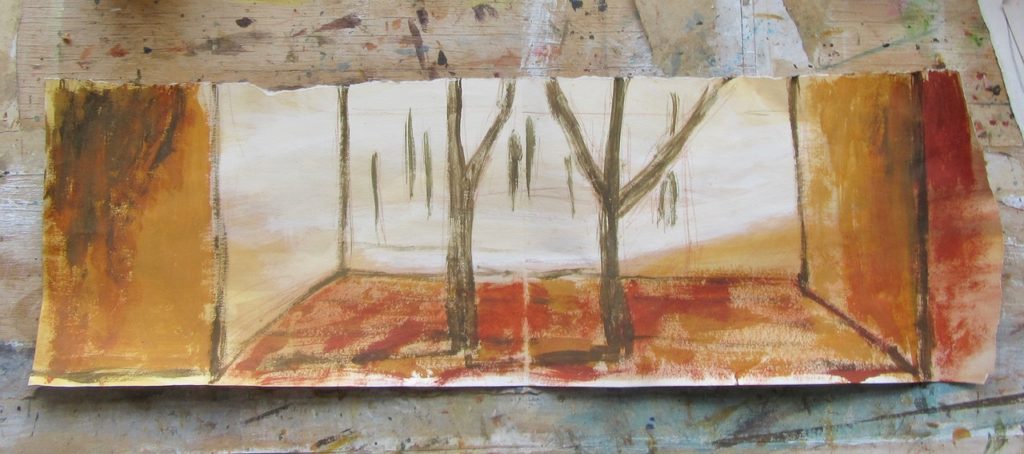
April 5th to April 12th
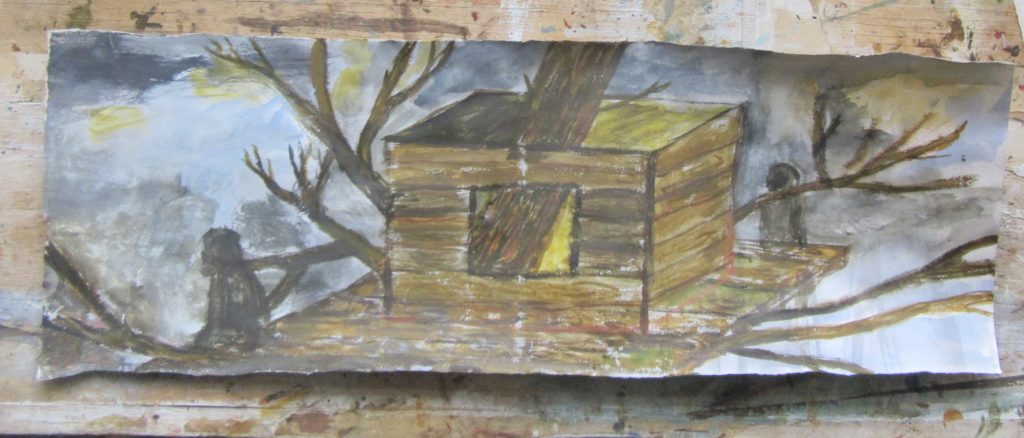
March 29th to April 5th
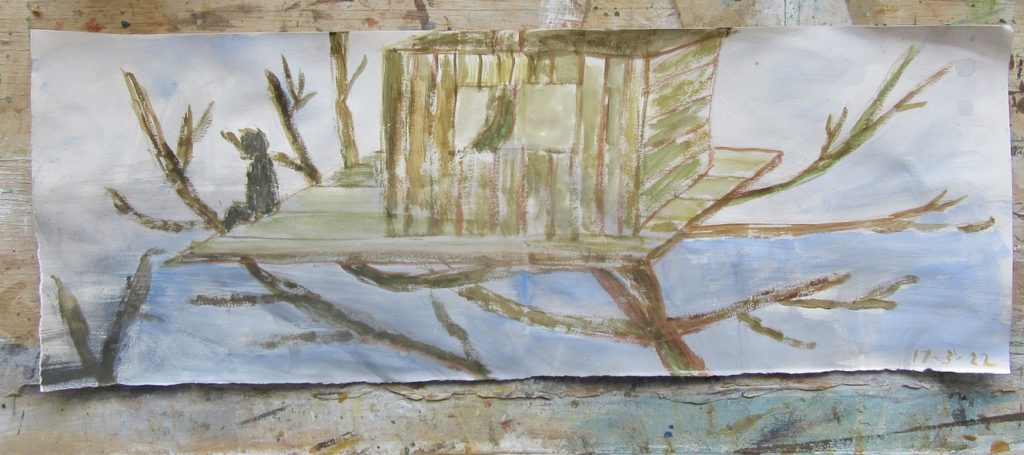
March 8th to March 15th

Thinking of women in wartime, March 8th 2022
March 1st to March 8th

Yuri Hasenko (b. Kislovodsk 1894, d. Paris 1933) was a Ukrainian politician, diplomat and writer. He was sent on a diplomatic mission to Europe by the Ukrainian People’s Republic in December 1917. In 1920 he became a member of the Foreign Group of the Ukrainian Communist party, established by the writer and artist Volodimir Vynnychenko, and contributed to the Nova Doba newspaper, which published Vynnychenko’s own (Ukrainian) Communist Manifesto: To the Class-Unconscious Ukrainian Intellectuals, that year.
МИР НА УКРАÏНИ!
February 22nd to March 1st
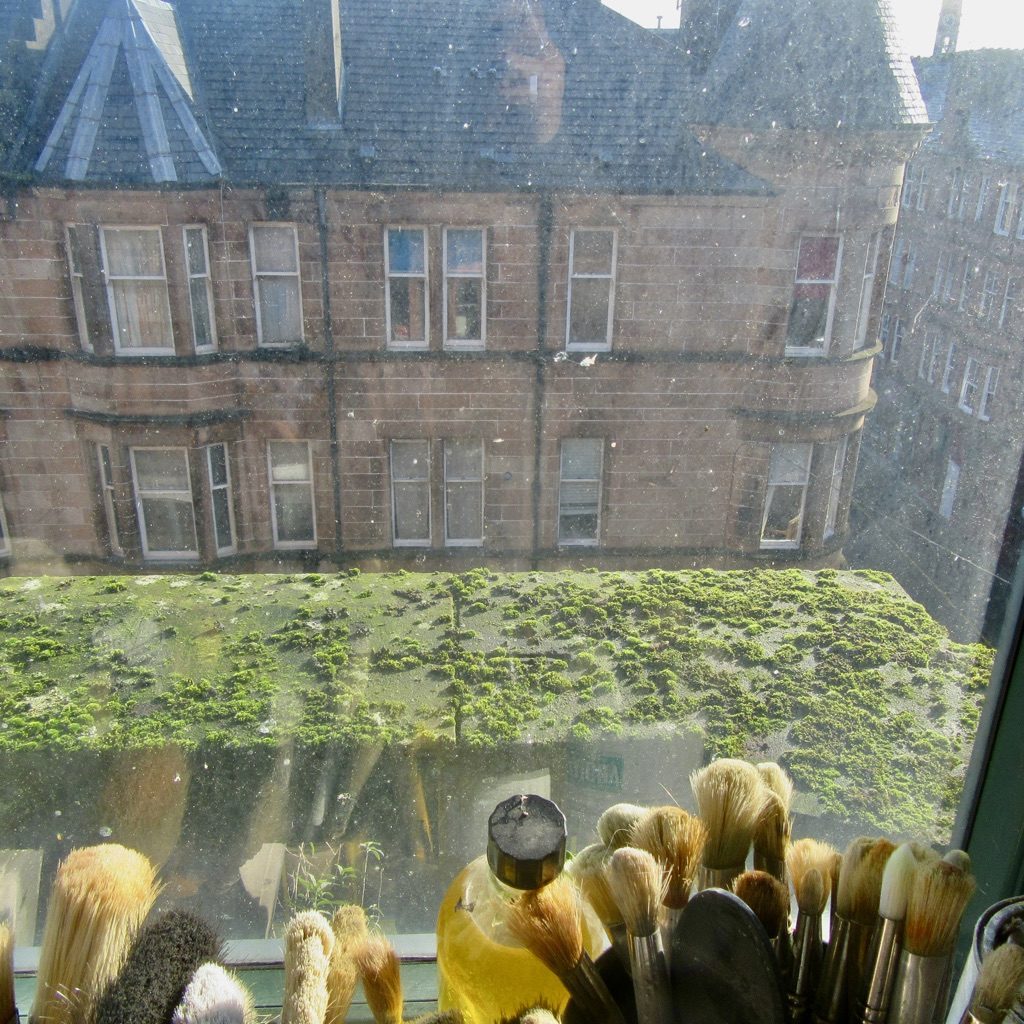
Letter from Glasgow: Science Fiction
These past days have been full of gales and hail, a continuous series of storms, named in alphabetical order. From the studio I watch the wet snow and hail flying about. Walking the streets below after the first night of high winds, I noticed that the pavement was full of small green lumps, rounded shapes of soft springy moss, smaller and larger, like a processing army peopling the paving stones. I had never seen such a gathering, but realised that they must have been blown down from the gutters, or the slate rooftops by the lifting winds. And now here they were among us. There has always seemed to me to be something friendly, comforting about moss, its springy, water saturated gentleness — so I did not feel threatened by this mass occupation of the pavement, although it was strange. I felt at home with these small creatures, reassured by their presence on the wet stone, by their proliferation, even. Up in the studio, I saw that the moss on the parapet outside my window had certainly diminished. Many of the larger lumps had taken flight, descended to the pavement, and there were bare gaps where once there had been bouncy hillocks of green. But I trust that they will grow back deep and soft, and cover the stone once more, keeping their company.
February 15th to February 22nd

A pause, not a deferral
February 8th to February 15th

A time of suspension, a holding time. For MD from LD, 8.02.22
February 1st to February 8th
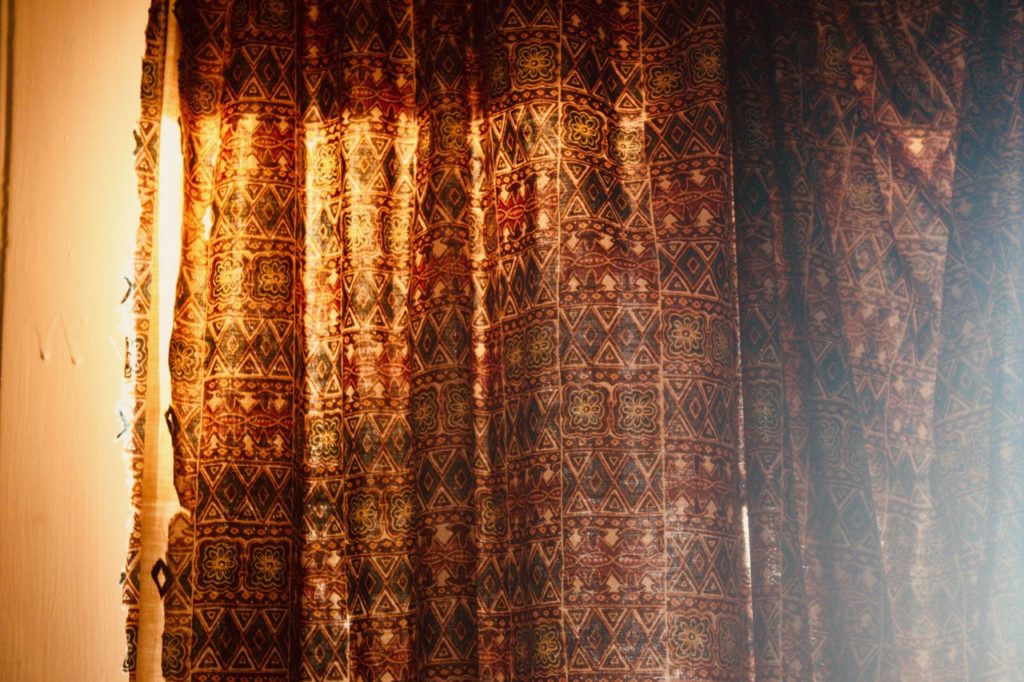
Letter from Glasgow: Hiding Out
Glasgow’ s latitude is 55.8642° N, 4.2518° W. It is almost the same as Moscow. The January mornings are dark and heavy. I sleep late when I can and roam about my dreams. Two days ago the sun nudged just above the walls of the back tenements, enough to push a triangle of light into the corner of my room for the first time in months. I took its picture.
I live in a city far from where I grew up, and miss the city I grew up in, although I am not sure that the city I want to go back to is actually there where I left it. I inhabit instead this stretch of space that is somewhere between the Moscow that I trod deep inside me over thirty years ago and the spaces of my childhood. Sometimes I wonder if I am just hiding out, waiting for a return, like this bleed of sun at the end of January.
January 25th to February 1st
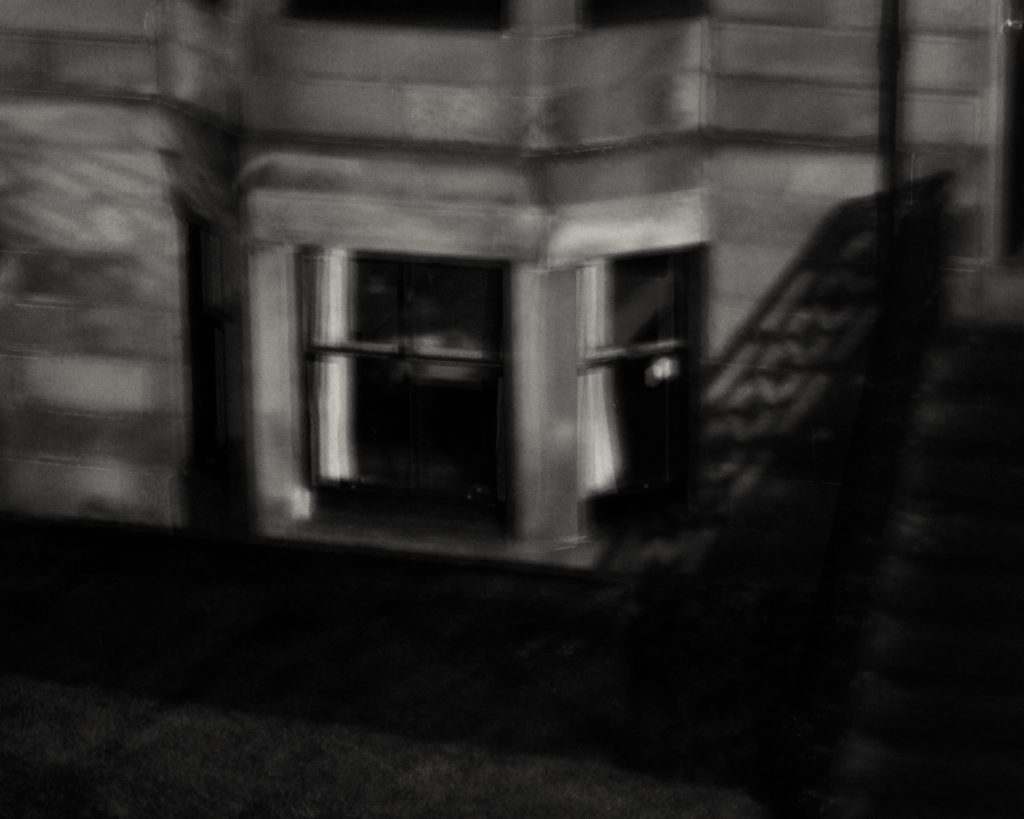
Letter from Glasgow: Empty Room
The basement room opposite my window has been empty until today. On Christmas Eve, the woman who lived there died. She was 32 years old. She shared the flat in which the woman painter and the student from India who I had got to know over the lockdown live. The painter’s room is directly above the basement room where the woman lived and died. On Christmas Eve she was away visiting family, the student on the other side of the landing raised the alarm. Police arrived, and four emergency ambulances. They waited for a while, and then left. Later a forensics team came, at least five of them, in white suits and blue gloves, they were in and out of the flat all night. At around three am, as I was pushing the last presents into my children’s stockings, I looked out from my window and saw a stretcher heaped with blankets being borne out of the flat, down the steps and then loaded into a small white van, topped with a refrigeration fan. These anonymous vans, I had once been told, are used to take away dead bodies.
The next day, and for a couple of weeks after, the light in the basement room remained on. You could almost imagine that the woman was still inside. I wondered if this was intentional, to leave the light on, or if the forensic team were just too exhausted and forgot to turn it off. It was strange to see the light shining from behind the triangular shaped gap in the curtain, as if the woman was still inside the room.
A fortnight later, another small white van arrived outside the flat. It was sent by the landlord of the property. Some men went into the room and began putting the contents of the room out of the bay window onto the small grass slope in front of it. A mattress, bedding, bin liners full of belongings. Nobody, no relatives or friends had come to the room to collect anything. I watched them as they worked, pushing piles of clothes, books, objects, into the thin black bags, while above them the painter sat with her back to the light, calmly brushing shapes of light on a large new canvas. The bags were laid in a line on the grass verge, and then swung into the open van. Among them, I suppose, was the book that I had watched the woman reading one early sleepless morning at the end of the summer, when the sun still rose early. I wondered if it was the dark that had done it, or Christmas, or prolonged unhappiness, and of course the added isolation of the pandemic.
We all felt, in some way, implicated. Oddly perhaps less the women who had actually shared the flat with her, who may have had a more realistic sense of the limits of their responsibility, but those of us in the wider neighbourhood — a friend who had set up a whatsapp group designed for the support of isolated people on our small axis of streets — but which had degenerated into a few irritable voices making common cause against delivery men, or students, or car parking. The woman in the basement had made a stand and left the group, after posting an eloquent speech of disassociation. Many had followed her example. But the good community intentions that had motivated the launch of the group had dissipated, they had not in the end saved her. I also questioned my relationship to my street, to looking, and to writing about it. I have looked over the rooms opposite throughout the pandemic. I had written about the women I watched through the windows in the rooms above, and also, once, about the woman in the basement. It is true that actual relationships had emerged from the initial imaginary ones of my writing, with the women upstairs, but not with the woman in the basement.
This death coincided with the publication of an online journal article about the Crown Letter entitled Waves of Care. It included some of my writing about the women through the windows. The timing made me uneasy. Here, it was clear, on our street, there had been a failure of care — a blanketed stretcher brought out in the early hours of Christmas morning. I wondered if, and how art can care. We can speculate about care in art, we can think about the lack of it, but can we actually take care through art, by means of it, at such times of extremity? I know that during the lockdown the looking between flats became a sort of completing — the leaving of curtains open for each other, a mutual watching of each other’s stories that sometimes became messages and waving, and was not nothing, it was a small lessening of loneliness. But the woman in the basement had not looked out, and had not waved, and she often had kept her curtains closed in the day.
Perhaps art is not about this direct sort of care but about something else. The responsibility that art takes towards life is not quite the same thing as the responsibility of saving another’s life. Sometimes it could almost seem the opposite. The old dilemmas about watching, bearing witness by writing down or taking photographs instead of running to try and save. Perhaps the most we can hope for is to wake ourselves up, to keep ourselves vigilant, watchful; which is a sort of care, but it is not breaking down the door, indeed it is often watchfulness from a place of hiding.
Then last week the room was repainted, a new carpet was laid — a thin, rough, industrial grey. A new bed was installed in same place in room number 6. The rooms all had numbers on them. I had called over on Boxing Day to see the women who lived upstairs. I had never been inside the building before, and I saw then that each room was numbered. The women had come out of their facing doors and we stood together in the hallway under the strip light, the hallway where I had watched the people in their white papery suits standing, pausing a moment in their gruesome work, the hallway through which the woman had been carried out in the early hours of the day before.
When I went to my window this afternoon I noticed a light on in the basement room opposite, the bedclothes were rumpled and some objects had appeared on the bedside table. A young man was in the room, walking about on the new laid carpet, smoking, moving things from place to place. It is exactly four weeks since the day the woman died. The landlord can barely have missed a day’s rent. In the room above the painter has finished the previous painting and two new canvases stand in the window, she moves them around to get a better look in the waning light. And I look on, making notes, remembering watching the woman of the basement, reading that morning on her bed, wishing but doubting that she could be more peaceful now, resisting imagining that darkness.
January 18th to January 25th

Letter from Glasgow: The Room Inside
I am making imaginary journeys — they don’t quite feel like real journeys, but I have booked my trains. I have ordered my certificate of double vaccination from the Scottish NHS. I am educating myself on the difference between the PCR and RAT that may or may not be demanded of me, according to the law next month. I calculate imaginary blocks of 36, 48, 72 hours.
In fact I have not left the British Isles since the summer of 2019. I have not even crossed the sea to Ireland since the start of the Pandemic. Last weekend I took a train across the Scottish border into Newcastle, and looked east over the empty dark North Sea, and that felt like an adventure. I am impressed by the resolve of fellow Crown sisters who sometimes appear at our online meetings from their tiny quarantine rooms in far off hotels. I have found it very easy to stay put. I used to be always on the move, making regular 400 mile journeys by slow British trains to teach in London, at least once a month, on journeys to Russia, or even Siberia, involving arduous visa filling, and then the rushing about every school holiday to visit friends and relatives in Europe, England, Ireland. Planning trips, looking for tickets, for timetables, was the regular punctuation of my life, but it was also a distraction and an anxiety. Two years of enforced relative stasis by pandemic and I am still drawing breath, relieved at not having to spring into step at my own or other’s demand.
But I want to get to Belgium, there is a painting I would like to see in Ghent — Children Washing by James Ensor. I am not even sure if it is still there. Oddly enough this painting is one of the few things that binds me with obstinate allegiance not only to my house but to my room, here in Glasgow. There is something about this painting, and about its relation to the room in which I sleep and read, that means I cannot imagine moving elsewhere, from this room, in this flat, in this city. It is a picture of two children, naked in a room, one sits and one stands. There is a carpet on the floor, a sort of Persian carpet rather like the ones in the house where I grew up, and there is sunlight coming into the room, filtering through the weave of the curtains, that is to say through the brush strokes, and for the past twenty years when I was lying in my bed here this light would come in through the rough weave of my curtains, in just the same way, to fill up the space of my bedroom so that it became a day dream space, safe and encompassing, and so that I could almost see the traces of the two children in the room also, the boy and the girl, one sitting, one standing. They might have been the traces of my young children, who for a few years ran exuberant and naked through the rooms of this house, who sat or lay in the patches of sunlight that warmed the floor, concentrated in their own intent, the ferocious but imperceptible pace of their growing. Or they might even have been traces from my own childhood, ghosts of my brother and I in a similar sunlit room that we shared, that also looked down from high up onto a garden, a tree. The curtains that hung in this room, and that were hanging here twenty years ago, when I moved in, were so precisely the colour and texture of those in the painting by Ensor that I couldn’t believe that it was not also of my room, although in fact the painted room was in Ostende, and there are two windows in it, with a mirror between, whereas in my room, and in my childhood room, there is only one — it must be the light that does it.
During the lockdown the holes in the curtains became almost as large as what held them and so I had to swop them for some that were stored in a cupboard. These were also frayed and torn, but not quite as badly. They were in fact the curtains from the childhood bedroom my brother and I shared almost fifty years ago. I hung them up — they were not quite wide enough and there was a gap between the ragged end of the curtains and the bottom of the window, for windows tend to be higher in Scottish flats than in London houses. They hang there, now a little forlorn, like the trousers on a child who has outgrown them. And oddly, they return me to our childhood room less than the ones that I took down, that had become rags, but which for a long time evoked both the painting and all of the associations with which it held me.
So now I will go back in search of the original, in Ghent, and, PCR and quarantine permitting, I may even go and walk the promenade in Ostende, as Ensor did, and look out to sea, and into the windows of the houses, picturing the dark nineteenth century interiors from which he drew his ghosts. It is still an imaginary journey for now but perhaps, if I can make the first step, onto a train that is for now just a virtual ticket, I will find myself in a different country, and bring back something to set my room alight again.
December 14th to January 4th
Playing Shostakovich to Greenfield Park Care Home, Glasgow, August 2021
WAVES OF CARE, a collective art work for TRIGGER
Letter from Glasgow: Waltz no 2
We used to play in pubs before the pandemic. Ten or twelve of us, some artists, a theatre worker, an academic, social worker and a psychologist. Now we are a touring band. We are quite in demand, at Care Homes and Hospital Departments, for ailments mental and physical. On Sunday we played our Christmas gig at the Neurological Rehabilitation Unit, at the biggest hospital in the city. The doors were opened wide on the small back garden and the sky above the helipad of the vast complex opposite was dense with rain that fell as a fine curtain and then more furiously as we played towards the distant figures in chairs and wheelchairs, looking out.
But we began in a pub on the Maryhill Road, once a notorious place with no windows, that was reinventing itself as a gastro pub. It got a new name — The Botany, to signify the ongoing trend for Botanical gins, served in big glasses, and also the fact that a little way up the canal from where it stood, boats used leave with prisoners who were being deported to Botany Bay. The neighbourhood remains full of such mixed motives. We set up in the corner under a large TV screen that played sport. They turned the sound down when we played, but the footballers were distracting, and the sound was turned back up loud in our breaks. Eventually, we were asked to move on.
We found a home a bit further along the road, nestling right up against the canal bank. This pub was solidly unchanged. It had a regular crowd of lone drinkers, who arrived mid morning at opening time, and there was sawdust on the floor. The front bar was bare, a line of men standing at the counter, but the adjoining lounge bar was spacious, low lit, the decor intact from the eighties. Nobody drank there, but the first time we went a group of local musicians turned up with guitars and asked to join in. They were a bit shocked by our Klezmer tunes, which they called “Dracula’s Wedding music”. They preferred Country. But by the end of the night we were taking it in turns, improvising and playing along to each other’s tunes.
Then it was lockdown. No pubs. No live music. The ban on music outlived that on pubs. In the summer the friend who had formed our band and I were out walking one day along the canal and looked down to see the scrubby patch of land behind the pub now fenced off, strewn with sawdust and packed with revellers — outdoor drinking had just been allowed, and the landlords had wasted no time in creating their own Beer Garden out of the muddy bank.
We began meeting up to play again, outdoors on the “meadow”, a large square of overgrown land, old sports pitches that had been saved from a housing development, and we set up our stands among the birch trees. It cheered us up hugely to play together, and as the days shortened we would play on even as the sheet music blurred into darkness, under the yellowing leaves.
Then someone proposed a gig, at Gartnavel, a Psychiatric Hospital. We played in the garden of the old Asylum, among the abandoned buildings. Others followed, at a Care Home and this autumn our first at the Neurological Rehabilitation Unit which is on the site of the largest hospital in the city. We had to play outside, in small courtyards and through windows or open doors. This being a smallish city, most of us had come into contact with these places in our non musical life. We had laboured and given birth in the hospitals, and kept watch over people close to us on the wards: friends, partners and children, through times of extremity, fear and danger. We had done time inside the walls, and now it was time to sound them from outside.
Last summer we played at a Care Home in the Carntyne, on the eastern edge of the city. A friend had been working there, making art with the residents, until Covid. She was not allowed into the building but had continued sessions online, and visited and waved through the windows. Then she realised that we could go and play music to the people through the windows. It was pouring rain, but a gazebo was put up in the centre of the turning circle by the main doors, and ten of us huddled underneath it. Our audience was in position an hour early, sitting pressed up against the glass, alert and expectant. There was no time to rehearse. We played our set of Klezmer tunes, Breton and Scottish folk, and ended the concert with Shostakovich’s Waltz no 2, originally composed for a Soviet film about the Virgin Lands campaign in 1950s Kazakhstan.
This tune hits me at uncertain times. Like the last time I said goodbye to my adoptive Russian family, after their long awaited and only visit to London. I was seeing them off at Heathrow, Terminal 4. The building was almost empty and we were early for the flight. We sat at a small table next to a Café Nero, a small island in the cavernous Departures area, drawing out our goodbyes, running out of last words. As they stood up and began to gather their bags, the drone of Dire Straits gave way without warning to, it couldn’t be, Shostakovich, Waltz no 2. As if on cue. And so we embraced and hummed and danced our farewell hugs together as though we were the waltzing figures in the snow in the Soviet film. As though we were deep in the Central Asian snow, or nowhere. And I stayed there under the speaker, waving as they weaved back and forth along the lines of barriers, waving back, all the way to security, and vanished from sight.
In Glasgow, the tune is more likely to be recognised because of the film Eyes Wide Shut, but they still like it. It’s our finale. Once more — with feeling.
With thanks to Daisy Richardson for video footage
December 7th to December 14th
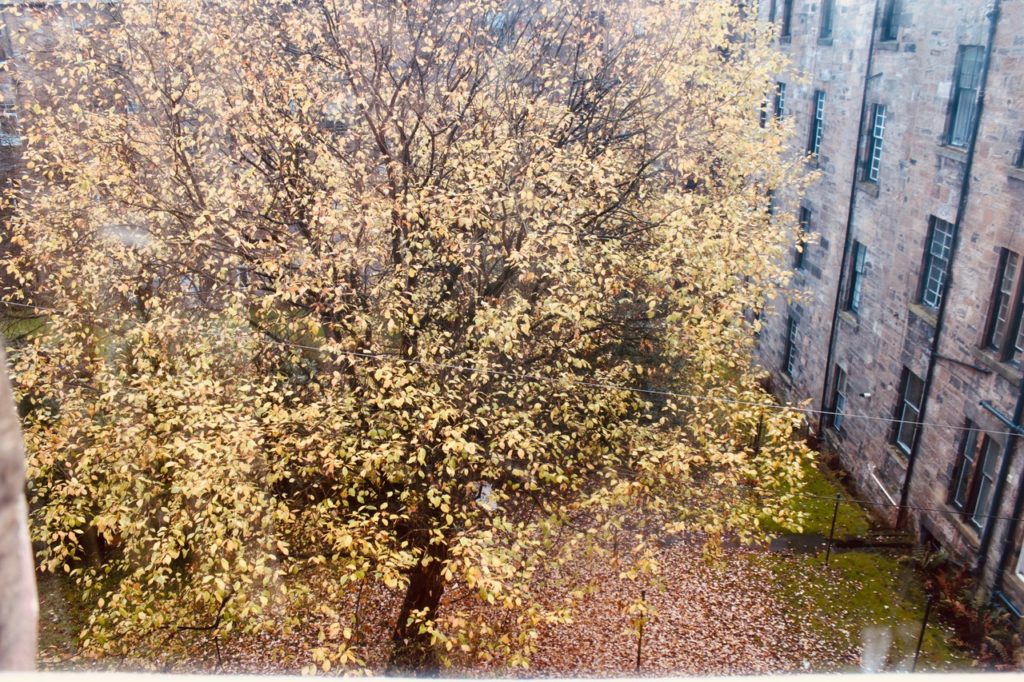
ERASE THE BORDERS a collective art work for Bienal Sur 2021 (Uruguay)
Letter from Glasgow: Live
The tree outside my back window holds its leaves when all others about have blown. The trees on our street are stripped bare in a night when a strong wind blows, an abrupt ending. But the tree at the back is protected from the wind on three sides by the enclosing back walls of tenements. Now it is the last space of yellow in a landscape of wet stone, slate and thin black branches.
L’arbre à l’extérieur de ma fenêtre arrière garde ses feuilles quand tous les autres autour ont soufflé. Les arbres de notre rue sont dénudés dans une nuit où souffle un vent fort, une fin abrupte. Mais l’arbre à l’arrière est protégé du vent sur trois côtés par les murs d’enceinte des immeubles. C’est maintenant le dernier espace jaune dans un paysage de pierre mouillée, d’ardoise et de fines branches noires.
(Letter from Glasgow, Musica Adventus, December 1-8 2020)
The Advent Music this week was Schoenberg, Korngold and Tchaikovsky loud and live from the City Halls — Tchaikovsky’s last symphony, not pathétique but raucous and careering wildly and so much sound — tuba and trombones and six double basses bowing heartbeats. I watched from the balcony and grinned beneath my mask. Last advent the concert halls remained dark and empty. The audience is kept masked and distanced but more and more players are allowed on to the stage, and even a singer to sing Korngold’s Songs of Farewell: Der regen fällt. Die müden bäume triefen. Weary trees drip with rain and leaves are fallen like light of days, into darkness — the pleasing German “dunkel”.
This letter has three languages in it. It feels safer to have more languages to say things in, to keep the words endlessly edging around the things, moving in and out, so that the feeling of a thing is not disappeared by its definition. I used to rely on travelling to free myself from the language I was born into, to forget it for a week or so completely, be planning and phrase making, dreaming even, inside another language. But the travelling has paused. Instead of talking with new words I swop texts and translations with Crown Letter friends who I have never met in person, we try out words between us, send them back and forth from our screens. Different words for things, to give them a better chance of being heard. I listen to lieder for the German words I know almost nothing of and read Prishvin’s diaries from Moscow in 1930, as he watches, and photographs, teams of workers destroying the vast church bells. He writes down his conversations with them, puts what he sees and hears and feels into handwritten words that he and his wife buried underground in rubber sacks in a forest during the war. After his death, Prishvin’s wife had zinc containers made to bury the diaries once more and keep them safe against searches or censorship.
At the end of the concert I walked out down the stairs in front of a group of music students, brass players, one said that a trumpet had missed a couple of notes in a bar, he sang them aloud, did you hear it? But they were excited, swopping phrases and reactions, exuberant. We left the building cheered and woken up, a crowd of music fans processing along the wet pavement towards stations and buses. I crossed the road and took in the sight, this rare festivity, communality even.
November 30th to December 7th

ERASE THE BORDERS a collective art work for Bienal Sur 2021 (Uruguay)
November 23rd to November 30th
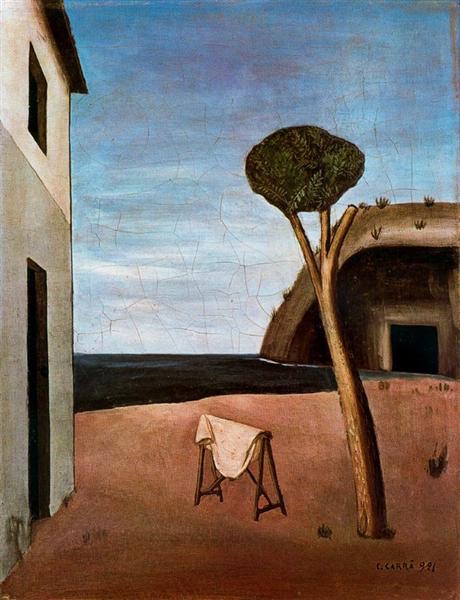
Letter from Glasgow: Metaphysical Painting
I am swimming in a bay, in the distance an island. The island is in the bay, on the edge of a Scottish town, but just now in this storm light, it transforms itself into something like a dream — an island of light. The lighthouse catches the gold afternoon sun and it could be Italy, a secret tower in a painted landscape. I push my head into the water, breaking the skin of it and dipping below the surface that reflects the purplish storm sky above. My hands before me are golden under the water, lit by the sudden sun. I swim with my nose at the level of the water, held between the air and the underwater, eyes fixed on the island before me that is transformed, transcendent — the real world before me holding within it the dream, the idyll of the painting. I don’t know where this envisaged idyll has come from but its hold is as convincing and actual as the shape that it inhabits before me. I fix my eye on the horizon and keep swimming.
(October 12-19th Letter from Glasgow: Drawing In )
And when I finished my swim, dried and got dressed, I picked up my bag from the shore and walked back to the road. I followed the road up the hill, in wide zig zags. As I climbed, I kept looking back at the island. It was no less startling, no less strange — as if seen from another world. I had to keep reminding myself that it was really there before me, suddenly envisaged at the end of this dark grey stony town, sunk in the shade at the edge of the sea firth. I saw it as Poussin, I saw it as Carrà, his Landscape with a Pine. And as Andrzej Jackowski’s drawing The Visit, where the sea presses up at the half open door of a room — he has taken the sea from Carrà’s painting and put it in his drawing, just beyond the room.
There are Italian pines planted along the stone embankment that curves from this Scottish harbour towards the island, in spite of the inclement conditions of the north easterly climate. Later, I learned that the place had been a quarantine island. In the fifteenth century, people suffering from syphilis were shipped to the island and left there to die. A hundred years later it received the crews of ships infected with the plague. Less a quarantine point than a final destination. A ship load of Russian sailors was buried there. There are no graveyards. It is now uninhabited.
The late sun kept striking the lighthouse and the half-ruined buildings of the island, lighting them up pink and gold. I reached the top of the hill and waited until the sun had passed, and shadows occluded the towers, before I could turn away from it and go down the hill on the other side, back into the city.
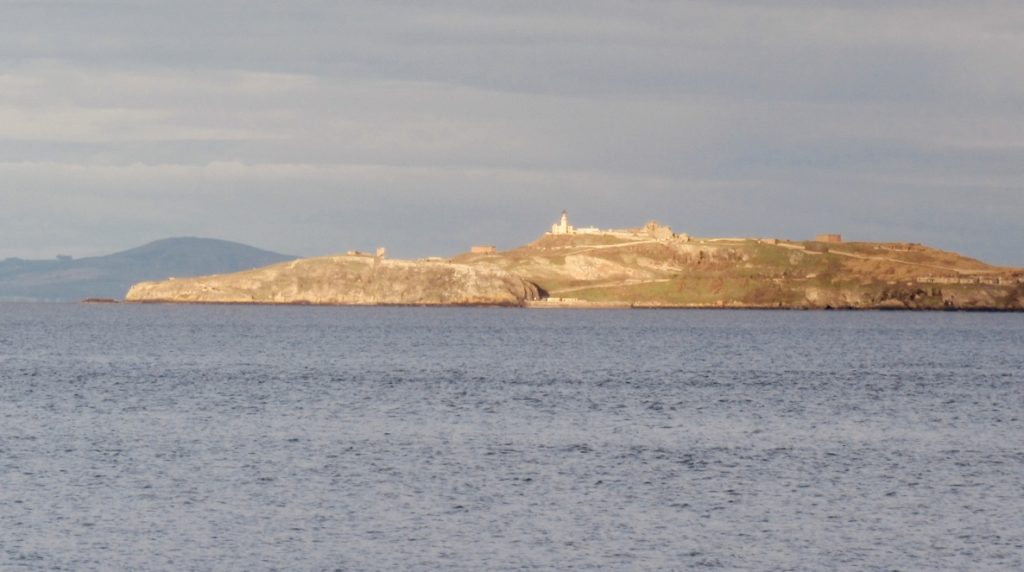
ERASE THE BORDERS a collective art work for Bienal Sur 2021 (Uruguay)
November 16th to November 23rd
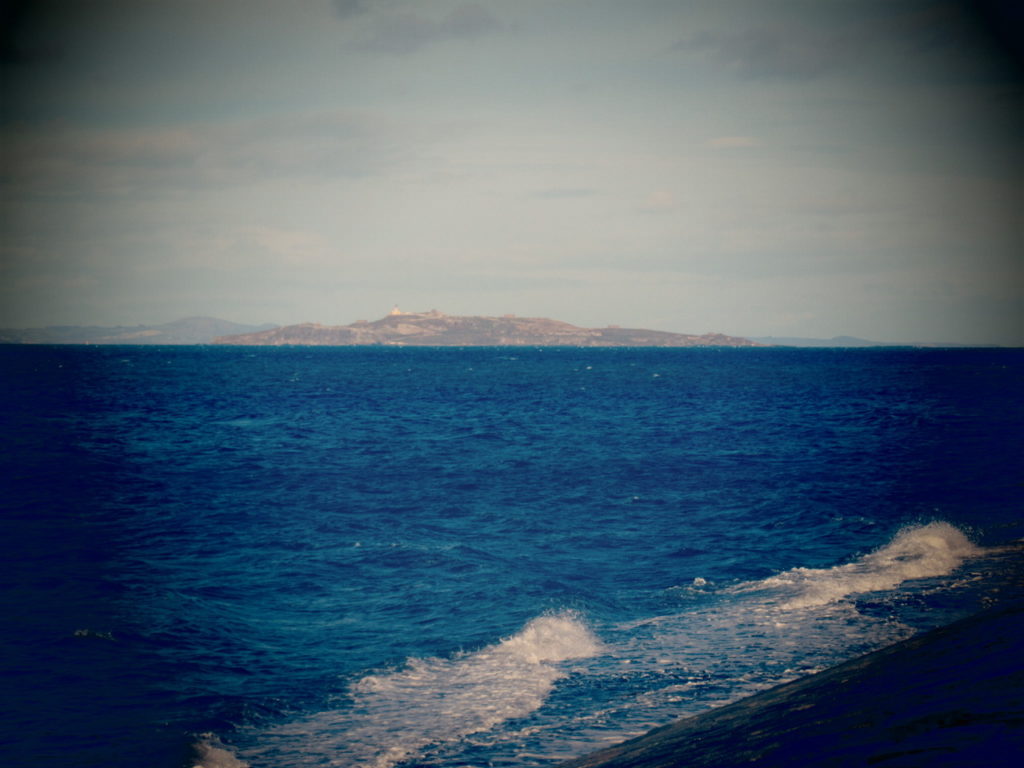
Looking to sea in Scotland, for Ivana, carrying our Crown Letters across the water from Argentina to Uruguay
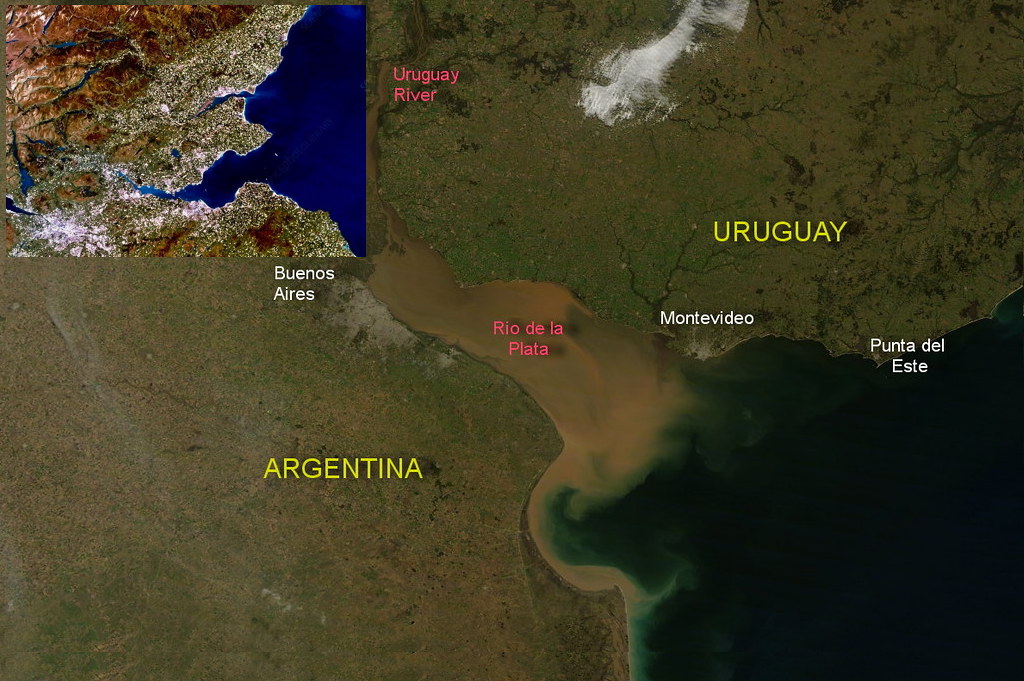
ERASE THE BORDERS a collective art work for Bienal Sur 2021 (Uruguay)
November 9th to November 16th

Inscriptions on panels: Indian Mutiny. Umbeyla. Abyssinia. Lushai. Afghanistan. Burmah. South Africa. « I seem to see the gleam in the near distance of the weapons and accoutrements of this army of the future, this Citizen Army, the warder of these islands, and the pledge of the peace and of the continued greatness of this Empire » Extract from Lord Robert’s Speech in Glasgow on 6th May 1913
Field Marshal Earl Roberts of Kandahar, Pretoria and Waterford, V.C. born in India, 30th September 1832. Died in France while on a visit to the troops engaged in the Great War, 14th November 1914.
ERASE THE BORDERS a collective art work for Bienal Sur 2021 (Argentina)
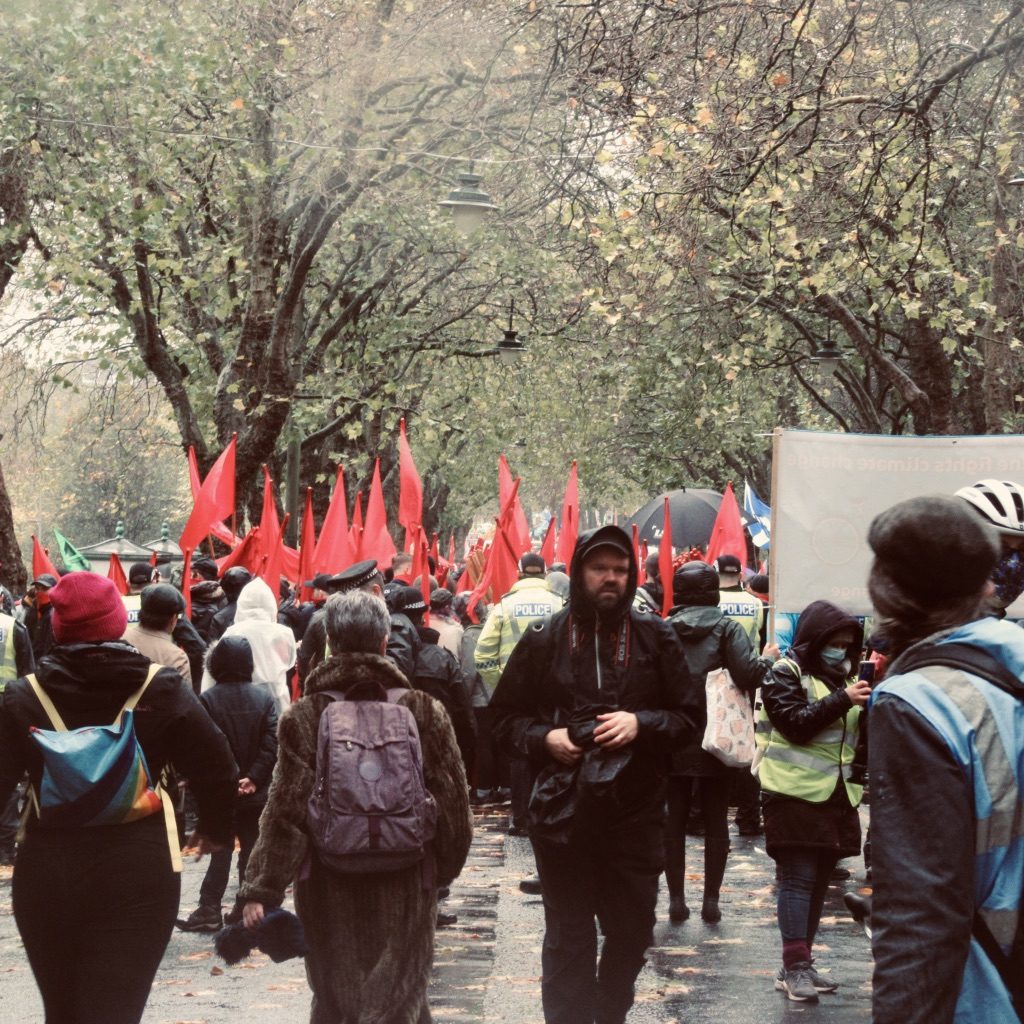
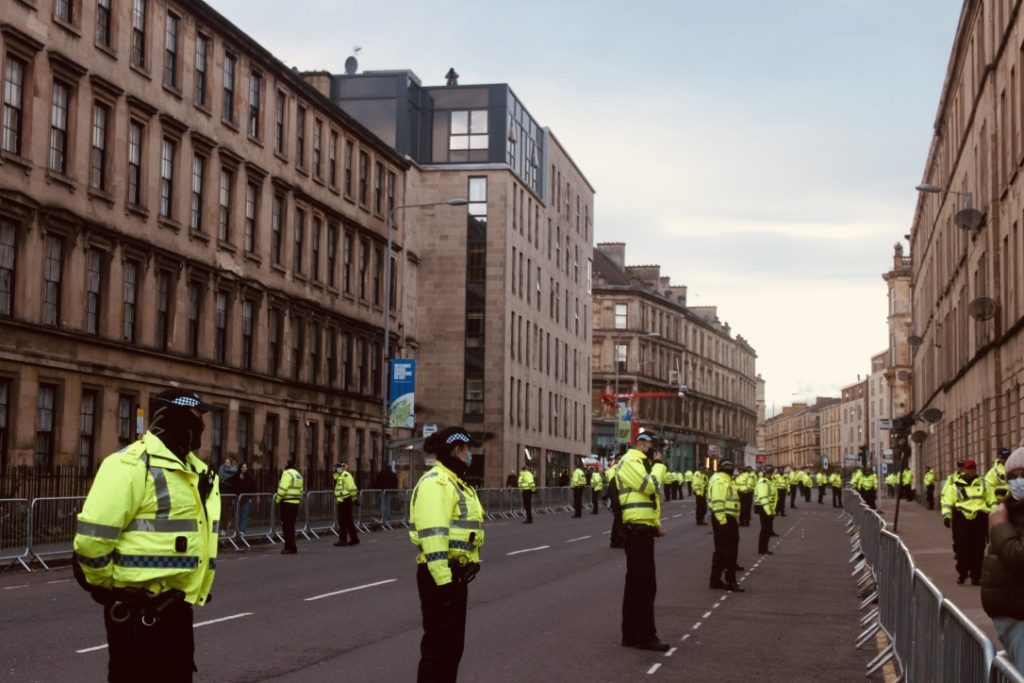
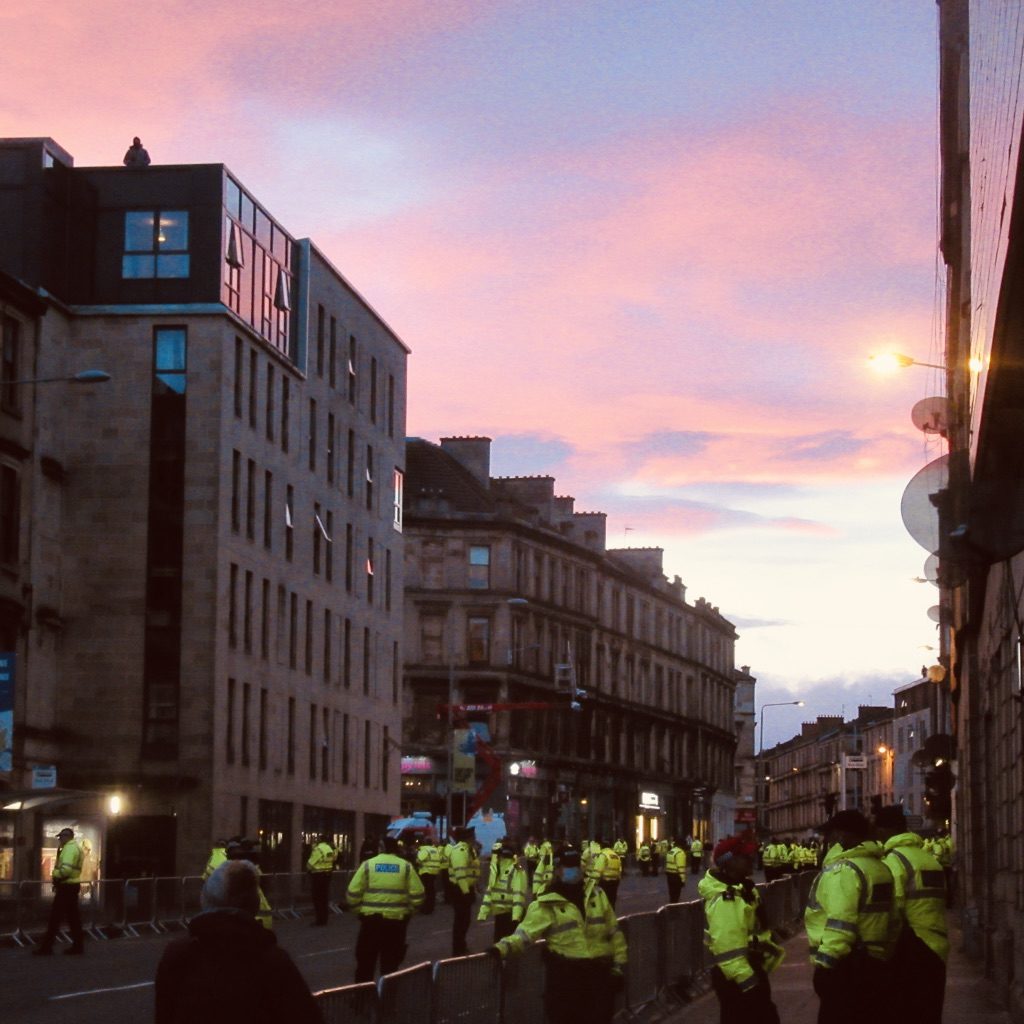
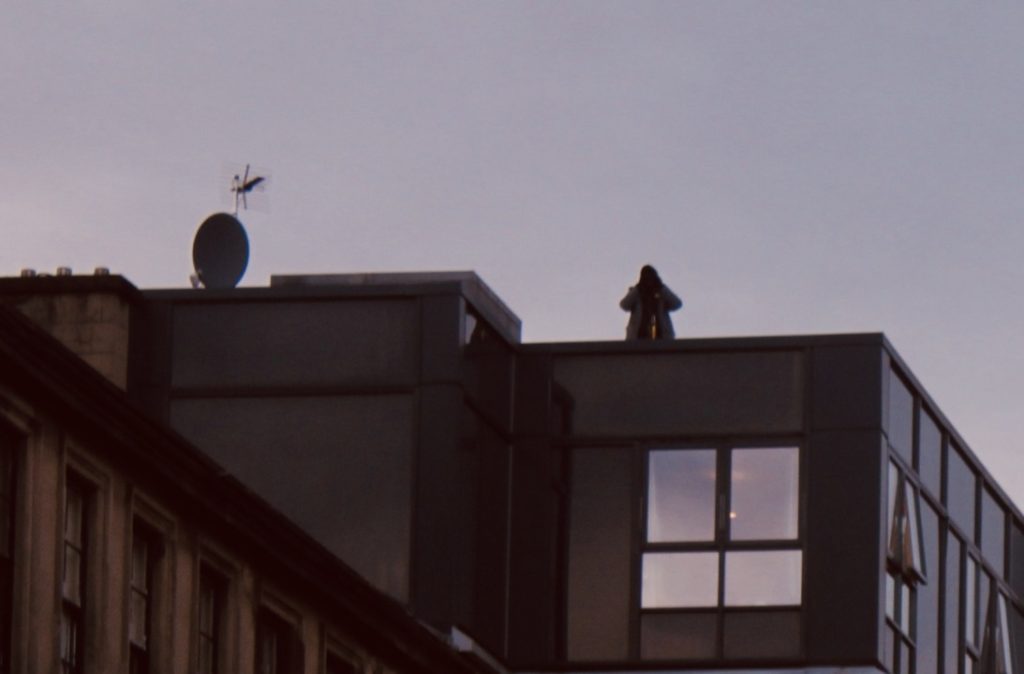
November 2nd to November 9th
ERASE THE BORDERS a collective art work for Bienal Sur 2021 (Argentina)
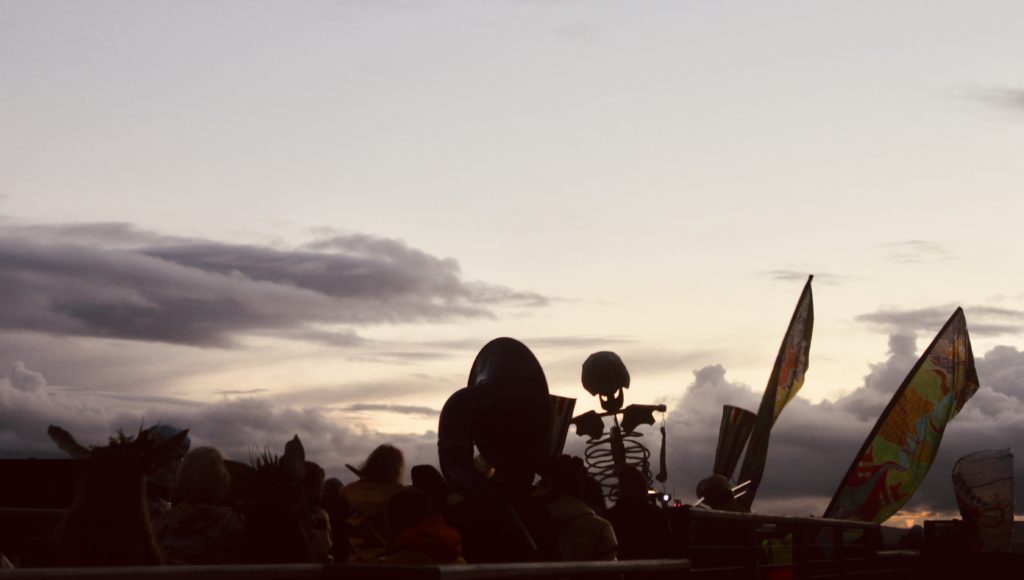
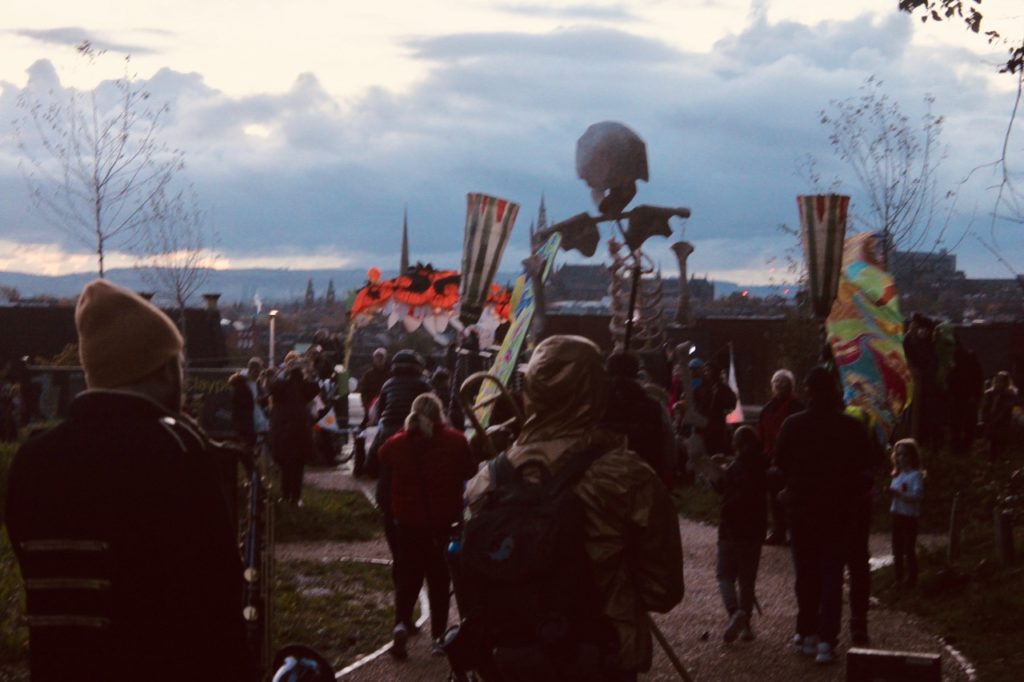
Letter from Glasgow: Weather Reports
Everyone tells me it is raining in Glasgow. We are suddenly centre stage — reports from our city are bounced back to us on the internet or from the mouths of friends in other countries. It is quiet on the streets, but a mile away is the zone of white conference tents along the river. There is the regular burr of helicopters and a high barrier has been erected at the end of the park, where you would head down to the river. I walked there in the rain, warm yellow of birch and plane leaves, acid yellow of high vis jackets of the police guarding the barrier. Friends exchange rumours and facts. Snipers are stationed on the top floor of the old Children’s Hospital that looks over the river, training their guns on the ground below, taking aim all day long. The building and its last active clinics has been closed for the week, as has my children’s school for the opening days. Somebody says that the American president is flying in by helicopter from Ireland each day. Someone else went to greet the activist train, but they didn’t see Greta Thunberg. Someone is certain it was Patti Smith shuffling into the local Co-op on Friday night, wearing sunglasses and slippers. The Co-op has put a new sign up, Co-op 26. We speculate and wait.
Sunday night was Hallowe’en. I walked up to the canal with some local children for a parade. We waited as people assembled slowly in groups, among us a vast dragonfly, a school of paper fishes, a large polar bear on wheels, lit up from within. As it became dusk the sound of trumpets and a procession emerged from the top of the hill opposite, a small child in the lead, then a towering skeleton, followed by the musicians, and a long line of people behind. They descended at a diagonal, crossed the bridge and merged with the people waiting on the other side. Then the whole long line set forth in the dusk, their shadows in the water more beautiful than the line itself. The International Human Rights Observers were there, in pink vests and armbands, they are in the city to make reports on public gatherings. It is very nice, I heard a woman with a Spanish accent report into her phone. They followed at a distance.

Yesterday, All Soul’s Day, was the opening of the conference. At 3pm we left the house to walk my daughter to a music lesson on the other side of the park. One side of the park was open and we were hopeful of finding a way through until we reached the long road that runs between the park and the river. It was guarded by several hundred police from every part of Scotland and England. They were trying to explain the long unwieldy detours to people who wanted to cross the road, except they didn’t know the shape of the city so had to be helped by other people who had wanted to cross the road, but like us, been brought to a standstill. We gave up on the music lesson and decided to watch the spectacle, and await the motorcade who should be passing through in an hour or so.
Or three, it turned out. After an hour people who were trying to get to their houses on the wrong part of the street were informed that their homes were now in the “sterile zone” and they would not be allowed in for several hours more. The yellow vested police made a long ribbon on both sides of the road as far as you could see. Looking up, I saw the silhouette of a man on the roof, like an over scale sculpture. He stood so still I thought it was a decoy, like the cardboard police cut outs they put in pound shops to deter shoplifters, then the silhouette raised what looked like binoculars, slow and deliberate, and we realised it must be a sniper. We saw two more on the other side of the street further up. We waved to people we knew on the opposite bank. We waited. Suddenly the sound of a band, drums and brass, descending from the park. The police leapt into formation like a dance troupe. The police vans were driven into a wall to block the street and officers sprang into an obedient crocodile, double file, and marched off to block another exit. Students sat in their windows, legs dangling out, singing and cheering the band and the protestors. The sun was setting in streaks of dirty pink behind the darkening, almost immobile, figure of the sniper, who presided like the ultimate viewpoint, the watcher, a shape of awe and fear, over the proceedings. I could not stop looking up at him.
After dark, the first buses came past. New electric red London buses, crowded with delegates. Lit up inside, they looked like a piece of the London rush hour. We waited more, it wasn’t over yet. The protest had moved on. I was about to try and look for a route home when more lights than usual flashed at the far end of the street. There it was — the motorcycles, then the long line of armoured cars supposedly flown in with the US delegation, shiny black, one squat with a chimney like an old stove, one rammed with men in special headgear bent over what must be weapons and suddenly the traditional long low limo, small American flags fluttering at the front, the flash of a face and white hair, the first face to look out our way, the American president. Then quiet again. The street was relieved, the police and the waiting people. We headed home through the park in darkness, to the sound of speeches from an impromptu rally taking place in the children’s playground. Day One.
October 26th to November 2nd

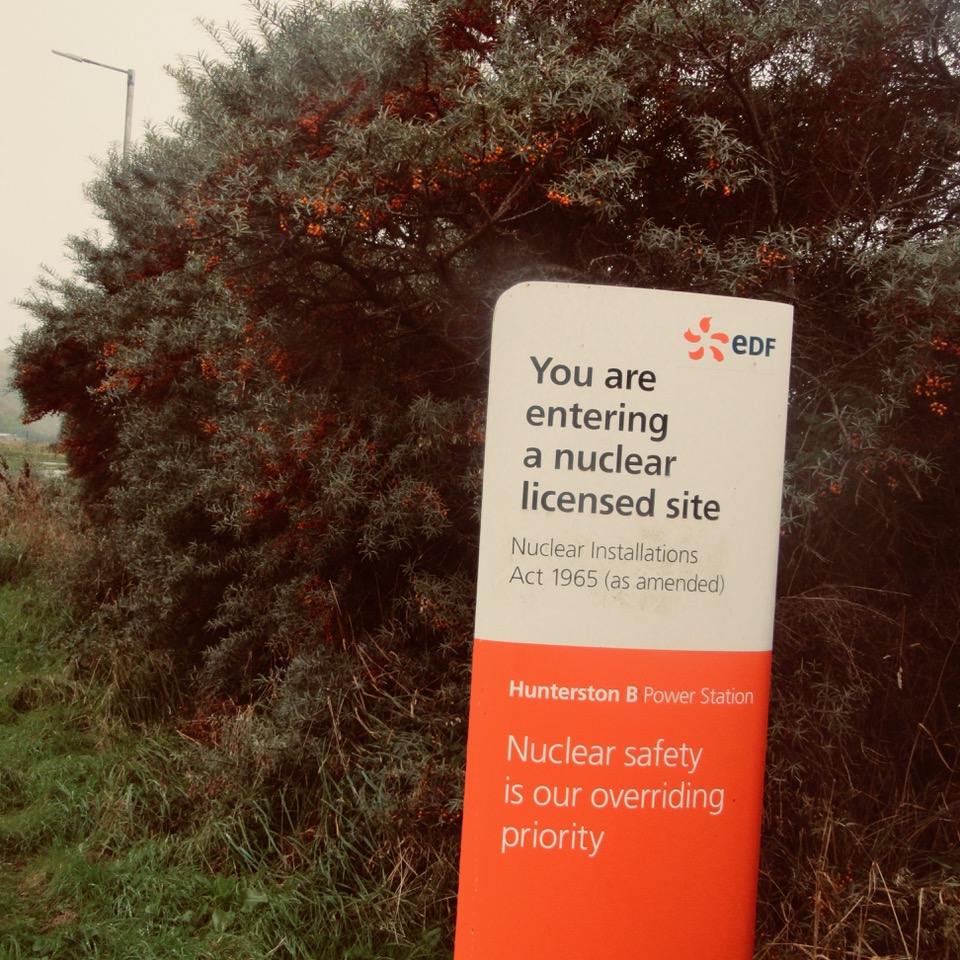
ERASE THE BORDERS a collective art work for Bienal Sur 2021 (Argentina)
Letter from Glasgow: Oblepikha
It was the end of the first week of October. We were meant to have gone the week before but a monsoon rain deferred it. I was meeting some friends, a Russian speaking professor of Mathematics and his German wife, to gather oblepikha along the Ayrshire coast. They had found a source, almost on the grounds of a nuclear power station, looking over to the islands of Arran and little Cumbrae. Although the day was dark, a dreich and drizzling rain, we set out. We took plenty of bags in the hope of an abundant harvest.
Oblepikha in Russian, also known as Sea Buckthorn, or Sanddorn in German, is overlooked by Scottish foragers. The enthusiasts tend to be from more northerly countries, where the berries are prized for providing essential vitamins through the dark winters. I had first come across it thirty two years ago, on a weekend at a dacha outside Moscow, where we had been invited by friends we barely knew, just a week after arriving in the city for our year’s study. Our host had led me to a cupboard on the first evening and pointed out a jar of deep orange, a suspension of berries. She held it up to the electric light for me to admire as she spoke of the wonder properties of this fruit that could ward off the most malign threats and diseases. She offered me a spoonful. It tasted unlike anything else, and was delicious, with shifting layers of taste. Over the weekend, mindful of its magic powers, but above all of its taste, we helped ourselves to as much as we politely could of the glowing jam, spooning it over the grainy white cheese, the sour cream and black bread, and stirring it into our black tea, or rather, sipping the tea through a large spoon of the jam in the traditional way. Our breakfasts were prolonged, and the tea was drunk hot, lukewarm and stewed — the buckthorn ameliorated the bitterness of the ever strengthening dregs, as the hot water ran out and we were draining the tepid condensed tea essence, or zavarka.
Our new friend the maths professor would not permit me any nostalgia for Russia. He was born in Odessa, into a family of Jewish musicians and mathematicians whose careers had been blocked or put on hold by the official and unofficial anti-semitic prejudice of the Soviet Union. His grandparents left for Israel and his parents emigrated to Germany with him when he was ten. Yet he pronounced the word oblepikha with the same relish as I did, and like me enjoyed listing the radiant disease defying properties that we had both been instructed in, the authority of this ancient lore. He had eked out last year’s supply, rationing himself to a few berries each morning for breakfast, now it was time to gather again. We strode along the narrow coastal path with our expectant shopping bags, eyes fixed ahead to scour the bushes for any sprinkling of the orange fruit.
There seemed to be only two colours that day, the silvery grey-green of sea mist and sky, of the metal surface of the nuclear station and of the leaves of the buckthorn bushes, variously inflected and shifting in the light. Orange red was the colour of the berries, and the colour chosen by EDF for warning and direction signs throughout the power station. Orange red was also the colour of the trousers I put on that day, perhaps to invoke the berries, of one of my supermarket foraging bags, of my daughter’s hat and coat and the strap of my satchel. These things glowed against the grey green. Occasional bursts of sun and shower would descend in the distance, striping the islands at sea before us as we set out on a small path over flat coastal fields.
It was slow going. The first bush that we came to had only scant fruit, and we wondered if we were too late, or if the harvest had not been so good this year. But as we entered the zone of the power station we saw them, rich and thickly clustered. The professor said that we should continue, the true bounty still lay before us. We walked along the roadside, now clean and newly tarmacked. There was no sign of any person on the road or on either side of the high metal fences around the nuclear enclosure. A little further there was a fence, beyond it bushes heaving with berries, low to the ground and in easy reach. A sign said Do Not Cross the Fence and interfere with local flora. We were tempted, but the professor said that we would not need to. There would be more just around the corner. We followed a tarmac spit of road that curved about the sea like a small harbour. At the end was a locked gate, but all the way along, on both sides, were high bushes heavy laden with fruit, this, the professor said, was our Eden.
I plunged in my hands, and a thorn spiked hard into my index finger. They had forgotten to tell me you need gauntlets and secateurs for these tough and multi thorned branches. But I kept going, almost enjoying the pain and scratches, bending and wrenching the branches off with my bare hands as we marvelled at the abundance. The professor was as assiduous as I was, full of zeal for his task. Neither of us could stop until we had filled every one of our many bags. The professor’s wife was on the other side of the road taking cuttings, trying to get a couple of plants with the roots intact. I looked down at where she was digging and noticed that the tarmac next to her was bulging and cracking as small buckthorn saplings forced their way up through the road, splintering the surface. I wondered at the power of these roots, for what emerged looked deceptively delicate, tiny leafed branches, that had managed to split open the new tarmacked surface with ease. I was disconcerted by the sight, which recalled the fictional Triffids, that science fiction hyperbolic plant rampage. I looked back at the power station, and thought of the sign on the road warning people not to interfere with the plants on the other side of the fence. But these thoughts were dispelled by the sheaves of berries, clustered like ripe corn, waiting on the bushes.
The light was becoming dim — we reached the locked gate at the end of the spit and turned back. As we joined the main road through the power station we found a bush so thick with fruit that we stopped for a last plunder. We were more relaxed now, pleased with our work, although my finger was swelling up and sore. The professor talked happily of topology as we made our way along the shoreline, of Moëbius bands and the Klein bottle, those enigmatic, endlessly looping surfaces that seem to deflect a defining of inside or out, of solid boundaries keeping things apart on one side or another. I tried to picture them as I looked at the storm light shaping the islands. We reached the car at dusk, hauled the branches into the boot and drove back to Glasgow in the dark.
We told the professor’s wife our Russian legends of oblepikha handed down by grandmothers and mothers. The professor even allowed me a moment’s nostalgia for the Soviet produced three and five litre glass jars that were such a ubiquitous detail of my Moscow year — thick blue-green glass vessels packed with pickled cabbage, or marrows, or mushrooms become slimy and viscous, too large or many for the fridge, they sat out in rows on frosted balconies, in easy reach of the kitchen table.
At home I began the difficult process of removing the berries from their thorny branches to stew for jam. I had almost lost the use of my finger which swelled up large and red from the spearing. I tried in vain to extract the splinters. I began to see the bushes everywhere — this rare bounty we had driven so far to gather turned out to be rife, pushing in from behind the crash barriers of the motorways that run into and loop through this city. I saw them from train windows, in car parks, on traffic islands and even masquerading as a trimmed boxed hedge around a housing estate. I read that their root system was “invasive” and decided against planting any in our shared garden. After prolonged soaking in hot brine the swelling in my finger began to recede, but twelve days on there is still some numbness, the last pieces of thorn are still rising to the surface, tiny brown specks in the skin. We will return again next year.
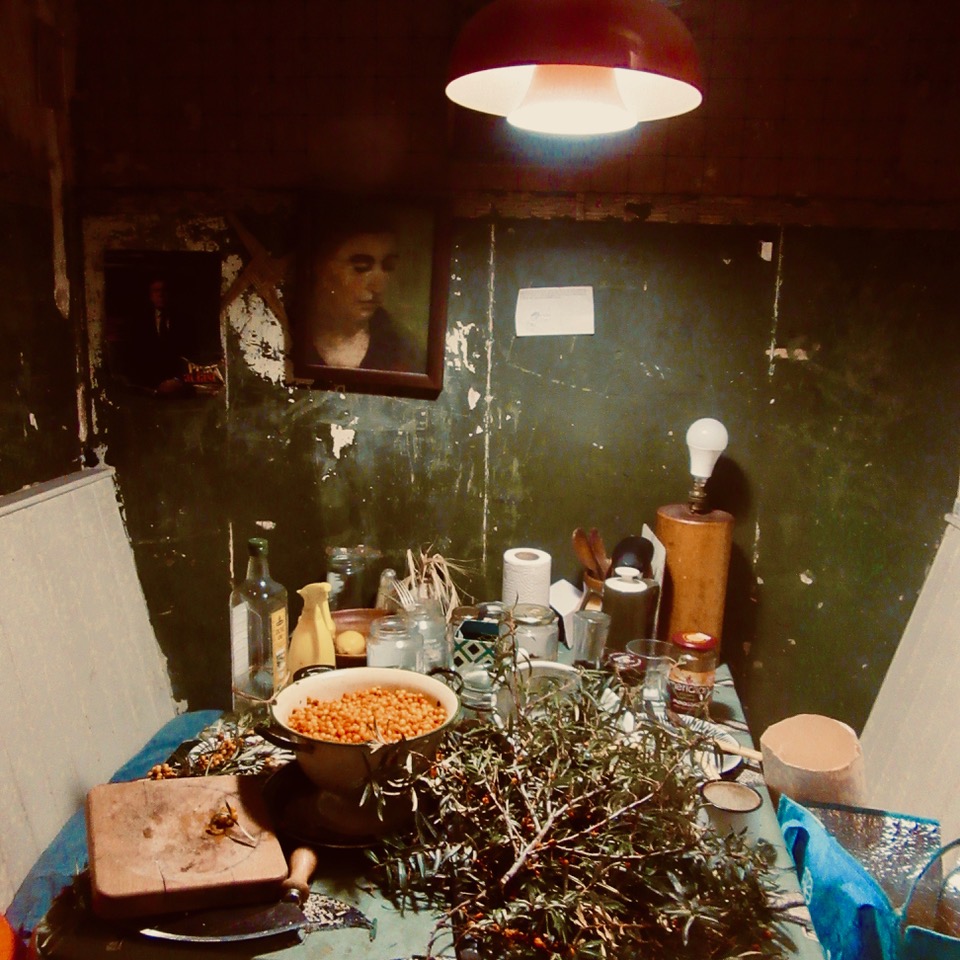
October 19th to October 26th

ERASE THE BORDERS a collective art work for Bienal Sur 2021 (Argentina)
October 12th to October 19th
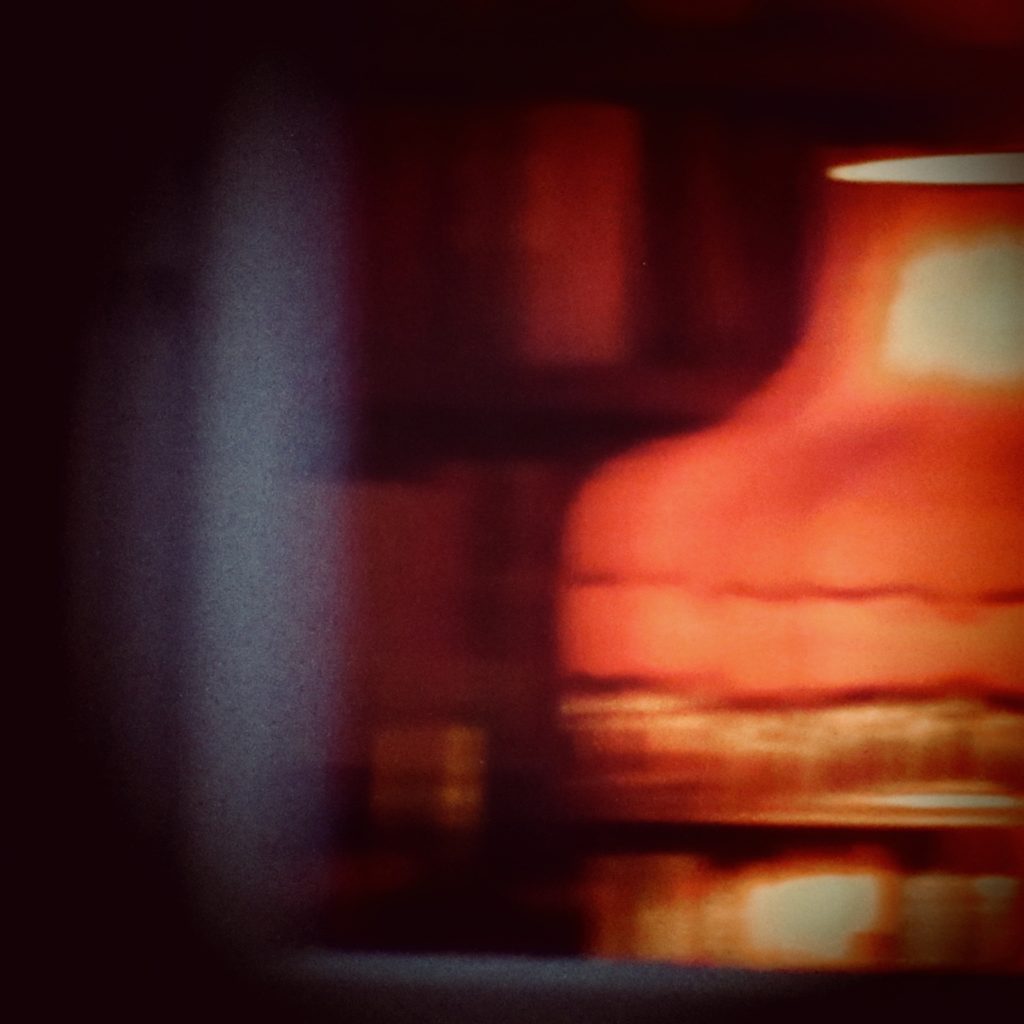
Letter from Glasgow: Drawing In
The darkening mornings gather pace, six am is no longer a space full of light, but seems to be still night, a few days ago it was dawn, a fraying edge of morning. It is like missing a step in the dark, suddenly you stumble and sink deeper than you were feeling for, setting off a momentum that is like a tumbling, you must keep descending into darkness in these overstretched bounds, without pausing. The next day the darkness holds until almost seven.
I come home at dusk now. These shortening days are not unwelcome. I remember that the inside glows brighter as the outside grows darker, and that this can be a time for remembering, for looking towards the pictures that we hold inside us, lit up, like shop windows on rainy streets, coming home.
The line between sleeping and waking is also a sort of border, and the line between dreams and days. My dreams snap shut on me on waking, I try to put a finger in, as though prising into a mollusc, to prod the flesh of it, but the very act of trying to touch seems to provoke the snapping shut. I want to draw out dreams into days, but am left only with traces.
Erasing the borders. It is the right impulse, particularly when fortifications have been cemented from fear. If we cannot bring them physically tumbling down we can at least try to speak across them, in the translations that we have been making for each other, sending back and forth, in the words with which we try, and keep on trying, to speak to each other a little more precisely — sounding out the barely palpable images in the hope that another person might hear and see them inside, with recognition. The postcards that we have sent these past weeks from our various countries, to women we have seen often on the screen but never met, in Argentina, are also an attempt to transmit words, pictures and touch through cards and envelopes that don’t require visas but that journey physically in actual space, from one hand to another. For now, envelopes don’t need visas.
I would like to erase the border between my dreams and my days, to carry the one right into the other, but something prevents this, something I seem unable to resist. But I can learn to listen in, to see in, to pay attention, vigilant and listening at the border while pretending to look the other way, and and occasionally I am rewarded with the pictures that I hold inside. And, even more rarely, I can sometimes share them. Not erasing borders but at least eroding or blurring them. These borders that must be negotiated anew each day should not be unscalable walls but semi-permeable membranes that allow for a to and fro, a translation of words and images, a sharing of the things that we most need.
Somehow we have to learn this knack of living between, treading water, of things being neither one thing or another, but a constant shifting.
I am swimming in a bay, in the distance an island. The island is in the bay, on the edge of a Scottish town, but just now in this storm light, it transforms itself into something like a dream — an island of light. The lighthouse catches the gold afternoon sun and it could be Italy, a secret tower in a painted landscape. I push my head into the water, breaking the skin of it and dipping below the surface that reflects the purplish storm sky above. My hands before me are golden under the water, lit by the sudden sun. I swim with my nose at the level of the water, perfectly held between the air and the underwater, my eyes fixed on the island before me that is transformed, transcendent — the real world before me holding within it the dream, the idyll of the painting. I don’t know where this envisaged idyll has come from but its hold is as convincing and actual as the shape that it inhabits before me. I fix my eye on the horizon and keep swimming.
ERASE THE BORDERS a collective art work for Bienal Sur 2021 (Argentina)
October 5th to October 12th
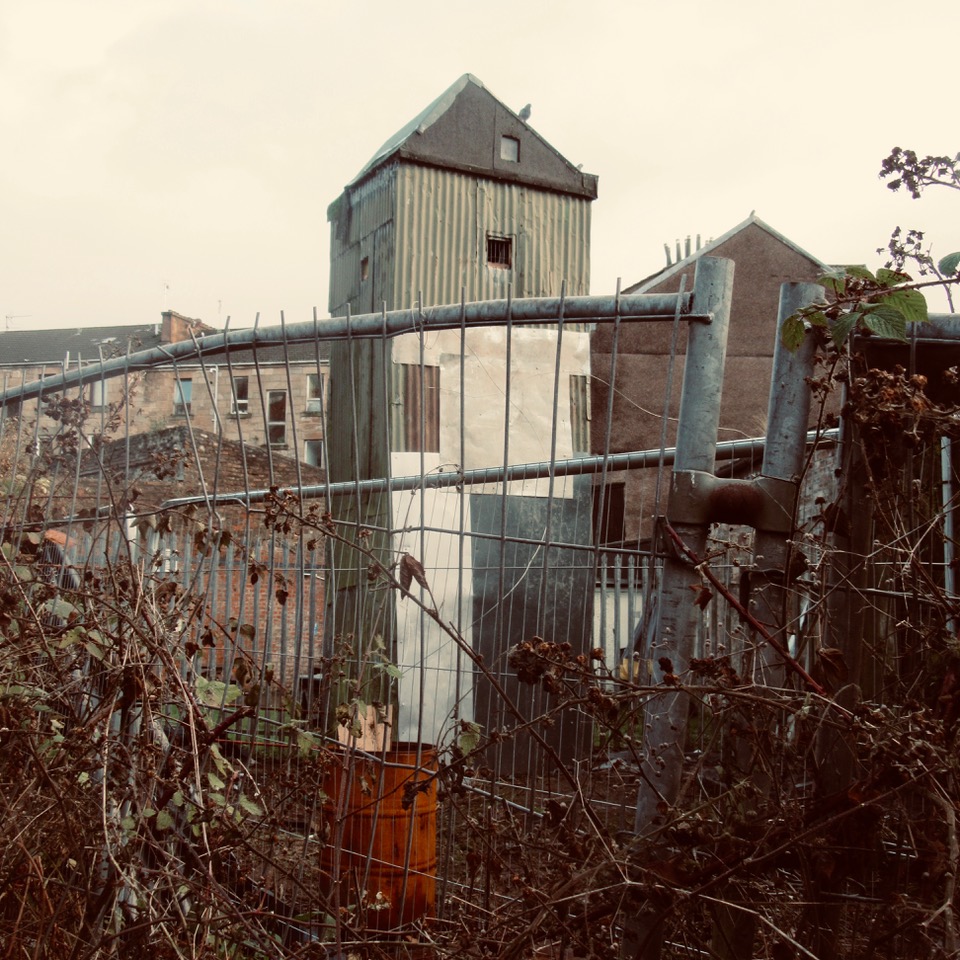
September 28th to October 5th

Letter from London: In the Circus
It is the start of term. I am drawing with the new students in real life. We meet in the middle of Arnold Circus, at the bandstand, an octagonal structure set high on a mound and circled by seven plane trees. The ground about the bandstand is slightly raised and curved, like a cake, and the wide floor is covered with dry brown leaves that have been left to pile and rustle. You must go up two flights of stairs to get to the top, and when you get there, it is autumn.
I wait for the students on one of the broad wooden benches that encircle the space. I choose one where the light falls, a perfect late September light of brownish yellow. At midday I move, following the sun. The sun slices into the space from one of the streets: six straight lines that enter, or lead away from the circle like rays on a drawing of a sun, on this day of almost equinox.
The sun moves around the circle like a clock hand, but without fret or urgency; its light is neither glaring or intrusive, and the circled space is still, suspended in this gentle afterglow. A few people walk across the circus and every few hours there is a burst of noise and cheer from children playing in the school ground across the road. I sit on the bench and attempt to draw the bandstand, but I cannot get the proportions right, always it is coming out too constrained, it cannot contain all the arched spaces, and I persist in trying to measure the gaps between the pillars, ignoring the advice I have just given the students. I make drawing after drawing, sometimes by eye, but mostly trying to measure it, and it continues to elude me.
In the café window on the street below there is a poster of the same bandstand, drawn by Leon Kossoff. I don’t think he measured. He came to draw here in his eighties, making drawings day after day, for several years, sitting on a bench among the plane trees, with coloured pencils. It was a return: as a child he was a pupil at the primary school on the opposite side of the circus, not the one whose playground still sounds, but the one which has been converted into design and fashion workspaces and a high class canteen. Before it was developed, I shared a studio with some other artists in the broken remnants of the old schoolrooms, where the tiled walls and children’s murals were still intact. Leon Kossoff came in one day and looked at our work. Prints of one of these bandstand drawings are being sold in the café on the street below, where his father’s bakery once stood, to fund a campaign to save the circus from being dug up and “re-landscaped” by the local council. The project was delayed last autumn when residents came out and stood in front of the diggers, and for now it is on hold.
We meet at the end of the day and lay our drawings out beneath the bandstand. We talk of place and specificity. I mention the yellow autumn light of Kossoff’s Willesden swimming pools, the South London brick and haunted streets in Carel Weight, Alice Neel’s Harlem, the Copenhagen doorways of Tal R and even the strange visionary realism of Sienese painting. A specific engagement with place that allows for an envisaging of the past or the imaginary. We talk of why one thing is itself and not another. I am not sure why it feels so crucial for the surface thing to be so attended to, for it is not realistic reportage that I am after. Yet it seems that only a complete surrender to the experience of these specific surfaces permits the displacement into other cities and other spaces that we crave.
The day is over and the students are talking away, their voices amplified by the bandstand roof. It’s like a party. Slowly they disperse and I sit back on a bench and watch a small child’s face appear and vanish repeatedly along the line of tall windows in the Victorian school as they pull the blinds shut. I try one more time to draw the bandstand, to take it unawares. A last long segment of orange light fans out towards me across the leafy floor, and then that too is eclipsed.
My friend calls up to me from the pavement. We walk out west together through the evening city. We cross the Golden Lane estate where she used to live, and where I stayed with her whenever I came to teach in London. Now there is a huge new building, almost finished, opposite her old flat. It’s not as bad as we thought, we say, but it is still a bit bad. My friend takes photographs. I notice that in spite of the new building, the light still falls onto what used to be my bedroom window, in my friend’s old study, and am grateful, even though I no longer stay there.
In Farringdon I meet my father. It is now dusk. I say goodbye to my friend and walk down the slope into the restaurant built in an old abattoir where my father and I are having dinner. He arrives a few minutes later, in a suit the colour of lichen. As always I am alert to the pitch of his mood which is often unpredictable. So far though, so reasonable. It’s a funny thing, nostalgia.. he says. He says he never thinks of his childhood home but that he often returns to the house where we grew up, my siblings and I. He walks around it in his mind. I do too! I say, I wonder if we cross each other on the stairs? Here we are then, back. We are on familiar ground now — we have had this conversation many times before, but we return to it almost every time we meet, sharing the remembering of this space.
Tonight we rebuild the strange slope-roofed triangular room that was full of suitcases, half way up the stairs. It had one small square pink pane of glass in the wall, I say. I used to go and sit there, with the suitcases. The house was sold almost thirty years ago, when my parents stopped living together, but we can put it together to the last detail, every surface and texture. I can remember the rhythm of creaks from the stairs as I jumped them two by two. At the top of the stairs there was a small ladder with a wooden door that led up on to the roof, do you remember ? Between your study and my bedroom? This long gone family home was the last place where we could be together casually, at ease in the shared space. A ghost house, summoned from the whitewashed walls and thick white tablecloths of London restaurants which must now suffice as places to meet. We describe the spaces of the rooms that we each revisit in our dreams: this corner, that chair. Nostalgia — a longing for a home that no longer exists, or has never existed, for a semblance of home, to which you can never return.
I do not live in this city any more but I like to come back, to chance the company of ghosts, of revenants. The yellow autumn light and the dry plane trees, this wide territory from Euston Station to Arnold Circus brings back the repetitive lines I first heard read aloud by the poet Jacques Roubaud, in a bookshop by the Thames. Roubaud, circling his own particular ghost in this foreign city, in Russell Square and Cartwright Gardens, looking for traces of what had been lost, through the stilling suspension of another language and another light:
London, limbo <…> neither certainty, nor comfort, nor despair
the light so feeble, so theatrical, so yellow as it fades *
So feeble, so theatrical, so yellow as it fades.
*lines from Cartwright Gardens: A Meditation by Jacques Roubaud, translated from French by Rosmarie Waldrop.
Listen to me read the whole poem here
September 21st to September 28th

September 14th to September 21st
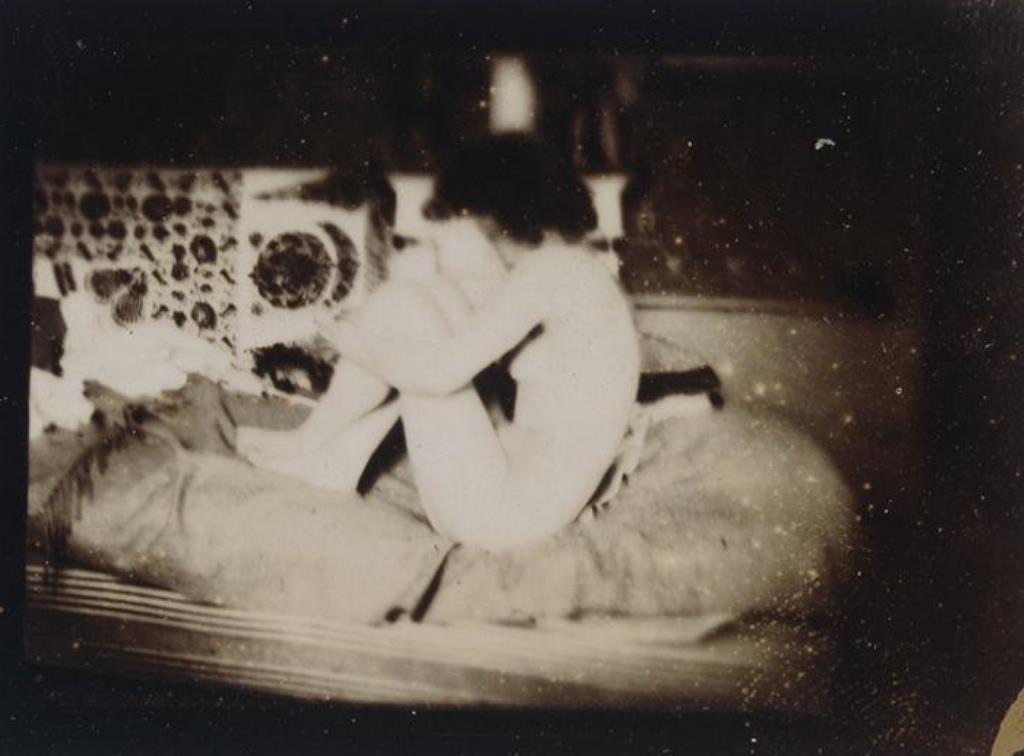
Letter from Glasgow: Looking Out, Looking In
I’m barely noticing the windows opposite these days. I feel a bit guilty about this neglect. It’s not that I am any less in the house, in my room.
People have started to visit the house. I have watched them, in my rooms, in my chairs, precisely lit by familiar angles of light and shadow specific to these interiors at certain times of day, the faces I had seen only on the street, blurred and over exposed for most of the past two years. Inside, we reclaim the space and shifting light of intimacy. Friends have travelled from other cities and peopled my rooms with stories of places long unimagined. I begin to plan journeys. At night, for the first time in ages, I roam new territories — cities and islands in my dreams. I dream once more of missing trains. Moving no longer seems unthinkable. I’m looking in, watching myself travelling through the pictured possible places, and the hold of the rooms opposite is waning.
The weather is all wrong. It is so hot and the sun glares. It is not the milky September sun edged with apples and leaf mould that Scotland is so good at. It is a stubborn heavy burn. The days shorten but the sun defies this turn in the season.
I wake early to a humid dawn. Like Africa, not Glasgow. I’m wide awake so I go to my chair in the window, at the front of the house. I look out at the flats opposite, whose windows sealed me in for so many months, whose rooms set the pace and provided daily diversion. The curtains are drawn on the right, and half-drawn in the painter’s room. But in the basement below her the light is on, something is stirring. I look down on a mess of bedclothes — a mattress fills the space and the floor about is strewn with clothes and boxes, jars and empty wine bottles. A body is sprawled across the ruckled sheet, turning back and forth — bare legs, an arm holding a heavy book. The book must be three inches thick, the pale green cover of Penguin Classics, I’m guessing what it is. The body and the book stir and flail and try to find a balancing point. The view reminds me of a body lying over a bed in an early Bonnard painting. A slightly dismal setting, painted in yellowed ochre and blue. A lonely turn of the century room with a woman inside it — painted by Bonnard, or told by Jean Rhys.
The arm drops the book. The figure sits up. The book on the bed like a brick. I had never noticed this room for the whole long lockdown and suddenly it claims my attention with its mess and sprawl, its restless reader. Something is stirring in the basement. Looking inside, looking out again. The same, but different.
September 7th to September 14th
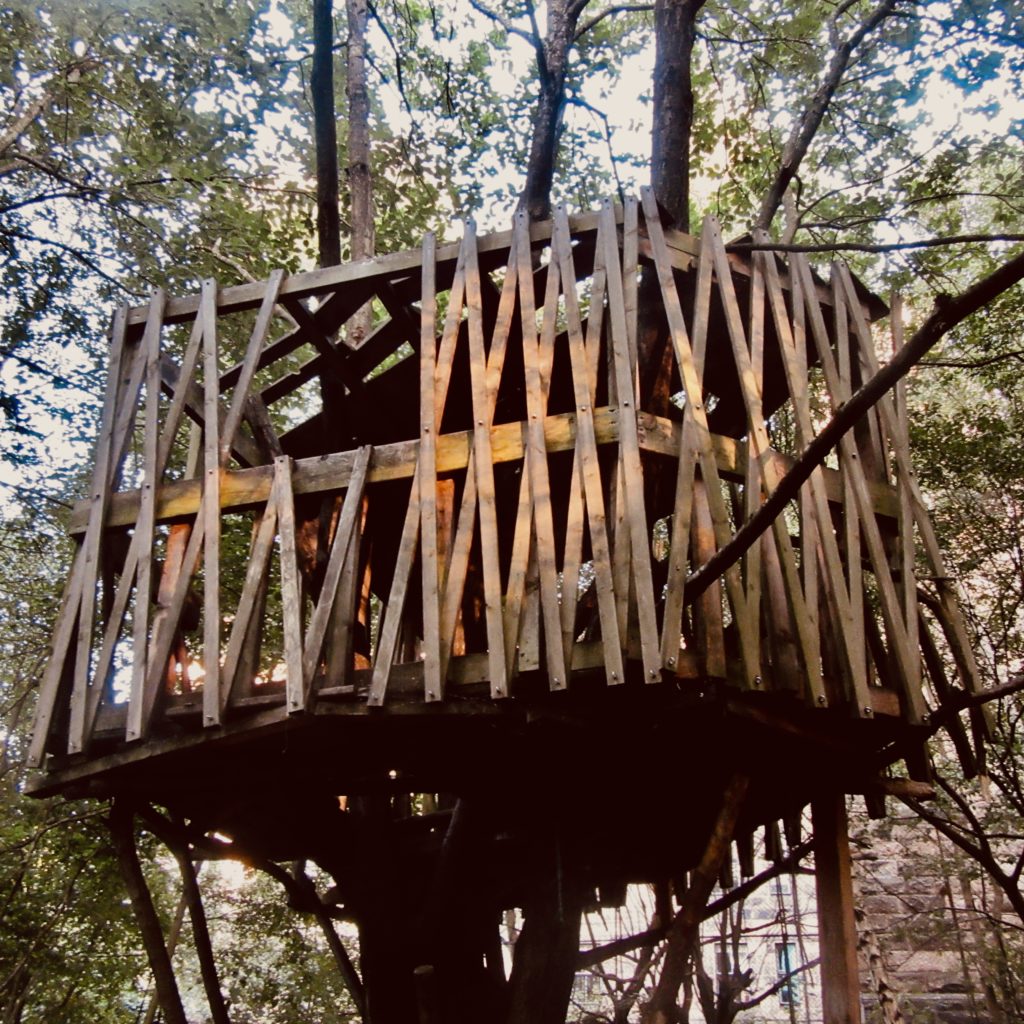
Letter from Glasgow: Re-inhabiting
Some old friends, people I have been close to for over thirty years, come to visit.
It is the first time in many months that the house has been so populated, so lively.
I stand at the window with my friend and we look out. She says — I’m looking for the women who you watch from your window in your letters from Glasgow. There they are, I say pointing down. The student painter is at her easel painting, and the other student, from India, is sitting at her desk in front of a screen. If anything they seem to be more their written selves, in place, taking their cue from the way I described them. My friend is amused to see them performing themselves so precisely.
It is true that they seem to be more constant these days, a permanence in their windows, continually painting and working. But this weekend I turn away from them and look to the five friends gathered here, so long unseen. They have my full attention. I listen to them, startled by this sudden live charge and fluidity. It takes all my energy just to keep pace, taking them in all at once, the to and fro, in this room overturned by their various pitches and rhythms.
The dynamic is familiar but altered. Although we are all glad for this meeting, we are newly uncertain. Inured to absence we must learn again how to be together. We are re-learning and re-noticing — noticing differently. The pauses are slightly longer, our spoken responses not quite as impulsive, although our laughter is. We are taking each other in, newly alert to the fragility of each person, and perhaps more carefully attentive as we attempt to sound out the edges where our seperateness meets; that must also be re-found after the long imposed distancing. The longed for thing has been returned to us but it has changed and we have to inhabit the new shape of it.
On Sunday afternoon I stood on the street, looking down through a gap between buildings and watched the train with the last of my visitors inside it cross the bridge over the Clyde and set off towards London. When they were here I felt they were permanent. When I get back to the flat I go straight to my window and check up on the windows opposite that I have ignored all weekend. I drift from room to room, picking up plates and crumbs and glasses. Although I leave out the long trestle table where we ate, and each of our chairs, for a last unpeopled night.
I find it hard to get back under the skin of my work, so I escape into a book. London in the mid 90s jumps into my lap. I am shocked at how suddenly it ruptures the sandstone silence of the street, the glowing end of summer light, this gentle rhythm of my confined life, watching shadows, watching light, watching the women opposite in their rooms. Suddenly my life when I was their age is in full ruck and flow, with night streets and lights and traffic smells alive and moving through me — the Archway road, Kentish Town, all the people and all the walking, here to here to here. I have not missed it all this time and suddenly I want to be inside it, but inside it thirty years ago, back there. The writing reminds me this is how it was. I am shocked by its power to make things jump awake but also by the persistence of the city inside me, a charge rarely evoked by revisiting. The varieties of dusk, of street and traffic lights, rush hour, the smell of it, all the rooftops and windows and the streets, years of walking, of finding my way, laid down in them, everything at odds with this quietness of the street where I have chosen to stay for work and for confinement, and yet they are both in the same world, and I hold one within the other. If I was actually there it would not be then, what I remember and how I was.
What I remember and how I was, how we were, then. And how far we have walked. My friends have gone back to their different homes and I stay in the house. The street is almost completely still in the city where I live now. I resume my work, anxiously, slowly, but bit by bit. I correspond with friends.
August 31st to September 7th

Letter from Glasgow: Too Hot
I took the train east to meet an old friend at the bar in Leith where she used to work as a teenager, those festival summers that she had recounted to me, over thirty years ago. She was held up, so I leant on a barrel that stood for a table, guarding our place by the kerb in the sun, and waited, the sun on my back, watching the thickening of its light on an empty wall.
It is August, there’s a patchy semblance of a festival on in Edinburgh this year, subdued by pandemic regulation. The second half of August is a limbo time in Scotland with the return to school and Autumn term, repeatedly startling for someone who has not grown up in this country. This time the limbo is swelled by the strange weather, this sun that burns too strongly for Scotland in August, whose heat feels wrong, too much. The heat does not draw you in but makes you rather retreat to the shadows and pull down the blinds, as if in Rome or Athens. And the light has a strangeness, an unfamiliar intensity, there is not the usual dampening mist in it.
I had travelled on an almost empty train from Glasgow, looking out at small gazebo squares in each back garden, the separate doll like figures lying out in the sun, turning an ever darker brown. Beyond, the hills were removed in a distancing heat haze.
At last I saw my friend running towards me, an unmistakeable long lean figure wavering forward. I stepped towards her and invited her into my space by the barrel. We stood and ordered glasses of Viognier, the wine of her territory, the place where we have spent a part of every summer together, over seven years, until the pandemic interrupted. She was born in Edinburgh, but has lived in France since our twenties. In those summers we were two women with five children between us. Each night, when the children were finally in bed, we would sit out in the dark and talk and talk. The first summer of seven my daughter was three and her youngest child was four, now all but my daughter are taller than I am.
We exclaim a little at this bewildering card shuffle of years, of decades, of the incredible ages of our parents, and of our children. Our own numbers feel particularly arbitrary to us and we are determined to be unmoved by them, stubbornly holding this middle ground between them, the timeless ground of a long awaited encounter with a friend, refusing to count the years.
The sun was descending on the other side of the harbour. It shone direct across the water. It lit up my friend’s hair. It lit up the yellowish wine in our glasses. It glowed on the white painted wall. It was moving more swiftly now, casting a triangular swathe across the cobbled harbour road, and the light was a more concentrated orange.
I listen in and am carried by the driving current of my friend’s talk. I sink into the stills and am lapped by its familiar swirls and exclamations. A comforting cadence, the singular rhythmic contortions of a voice that exists as a thing apart from verbal insistence, from which words can actually distract. For now, I will not be diverted by her argument. I want to take in this sounding part of her — a pitch and sway as pleasingly familiar as her gait, not conveyed by the e-mailed words which have had to stand for her in this recent absence — that breaks out of her speech and runs away in the other direction, like water.
I listen in and as I listen I watch a strange progress of shadows of people passing behind my friend’s head, their heads descending along a slope cast by the sun’s inflection. The shadows of the people were cut at a diagonal beneath their shoulders, as if going down a cardboard valley. And although they walked along the pavement in groups, their shadows passed in separate single procession — a silent puppet play against the wall.
I wanted to photograph this procession of figures as they passed across the wall, so certain and elegant in outline, so removed from the actual, more awkward and garishly painted bodies who had given them life. But I was too absorbed in following the movement of my friend’s voice and the shadows passing behind her, holding the two of these together, and could only imagine reaching into my bag for the trapping camera. I could not risk such an interruption. I listened and watched and let them pass.
And when my friend paused, I saw that the shadows had changed, and sunk into the diagonal, so that now only the tops of their heads were visible over the shadow slope, the people had gone into the mountain. It was too late, and in any case it was not perhaps a thing that could be captured in an instant. I would have to find other ways to hold it.
We drained our glasses and left our ghosts behind at the wall, merging with the shadows of the harbour, to greet me in the autumn when I come back on my own.
July 27th to August 3rd

Letter from Glasgow: On The Other Side
A week in now, to twelve days of elected solitude. I have got used to the returning calibrations of my days — the sounds of front doors and delivery vans in the street, the noise of the cat pacing, loud as another human, on the creaking boards at the threshold of each room.
In spite of the deferred anxiety of a large family gathering, the wider family creep into my dreams — my father and brother, my mother, my sister, all visit me in my room and present their needs in turn. I don’t dream of my own children. I fold and put away their clothes. I miss their voices, the breezy humming and whistling, but they do not haunt me.
The heat is so thick you can almost lean on it.
I go back to the mirror city in search of its cool sea fret but even here the heat is watery hot. From the top of Leith Walk the blurry blue outlines of land on the other side of the Firth are like Greek islands. Half way down the street is a Greek café and I step down into a sunken dark space smelling of burnt sugar and ask for an espresso and a papery pastry full of warm custard. Mid afternoon and I feel anywhere but Edinburgh. The young man and woman who work here talk to me about how long they haven’t seen their siblings for, about the difficulty of travel, to home in Thessaloniki, to a brother working in Germany. We compare our lengths of absence, although my journey to my siblings is more assured than theirs, only one border away. I step back up into the street into a blast of heat.
At the bottom of the hill, approaching the sea, I find myself at the edge of a large open park that I never knew was there. I see it suddenly as one of the commons of South London, familiar from my Putney childhood. It is huge, with a row of old houses on two edges, and the carved articulations of a municipal façade on another. It is criss-crossed by thin diagonals of chalky paths. The unexpected expanse of space makes me catch my breath.
I walk into it, through the trees at the borders, and along the paths. There are Holm oaks, sycamore, chestnut — sweet and horse, hornbeam, high poplars, not pollarded thin and straight but allowed to spread thickly — and a huge silvery willow that holds its own space, not planted in a line with other trees but standing solid in the middle of the grass.
People are sitting about across the grass, alone and in groups, talking. There are children on scooters and on bicycles, and smaller children running after the bicycles. In the play park the roundabout turns and the children are swinging and sliding and climbing ropes. A man is skipping quietly in a steady counter beat to the whirl of the swings and roundabout. He lets the rope fall right to the ground and then scoops it up and over. There are voices: Urdu, Polish, Scots. Sometimes I mistake one for another.
There is something secret and almost celebratory in this space at the edge of the sea. The houses are kept at bay and the people are playing or sitting in the holding sun, without fret or urgency, out of the space and time of the city. I walk quietly through — a woman on a bicycle and another walking towards me smile at me, almost a welcome, as if recognising a stranger in their hidden land.
I walk across the grass to the one empty bench left. It is set back from the path, in the middle of the grass, facing into the sun and the resplendent flickering willow. I think it is the best bench in the space, and feel surprised and grateful that it has been left waiting for me. I sit and watch a family flying kites. There is a large kite with tassels and a small girl running with a much smaller kite that rises up after her as she runs with its string. The sun shines through the square of her yellow sun hat and makes it liquid, a translucent golden blur. The parents are preoccupied with their larger kite but the girl goes back and forth running out and walking back again towards the tree. The willow tree stirs and enfolds itself, riding the same breeze, out and back.
I sit and follow the stirring of the tree, the kite, the hat of the girl — going up and back, and repeating again like a swing. I check the time. I set myself a time to move or I might stay here indefinitely. Ten past four. I get up and walk back to the path. I follow a child cycling straight ahead of me down its narrow white diagonal, back out to the world left behind on the other side.
July 20th to July 27th
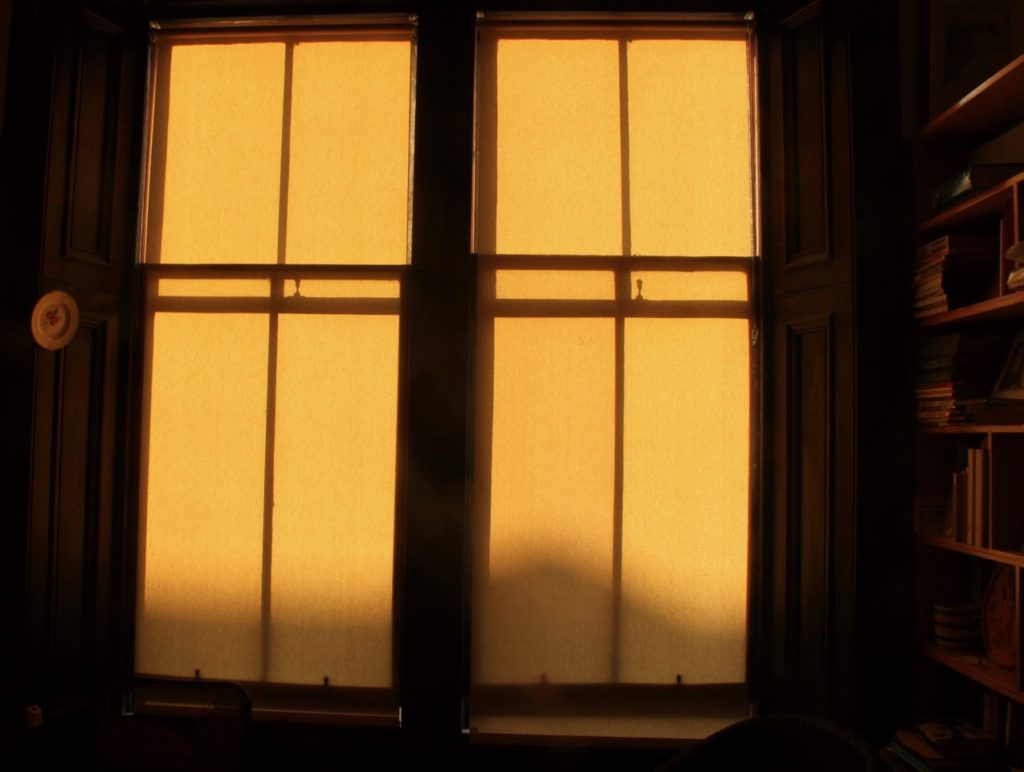
Letter from Glasgow: Staying Put
Almost August, and so the to and fro of holiday planning — fielding the variables of Covid testing and potential quarantine — the ever changing regulations. In spite of the obstacles we submit to the tests, to the exigencies of borders. In as much as it seems reasonable or possible, we try to move, knowing how swiftly even these constrained escapes might be curtailed.
A large family holiday in Normandy is deferred for the second summer running. “It’s a first world problem,” a friend writes. She too has had a reunion of long parted family members from different countries in a rented French house cancelled. She is looking for places to go away to, but there is nowhere to stay in the UK, everything is booked or exorbitant.
Like me she feels a mix of regret and relief at the cancelling of the wider family gathering. Most of us are anxious about the sudden exposure of being part of a large group after so long lying low. Not worried about the physical danger so much as the danger of being exposed to other people’s feelings and demands in close proximity, the fear of what they might uncover in you.
My children did PCR tests and took the night boat to Ireland with their father, to see their cousins and grandparents. I have stayed behind to try and work, but also to be alone for longer than a night for the first time in almost two years. Its a heatwave on the streets but I stay indoors, too familiar with the imaginary landscapes outside to be drawn out. The silence of the empty rooms in my flat makes a novel, larger landscape. I pull down the blinds to mute the bleaching harshness of light beyond the windows and make a glowing secret space. I can believe myself in Rome, Madrid or Budapest, in the enclosing solitude of another time and another country. It is enough for now.
July 6th to July 13th
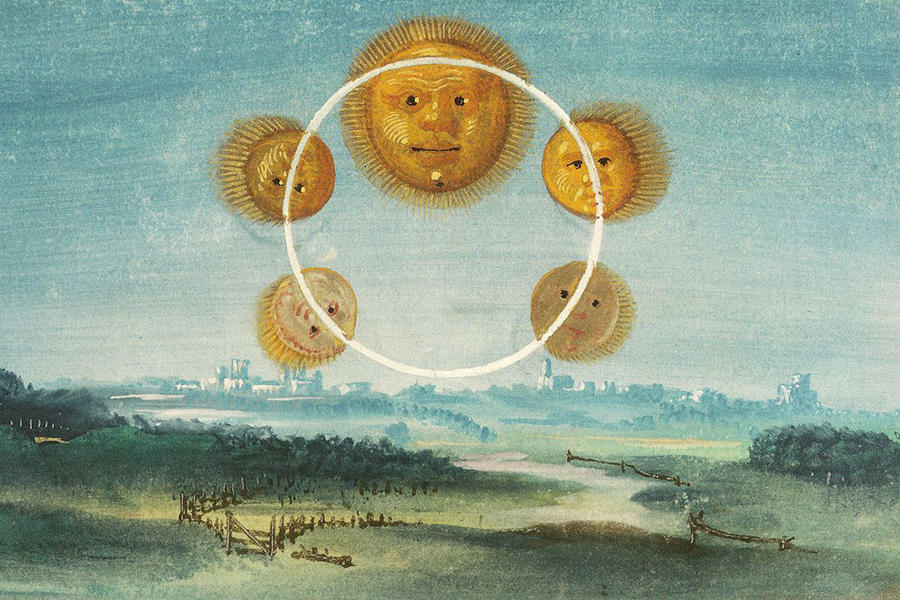
Letter from Glasgow: Other People’s Rooms (Midsummer)
At the bottom of the mountain, as our path descended, the road began to flatten out in a straight line towards home. It was getting dark, this was the start of spring, about the time of the vernal equinox, and we were still in full lockdown. This summit of hills was just within the radius beyond the city permitted for exercise, yet it was at enough of a distance to feel remote. There were lochs at the top, slushy with thick shards of half-melted ice, and some corrugated iron fishing huts. As you got half way down you could look out on the city spread across the low plain, that had held us for so many months, suddenly in miniature.
As we walked back down we felt that we had been quite far away. There was a pine forest thickening black on one side of the path and the long dark façade of a building like a large industrial barn on the other, a little below us, set into the side of the mountain. Wide, evenly spaced windows shone squares of light into the dusk. The wall was too smooth and municipal to be a barn but rather resembled a large motel, utterly without inflection or quirk.
I looked down into the lit squares where you could discern the edges of furniture, and of certain handrails, walking sticks and municipal chairs that signalled some sort of medical establishment — a sanatorium, I thought, thinking of ones I had come across in the countryside of Eastern Europe or Russia. Looking in more closely, I could see separate bodies, brightly lit — very old bodies, sitting, almost motionless, in chairs, and realised that this must be an old people’s home, a Care Home. I noticed a dark wood chest of drawers and a 1930s wardrobe holding their own amongst the pine and vinyl, it was a place where you can be accompanied by your furniture. The rooms did not look unpleasant, their lit spaces were almost appealing, for it was getting cold and there was still a long stretch of road before us. The televisions flickered silver blue against the walls.
In the last corner room I watched the profile of a woman, she was sitting in a chair looking across at the screen. Her face was very thin, with deep sunken cheeks and elegant bony forearms. There was a tray of food before her, on a moveable arched table brought in close to her chair. Very slowly she brought the fork to her mouth as she followed the screen, she stared ahead and slowly cut and ate her food, with this stillness and self-possession. She looked extremely old, but somehow the extremity of her age and her thinness added to her grace. Her age did not frighten me. I allowed myself to imagine her, picturing myself as this person, soon enough, in fewer years than I have already lived. I hoped that I might also have that calm, the self-possession I sensed from watching the way she sat and ate, that defied her surroundings, solitude and circumstance. Although I was sorry that these rooms were rammed so close to the mountain, set in a sunken trough that had been excavated beneath the path, in the shadow of the lowering pine forest. The compound itself was magnificently situated, like a castle, its grounds commanding a broad view across the valley. East to the ancient settlement of the city, now spread and spiked with steeples and high-rise buildings that glitter pink gold as the sun sets, and west, where the river widens and goes to meet the sea. Yet the windows of the rooms all faced inwards, turned to the blank face of the mountain like a child made to stand in the corner, or looking onto an internal courtyard. I reproached the architects for their carelessness, their failure to imagine that they were building for people whose window view would be their last variety.
I remembered this image in these recent days of endless light, the bottoming out of the year just after the solstice. The light is relentless. I wake at half past four as the sun rises and am wide awake in my lit up room. There is no reason not to begin the day, except that I only went to bed four hours earlier and I hanker after my dreams. Usually I fall back to sleep and wake again when the sun is already high and blazing on my face, and there is light in the sky until nearly midnight. At midsummer in Glasgow there is no actual darkness, only a few hours of seeming dark known as “nautical twilight”. It is no longer a season for walking the evening streets, looking in at lit windows, pausing to sneak photographs of other people’s rooms, fishing the watery half-obscured, the tantalising edges of things. At times it can feel as if there is almost too much light, a solidity that makes it harder to see.
Under conditions of low illumination we see things more distinctly if we don’t look directly at them. I found this copied down in an old notebook. It was from a catalogue essay on Bonnard. The writer had been trying to convey the ways that waning light can provoke us to open up our field of vision, allowing things to emerge more slowly but maybe more vividly, as we scan sideways in the half-dark.
Does this mean that brightness can actually be an obfuscation? Too much sun in the eyes can blind us temporarily. The brightness that freezes my dreams or stops me from remembering them. Maybe we can decipher things better, make more sense of them by not looking directly at them. The glimpse of a painting when the light has been turned off and you are heading out the studio door. The things that manifest through suggestion, or looking slantwise, rather than being confronted face on, in the spotlight’s glare. We allow them to reveal themselves by pretending to look away. A way of paying attention, a way of taking care.
June 29th to July 6th
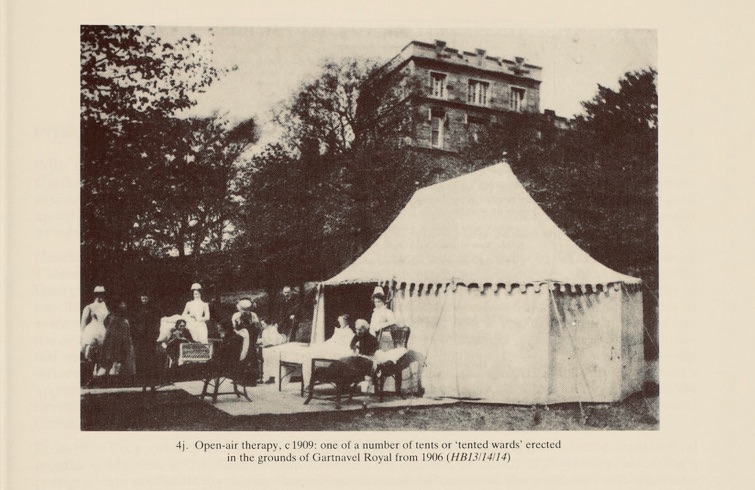
Letter from Glasgow: In the Garden
Gartnavel Royal Hospital, or Gartnavel Royal Asylum for Lunatics as it was once known, stands at the top of a hill on the western edge of Glasgow. There are many of these grand half-derelict buildings in Scotland, built in the nineteenth century, in fashionable Tudor Gothic, to house those deemed mad by society. The building at Gartnavel replaced the original panopticon style asylum in the city centre. Its foundation stone, laid in 1842, boasts that the new buildings will be “divested of all gloom or appearance of confinement”. The two large houses had views to the Clyde and the Campsie fells, and were surrounded by extensive gardens and a lake. Gartnavel derives from the Gaelic for garden of apples: a sort of Eden, almost.
By the end of the twentieth century these castle like buildings were being steadily emptied. The Community Care Act of 1990 meant that residential treatment was increasingly reserved for more acute patients, who were housed in smaller, plasticised, purpose-built wards in the same grounds. The abandoned asylums stand like ghosts looking down on them, often still holding their beds, chairs, screens, while forests of buddleia sprout through the slate rooftops and pigeons fly in and out through the broken panes.
I became familiar with these territories when I worked as an interpreter for refugees and asylum seekers in this city a decade later. Births and mental distress were the most recurrent reasons to be called out. Soon I was familiar with the different levels of psychiatric care and procedures of admission: from resource centres and counsellors to the wards, open and locked. Pregnancy and Madness were the only events considered serious enough to warrant a continuity of interpreter and so my role became more than just a mouthpiece for the transfer of information. Inevitably I became a part of the narrative, at times more than I anticipated.
I progressed through each level of institutional care, side by side and back again, with a distressed man from Lithuania. I sat next to him as his section order was signed. The nurses used to put him on the phone to me from his locked ward because nobody else could speak to him and he would ask when I was coming back. When I was away, he said that he heard me broadcasting to him from a radio in his stomach. I sat with him at the fortnightly meetings with the psychiatrist who he told that the only thing he wanted was for me to collect him from the hospital and take him home. The doctor discouraged him from talking too much. He sought just enough answers to sign off or renew drug prescriptions. I was the only person who could listen to his strange inventive speeches, who heard him out.
Birth and mental distress coincided when I was called out to a new mother suffering from post puerperal psychosis. We found her in a tiny flat on the ground floor of an immense high rise on the famous Red Road estate. The bed took up almost the whole room, but she was running around it, trying to escape the doctors, to hide in the narrow space between bed and window. They brought her out, and we left her very young husband, who looked a child himself, holding the baby, sitting disconsolate among the few congratulatory cards.
At the time, a friend of mine was studying the history of Victorian asylums. He took me to the abandoned grounds of one on the outskirts of Belfast and described the ideal that was hoped for — a calm and enclosed routine of gardening, or woodwork and other manual crafts. I pictured the people at work in the light and spacious rooms behind the high glass windows, or digging and planting within the red brick walls of the derelict kitchen garden where we stood. I thought of a sort of monastic repetition of tasks, a safe passing of the hours that gives a rhythm to the days and harms no-one. I know that, as with monasteries, the ideal could fall well short, but still the fall of afternoon light and leaf shadows against the garden wall drew me in to picture a life of clear air and safe purpose, remote from the blue smoke fogged television rooms crowded with vinyl armchairs where I had spent so many hours, ingesting weak lukewarm tea and the smell of cheap tobacco, keeping my patients company, waiting to see the doctors, surrounded by so many others who were simply smoking and waiting.
This Saturday a group of us played music in the walled gardens of the old Gartnavel Asylum. We had been invited as part of a Covid commissioned theatre project. A few people were allowed into the garden to hear us and we played old Klezmer tunes, Breton and Scottish folk tunes under an ancient pear tree. The garden before us was full of flowers and herbs, abundant and well tended, behind us loomed the West House of the Asylum, with glass doors opening on to a terrace. Some rooms are still used for offices but most are empty. I looked down into the basement, where faded 1970s flowered print curtains hung from half-smashed windows. The walls of the basement well were thick with deep green moss and sprouting trees. The West House was built to house the richer patients and the Superintendent’s rooms, which overlooked the terrace. The East House, now completely derelict, originally held the paupers dormitories. It was evacuated by the 1990s. Through a broken window a strip light is hanging, blowing gently on the breeze.
I found some old photographs of the buildings’ interiors from over a hundred years ago. There were long carpeted corridors with parlour palms and elegant side tables. There are pictures of Open Air or “Tent Therapy”: patients lying out on beds under luxurious looking white tents, attended by nurses with trays of refreshments. The therapy — lots of sleep and bed rest in the fresh air, and plentiful vegetarian food, was deemed effective and made available to residents of both Houses up until the First World War. Occupational Therapy gained ground from the 1920s and R.D Laing’s “rumpus room” experiments took place here in the 1950s. Although dramatically named, the room would not have looked much different to an Occupational Therapy room. Cooking, knitting, sewing, drawing and housework even were encouraged and tools were provided. Laing and his colleagues were opening an existing format up to more isolated and “extreme” patients, diagnosed schizophrenics for whom such treatment might have been thought hopeless. Free conversation, real talk with the nurses was also encouraged. Laing’s scepticism of medicated isolation was not quite as unique as he later implied. Henderson and MacNiven, successive Superintendents of Gartnavel between 1921 and 1965, had both studied in New York with Adolf Meyer, a pioneer of Occupational Therapy and Psychobiology who was open to the insights of Freudian Psychoanalysis. Both men were cautious of over reliance on the popular methods of insulin induced comas, Lobotomy or Electro-convulsive therapy. Angus MacNiven, Superintendent when Laing was there, had a signed photograph of Sigmund Freud on his wall, something that seems quite unlikely in a Psychiatric hospital office today.
The music in the garden was an odd echo or enactment of a dream I had had last November, as we locked down again for winter — of warm summer light through cloistered gardens, with musicians playing in them, leaning in, listening and responding. I thought about the way that music can comfort when words trip us up or fail us, and of the ghosts in the garden, working the plots, weaving or woodworking, or lying out, resting in their magnificent tents. I wished them well as we played to each other, the ghosts of the asylum and those of the future that we were playing towards.
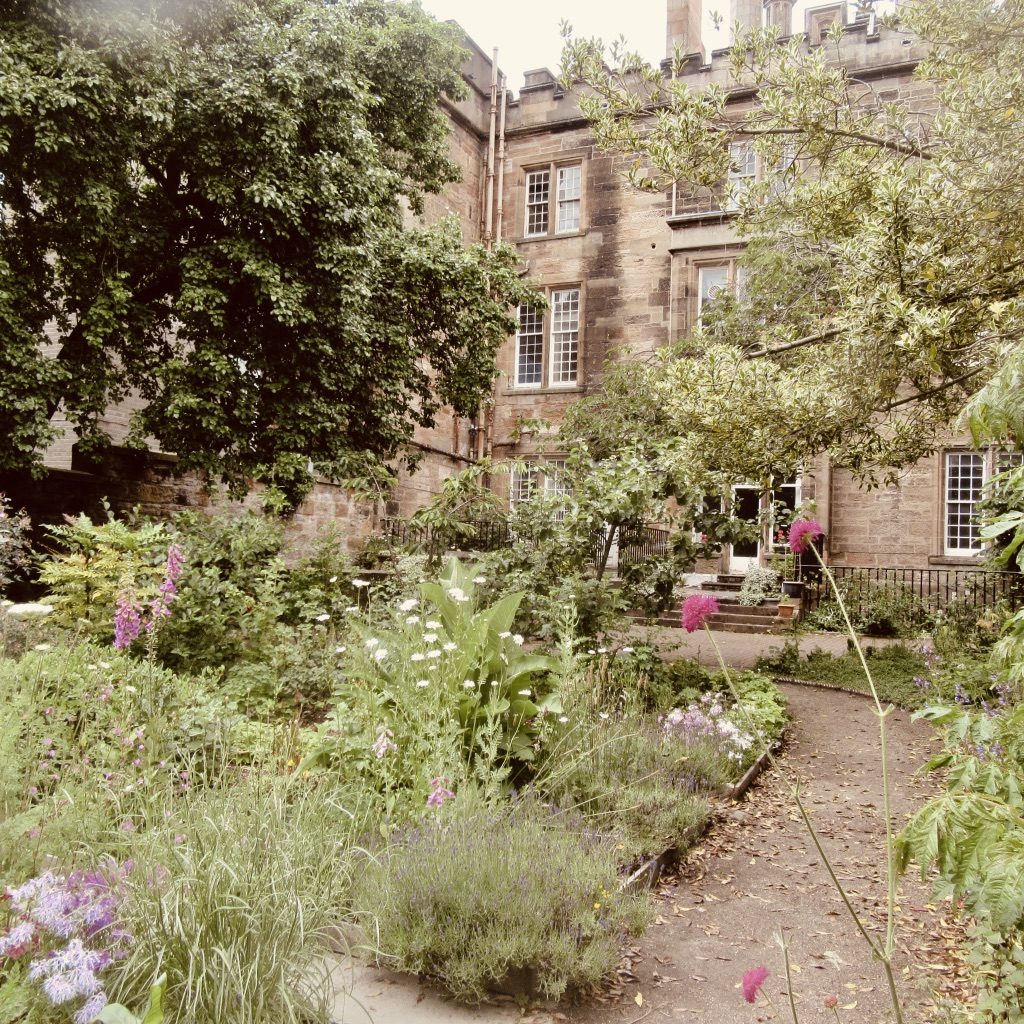
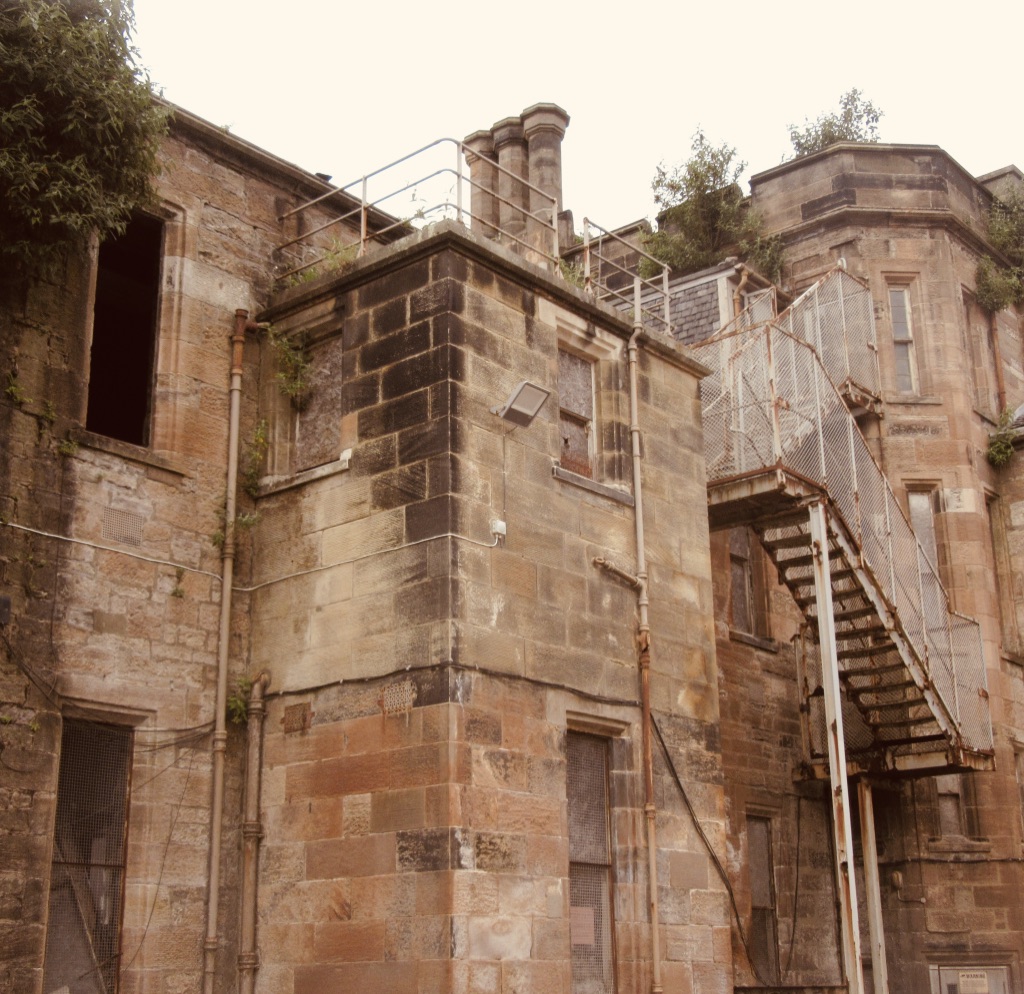
June 22nd to June 29th
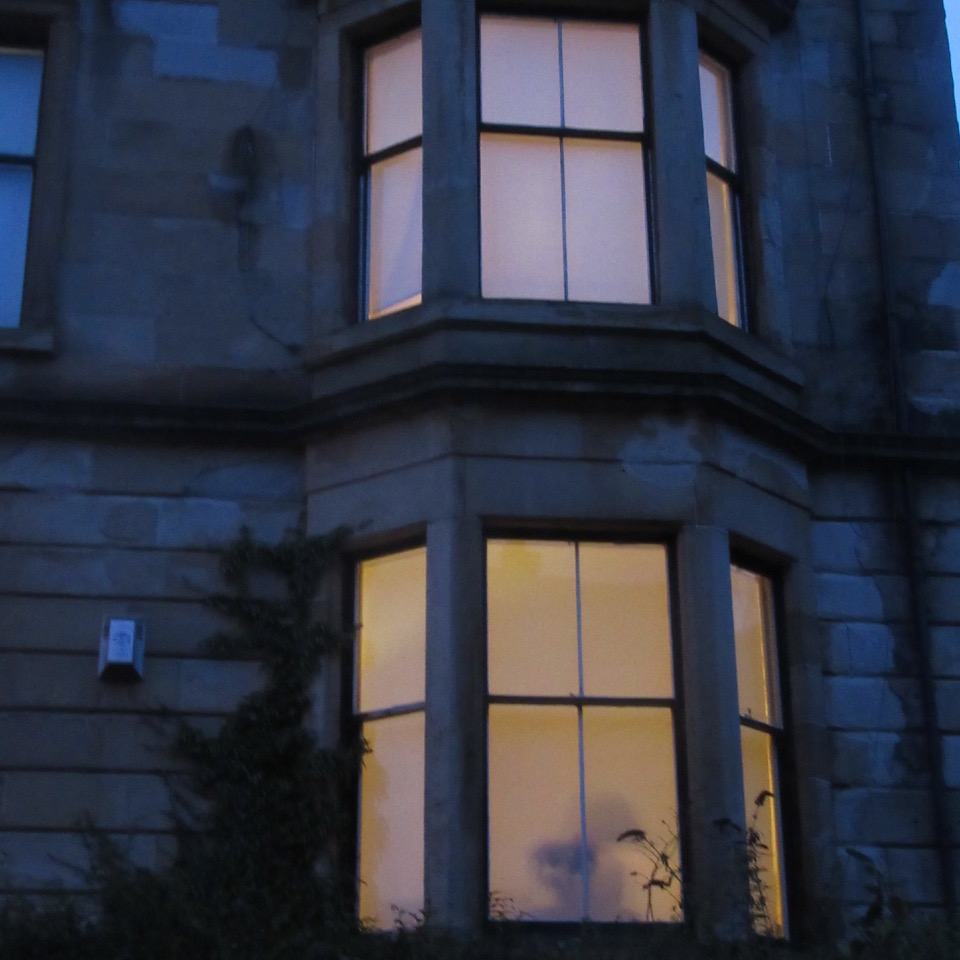
Letter from Glasgow: Salvaging
Coming back from walking my daughter to school I cut into Oakfield Avenue, the street that runs parallel to my own. There are no longer any oaks here but tourists come to photograph the three large cherry trees at the junction with Glasgow street when they blossom. At the end of the street I see a van with large white letters on the side: Joe’s Junk, waiting at the entrance to one of the buildings. I pause for a moment in case something interesting might be coming out of the door. It turns out it is a piano, an old upright made of golden polished wood. The men are barely carrying it, they are wobbling back and forward and the front panel smashes off. They do not look as though they are used to managing pianos, and they still have the front steps to go. I know that the piano is not being simply removed, but will be broken up. The van’s logo and the movements of the delivery men make this clear.
I want to go up to the piano, to try its keys. I worry that this is a good piano, about to be destroyed needlessly. I stand in the middle of the road, knowing that there is nothing I can do. It is not a table that I can drag back up the lane and four flights of stairs to my flat. I am good at rescuing furniture, I have stubbornly salvaged entire plan chests my own size, single handedly, drawer by enormous drawer. No amount of resolve would allow me to shift a piano though, and we already have our own musty upright, rescued from an east end church. I think of running to ring the piano tuner’s doorbell. He lives on this street. His work is salvaging and repairing pianos, he has a warehouse full. He told me that Glasgow used to be full of piano makers, and that many good quality pianos are still at large in the city, for a piano in the home was an essential luxury before radio, before television. He loves pianos and all of their component parts. If only he would come out of his door, he might reassure me that it is alright to let this one go, or he might intervene and save its life.
If I had turned the corner a few minutes later I would never have known about the fate of the piano, like all the other furniture that must have been removed, demolished, discarded, from so many houses over so many years, without my knowing about it. But if I happen to coincide with a throwing out I feel it is my duty to take care of what is left behind. The objects don’t have to be rare or antique. A plain table or chest left in the back lane will catch my attention and I feel I must take care of it, I must take it in. I guess this is how some people feel about abandoned animals. I feel responsible for these objects. But I can’t feel responsible for all this furniture, there is no room in my house for even one more chair.
As I live in a student neighbourhood, this weakness of mine meant that my life would become very busy around June, when the leases were up and flats were changing hands. There used to be endless leavings of old furniture in the back lanes and courts. I am almost relieved now that the flats are furnished with cheap IKEA items, which are always thrown out broken, and are no temptation. It was the resolute solidity of the old brown furniture that made it hard to ignore.
A few months ago I took in a new foundling in the form of a wooden box, the size of a small crate, inlaid with gold crested lettering saying “CABINETTO”. It had a handle at the side like a hurdy gurdy and a glass slot at the top that opened onto a scroll with punched rectangles, the score, that would delivered the notes. I suppose this invention must have come about between pianos and record players, a sort of small mechanical organ. The scroll inside had lyrics down the side — half words printed in blue inked sans serif capitals in a staggered narrow vertical:
LAY
I
LAY
I
MONDS
LO-
THE
ON
UP
HO
O
HO
O
IN’
COM-
ARE
BELLS
CAMP-
THE
EN
LEV-
LOCH-
NIE
BON-
TO
Like a long concrete poem. Until I realised that you had to read it from the bottom up. The song was Scottish but the roll is stamped Brooklyn, N.Y. Although large, it was by no means a piano and I could carry it all the way up the hill to my house. It was not working and would certainly need delicate repair but I could not leave it lying on the pavement.
The Cabinetto was resting in a line on the kerb between boxes of books, speakers and music amps. A house clearance was going on at the mysterious house at the foot of Glasgow Street, an old lone building with a high gate and walled garden on the edge of the river. The men were putting everything out on the street and encouraging people to help themselves. A few students were looking through the books. The boxes were going to be loaded into a van and taken to the dump. It was a time of full lockdown and despite there being two secondhand bookshops on the same street everything was closed, and the books would be pulped. I piled two boxes of Penguin paperbacks, dark orange and very dirty cream, on top of the Cabinetto. I have no room for books either, but it was starting to rain and I could not watch them get soaked.
In another box there were copies of the Evergreen Review, an American literary magazine from the 50s and 60s, with new extracts from Beckett and Genet and elegant black and white listings for New York painting shows, names of writers, poets and painters, familiar and forgotten. There was even an advert for a blended whisky from Glasgow, « a jug of Johnny Begg », listed as one of the essential “Things you need when Beatniking”. The men encouraged me to get into the van and see if there were any more copies to be found in the boxes already stacked there. They told me furtively that they had been directed to clear the house because the man who lived there could not throw anything away, he had become walled in by his things. It seems he may have been removed to a hospital and they were directed to come and clear the moveable items while he was away. I might have heard this as a cautionary tale, but instead I was compelled to go through all the books, making sure that nothing important was sacrificed to the shredder. I encouraged the passing students to help share my load, I recommended books to them. Eventually, as the rain fell more heavily, I made my slow progress back up Glasgow Street, balancing boxes of books and the Cabinetto.
I have not tried to make the Cabinetto work yet, but I do not regret the salvage operation. At night, when I’m too tired to read, I survey the elegant monochrome ads in the Evergreen Review for art exhibitions of 1961, on East 57th or West 56th, N. Y. C., as if I am planning to set out there. I check the forthcoming publications from Grove Press and New Directions, and note the addresses of the bookshops, and the Cabinetto has found its place on my floor, between an armchair and a cupboard, after all it is a good bit smaller than a piano.
June 15th to June 22nd
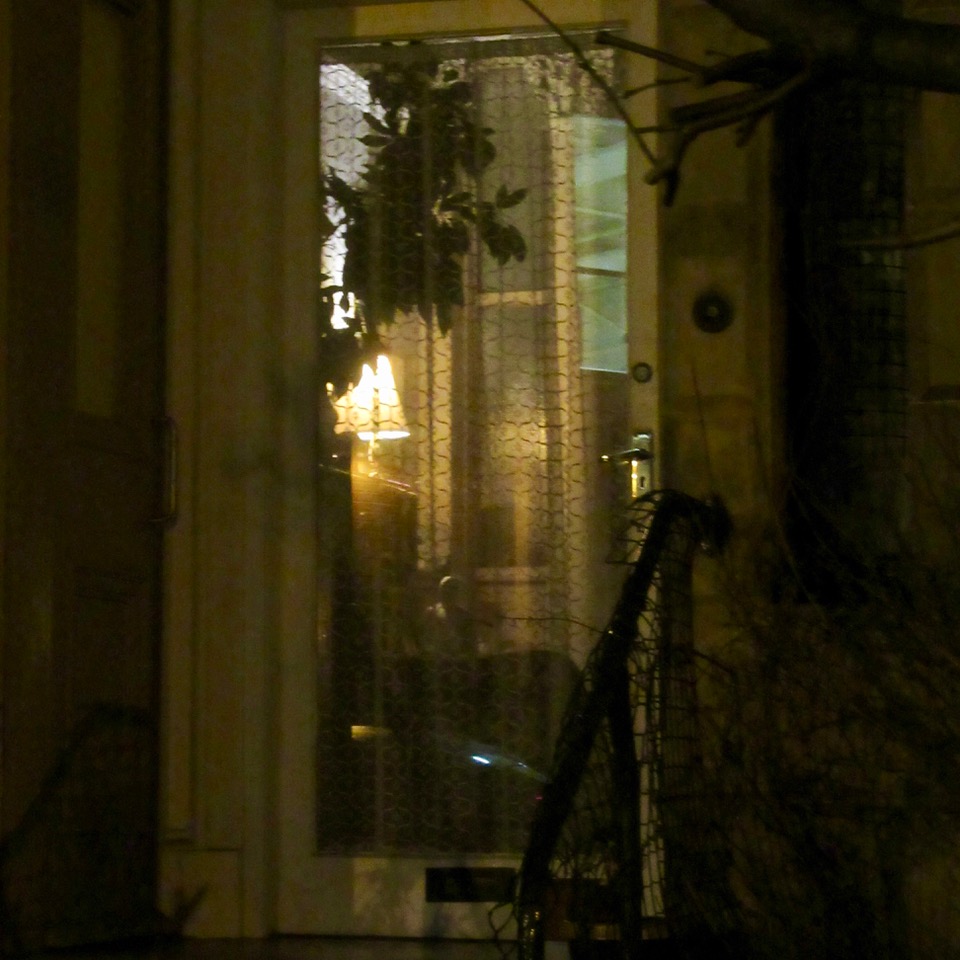
Letter from Glasgow: Glasgow Street
On Glasgow Street there is a house with a cement front garden full of flowers. I love this spot, set almost at the top of the hill, at the place where we cross the road from the broader pavement by the school to the narrower one by the houses, that marks the fact that we are about to reach home. The sight of it was especially welcome in the days when I was pushing a double pushchair full of shopping, my hefty three year old son and one year old daughter slung low, arms outstretched to maximise my force up the long steep gradient of the street. The garden has not changed since and even then seemed as if it had been there always. The house was lived in by an old woman, a botanist some said, who had taught at the university. She walked on two sticks hunched right over, making her extremely slow progress around the block. But she would stop and beam when the children passed, and watch them go. Sometimes I would find her on the main road, resting in the evening sun at rush hour, perched on the low ledge of the pub wall, sticks at her side, watching.
She would walk alone, stick by stick, or accompanied by her son or daughter who must be in their sixties or seventies now. Eventually the old woman stopped her evening perambulations, and then died a few years ago. Her son wears a tweed hat, belted raincoat and carries a worn leather briefcase in gloved hands on his walks. We would often see him at the start of the pandemic, striding energetically across the park or straight down the middle of the road on his way to his office at the university. He would greet us with a wave and a grin without breaking stride. He works for the Anatomy Department, some people call him the body parts librarian. We haven’t questioned him closely on his job but it seems that he is responsible for signing the body parts in and out to the students.
The brother and sister live in the house now, with several cats, who keep guard at the doorstep. There is a glass door that gives a teasing view of a front hallway with a large tree in a pot and a Corinthian pillar in the middle, painted red, there is a kitchen room beyond the pillar, but it is hard to make anything out too clearly and so it remains a glimpse to be completed, expanded in the imagination. At the back of their house, which my garden-side windows look onto, there are gangplanks running from the low window sills, for the cats to escape into the shared mossy garden. At the front is the more ornamental cement garden. Now, in midsummer, it is filled with flowers — red hot pokers, ragged magnolia and azalea, drowsy half-blown roses with enormous petals of deep crimson, and London pride. But the best thing about it is the marbles, a great spread of them, set in concrete on a raised stone protrusion, like a sort of permanent game of solitaire. On hot days their spiralled glint beneath the azalea draws you in, you want to touch them, to feel the contrast of the cool rounded glass and the heat from the rough stone in which they are so solidly set. The cat prowls about behind the dark green rail that seems to be made of metal scaffolding tubes. The children always liked to pause here, on the way home, to climb up on the railing and look in, they call it the marble garden.
For fifteen months I have been circling this small perimeter of the neighbourhood, finding spaces from which to take off into other imagined worlds. Overgrown gardens, back lanes, rooftops and windows become wide open fields, strange lands, remote castles and inviting interiors — my day dreams and diversions.. Never quite in step with the present, in spite of this long staying put, never quite catching up with the turns of the year — the blossom blown the day after you notice it properly, the leaves in autumn also. Staying put, for longer than you ever thought possible does not deliver the solidity or permanence that you long for.
Or think you long. As my friend wrote to me this week: I don’t trust mindfulness. We have to be able to gaze into the past and future in any given moment — what other freedom have we got? And I welcome her words, and realise that she is right, and give up my dream of suspension inside a safe and permanent present for the fleeting distractions of the restless mind, trusting in the daily improvisations by which we might surprise ourselves.
June 8th to June 15th

Letter from Glasgow: Inside/Out
Today, Saturday June 5th 2021, the restrictions are being eased in this city. I can no longer date the various stages of our confinement but the BBC website reports that Glasgow has suffered one of the longest, most stringent lockdowns in the UK. I check back and realise that it is true — for over nine months no-one has been allowed in anyone else’s home, apart from on Christmas day, and for most of that time we have not been allowed to travel beyond the city boundary. We have become used to this, and today find ourselves as before, staying inside, looking out.
Last week, on the evening that this announcement was made, I was walking home and turned into West Prince’s Street. The start of the street to my right had been sealed off with police tape, there was a helicopter above and several police vans on the ground. I took in the scene and then turned to the left, walking west. In the mid-distance I saw a man I knew standing on a corner, covered in blood, like a tall bloody pillar. As I drew closer I saw that it was superficial grazing, though very raw, the whole side of his face peeled of skin, and wounds on his arms and legs. He had just been knocked from his bike by a car. Another man was dialling an ambulance. There was a woman there who I also knew, a mother from my children’s school. We discussed the dramas of the evening street and the news of the impending freedom.
She said she that she would “kiss the ground” of the pub that she used to hate working in when she returned there this weekend. She said that a drunk or ten were infinitely preferable to the addicts “off their head on methadone” who she has had to reason with for the past months, having been forced to take a job at a local chemist because the pubs were shut. But apart from the dramas on this street the mood feels quiet, even slightly subdued. It doesn’t seem as though the city is breaking out in revelry.
The woman went into her house and I continued home. I cut across the empty car park and over the bridge by the river path, where a man was sitting on a low wall. I watched a rat scamper along the wall just near him and make for the undergrowth behind. The man was eating a bar of chocolate and he broke off some pieces of the chocolate and placed them carefully at intervals along the wall at his side. I realised that he was offering them to the rat, trying to coax him back out, to share his meal. We keep the company that we can.
Tonight we are going to meet the students from across the road who hung the sign out of their window asking us to dinner. Although we are allowed to meet indoors today for the first time since last summer we will eat outside, at picnic tables on the patch of community land at the end of our street, because everyone is tired of being inside, and perhaps because I want to sustain the mystery of those magic lanterns opposite. When the dinner is over I will be able to return safely to my room, and resume my watch over their imagined rooms on the other side, the half-lit glimpses that I have become used to.
June 1st to June 8th

Letter from Glasgow: Un-forgetting
People are coming out of their houses. My neighbours are emerging from their bay windowed observation boxes. This week I watched the musician couple on the corner, drinking wine on their front steps in the long May twilight, their baby with them, now wide-eyed and alert. I saw the painter and the student from India from the rooms opposite out on the street for the first time, walking back to their flat together, and was struck by how different they appeared on the other side of their windows, in motion, not held at their desks, half-concealed.
On the main streets the pavements are full of people drinking outside as they are now allowed to do, you can hear them long before you see them.. But drinking is all there is to do. The orchestra is back in the City Halls, but there are no audiences. I chance on my friend the violinist playing a solo live on the radio. I turn her up loud and listen in, but I haven’t watched her play since the winter before last.
It is completely light now before five each morning, and sometimes I get up and go and drink tea in my chair at the window to enjoy the emptiness and watch the squirrels who have the run of the streets at this time. I can pause here. I take in the silence and the soft light that makes the space around feel enormous. It is very still, almost no wind.
It feels as though there should be something momentous to mark this emergence, not just this casual resumption of bars and social life and holiday planning, as if nothing has changed. Although I know it is hard to do any differently. I feel restless and exhausted at the same time. I try to hold the past year in my hand, to get the measure of it, but it overflows me, perhaps I’m not yet ready to re-inhabit it, to grapple with its intensities and propositions.
Last week I travelled as far as Edinburgh, the mirror city. I walked for miles along the Water of Leith. It is hard to miss the obvious evocations in this name of the mythical river, Lethe, that ran through the underworld. I look up the Greek word: it means Oblivion, Concealment or Forgetting. The word for Truth is A-lethe-ia; literally it means an un-concealment or un-forgetting. These last two translations move in different directions. Forgetting suggests a limbo state, something that might sometime be remembered, and provokes a counter impulse, to seek that which has been forgotten — the wish to reclaim, or rescue from Oblivion. Forgetting, and the recovery of that which has been forgotten — the un-forgetting — is most often involuntary, at least against our conscious will. But concealment and un-concealing is active, it can be willed, and alerts us to the fact that the hiding of the thing was probably a deliberate act. Un-concealment is closer to the conjuror’s trick — ta da! The big reveal, the curtain drawn back. I walk back upstream, against the brown bubbling current where willow leaves trail on the surface, and wonder about things that have been hidden on purpose and things that are forgotten against our will.
May 25th to June 1st
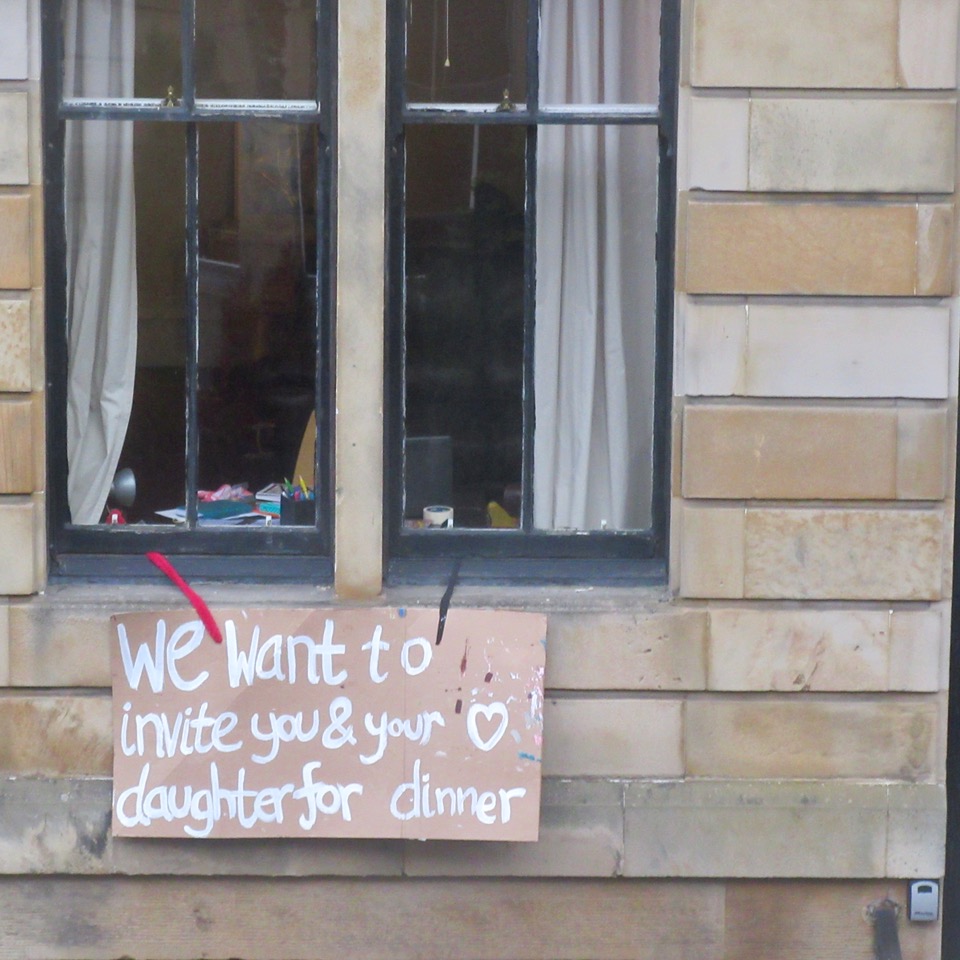
Letter from Glasgow: THROUGH THE WINDOW
For a year we have kept watch over the students whose rooms we look into opposite. I have photographed their windows for the Crown Letter, and written about them. First, the painter who I see from my study, and then the woman in the room on the other side of the main door, who often sat in her bed all day working, and kept rearranging the furniture. She always waved to us if she saw us in the window, and soon this was part of our daily routine — my daughter and I waving and smiling down to the woman in her room, at desk, bed or sofa below. This Easter we met her for the first time as she was coming out of the flat. We were heading out to visit friends in their garden and she accompanied us a way along the street. We learned that she had come to Glasgow from India last summer for a year’s MA, but has been confined to her room.
We walk along the street together talking. She says how should I address you, should I call you Aunty? Which is how a woman of her age might address an older woman with children in her country, but I say just my name is fine. The next day we look out and see a huge cardboard banner that she and the painter in the room next to her have made and suspended from her window — with large painted letters inviting me and my daughter to come to dinner, for all the street to see.
Soon after this, things started to get much worse in India… When I see her again she tells me that her family have moved out of the city in Jaipur to a village in the countryside, for safety. Her mother, grandmother and aunt all have Covid. The men of the family are now doing the shopping and the domestic duties. Her best friend’s mother, who she had grown up with, died from the virus. She stayed up all night crying and talking to her friend online. She worries continually, but she can’t be there. She says that sometimes when she sees me in the window with my daughter, brushing her hair, it reminds her of herself and her mother. Indeed I am the same age as her mother, although my daughter is so much younger.
At night I see her light on late and the curtains closed and I worry about the possibility of bad news from home. Sometimes the curtains stay shut all the next day and I worry more. But so far, when I pass her open window on the street and check in, her family have survived intact. Soon, once the restrictions here are eased, my daughter and I will cross the road for dinner.
May 18th to May 25th
POSTCARDS TO GLASGOW (IV): THROUGH THE WINDOW
This week’s postcards come from a housing estate in the Orkney islands, an Italian hill town, a street in East Oxford, a Paris balcony, and from a friend who lives just a mile away, although that also felt like a remote land in the months of strict lockdown.

I’ve started a drawing of my window. The thing with my window is it faces straight on to the neighbour’s garden. All through lockdown his friend was in the garden catching my eye. I put up a small silk tablecloth because it’s a sunny south facing window and it’s warm to have a sunny room. I felt terrible guilt at blocking them out but relief as well. In the winter the willow is bare and the fennel and oxeye daisies are all died back but they will grow back. It’s tricky to draw. I’ll get back to you.
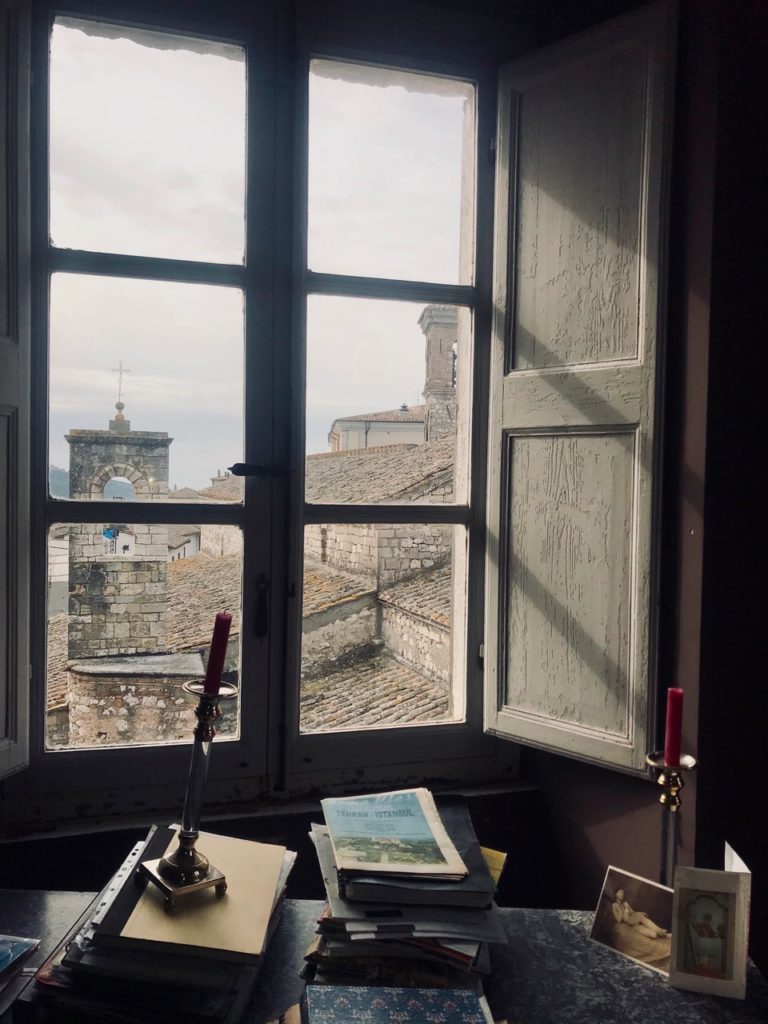
I took this photo to the left of where I write — it is a view towards the east, across the rooftops of the stone houses, beyond the ancient church bell tower, and past what was an old hospital, but is now apartments. Mostly I see the rooftops and above, like a hawk sees anomalies and slight, unusual shifts. And I can see and feel, if I sit in its path, the sun as it passes from this window to the west. Many times, I came up here to sit, even in the thinnest winter sun. One evening, I saw an enormous black cloud passing overhead; it circulated above, and went on its way, leaving us untouched. Many a night, the kids and I did our daily walk in the darkness, around the village walls, amidst the stars and sometimes the shapes of the moon; we rarely met, or saw, another soul (apart from the two men who, because of heart problems, circle the village daily, day and night, walking kilometres at a time).
It’s an old village, medieval and earlier, and what is now the church is built on what was a Roman temple, qualities and columns of which remain in its crypt. Features of prior pandemics remain too: the Porta Romana that would have been shut to anyone infected; chutes built into ancient walls where foodstuffs would have been pushed through; and tens of terracotta urns unearthed over the years, each with the tiny skeleton of a baby or a small child inside, encased in dried mud, who died in a malaria pandemic in the 1200s.
In autumn and winter we had a few clusters of Covid, mostly families infected together; one evening, in the days before Christmas, I took a hot roasted chicken to a friend and her family, housebound for a month with Covid in their tiny stone house; and cheese and crackers, and a box of ceramic Christmas decorations from Tiger (a cupcake, a Matrioshka doll and an old-fashioned toy train), bought in haste at Termini, all covered in glitter and neatly packed in a box with candles and a strand of coloured lights, into which we sprinkled small chocolates. I left the hot chicken and other gifts on the top step and rang the doorbell. The lady from the shop in the old part of the village also left a bag of food on their doorstep each day that month.
Other forces and frenzies have circulated these months too: stories of people who had seen, or had been told by others who had seen, wolves come down from the hills surrounding the village; one seen eating a sheep (shearing the sheep’s skin with its teeth before killing it). You can see in the photo the priest’s roof being re-tiled by builders, they’ve been at it for months. He too is part of village mythology, or is it hysteria, for these things may or may not have happened; perhaps they are hearsay or imagined, for such imaginings have intensified during the months of lockdown. The priest, originally from Poland, was brought back from a neighbouring village, even though it is said that he had slept with tens of women in the village (mothers and daughters from the same family, queuing up at his door). I’ve seen him once or twice, out in the piazza in his leather jacket, but keep well away!
I saw too, in Rome, a magnificent graffiti painting in grey and white, on the side of a portacabin: a ‘pandemic-faced’, half-transparent devil was ferrying away one of the large river gods (Ganges I think it was, holding a long oar), from the fountain of the Quatro Fiumi (the Four Rivers) in Piazza Navona.
It’s been hard months for people – there have been so few children about, although as spring has arrived, a few teenagers now venture out, and the bar is open for table service. I had stopped asking people how they were, because for some it was terrible; Terribile, was the reply.
I remember how cold it has been too: only in bed or sitting in our black car in the sun do I remember feeling really warm. And despite endless months of lockdown at home, my time up here was always curtailed: up would come my kids, often in pyjamas, to tell me they’d finished their online classes or homework, and that they were now going to be on their phones and I wasn’t to disturb them; they were done.
The reclining nude in the photo (dated 1894) was, by the way, a birthday card you sent me on my 30th birthday, when we lived in London. I stumbled across it recently, and put it out, as a wonderful find from the phases of time in our lives.

The view through my window these days is rather obliterated by the seedlings which are jostling for sun, patiently waiting for the right moment to be carried carefully to the allotment and bedded in for the summer: courgettes, sweetcorn, broccoli, cauliflower, runner beans. Not all will make it through my delicate balancing of sun, light and watering. I neglect them, and then make up for it with a dousing, only for some to drown… But they offer a good distraction from work.
And beyond the seedlings, I see my neighbours opposite – people I didn’t know the names of before the pandemic. The weekly clap for carers brought us all out onto the street, and for the first time, we all acknowledged each other, and little by little, began to share stories, swap books, recipes and then phone numbers for the new street Whatsapp group. Such valuable connections, for those shielding, those living alone, a single mum locked down with 2 kids under 4 and nowhere to go… And the weekly meet-up continues even now, organised on Whatsapp, with people coming and going, in order to more or less adhere to the rule of 6 – a connectedness in this little corner of East Oxford, prompted by the pandemic.

At the end of May last year I rearranged the furniture in the front room so that we could sit in the bay window, as near to outside as possible. It made the space feel new. I would open a window wide each morning and lean out to drink the air. Over time I began to notice subtle scents on the breeze. This photo was taken lying on the sofa from where I watched seagulls gather on the chimney pots. ‘Partick Bay’ (as we named it) closed for the winter season and returned, along with the gulls, in spring. It may well be an annual destination…

Le 15 mai 2021, Paris. Ma chambre-bureau avec vue sur notre parc. Au printemps cette verdure resplendissante nous fait presque oublier les voitures qui passent en bas… On ne voit pas mais on n’a plus le droit d’aller sur le petit balcon – une famille de pigeons y a installé un nid. Un petit pigeonneau est né il y a pile une semaine. Si j’ouvre la porte du balcon les parents s’enfuient en panique. On a donc condamné cette porte pour le moment, en attendant que le petit s’envole. A quel âge les pigeons prennent leur envol ?
My bedroom-study with a view of our park. In the spring this resplendent greenery almost makes us forget the cars passing below … You can’t see, but we are no longer allowed out on the small balcony — a family of pigeons has made a nest there. A baby pigeon was born exactly a week ago. If I open the balcony door the parents fly off in panic. So we have condemned this door for the moment, while waiting for the little one to fly away. At what age do pigeons take flight?
May 11th to May 18th
POSTCARDS TO GLASGOW (III): HOPING
This week’s postcards come from Oxford, London, Berlin and Moscow. I’ve allowed myself two postcards from the top floor flat on Malaya Bronnaya street in Moscow, where my friend Masha has lived for nearly forty years. One was an Easter card showing the kitchen table and the other is the view from her balcony. I have described both places repeatedly for the Crown Letter over the past year: this February, last September, and for the first time exactly a year ago, in my second letter from Glasgow, May 12-19th 2020. So it feels right to have them revealed in pictures here this week. Lines about laughter, prayer and remembering the dead.
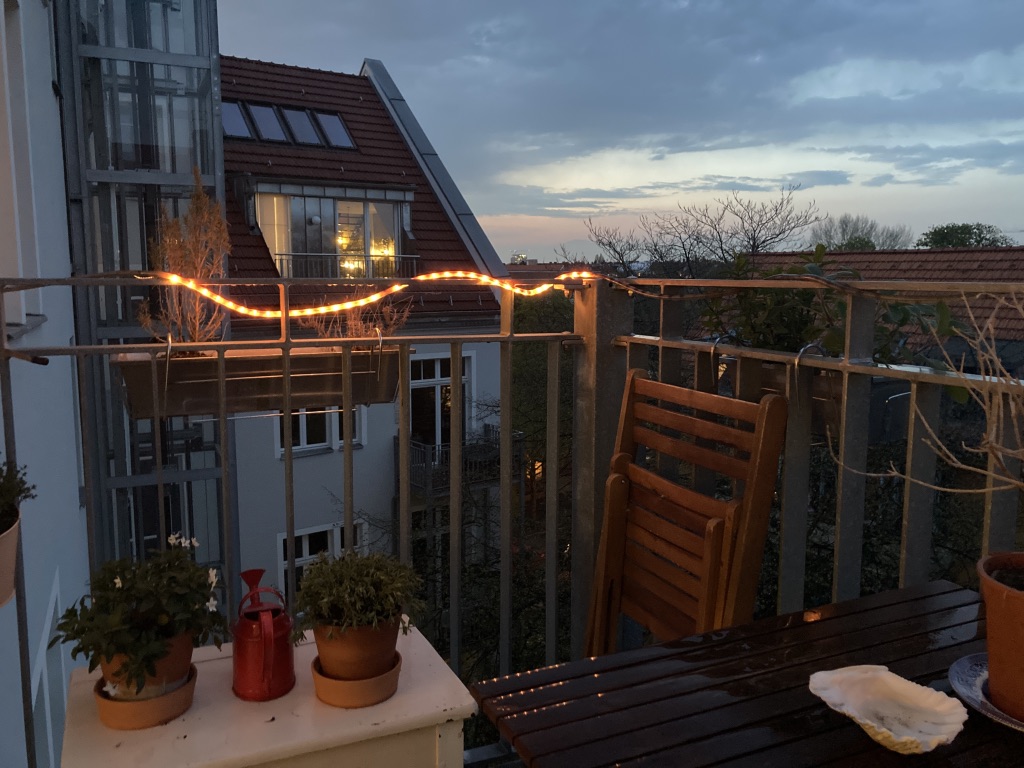
This is a view from my balcony, where I tend to spend most evenings.
Germany is still in lockdown with a 10 pm curfew. The streets are filled with people until 9.55 and then at 10 they all disappear. The week before last a group of 50 high profile actors released a series of short satirical clips criticising the governments recent lockdown measures. Many of the clips were offensive to hospital workers and the families of corona victims. They did this because they were angry at the low prioritisation of the arts in the governments corona plans.
When these clips were released online, many people got angry. Care workers and hospital workers got angry. Other actors got angry. The media got angry. The only people who didn’t get angry were the AFD, the German far right party and the self-named “lateral thinkers” otherwise known as corona deniers.
In the past weeks there has been a lot of this type of anger.
So I have been trying this week to not get angry. Instead, I’ve been reading Mikhail Bakhtin on the role of laughter in society. Bakhtin writes that in the Middle Ages, a public event, such as a speech by the king, would be accompanied by an intervention in which a fool or clown mocked that speech. Fools performed a key role at funerals as well, where the deceased would be lovingly mocked as much as mourned. Not the type of laughter which mocks lesser mortals from on high. But the type of laughter in which we laugh with each other and at ourselves, the laughter which can be a way of staying human in the face of impossible odds.
Maybe if we had a greater collective sense of humour, we’d concern ourselves more with what binds us together, rather than what divides us

Seeing all the views from workrooms makes me want to send you some photos of the beautiful window boxes Dan made me for my study.
The picture on the wall, depicting a church on the Greek island of Spetses, was painted on a fragment of a brown paper cement sack by Kirill Sokolov in 1989. He was the husband of my university tutor Avril Pyman, who has just turned 91.
I’m still on the same relentless regime, but finally (after more than 6 months!) I have finished what I hope may be Part 3 of my crazy book. Nearly 60,000 words, and a lot of it is just about 1898. A temporary end to tunnel vision these last months at least. Some Chekhov things to catch up on.

Лайза, милая, могу ответить кусочком нашей кухни. Куличи и яица мои, а пасху каждый год делает давняя подруга ещё родителей, теперь она делится с нами. Христос воскресе!
Dear Liza, I’m replying with a slice of our kitchen. The kuliches and eggs are mine, the paskha is made each year by an old friend, a friend of my parents as well in their day, now she shares it with us. Christ is risen!
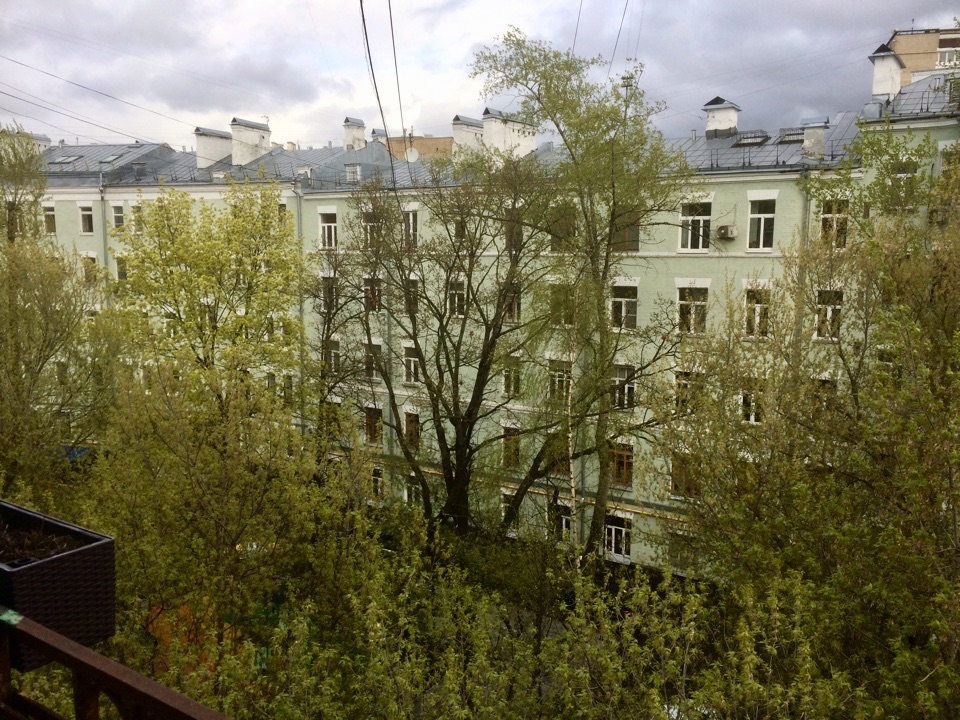
Вот ещё фото, с любимого балкона – все деревья зеленеют, кроме дуба, он самый поздний (как у Толстова), жду его листьев и надеюсь.
Here’s another photo from your favourite balcony — the trees are all turning green, apart from the oak, which is always the last (as in Tolstoy), I wait for its leaves and hope.

This photo was taken on the 15th April 2020. It’s the view from my study. The candle is made in a Steiner community in Scotland, a present to me from my friend Frank. Even though I’m no longer a believer, I prayed to this candle throughout lockdown: I prayed to Nana, Granny, Gags (x 2), Aunt Mary and Tante Pat. It was a new thing for me to do. Somehow I felt the need to conjure my ancestors and ask for their help.
May 4th to May 11th
My friends situate me in space. I like to know where they are and what they are doing — what preoccupies them. I like to have at least one ongoing email conversation with a friend each day as I work, preferably three. I picture my friends as I describe to them what is in me and around me, and they help me to complete the picture.
This week the postcards arrived as drawings, and a painting, views from a specific space and time.
POSTCARDS TO GLASGOW (II) : LOOKING OUT

the world slowed to the pin needle drop I wanted. 5am wake up call from the baby rose the dawn, the birds and nothing more but a view out the window of bodies turning in the beds, breathing, not rising. the air over the city oxygenised, greened. everyone claimed new found time and freedom, mine dwindled in contrast.
something inside opened – love.

I was drawing the pots on my balcony first, over and over, then the flats opposite, then I came to a stop and couldn’t draw from my window any more, until the scaffolding and blue coverings went up on the church, and I started again. I draw what feel like literal, exact representations, looking closely at each part in turn, but missing links in between, and surprised by the marks the pastels make. I’m surprised how they’re blurry and dreamlike. Sometimes I try to correct details and over-work them and lose something, and feel sad. I don’t know how this fits into my week, and sometimes doesn’t, and I can’t draw until the weekend, or for a few weeks, busy sitting at my job, at my desk or on the sofa, or in bed, or circling — sofa, desk, bed etc… Often worrying about a mistake. Sometimes enjoying not having to go out. Very tired. 29th April 2021
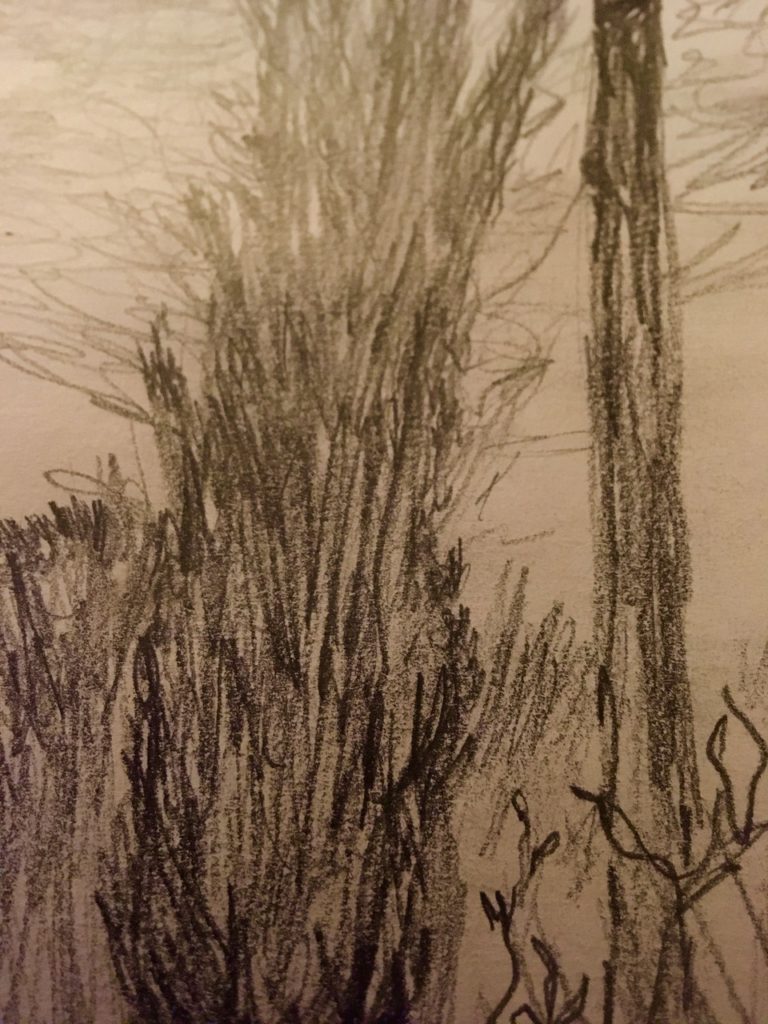
My window here is a door and my door is a window because I’m writing from the sill that you know well that gives on to the lavender bushes and into the garden. Everything is shimmering in yellow and green gauze in the late afternoon sun and a shower of fine yellow pollen is speckling my screen with graphic precision. I’m watching a huge black bee come and go from a hole in the wall and just next to it a blue tit is also making its nest deep amongst the warm stones. And out beyond that the frogs are holding a long and amorous conference that comes and goes too in extraordinary bursts of excitement and intensity, more compelling and purposeful than a lot of the conversations I’ve heard over the past few months, mysterious and rich, then letting up for moments of reflection and perhaps a dip under the surface, a cooling away from one another, before bursting out again.
Earlier today, across the road and staying well within our currently prescribed conversational limits, my neighbour and I shouted a few friendly greetings that quickly became a bleating of distress mixing anger and sorrow. Perhaps because he was speaking to me whom he identifies as belonging to the remoter reaches of the world that is failing us so badly, his most grievous words were aimed at the research community — grassement payé, as he reminded me: richly paid… — and yet still failing to understand anything much about this ‘thing’ that has happened to us. I protested of course, but it quickly became apparent that his sentiment was really inspired by the deep-felt conviction that there had to be more to this than scientific or managerial solutions could explain and assuage: how could this ‘thing’ overwhelm us so quickly, how did it spread so fast, how could it possibly have come from a pangolin meeting a bat, so who released it into the world…? My protestations made no headway, and as I sit here looking out in the mystery of my cohabitations from my own perch in this ancient wall, I feel an unfathomable mixture of anguish and peace, of strange and beautiful proximities and infinite distances. 25th April 2021

This view of the sky seen from our living room was the one of the first paintings I did at home during the first lockdown. I didn’t realise it would be a year until I’d see my studio again. In a way, it was just an exercise to keep myself making something. From then I found that two hours on a Saturday at the kitchen table was the best/only time to make work so that’s what I did. Finally it’s opened up enough here for me to get to my studio, the sea, to a loch for a swim. Like many people, I’m starting to feel a bit free again.
April 27th to May 4th
POSTCARDS TO GLASGOW (I): WORK ROOMS
A year of lockdowns and separation. The second year of the Crown Letter. Instead of a letter from Glasgow I wrote to friends whom I have not seen for months or a year or longer. I asked them to send me an image, a postcard of the view that they looked at most over this past year, and to put a few words, on the back of a postcard so to speak, about the view or about what they were doing or thinking as they looked, day after day. This week I received the first four postcards to Glasgow. All are views from work spaces, from friends of over thirty years: a lawyer in Wales, a mental health worker in Oxford and a writer in France and one from my sister in Bristol. We have been corresponding throughout the pandemic, but for the first time I can sit, in my mind’s eye, at the place where they work, and look out, for a moment, with their eyes.
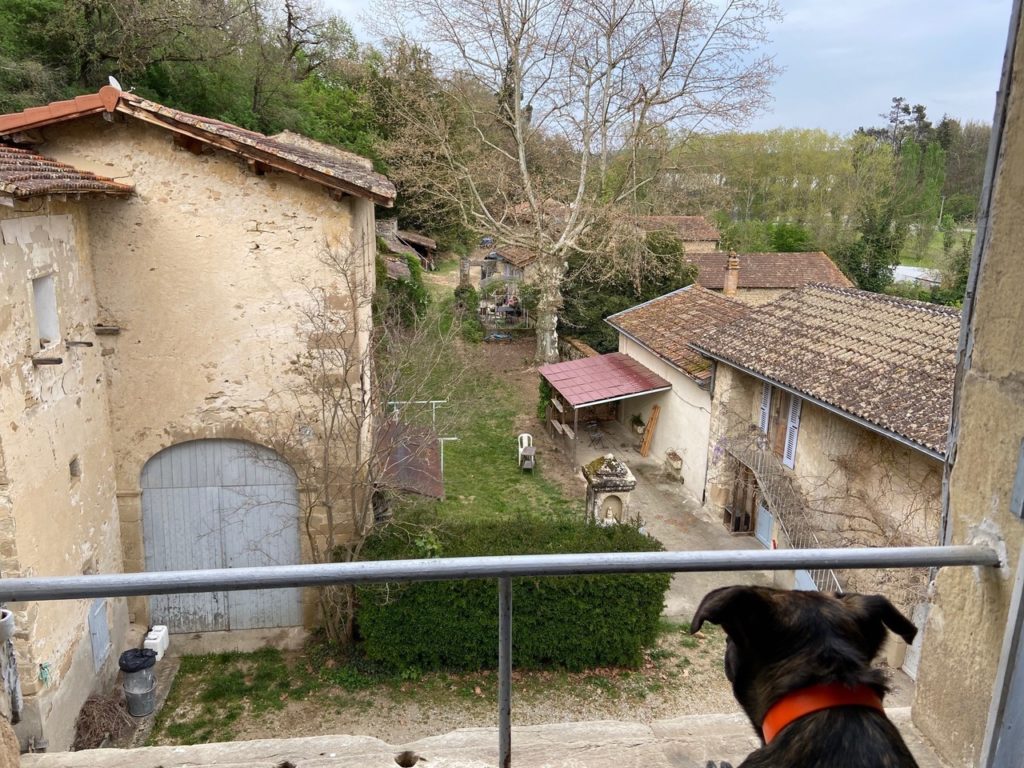
This photo was taken Sunday evening, April 25 2021, just before curfew. It’s the view from my workroom window in France, the room where I spend 12 hours a day and which I love best in the world. You see my dog Luna (with the hi-vis orange collar) looking down at the neighbours’ Siamese cat whom she’s longing to chase. The room is east-facing, you’re looking out at old farm buildings—a silk-worm hatchery, a barn, a pheasant-run, the old baths. And beyond the feathery line of trees, the hulk of a giant multinational soft-drink factory.
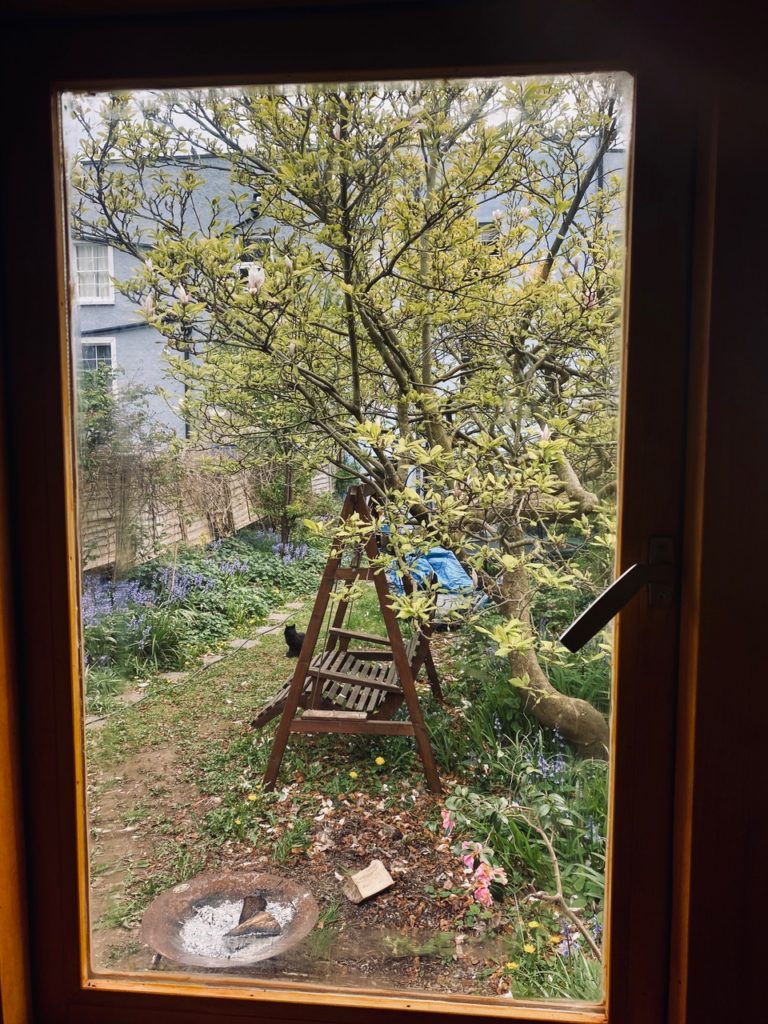
Place : my new woodshed looking back at the house with fire pit, magnolia tree, kitten and swing-seat. Taken : 27th April 2021
In December mid-second lockdown, I bit the bullet and decided to get a shed in my garden. I had been dreaming of it for years. I spent hours researching the best shed for me. It seemed impossible to make the decision: practical issues always got in the way as well as a feeling of indulgence. Could I really get a shed just for me? Did we need planning permission? What about the neighbours? What about the budget? These questions thwarted me and stopped me acting. Until — locked in and working from home with my partner and children, I realised it was time. It happened in a phone call. I already knew which shed I wanted, how much it would cost and who would build it (in half a day!). Then I would paint it. And paint, and paint. I put the headphones on, listened to Taylor Swift’s lockdown albums and dreamed of life in the shed in the spring.
In February, my mother-in-law died. It was she who had inspired the idea of a shed of my own. She had been a hairdresser, a therapist, a healer and finally a writer. And apart from the first, she had sheds for all of these activities in the different houses she lived in — all proudly painted and decorated by her. When her husband died, she ran writing groups from her shed which were a lifeline for her and the women who took part. The poems written there were read at her funeral.
Now it is here — it is no longer just my shed of course. The kids use it to entertain their friends outdoors after school, my husband and I use it to drink whisky in and occasionally, on days like today, I head here with no plan. Except to write and dream and catch up with my life.
This picture manages to capture and remind me of some of the best parts of lockdown. Fires in the garden, chatting to the kids away from screens, our lockdown kitten Minky who has become a joyous part of the family, the swing seat and our Magnolia tree – who announced the « opening » up of this dark and intense period with an incredible spring bloom.

This is the view from my kitchen table. In the tree outside the door are two bird feeders. Everyday I watch blue tits, great tits, robins, chaffinches and goldfinches gathering on the pear tree branches and feeding on the sunflower hearts. There are often six or seven goldfinches feeding, and some were born in my garden; last summer I watched the little brown fledgling finches gain their crimson and gold colours as they grew. I have worked at my kitchen table for the whole of the past year — I should have found myself a desk, a quiet place in the house that could be my study — given that all day long I am in meetings on Zoom. But I don’t want to leave the kitchen. I like having the radio and the kettle close by, and children passing through to get biscuits, and I love this view. This view is the view closest to my heart, the view that’s most “mine”; it makes me feel secure, makes me feel at home. This view gives me a sense of hope — whatever happens, the pear tree still bursts into blossom and then into leaf and then into fruit and the finches still flutter in its branches.

Morning Lize, this is the view from my window this morning although I’m not actually working today, which makes the view even more lovely I think because I can just sit and watch it. I’m going to the sea next week to near Penzance to walk and swim and have a change of scene. I’ll write from there XxxX
April 20th to April 27th
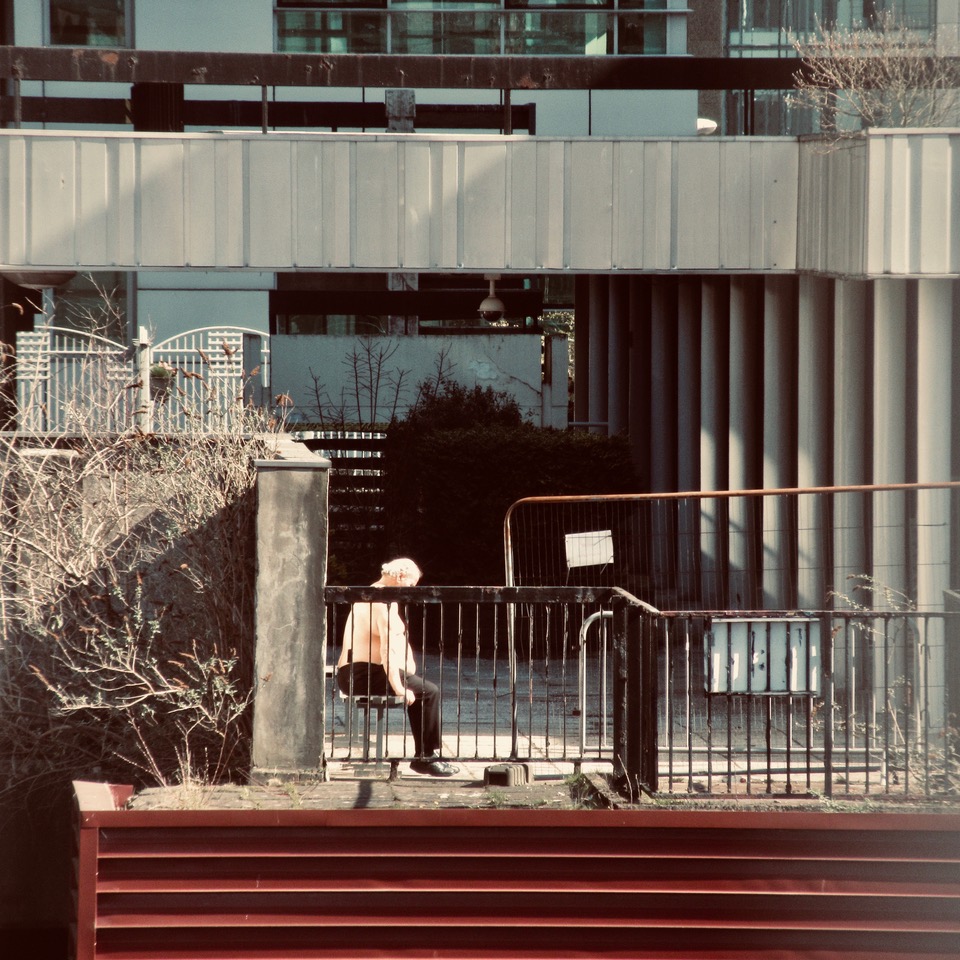
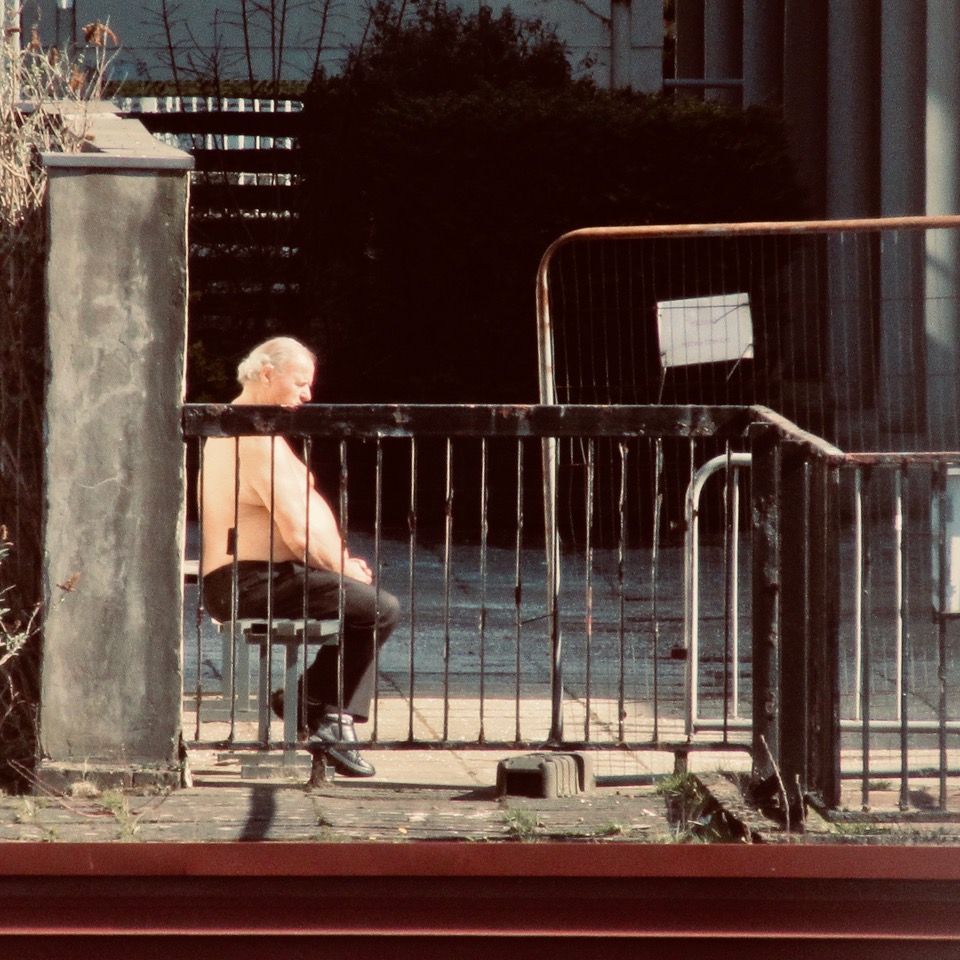
Letter from Glasgow: PAUSE
I have barely entered the city centre for a year, since I shut up my studio last March. This city exaggerates a separation between the centre and the outlying areas at the best of times, ruptured at the north and west by a large motorway, an abandoned ring road that never achieved full circle. Entire neighbourhoods were excavated and now caverns of underpasses and motorway bridges must be broached to cross from the land of leafy parks and University where I live to the downtown city proper. The city centre is laid out on a grid, with high tenements that block the light, empty lots and sudden mirrored high rises like parts of New York, or Chicago. This year I have worked at home. I have avoided the studio and have not been taking trains, the concert halls are shut, so I have no reason to go into the centre, and I fear it. I picture deserted buildings, silent streets where only the junkies remain, scavenging emptiness.
Then a friend emails, she says she left a cake on a train from London, a Colomba, an Italian Easter cake, and it has ended up in the Lost Property at Glasgow Central. It is mine, she says, for payment of the holding fee. This is the most practical purpose I have been assigned in weeks, the cake promises elegance, images of Easter parades through Italian hill towns, of London Italian delicatessens hung with pretty boxed cakes, chocolate eggs in extravagant foil wrappings, smoked hams, to decorate our pared down Easter. Of course I accept.
On Good Friday I set out from my house to walk to the station. My children refuse to join me on this adventure so I leave them in the darkened house on their screens. Outside it is the brightest sun, a stark and over-exposed landscape where the trees are still bare. The light makes everything feel thin-skinned. I cut across the park that has become a huge holding pen: families, groups of students with nowhere to go, wandering restlessly with plastic bags of provisions, looking for spaces to sit. I head south, trying to find a different way to the motorway. I follow the curve of an old crescent, where people are sitting out on their doorsteps in the sun, and cut to a path which runs right next to the motorway. The sun is quite hot now, the cars speed alongside me. Then I am under a flyover, walking on grass, reading graffitied slogans of the latest SNP infighting that unfold like chapters on the elegant diamond-shaped concrete piles. The flyover snakes down on its piles to the pedestrian bridge that will take me over the widest part of the motorway and land me in the city centre. From the top of the bridge I see a man sitting face into the sun, enclosed by the empty Modernist complex on the other side. He is in a sort of courtyard, a concrete garden randomly walled with metal partitions and railings. He sits still, in only his trousers, taking in the sudden sun. I take a photograph of him, at a distance, then zoomed up close.
I see no-one else on my way to the station, where I hand over the number, show ID, pay the fee and extract the cake. I’ve nowhere else to go so I loop back, north up Hope Street, past familiar derelict and newly boarded up buildings to the Opera House, with its posters five starring shows that were only seen online. At the summit of the street, the Piping Centre, and the sound of the bagpipes’ drone. It’s three o’ clock, Good Friday afternoon. The culmination of the Passion, end of the three dark hours. I decide to call my father.
My father is unpredictable on the phone, often distracted or doesn’t answer, so I’m always putting off calling him. If he doesn’t pick up it is better to be on the move, like this, walking with purpose. But he does answer, quite promptly, though it is my stepmother’s voice I hear, talking to him loudly and seriously. It is only when she has finished that he says my name. He starts to speak but immediately his speech becomes garbled, distorted like someone underwater. This often happens with his phone but he has never tried to fix it, sometimes I wonder if it is an intended evasion, this muddling of the waters. The underwater burbling goes on and on so I interrupt and say I will call him back on a landline. I cross to a patch of grass beneath some high flats, to a waiting bench that faces the sun. The bench is half scorched where it has been set alight, and sits between the motorway, the high rise flats and an underpass. People go between the underpass and the high flats; they give me a second glance, notice me more than they would normally. I suppose that the pandemic has kept us to our respective neighbourhoods, so we are not used to seeing new people on our territory. I stand out here in my wrong clothes, with my posh cake in its pink, ribbon handled box, on the burnt bench, and they look at me askance.
My father is talking clearly now, he says he has been gardening, and I picture his large walled garden, the rampant beds of richly coloured rare and wild flowers set between decorative paths laid out years ago in flint and brick on the edge of the Sussex Downs. The soft light, the large yew tree, the ancient quince, enormous mulberry, orchards of apple and plum set in long bleached grass and the lichened bench under the fig tree that gets the last of the evening sun. I think of this light reaching all the way from South East England to the West of Scotland, and as always on these beautiful warm days wonder at the perversity that keeps me here, squandering the sunniest days amid flyovers, finding my adventures through the dereliction of a city I have no claim on, this motorway-ravaged, difficult city where I so often find myself, trudging the tarmac or patches of burnt wasteland, swathes of rusted metal, remembering other places.
I look around me, and listen to my father’s voice, to the talk of an idyllic English country life, of leisurely meals and gardens as of another world. I wonder if I could live in it, but I remember that even without the enforced separation of lockdown, visits here were never simple. This idyll was never quite inhabitable. I watched it, noted its extreme and relentless beauty, but I could not sink into it as my own, and its beauty could not comfort me. I listen to my father’s voice and look up from this sunken patch of grass at the windows of the flats, the motorway and the burnished golden panels of the Opera House extension that houses its extravagant spiral staircase. He says it is three thirty. It is time to play tennis. We say goodbye. Suddenly I am tired. I am not used to these journeys. One more flyover to cross under, one more wasteland, and then the straight road home. I set off down an avenue of tall flowers, carved from garish painted steel. The Council put these up with a sign explaining that they are in memory of the small pleasure garden that used to be here, long sacrificed to the motorway. They double as street lamps, an attempt to civilise or distract from this darkest crossing. I resume my stride. I have been walking these motorway landscapes, drawing an unlikely resilience from their strange desolation, for twenty years now, in bad weather and in sudden sun. I do not belong to this city, but I stay here.
April 13th to April 20th
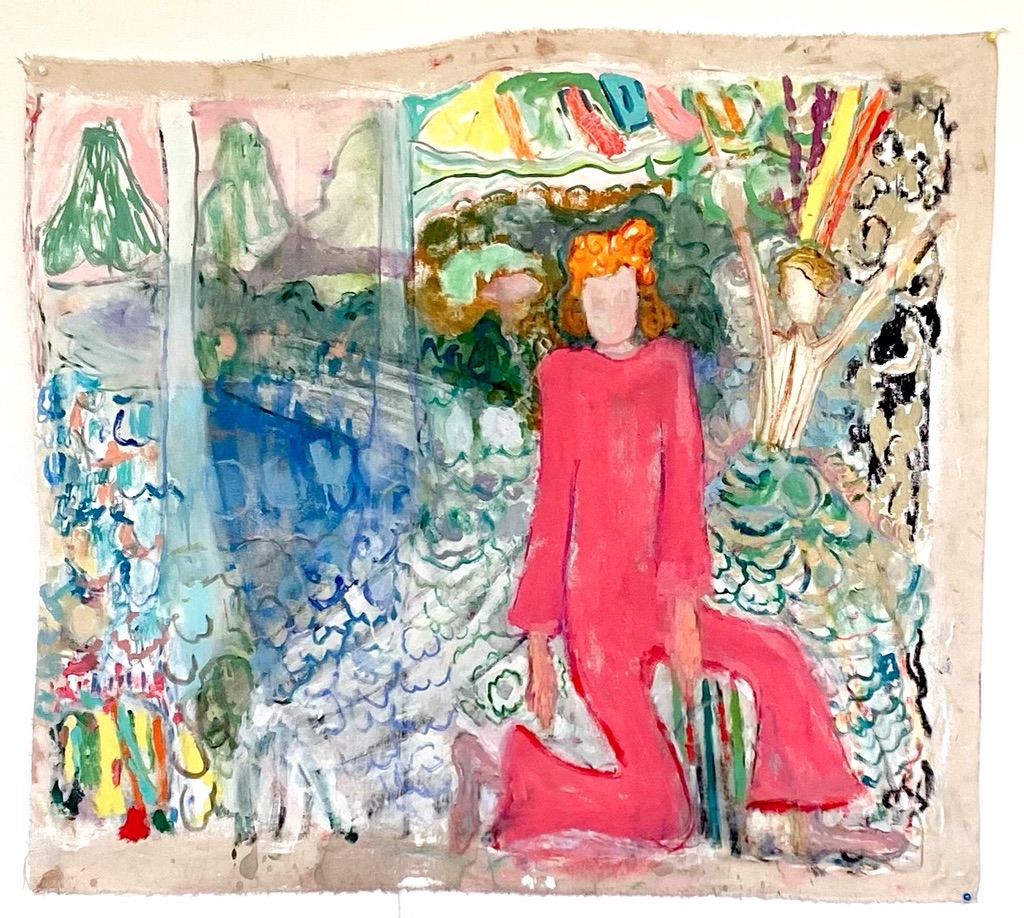
COMPANY
Christina Stead, Lorna Robertson, Lorna Sage
These days it is my books who keep me company, whose conversation diverts and absorbs me in the place of my friends. Not allowed to sit in a room with a friend, I sit with a book. I take up old familiars — pages that I enter like warmly remembered rooms. I choose the company I keep, these intimates, women who I have never met. Their voices are warm, sharp and witty, wry or sad, their intonations and rhythms of speech are precise — more distinctive and recognisable than the hazy idea I might or might not have of their appearance. I enjoy hearing them tell their stories, and tell them again.
I used to like giving parties, bringing together people that I knew who hadn’t met. It is a long time now since that has been possible, but I imagine doing it with the companions I keep now. I think of putting together painters and writers that I love, dead or alive, it doesn’t matter so much. I was thinking about Christina Stead, of her distinctive, overgrown, verbal landscapes. Her attention to colour and detail, the textures of clothings, the look and taste of food, plants, a heady world of plenty, a sort of cornucopia, but cut with loss and longing. I thought of my friend Lorna Robertson’s paintings, and how I should like to offer a painting of Lorna’s to Christina Stead. I would like to put them together.
I sent Lorna lines from her novel, For Love Alone, an inventorising chapter titled ‘She had —’ :
…six voile nightgowns for summer, … half a dozen handmade panties, three crêpe de Chine and three lawn with Madeira work and hem-stitched borders… six dozen handkerchiefs … in choice arty combinations, so to speak, of navy and leaf, lilac and rust, eau-de-Nile and salmon, chaminade and ibex, Mediterranean and coral, black and chromium….
I knew that she could mix those colours and place them side by side, just right.
And this passage on food from I’m Dying Laughing:
I started eating too much the week before, on the theory that I work better .. So I ate butter, sweet corn, potatoes, mashed with cream-butter-onions, cheese, baked like a cake, delicious, yum-yum, brie creamed with butter and spread on porterhouse. I read about it and that’s what started me off, then a glad, glorious, grand week with whipped cream on strawberry shortcake, cheese with pie and cream; Viennese coffee, flaky pastry with a secret wrinkle of drugstore downdown, nutbread, sherry flip — I thought, all right, this is my week.
Lorna can make paint fat and tactile, as close to a cream cake as you’d like, whipped cream on strawberry shortcake. She can make food or clothing compelling on the canvas as Stead does on the page, summoning the invisible plenty. You can enter in and let yourself be surrounded by this brightness of presences, objects whose colours and textures you might have forgotten about. There is something innocent about this provoking of pleasure, but not naive. The looking, as the reading, is strangely and insistently comforting. I think that they would appreciate each other.
I came across Stead in an essay by another Lorna, the writer Lorna Sage. She was astute to the radical nature of Stead’s vision; her refusal to see the artist as someone rarified or special. She wrote, “she doesn’t subscribe to the notion that art is something separate from living wants”, quoting Stead:
beyond was the real world…it was from the womb of time she was fighting her way and the first day lay before her….there was something on the citied plain for all of them, the thousands like thin famished fire….
The variety and plenty of the world, and the drive to share that overflow, to put it all in, not pare it down. Stead’s credo, as articulated by Sage, is “a vision of a new world where creative fulfilment belongs to the thousands”, to the many and not to the few. A world that teems with potential, inside and out. “When you come down to it, what she’s implying is that there’s plenty for everyone, a most subversive suggestion, then as now”.

April 6th to April 13th

March 30th to April 6th

Earlier I never paid attention to dreams, nor did they amount to much, usually hazy and full of wandering and sometimes colourful, but now (…) it’s part of me and I have come to inhabit my own dreams. The puzzle of my days is more important than the puzzle of my dreams, for you should understand that there’s no dream puzzle, but rather the puzzle itself, the puzzle of days, the undetectable chaos of reality that tries to articulate itself in a dream, which sometimes in a composition brilliantly reveals to you who you are.
Ingeborg Bachmann, The Book of Franza
Pandemic Dreams, Sixth Box: Shapeshifting
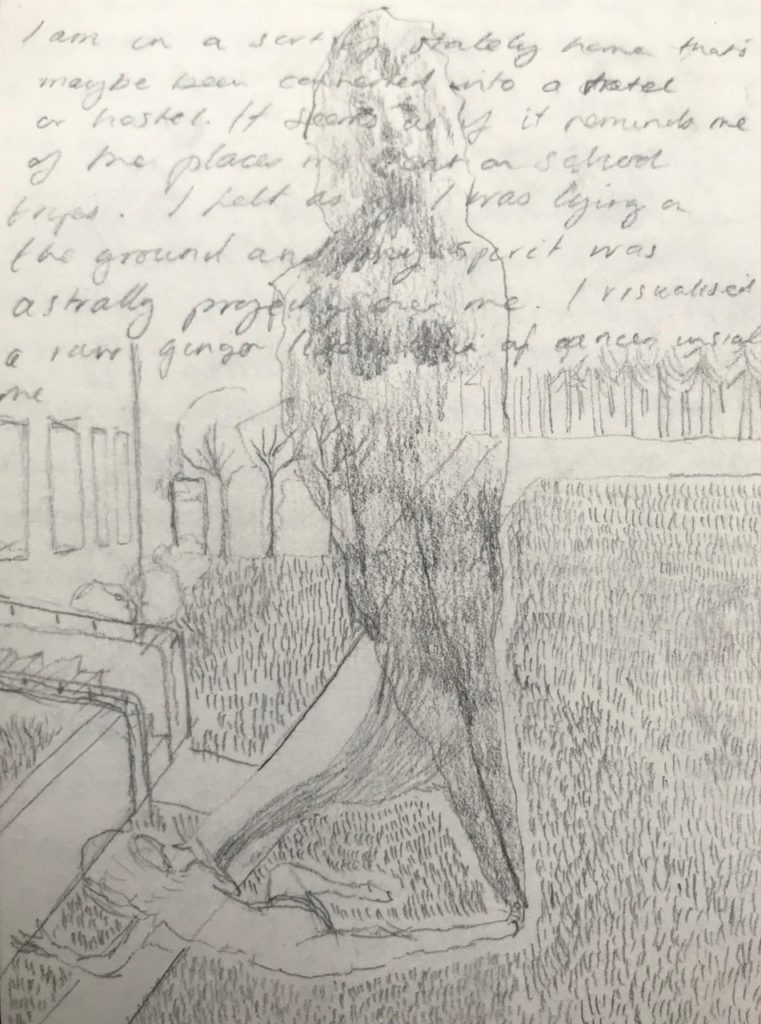
I’m in a building that looks like a stately home that’s been made into a hotel or hostel. It reminds me of a place I went on a school trip. I felt as if I was suddenly lying on the ground at the bottom of some steps and my spirit was astrally projecting over me. I’m aware of a dark, dense forest behind the hotel.
*
It’s dusk, warm out, and I am with three companions in a car parked at the entrance to a busy London restaurant. Outside there is constant noise and movement with people coming and going, disco lights, music and conversation, smoke. I am aware of being a man, or appearing to be male. I am not comfortable in my skin. A woman walks past dressed all in black. I want her attention. I follow her into the building but she is lost among the people.
I meet her again as she leaves and my companion persuades her to join us in his car. When she does, he starts the engine. I’d rather we were alone, me and this woman. She is sat in the seat directly behind me, so I’d have to crane my neck around if I wanted to talk to her. The one driving the car speeds up. He is driving dangerously, the car is out of control. I’m frightened, embarrassed, panicking. The car screeches to a halt at midday in a beautiful landscaped park looking out over a Mediterranean city. The woman gets out of the car, slams the door and leaves.
**

I was at my aunt’s horse riding school. My aunt and my uncle run this horse riding school on top of a windy Portuguese hill. I usually watch New Year’s fireworks from the top of that hill. I was leaving, walking on the chalky white bricks, passing through the iron gate. A class was happening, there were people riding horses inside the main rectangular arena, and my cousin was leading the class. He was shouting directions. Inside the arena the colours were brown, dark, in the shadows. Outside there was a grey light. I was walking through the grey light, but there were greens, from the bushes and the trees. I saw people passing by. Then down the hill an old car drives past me. I look at the driver’s seat through the car’s window, which is rolled down. Cristiano Ronaldo looks at me from the car, with a smile. I’m not that keen on football, so the appearance surprises me, now, but in my dream it was very natural to see him there. I don’t know if I waved. He passed by. Maybe we shared some words, I don’t remember. Then I saw haystacks in a big warehouse, and my scenario changed.
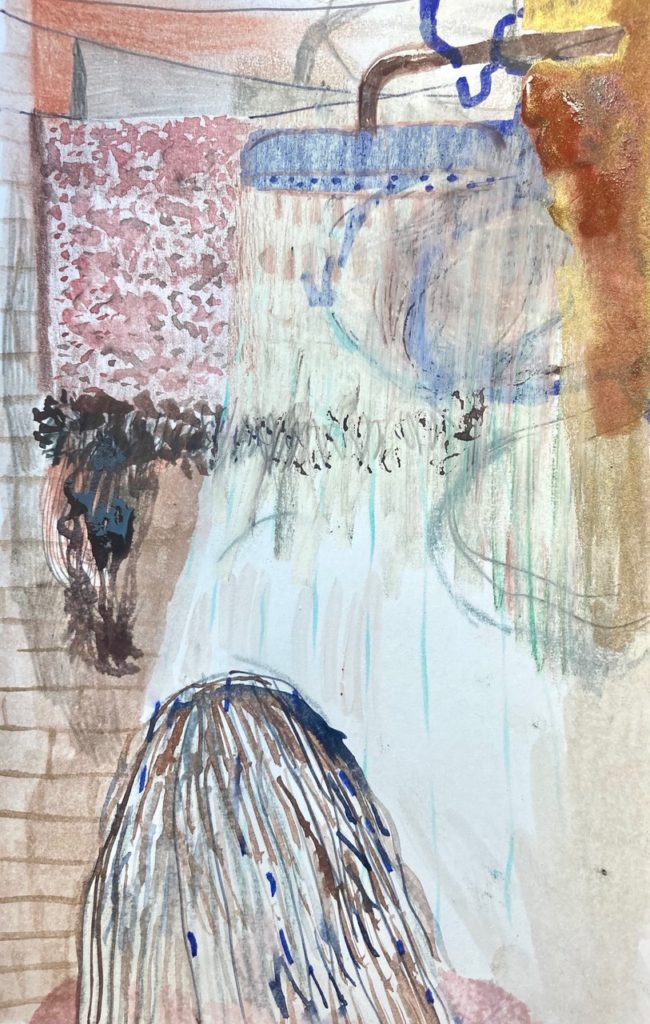
I was in a brownish mansion, old. The walls were brown, the floor was brown, there was a yellow light. Things looked mustardy. I took a shower and looked up. Above me there were dry towels hanging. I started worrying about getting them wet. One of them caught my attention. It had a fur lining. A bath towel with a black fur lining, and then on the right side it had a bit of human hair, like a wig. I thought I knew who that belonged to. A woman I had seen in my dream with beautiful black hair. I thought the towel had that hair prop to make her hair look even longer. Remembering this I feel that my dream was very silly. I have no explanation for it, especially for Cristiano Ronaldo.
My dreams have been very brown lately.
***
I dreamed that all things were made up of 317 parts and that that was the nature of matter.
*
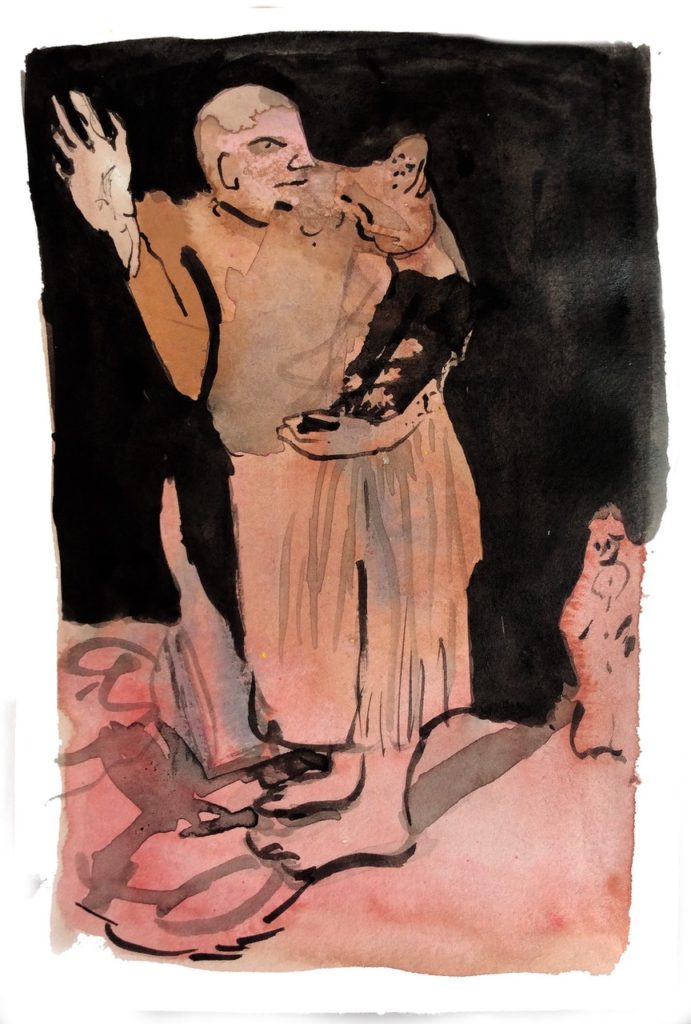
*
The Professor tipped the creature on to the table. It was oval and soft, a consistency somewhere between a jellyfish and a loaf of unbaked but proofed bread. It was about the size of my palm and yellowish, custardy. The Professor poked his finger into it and it opened suddenly, gently, responding to his touch, the inside changing colours like a kaleidoscope, as it skittered across the table. The insides were viny, with tiny tendrils or tentacles shimmering translucent reds and yellows, a little like a sea anemone. It was silent but pulsing. When I tried to touch it the thing seemed irritated like a cat that doesn’t want to be stroked by a stranger. It slid back to the old man and he swung it up in front of his face where it stretched to the size of small baby or a kitten. They seemed almost to touch noses. Then he put it down gently again and it slid away. The next time I glanced the creature looked like a freshly baked loaf with deep cuts patterning the surface. He quickly gathered it up and we hurried off to the Opera House where he was going to sing and he had got seats for us in the stalls.
***
I am outside on the hill. I walk over the mud, through the gap in the hedge and into the broad open field, sloping down and away. I understand that I am a fox, and I completely belong here. I will be able to run all across the grass fast and light footed. Thrilled by this awareness I prepare to lunge forwards.
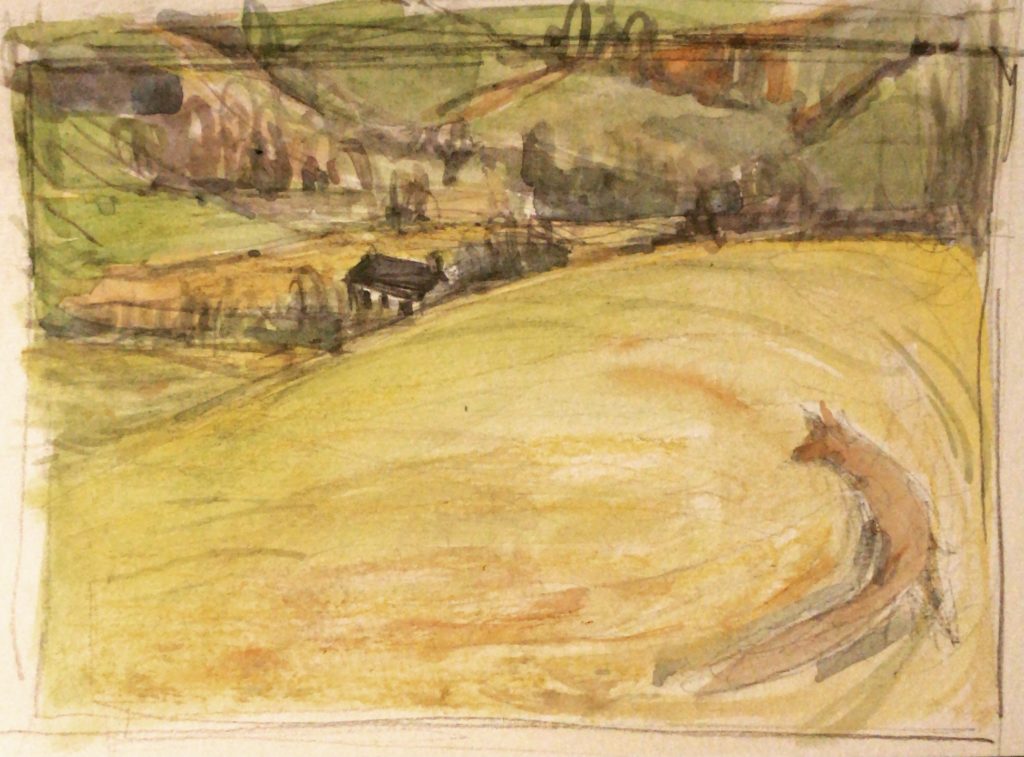
***
I dreamed that I was a squirrel, I was one of those rodent ones that I see daily flittering and bounding frivolously throughout Deptford Churchyard. They are the same ones that come to my windowsill each morning and night looking for me, for company or for food. I am their food source, I know really deep down that it can’t be true love.
The squirrels in this hazy dream squeezed through the small gap in the window, their muddy paws and claws staining the white paint like a winters bruise. A Hawthorn bush colour; a Hawthorn’s winter, that’s what folklore calls it when we experience a dangerously frosty and icy March. Outside it’s snowing fragile delicate flakes that make your skin prickle with the sensation of swollen goose bumps; chicken skin.
The squirrels are now inside toppling and turning, falling through the basement flat in a frenzy; a small whirlwind of matted colour. They stopped and calmed when they found the bed, my nest, and that is I guess when I felt myself changing.
Whirlwinds or gusts of wind have been spoken by the ancestors to be the fae disguised by a flurry of motion so that they can travel through the depths of night undisturbed hidden from human sight but for me this tornado was a bundle of grey tree squirrels, their coats and noses wet and muddy from the earths damp mud and rich soils. I smelt moss and rotten tree bark, it overwhelmed me but made me feel rooted to the earth and gave a sense of the familiar and of ancient histories gone by.

My arms and legs began transforming, metamorphosing with each pulse of painful growing pains beating the chords of my new tiny skeleton. The pain seared right through me making me cry. My skin ripped too then making way for new hair which sprouted like the bulbs of spring. Before long I was covered with dewy baby hairs and a moist dull grey coat of silver fur.
The fur itched and I prayed silently to myself that that wouldn’t be the fleas but the itch crawled inward, burying deep into me. The fleas traced the outlines of my new skin as if they were navigating themselves around an old map. Finally they rested into the white patch of fur on my stomach, where one of the squirrels pressed her nose into the crevasses of my armpits licking the imaginary lice from me, like a mother. She says in a small delicate voice that her name is Kate. Her whiskers tickle mine and it feels if I have had an electric shock. An undeniable connection.
They stayed, the four of them with me until their tails became still and less animated which means that they were now relaxed. I too was as we lay inside the folds and layers of clean sheets, bedding down as if to hibernate, our tails overlapping, touching tentatively. “We fight in the day” Kate spoke again in a fast whisper so not to disturb the others “we fight over food but at night we stay close, and keep each other safe, it’s handy when we smell the stench of cats prowling.”
Warm imprints of fur pressed against mine sending me into a deeper sleep — one where I dreamed of peanut butter and acorns. When I awoke I stretched out my fingers and I noticed now that they weren’t long talons just my usual small fingers, blue from the leftover residue of an oil bar.
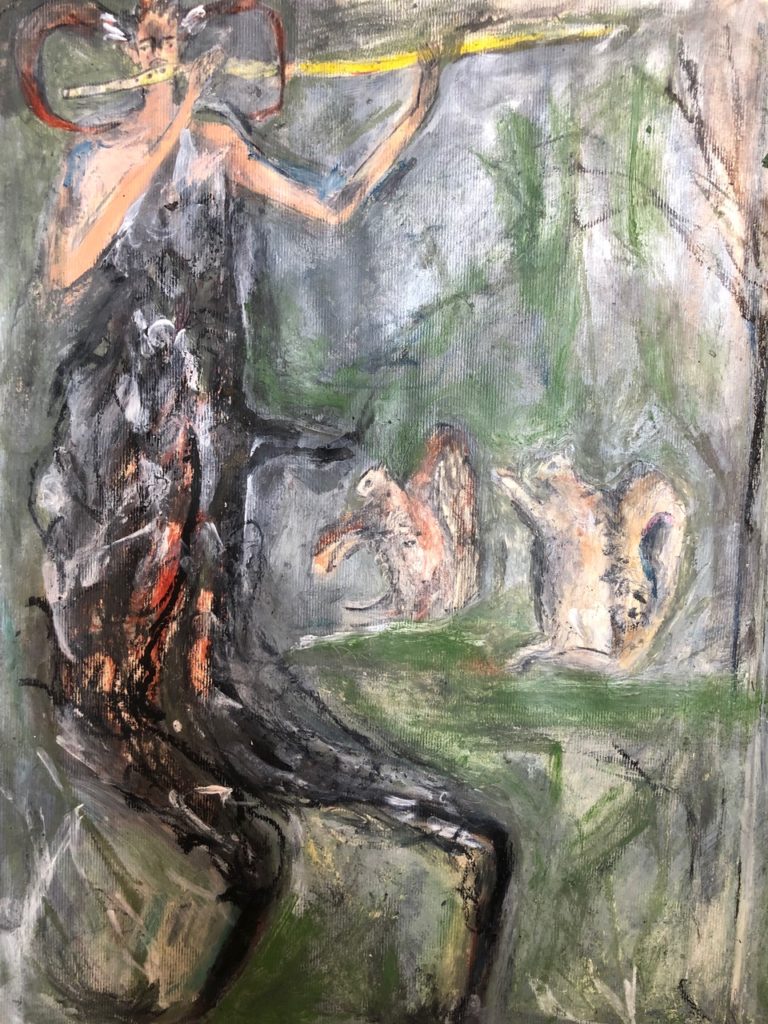
I walked to the window sill and looked out. The birds played their hypnotic pipes like Pan and I noticed a delicate white feather, an angel’s feather stuck to my window sill lying in a pool of icy snow flakes. Somehow my dreams of the squirrels had left me feeling touched, thanked and held — maybe it was a message from him. The Deptford man we used to see feeding the squirrels, he’s gone now, decided it was his time, but a memory or an angel of him still walks outside, lingering like a shadow in those streets.
With thanks to Joana Galego, Melissa Kime, Ruth Maclennan, Rosie Wellesley, Becky Brewis, Zoe Savory and Emma Duggan for their dreams, and to Eleanor Bedlow, Tess Glen, Emma Duggan, Joana Galego, Rosie Wellesley and Melissa Kime for their dream images
March 23rd to March 30th
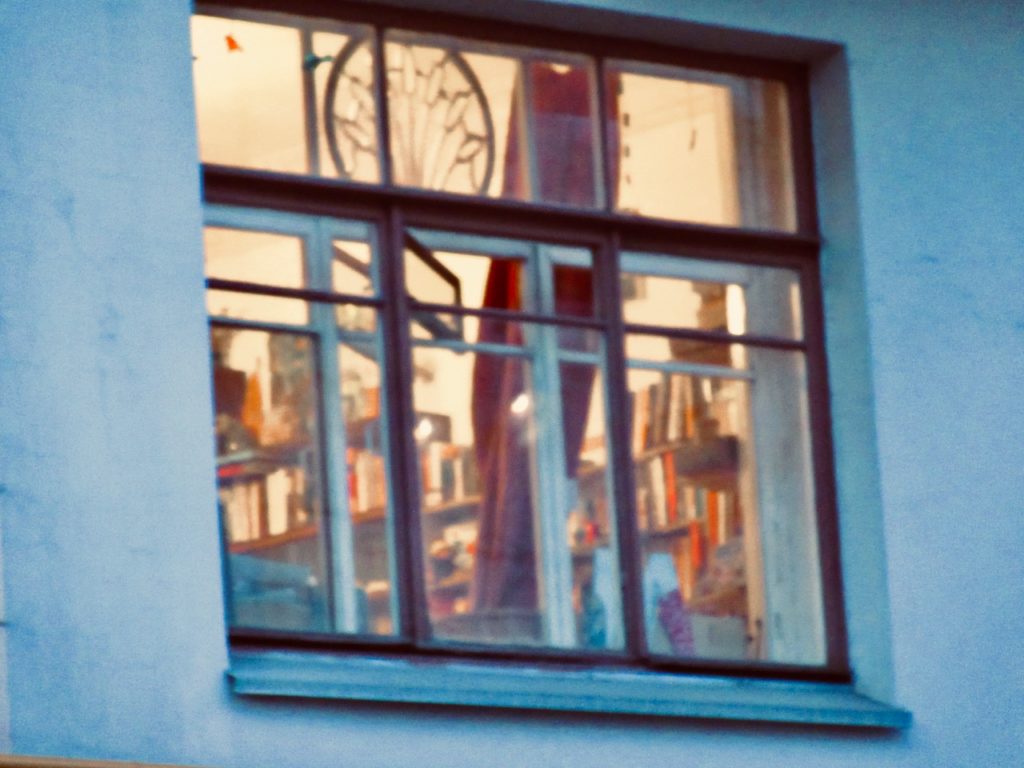
Dreams tantalise not only with half-recognised rooms, or the train that we never quite manage to catch, but with the promise that they might disclose something — an insight or an answer even, that has been withheld by the dispersal of the everyday. We pursue our dreams in the hope that they might lead somewhere — or that we might put together the torn pieces salvaged from sleep and achieve a composition — a patterning of the puzzle which satisfies and makes sense. We speculate over clues but a conclusion eludes us, sending us back to sleep, to hope and dream again —teasing out these sleeping provocations that are a continual deferral and a persistent promise.
Pandemic Dreams, Fifth Box: Journeys
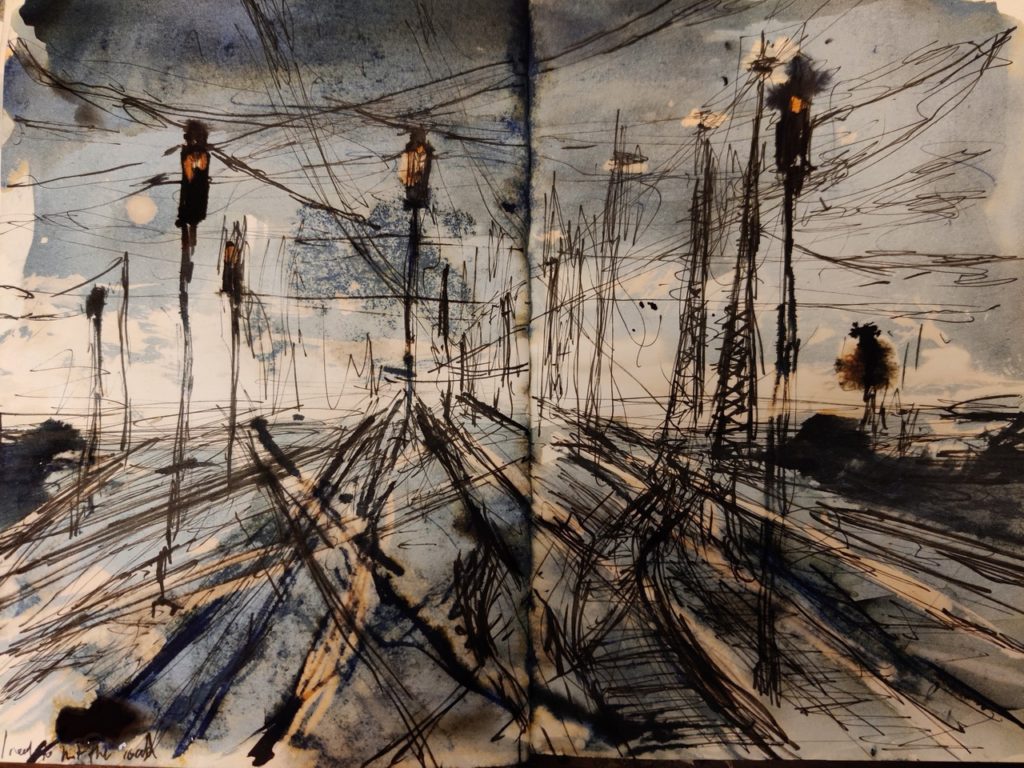
**
I’m on a train travelling north. We stop at a tiny station and I’m trying to collect my things, so many bags, and before I can the train is moving again. From the window I can see a small dot of red in the hills, the hostel at Loch Ossian, visible even though it’s not. The train carries on and then we stop again, and again I can’t find what I need in time to get off.
***
I had to find a code to leave the place I was in. I had a journey to make — a train that I needed to catch as soon as possible. I had been handed a note saying I needed to meet at a certain time. There were people in this building giving tutorials to help with time management. The place was being held by nuns, and there was this complex interior. A woman who was helping me found the letter with the code that would help us get out of this place, but she trod in paint and left this trail behind her. The ground behind her was laden with her trail and she didn’t know. The nuns were starting to follow the trail, they were going to find us. Then I woke up.
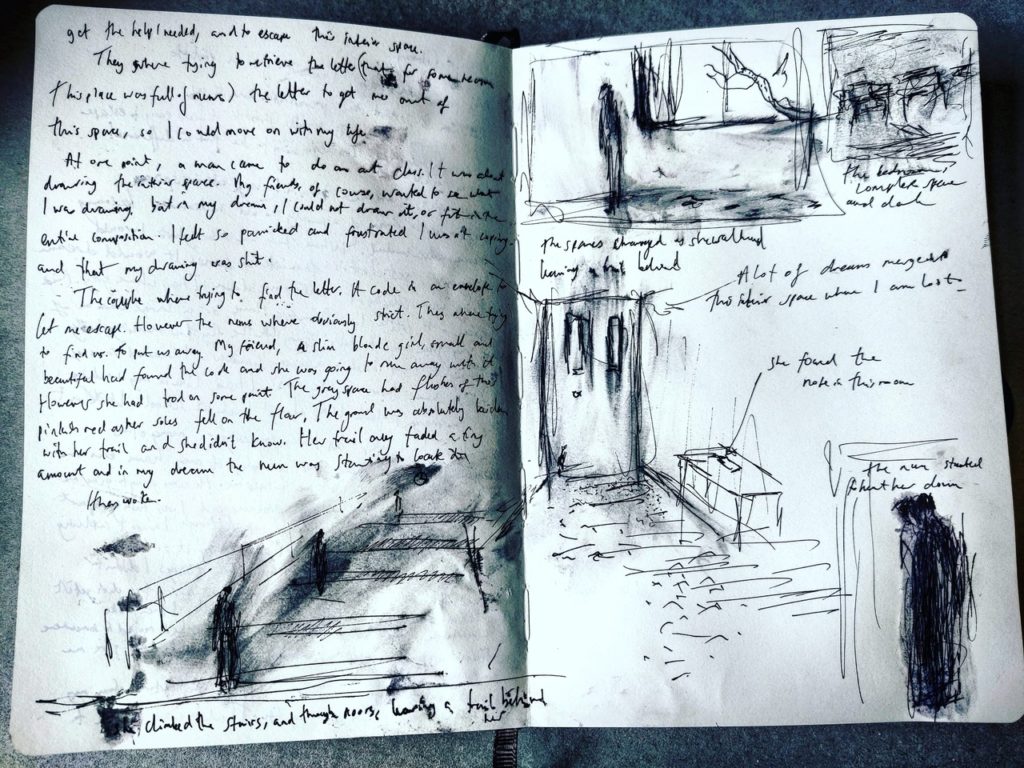
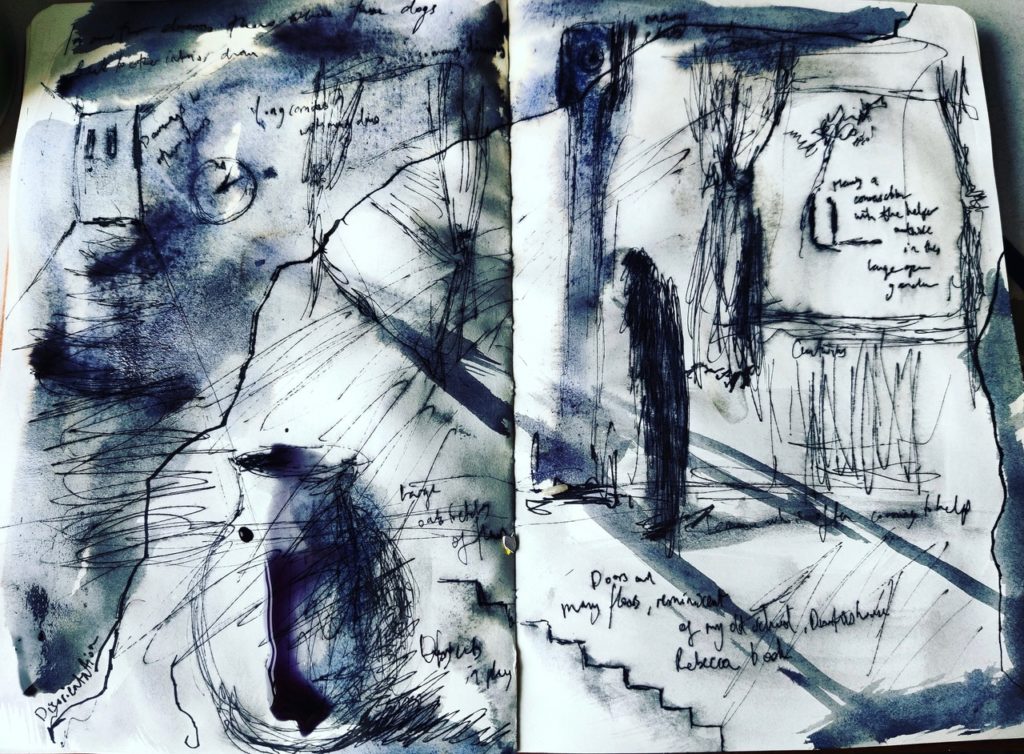
**
A recurring dream of a train that I must catch. I know exactly when it leaves and I arrive at the station with plenty of time to spare — yet always at the last moment something slows me right down, my body itself slows down so that I cannot hurry it, or I am obstructed as I approach the platform and always, having had so much time in hand, the doors are suddenly shut, the minute on the clock turns over, the whistle is blown, and the train is slowly pulling out of the platform. The train is travelling south west to the place where we spent our childhood holidays, I can picture the long wooded tunnels that it will pass through along the coastline, but I am never inside the train. I want to catch this train but I never can, and I can’t seem to get around the thing that interrupts me.
***

I keep having dreams about being on trains, with disruption of lines. I am always caught between two places and I end up staying in some uncertain place between them where kind people usually put me up and allow me to stay. Someone often comes to help me, either a ticket person or some sort of lodger. It is a recurrent dream I have and often in them I do not have the right money or ticket to get to my destination. I am sitting in the carriage riddled with anxiety.. Often I am on my way to a place but have to turn back because I have gone wrong. I often have not remembered the root (sic) correctly and someone is telling me I have gone wrong.
**
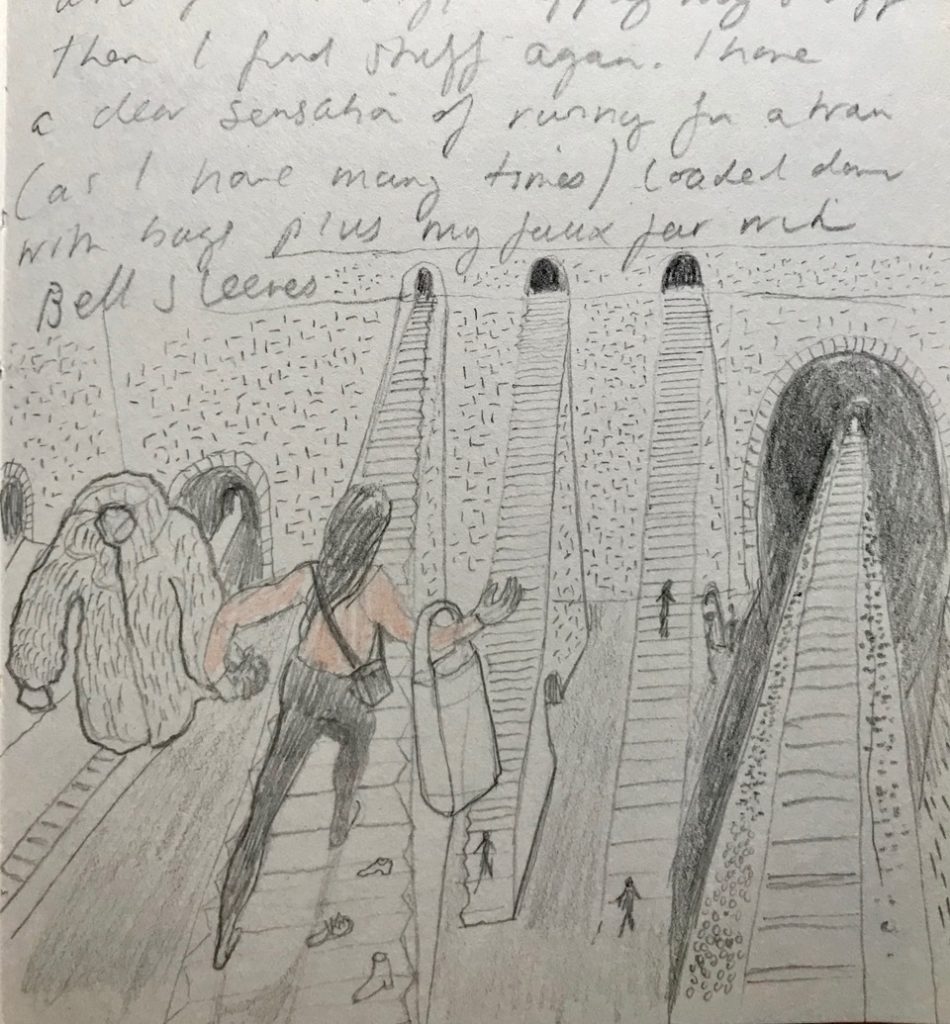
A repetitive dream I have: train stations. This one seems to be a hybrid of Clapham Junction and Brighton, not a real one I have been to. There are lots of long flights of cement stairs, criss crossing each other, tunnels and the tracks cut through some of the land surrounding it. There’s a sense of a land with steep gradients surrounding it like Brighton (though I can’t see) but with all the stairs and escalators, platforms of Clapham. The scale feels totally overwhelming, and the design impossible; the grey summer air stifling and I am rushing, dropping things as I run up the huge staircases. I have my faux fur coat with bell sleeves which is far too hot for this time of year.
***
I’m on a coach, hurtling south from Scotland. There is a sense of urgency, some sort of emergency and we are on the last coach out of the country, it is piled full with people. I am with the father of my children, but our children are not with us. Suddenly the coach has stopped and everyone has got off it. We are the last ones left and I realise that in our rush to leave we have taken no bags, we have no clothes or money or tickets, even though we know that everyone was rushing to make an onward connection, before it is too late. We are completely unprepared. We put on some clothes that have been left behind on the bus. Some I recognise as my own and some are small and belonged to my children. They are all grey and rough from years of washing, like worn out charity shop clothes, but we take them as we have nothing else. The coach driver has come to the back of the bus and is helping the father of my children dress, he gives him a raincoat. I wonder how everyone got off the bus so fast. We haven’t agreed on a plan but somehow we will contrive to get across the water before the European borders close. We know that we must keep going at any cost.
***
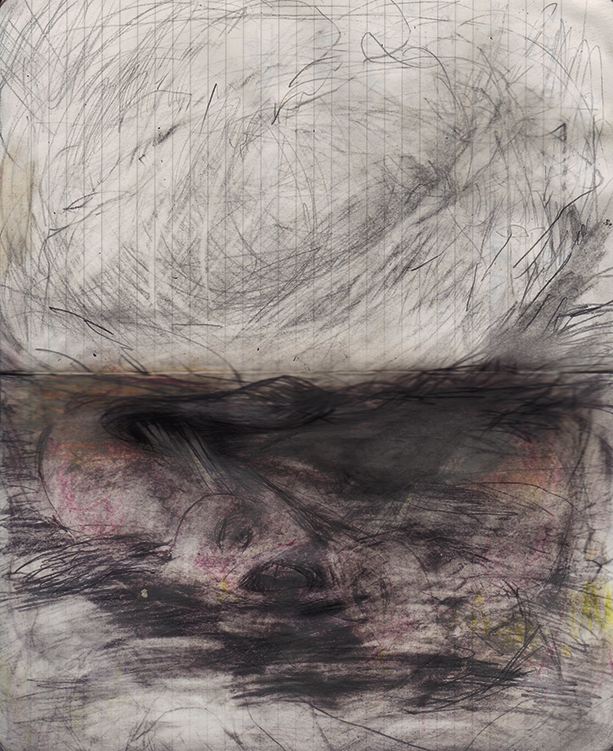
We are crossing the East German border. There is a great expanse of sky. A concrete intersection rises up and bends around reservoirs of industry where giant inflatable fish placidly float. These pink and orange forms hum against the surrounding grey. As we dive our bodies feel every bump in the uneven road surface – the rhythmic thud of a well-travelled road. I look to you but it is now Marta who is driving, her breasts pressed up against the steering wheel of an old bus – she is driving so closely to the back of a truck that it has become all we can see.
We are now in a tunnel and you are driving again, but the road has become impossible – large portions of pavement rise at uneven angles out of the ground as though there has been an earth quake. We are together as a family now. Lining the tunnel, identical men in long robes work at lifting up giant slabs of the road in uniformed timing. We get out and follow one down through a dimly lit doorway.
**
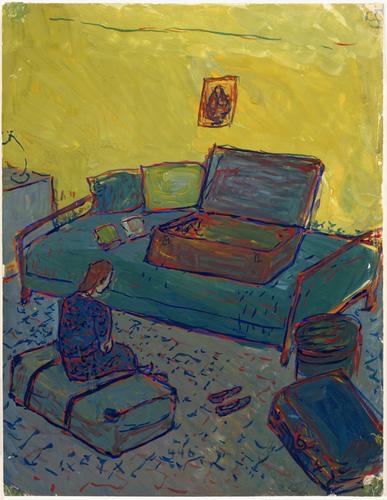
*
My family — me my parents and my sister are in a truck driving into some streets, nice streets, somewhere like Brighton. We dropped my dad off first, to check a house, and my sister parks and we get out to join my dad. My sister piles some stuff, like recycling, next to the truck. As we are walking off uphill I realise that although it seems sensible to leave the stuff on the street, some people may not understand and may steal it, and it’s not all rubbish. I run back to try and put some of the stuff back in the car. I can already see a few people looking interested in the stuff. I get there and there are two old stuffed bears. There are also boxes and a couple of things I want to put back. By now I’m rushing because they don’t know where I am. I leave to catch them up in the house or hotel. I see them coming towards me as I am coming through the doors. My mother looks angry but I can see that she is also crying. There are tears in her eyes. She understandably thought I was dead.
***
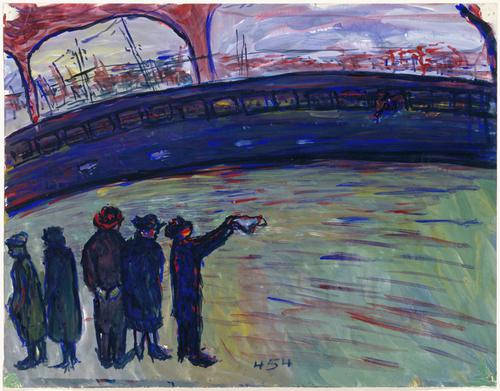
***
I have my suitcase packed in the back of my car, a red one. I hear a baby tiger crying out from the suitcase, I open it up to find him, he is surrounded by packets of biscuits, I have no idea how he got there.
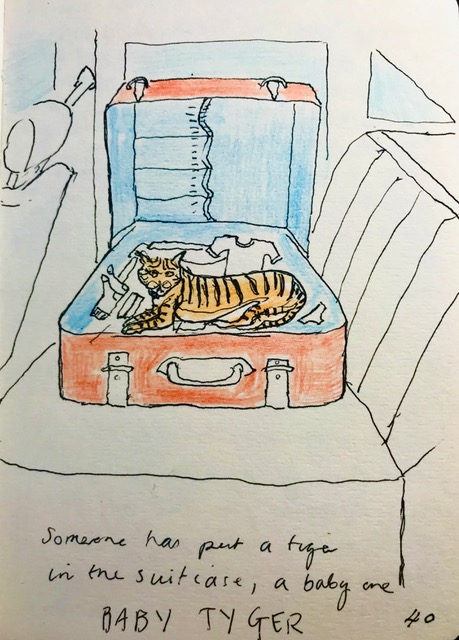
Thanks to Claudia Lapping, Izzy Morris, Jasmine Pajdak, Emma Duggan and Iona Roberts for their dreams and to Iona Roberts, Emma Duggan and Jasmine Pajdak for their dream drawings
March 16th to March 23rd
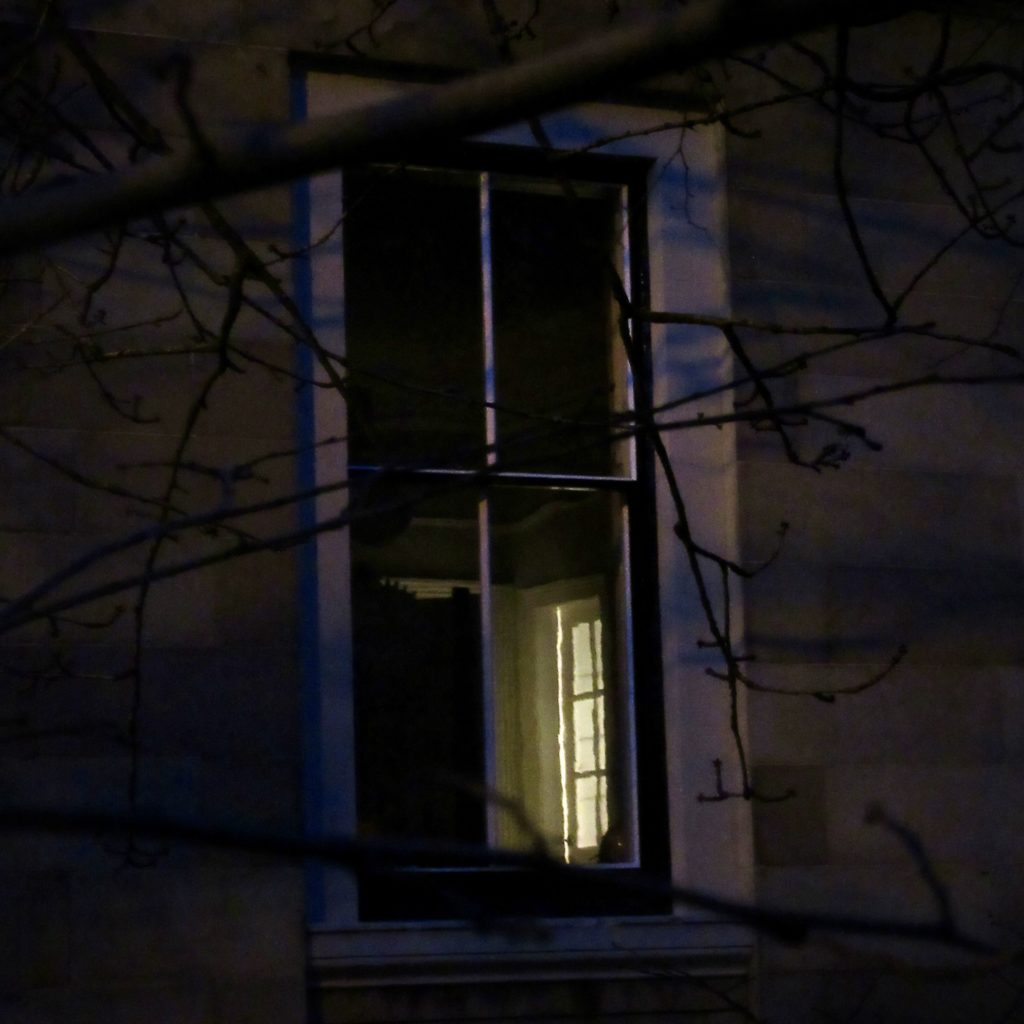
Entering a dream is rather like slipping through a window. (..) Occasionally I may capture a passing image, hoping to transform it into a dream event and thereby steal a glance into the order of that intriguing world, but such images and hypnagogic phenomena only herald the darkness essential to sleep and the dream.
We dream ourself into being (… )We do not think about it while doing it. We are just inside something— our dream work— that is itself a pleasure (…) there is true joy in finding an object that bears its experience which we find transformational, as it metamorphoses a latent deep structure into a surface expression.
Christopher Bollas, Being a Character, 1992
Pandemic Dreams, Fourth Box: Water
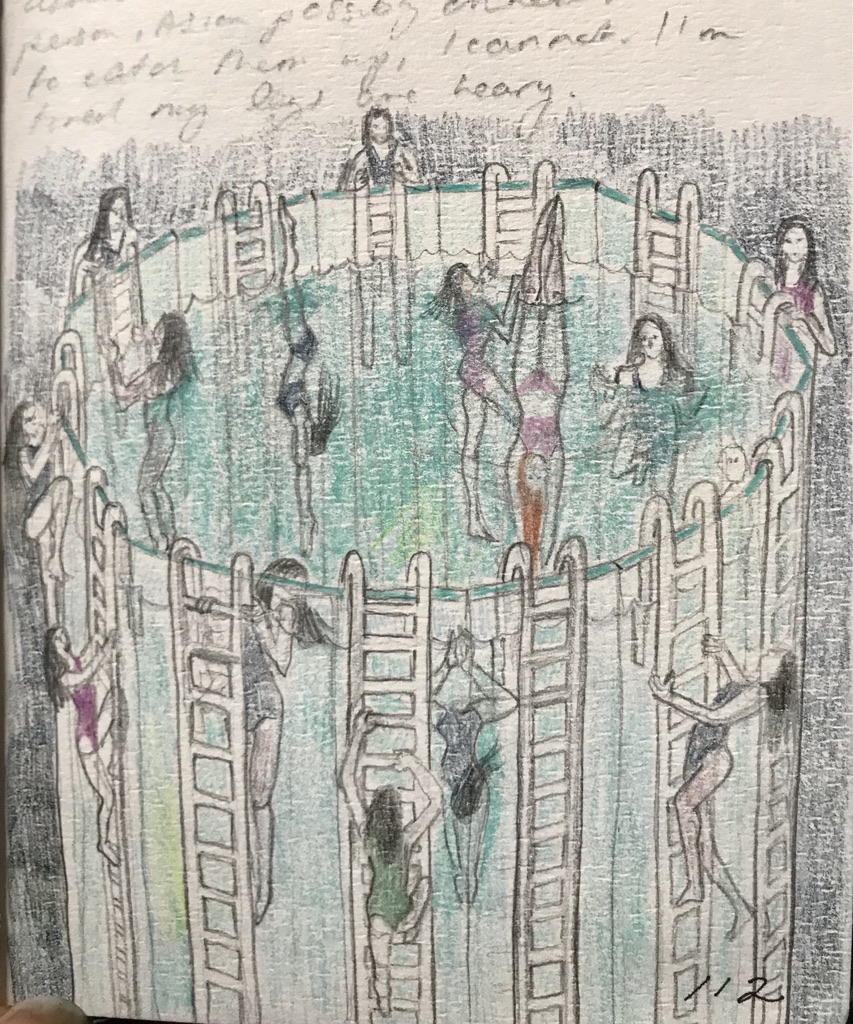
I’m on an assault course and I feel out of place and wonder what I am doing there. We run through rain and mud then dive into a pool that runs into a river. There is a wave carrying children and ducks who also become daffodils. Then I find myself in a huge high ceilinged room, with about fifty or so other women. This room feels like a film set with matt painted blackout walls; in the middle is a large glass tank with ladders all round its faceted sides and myself and the others all climb these ladders. There is a red haired woman who does a perfect swan dive into the tank and swims deep down to the bottom of the tank. The rest of us get in slowly, shivering and shaking as the water is icy. We swim to the bottom without needing air somehow, although I can’t believe it. At the end we are given ginger to drink. I ask for mine with soda and the woman giving out drinks says: “They all come with soda dear!” like I should’ve known.
**
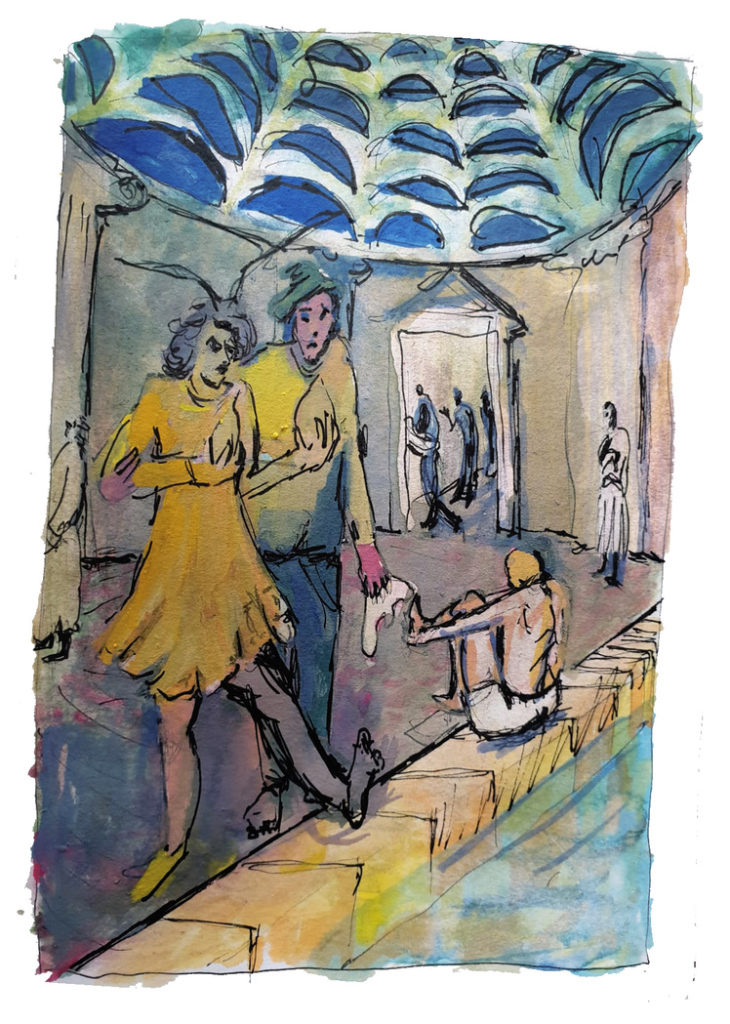
*
I was with a friend of a friend, L, who I met for the first time recently. We were house sitting together in someone’s family home and we were in their living room. There was a tap in the corner of the living room, the kind you find outside connected to a hose. My friend turned the tap on and water was running out onto the carpet. She said: let’s turn the living room into a swimming pool and go for a swim! She pointed out water marks about waist high on the walls as evidence that the family probably did this all the time.
***

***
It was evening and there was a girl’s body floating in a pond, on her front but with her head on one side like she was sleeping. There was a boy in the pond too, swimming around and chattering away to her. My mum and I were hidden behind a curtain and she told me to keep watch and see if the girl remained once the boy had tired himself out and gone to sleep. It was my mum’s hunch that the girl had in fact died some time ago and only existed in the boy’s mind. It was alarming that we could see her too, and it probably meant the boy was mad.
*
A slightly older woman and I were walking on snow and ice, like in the Arctic, when we saw below us a figure frozen in the solid sea, a few feet below the surface. The sea ice was perfectly clear and you could see that the girl, who looked like me as a little girl, was frozen mid breaststroke, like she had been paused. I hesitated but the other woman ran onto the ice to dig her out quickly with a metal spade, which I was worried would damage the girl. In fact, the ice turned to water after a bit of digging and we pulled the body out. Astonishingly, the girl spluttered and came back to life.
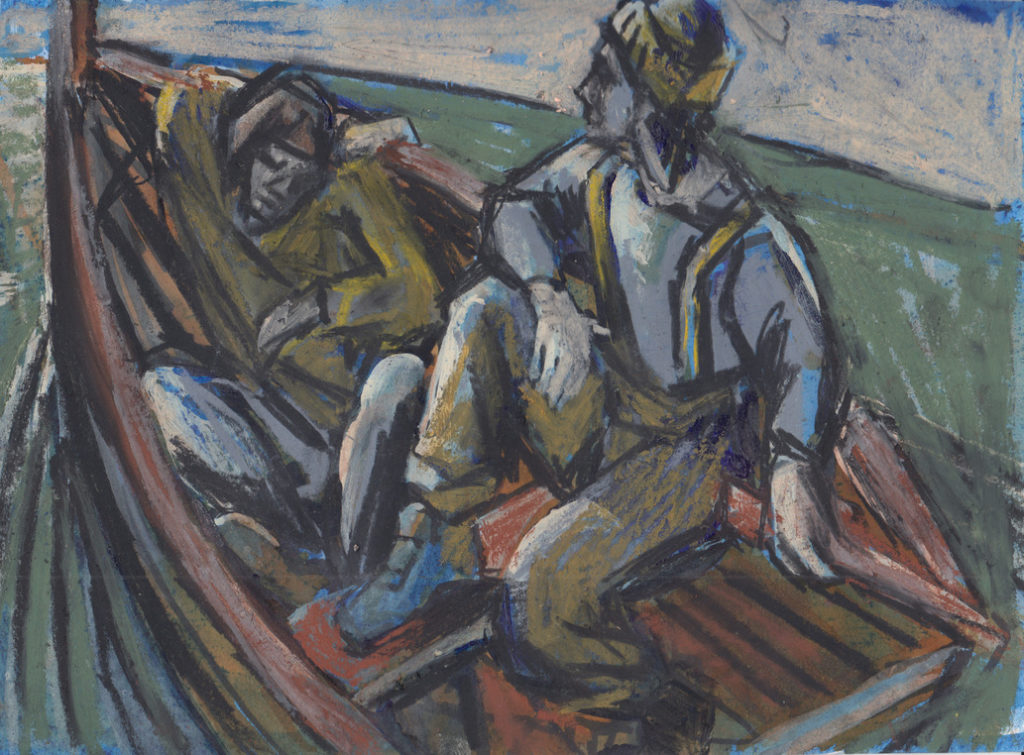
I dreamed that my father and my brother were asleep inside a boat; the boat was filling up with water, it had almost submerged them… At a certain fullness I knew that the boat would break its moorings and burst off, downstream at high speed, like a cork loosed from a bottle. And so I woke them up, just as the shelf of water was about to close over them.
*
There is an ice sea that I come back to repeatedly in my dreams. An archipelago of islands in a sea of ice shards. In this dream my family have all gone ashore and I am alone, rowing a boat back to the island in the evening sun. I am confident, having set them ashore. I pull and dip the oars with precision, easing myself fluently over the surface; looking out to the mountains rising up at the sea’s edge, covered in thick snow and lit orange by the setting sun. Except that the boat I am pulling proves not to be a boat at all, but a flimsy strip of plywood, a veneer flake that is now buckling and sinking beneath the surface. The rowing I am doing serves merely to keep me treading water, to keep me from going under. I am suspended, half sunk and rowing under the water. I am up to my neck.

***
I was standing on a platform in a London station. Floodwater was rising around me — not yet as high as the platform, but London was in danger and devastating floods were predicted. I was scared of becoming trapped and I was scared of dying. There weren’t many other people around on the platform, but there was someone standing quite close to me, wearing a raincoat. This person approached me and said to me, kindly but authoritatively, « You do know you can fly, don’t you?”. I was scared and remonstrated « No, no, no I can’t fly, I really can’t ». « Just try it », said the person in the raincoat, calmly, « Just jump off the platform and you’ll find you can fly. Look — watch! » The person in the raincoat jumped into the air and suddenly there they were, flying above me. The water was rising, my panic was rising, and I was now alone. So I tried it — I jumped into the air, and suddenly I was flying too. It became clear to me that the person in the raincoat was an angel, and now I had become an angel too. I understood that I had just died — but the angel in the raincoat had saved me from the pain and panic and horror of death — by taking a leap of faith I had crossed easily and painlessly to the other idea. I had had no need to be frightened. Pain was over and everything was OK.
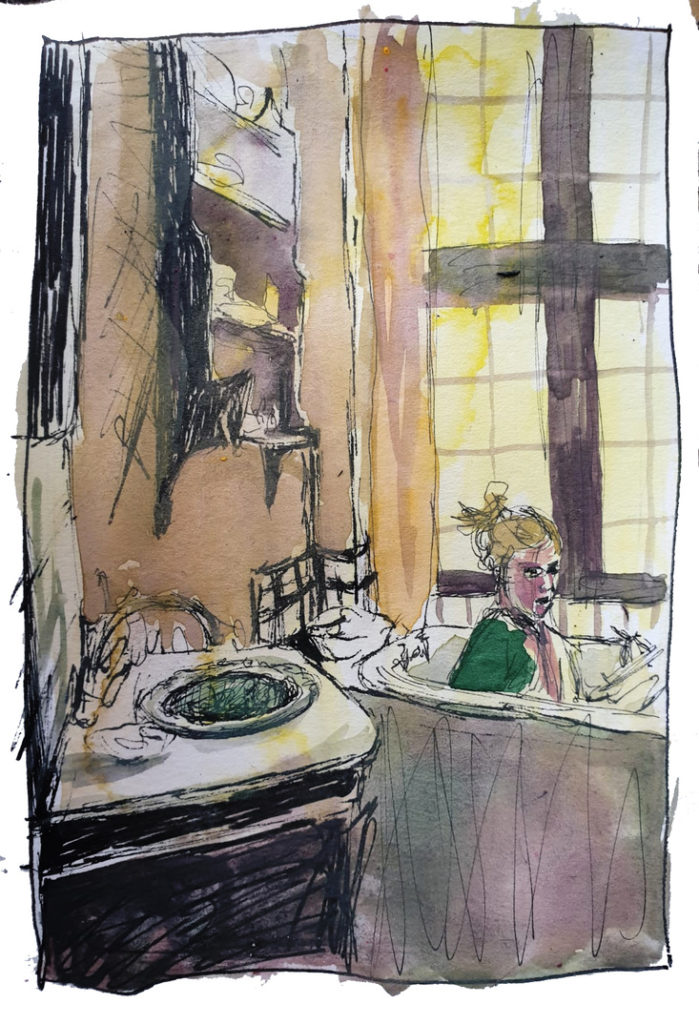
With thanks to Zoe Savory, Emma Duggan, Becky Brewis and Stephanie Byrne for their dreams and to Emma Duggan, Tess Glen and Rachel Mercer for their dream drawings.
March 9th to March 16th
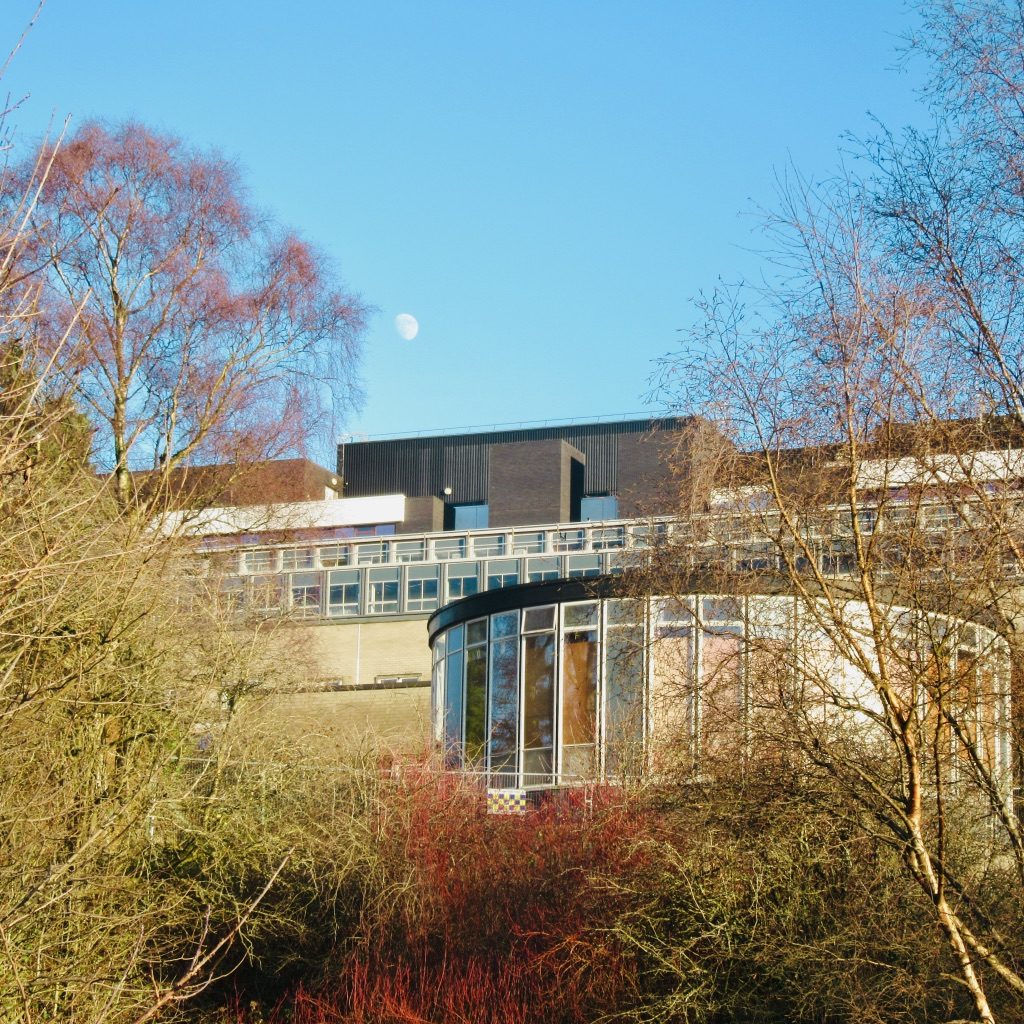
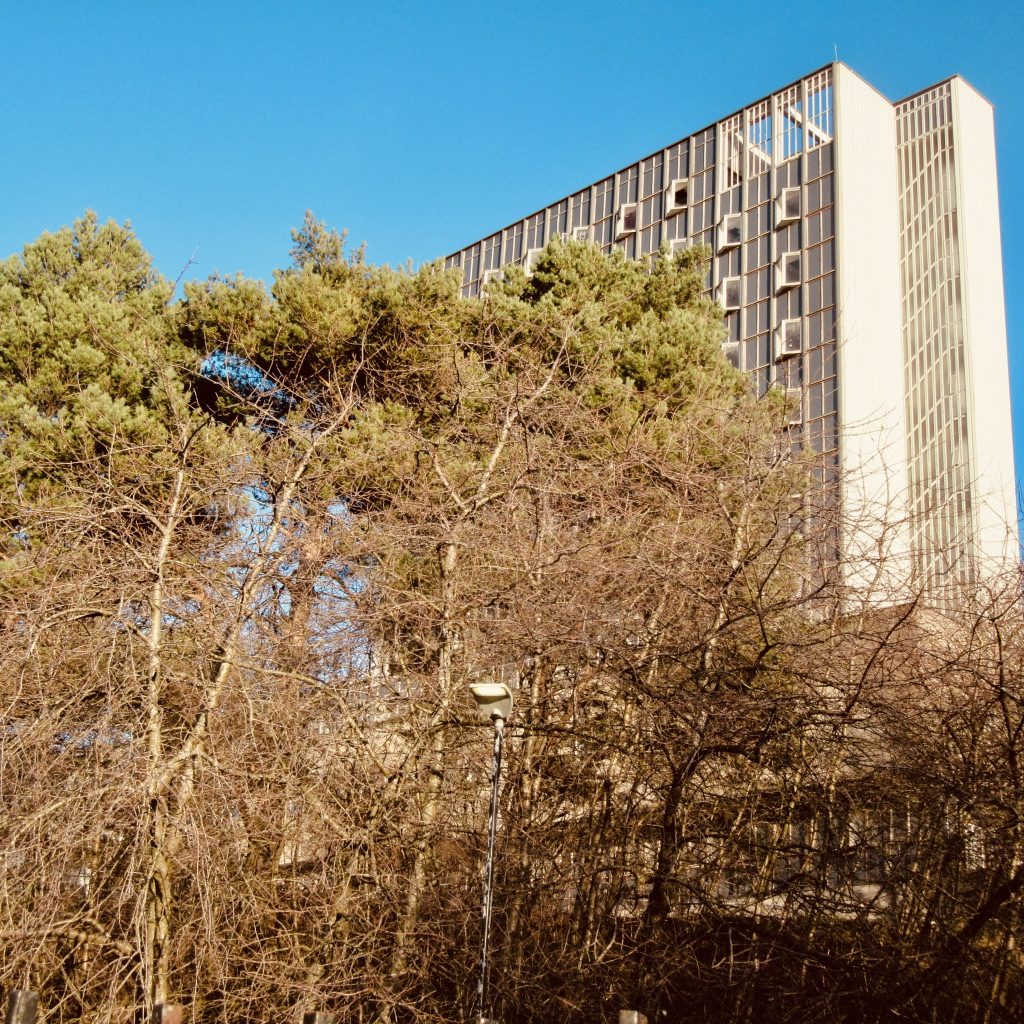
Letter from Glasgow: Birthing Room
In the early 2000s I spent many nights here. I sat on hard plastic chairs inside a chamber of thin drawn curtains, keeping watch over women I had never met before as they laboured long hours alone. Often I would arrive when they were already advanced in labour, so we would barely speak — but I knew that I must speak for them.
I was working as an interpreter, Russian and French, for asylum seekers who were being sent each week in coach loads to be settled in this city under the new Government dispersal scheme, pending the processing of their claims. The women were from Congo, Rwanda, from Ivory Coast and Algeria, from Chechnya and from Georgia. Almost always they were giving birth alone.
The vocabulary I needed was less complicated than for my day time assignments with immigration lawyers, or at the GP. Never much more than push!.., or breathe…, or epidural. But I prepared all the same. In my notebook I drew an elegant womb shape, a long necked balloon, and I annotated it with arrows indicating more complex anatomy and names in three languages: the col de utérus, or sheika matki, the endometrium, perineum, vaginal canal. I researched possible complications of labour and wrote down more words, for ovarian cyst, uterine adhesions, dystocia, perineal rupture, haemorrhage, just in case.
I was usually summoned by a telephone call from Social Work Standby, once labour was established, often in the middle of the night. I would jump up, immediately awake, get dressed, unlock my bicycle and cycle down the hill. The nurses at this hospital were keen on sedation, it made life more simple, particularly with the language difference, and as you can imagine there was not much scope for birth plans in these cases. I sat and watched as sudden swathes of electronic contractions surged on the monitor, barely stirring the woman by my side from her profound unconsciousness. The nurses gossiped in the corridor and played the radio loud. No chance of the women I was here for having any say in the music that they laboured to.
The first birth I witnessed I was standing at the foot of the bed, looking up between the woman’s legs. I watched in dread as the head emerged, a grey violet blue and frozen ball, rammed between the woman’s legs like a strange gargoyle — the midwife wrenched it free and it un-puckered into rubbery violent life. But in those few seconds I was aware how intently the woman, a young woman from Algeria, had been watching my face, which must have betrayed my fear, for I was convinced that the baby was being born dead.
I soon became used to the rhythms of birth, and watched, ever amazed at the moment when one body discharged another. I remembered old texts about people being born, “leaping” from the womb, and it did feel like a leap, a somersault, turning everything upside down. The waiting though was long. I kept up a breezy front with the midwifes who always wanted to know if I had my own children. I learnt how to deflect their questions. I resisted the invasive sentiment of the love ballads they played on their radios at four am. I kept my feelings down. Some of the birthing rooms had windows facing West on to the Clyde — a grand view of this wide river, stretching out to the sea. Waiting, I would look out at the “Tall Ship”, an old Clyde built cargo ship, its three masts emerging pale and distinct in the distance at dawn, framed by the bluish window edge of the darkened room.
After, I would have my time sheet signed, leave and push my bicycle up the hill home in a daze — sit out on the steps behind the building where I lived, turning the moments over, coming back to the day time and my lone life after the nocturnal dramas and wondering if I would ever give birth myself. When I did, about seven years later, it was not at this Hospital but the one the other side of the Clyde. I crossed the river by the underground tunnel in a taxi, trying to hold my breath against the contractions.
The first birth took place at the Queen Mother’s Maternity Hospital on January 12th 1964, a day after it opened. It closed its doors on January 12th 2010, on its forty sixth birthday. Forty six, the age that most women are done with child bearing, imagined, feared or desired. I am four years and nine months younger than the hospital, and I gave birth to my last child the year before it was closed. I noticed that we were almost contemporaries, and that like a woman, the hospital was retired from birthing duty in her mid forties. The room where I gave birth on the other side of the river was closed down around the same time, demolished and replaced by a vast edifice in a citywide amalgamation of Maternity provision.
This January, looking for a new place to walk inside the city boundaries, I headed towards the river, and found a path leading around the old hospital. The tall building with the birthing rooms stands, still empty, on the hill, catching the light. There is a thumbnail of a moon, almost full in the sky and I remembered that on a full moon there was usually a rush of births. I could be called out several times, back and forth to the hospital for one labour after another. I think of those nights, the corridors and continual doors behind which women were labouring, birthing, night after night. I look up and picture those familiar rooms inside, now empty, unpeopled, but filled with light.
March 2nd to March 9th

Letter from Glasgow: Exercised
It is almost spring, and nearly a year’s full circle from our first confinement. Each morning I pull up the blinds and check the windows across the street: three bay windows in the ground floor rooms of the flats opposite. This morning they were all inhabited by their familiars and the sight of each in their place reassured me: the couple in the corner flat — new baby under arm, born just before Christmas — are settling on to the sofa. Next to them the student painter, resuming her place at the desk in the window, her paintings on easels at each side and against the wall behind her. She pulls back her curtain and sits down at the desk just before eight each morning, signalling the start of the day for us all. She sets the pace. In the third window, another student sits framed in profile, her desk set against the wall. She is more distractible than her neighbour and often looks up to our window and waves, although I have never seen her on the street. Sometimes she works all day from her bed, knees up, hat on, covers heaped up around her, like Spitzweg’s Poor Poet.
The last bay window keeps the curtains closed until later in the day. Later, a woman in her dressing gown stands looking out from the corner of the window into the street, just as her mother used to stand, looking from the same place, when I first moved to this flat nineteen years ago. I never saw her mother in any place other than at this window. I would be looking out from my own window, two floors up on the other side, watching over her, but she never seemed to see me. I wondered if she was waiting for someone. She was very pale, almost like a ghost. After a few years she disappeared from the window and her daughter moved in and took her place. During lockdown the daughter stopped dying her hair and now it is as white as her mother’s was. And she stands where her mother stood, in her dressing gown, looking down the street into the afternoon sun.
Twice a day, the parents of the baby slowly lower their pram down the outside steps of their corner flat and take a turn about the block. They are musicians. It used to be the father’s double bass that we watched being lowered with care down the front steps, before they set off for a concert or rehearsal. They were due to tour Scotland last May. Instead I watched them sitting out on their steps all those sunny mornings. I watched their room with the ever present double bass leaning in profile against the bay window, watched as the woman, a singer, grew more pregnant and we tried to guess when the baby would come. Then the double bass no longer stood in the window and soon after there was a baby and a bouncing chair.
I check in on these windows several times a day, from the first morning light, as the sun shifts across the street to enter our own rooms in the afternoon, until the lights come on at dusk, the spaces becoming warmly lit, showing off new detail, gentle and inviting. I have become attached to these familiars, to keeping silent company. I open the blinds each morning and know that everything is in its place. We resume our rituals, the small marks and measures that are the rhythm of days, the clock of the street. We keep discreet watch over each other from our windows. I have become used to this still world, to its slow shifts, the minimal variations of light or movement. I am used to the silent evenings patterned by glowing window spaces, when nobody goes anywhere.
I try to leave the house every three days, to see if things feel different outside. It is still cold enough in the house to catch my breath, and the work at my desk makes my heart beat faster, so I don’t feel under-exercised. Besides, I am resistant to what is “permitted”. I can’t help an aversion to the sight of the family jogging units, prominent last spring but thankfully becoming more rare in recent months, passing down the middle of the road with bright zeal on their daily exercise — father, mother and little ones trotting behind. Or the bicycle brigades: each member on their own size and sex-appropriate bicycle, sporting garish colours and shiny helmets that jar the muted mood of our downbeat street. They irk me with their self-conscious parade of familial virtue, uncalled for, like silver framed photographs. I look down on them from my window and retreat inside to ignore my own children. We go out separately, when we go out at all. I don’t mind the solitary walkers, I even tolerate the lonely runners, as long as they are lonely. And older couples I indulge, the “over 65s”, I suppose, now that our most salient social distinction has become the tier of years lived: over 50, 75 or 80 plus.
I suppose I am resistant to routines, although I acknowledge their efficacy and often wish I could improve. Yet even the meals I prepare seem like a random impulse, an afterthought. In spite of having had two children to feed for thirteen years. You would have thought I might have learned the habit by now. I know that it is reassuring to be able to stop work, go to the kitchen and start to cut onions, and once I remember to do it I find relief in the familiar actions: board, onion, knife, turn on the radio, perhaps an old broadcast, live from the Met. Pour myself a tonic water, pretend there is gin in it. I prefer my gin neat, but if I drink gin I will fall asleep. So I swig tonic with lemon rind and sing alongside the soaring sopranos. Tonight it’s Il Trovatore, it is New York, February 4th 1961. The noise of sixty year old clapping cheers me on as I fry courgettes.
February 23rd to March 2nd
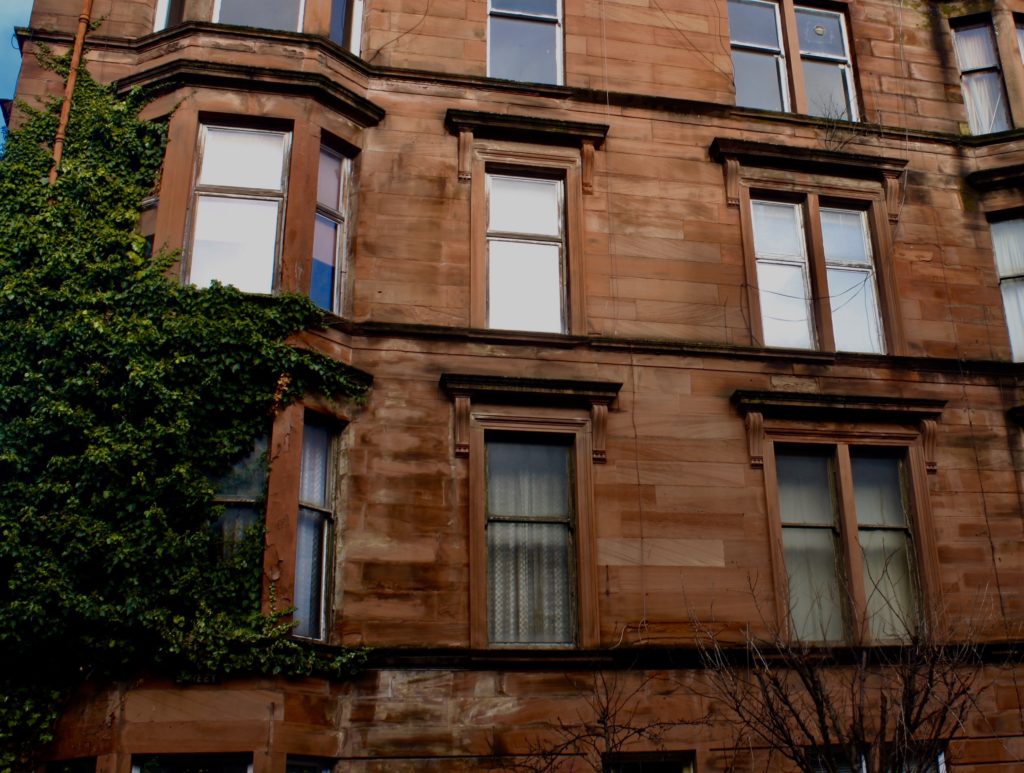
Pandemic Dreams, Third Box:
Take pleasure in your dreams.. Giotto
**
I dreamed you had a big, big house, a stately dark house with the windows half boarded up and shining polished floors. The house was so big. You had a student living in one room and you were a bit put out to find she had her lover living in there too. It was such a grand house.
*
I’m wandering around a huge, empty house, turning the door knobs on each door and entering, trying to understand where I am, which room I am in and which rooms leads to which. There was something about a loose handle — round, wooden, old fashioned (lovely), worn and a bit rattly, and a sense that I thought going into that room that I would be in the room that I was looking for and would recognise where I was, but then it was a completely different room that I didn’t recognise, and I didn’t know what it connected to and where it would lead. There was a simple bed at one side, and the whole room had muted colours, spare, high ceilings, a wide empty floor, no objects, and the door that I entered from and at least one other door that led to god knows where….
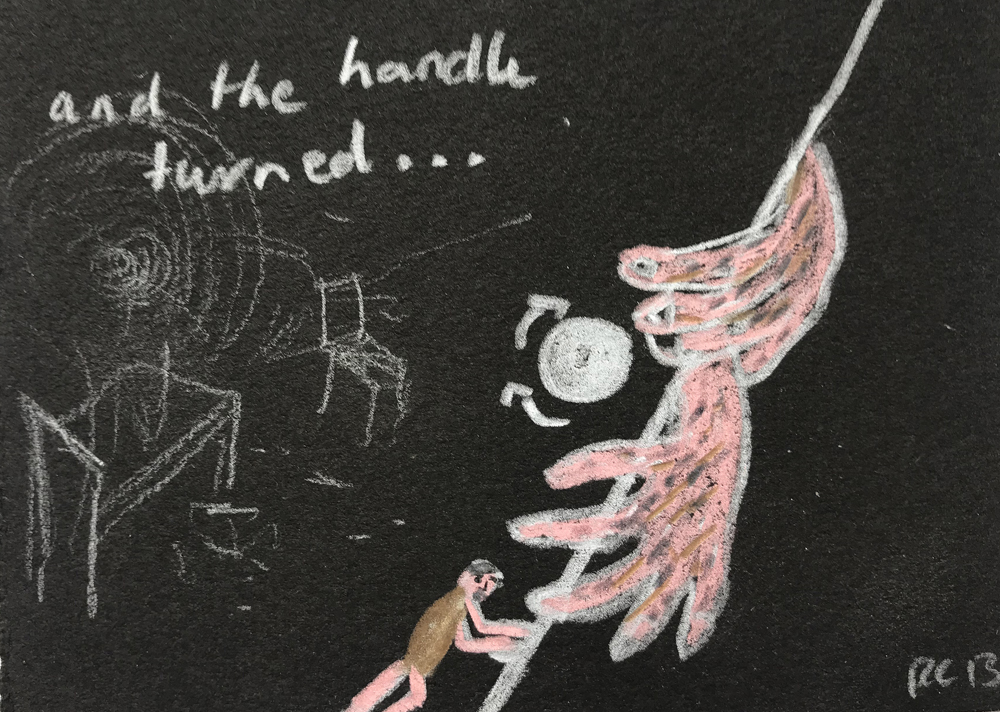
***
A narrow house of low ceilings and unfurnished rooms. I don’t recognise it. Two women are living here and it seems they take me for their landlady. The rooms are barren, the walls a muddle of half torn off paper, wood chip and a dug back layer below dado rail height. There are bits of old maps and inscriptions in pencil on the wall. They have been living here for some time. Should I be living here with them? The bay window is thickly frosted so you can’t see out. They say they prefer it this way. I must at least paint the walls I think and wonder how I will ever manage to make a smooth surface from all these excavated layers. What colour should I paint them? Something warming but light, yellow maybe?
***
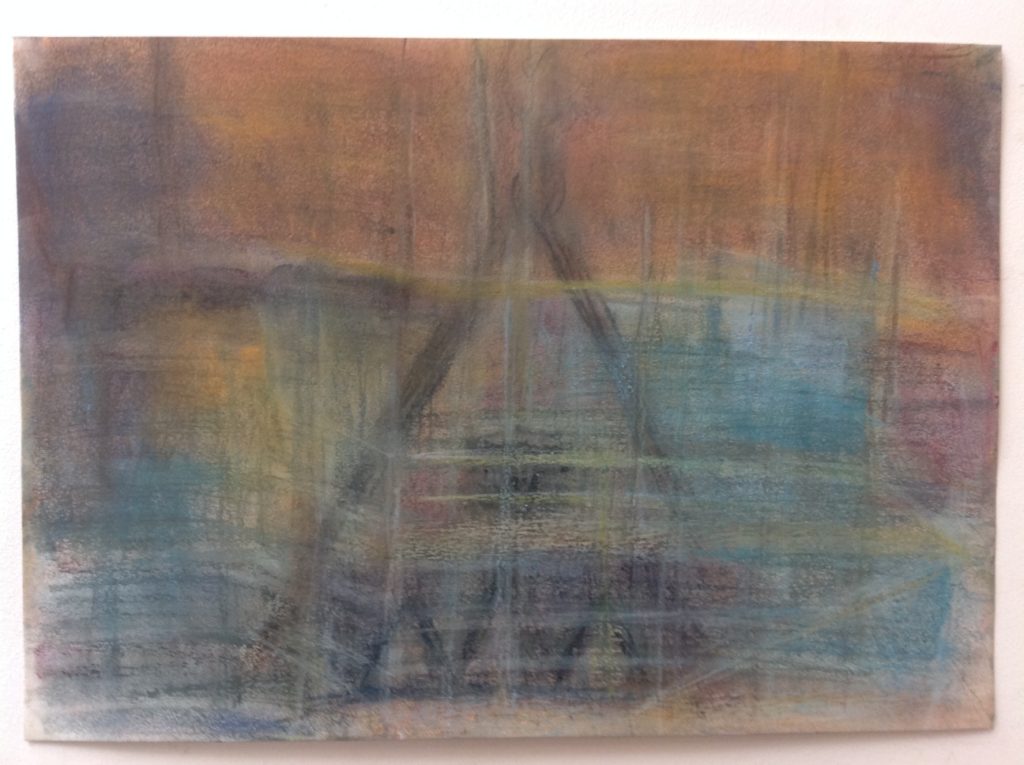
***
I parked the car under a flyover and boarded a train with my daughter. It was a high speed train, flying through the countryside, we were exhilarated to be going so fast, when suddenly we were underwater. The water rose up beyond the windows. I had to decide quickly whether to slide out of the windows into the water or shut them and stay in the train.
For some reason, I decide to shut the windows and stay warm and dry in the train as we carried on at speed through the ocean. I felt sure that we would not sink or be flooded but that it was possible to travel at high speed through the water. Strange this confidence I had against better judgement that might say « get out get out! »
Then I woke up suddenly.
***
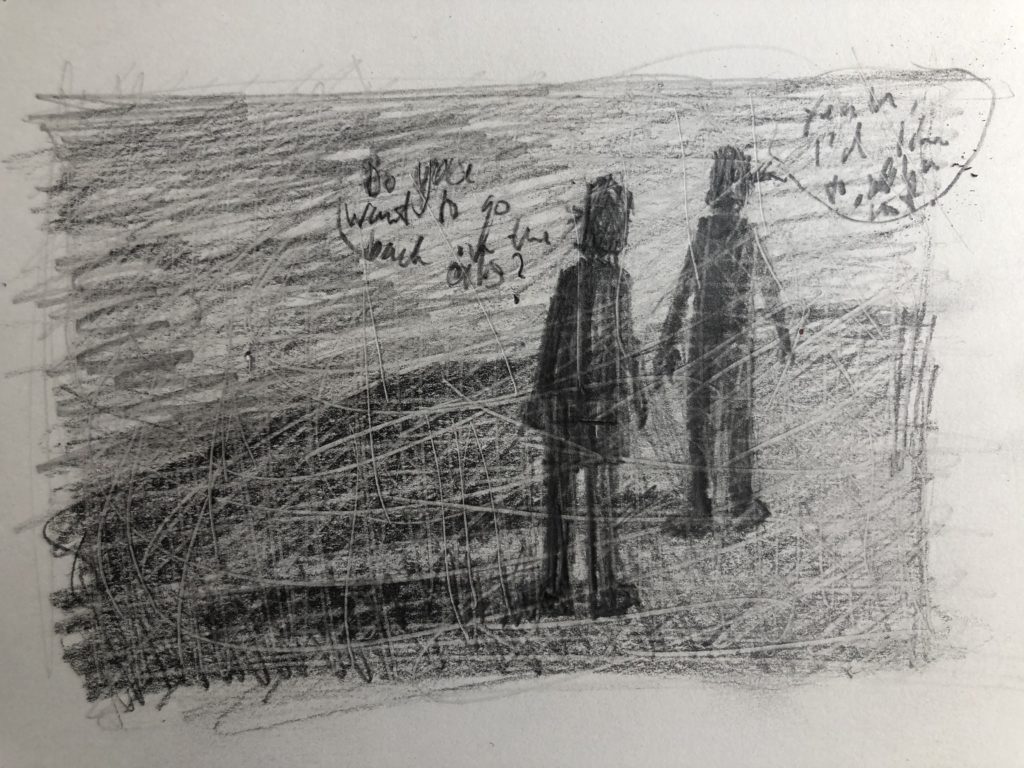
In the dream Ian and I were walking and chatting in a sunny green hilly meadow. It was familiar but much bigger than one that we had visited when he was alive. While walking I looked at him and he looked so well so I thought I would ask him if he wanted to go back on the THC oils, just for maintenance. I realised while I was talking to him that the cancer was long behind us and life was normal. He replied, and it was so casual, he just said « sure, why not, that would be good”. It was a lovely feeling of knowing that he didn’t have to take them as he was fine, but he might as well for prevention. I’d just found a new source, so it seemed hopeful.
***
Walking up a hill in an unknown city, finding curved red grilles on metallic balconies on a giant Art Deco meets Soviet edifice, a cinema — called Busby’s. From here there are winding streets, people cycling in pairs, small clutches of friends in outdoor cafes, drinking up the unmistakable southern balm. A view down back into the city, the gentle light of evening and a recognition — a determination almost — that this is a place not to lose. I woke up thinking of Europe.
**
A. said he wanted to go to Calabria So we went, just like that and joined an archeological dig. What a sweet dream that was. Of course I’ve never been there in daylight so to speak.
**
Last night I tunnelled into a church which became a theatre – nothing on ‘stage’, so to speak, just steep raked seating full of people, one of whom made me laugh so much I thought I would tumble out of the rake.
***
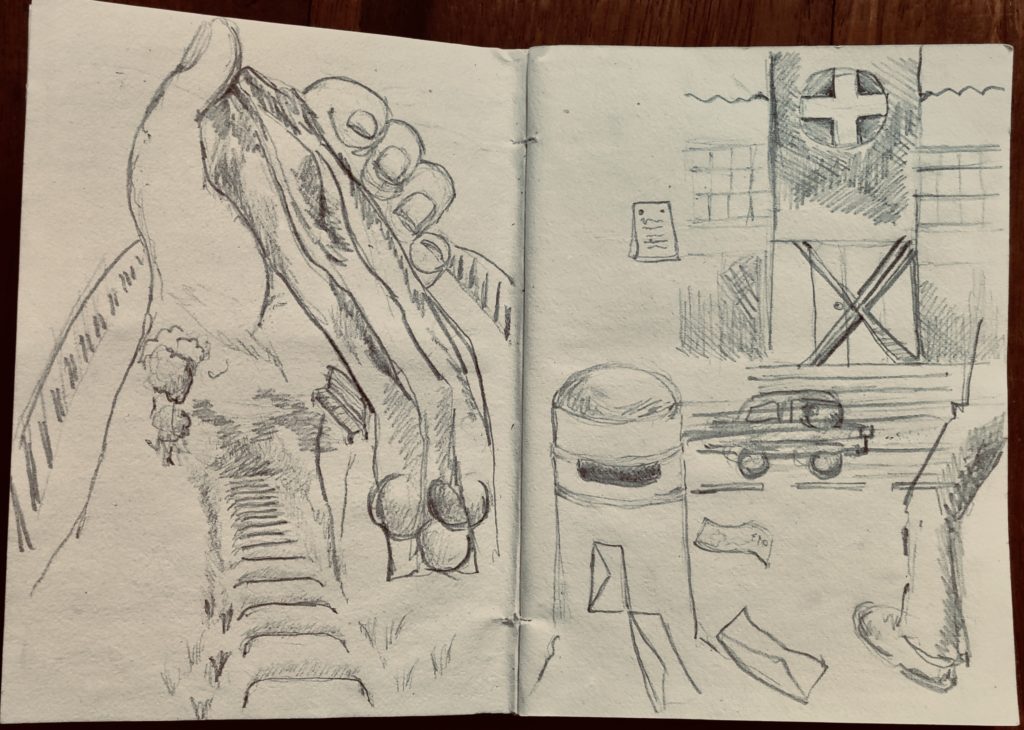
**
The dreams come back to me during my everyday routines — putting on wellies for yet another walk, I am careful of my blistered toe, and remember that in my dream last night the blister became a deep hole. In the dream I had not sought any medical attention and every day the hole grew a little bigger; it wasn’t painful or bloody, just a growing concern — what should I do about a hollowed out cavern in my little toe? Looking in my garden every day for bulbs coming up, I remember that last night in my dream there were many more daffodils than I have really planted —in my dream there were clumps of daffodils all across the lawn in places where there are really none. Oddly the dream daffodils were bedraggled, struggling a little, imperfect — not a grand vision, just a gentle envisaging of something that nearly is, but not quite.
**
This is a dream that came out of recent events, and was experienced partly as a hallucination. My nephew S. arrives back from three months in Spain. It’s the middle of the night and he’s just managed to evade quarantine, which will come into force next day. He falls asleep in an armchair next to my bed, joining the community of wispy, floating figures that emerge from my clothes at night and lurk in the shadows of my room.
In the morning S. goes off very early to see his parents. Thrilled to have him back, they greet him with hugs and kisses, which turn to lamentation when he announces he’s leaving for Bangkok that evening. I hover in the background, not taking part, though I’m moved to write S. a letter beginning: ‘Dear S. Please don’t go to Thailand. You won’t like it there.’
It strikes me that people who spend a lot of their time writing dream with a pen in the hand and use it to write the story that’s the dream.
*
With thanks to Jessica Wolfson, Judith Ravenscroft, Stephanie Byrne, Kate Dimbleby, Maud Hewlings, Nikki Tomlinson and Sinéad Rushe for this week’s dreams, and to Claudia Lapping, Perienne Christian, Jessica Wolfson and Ruby Gaskell for their dream drawings.
February 16th to February 23rd
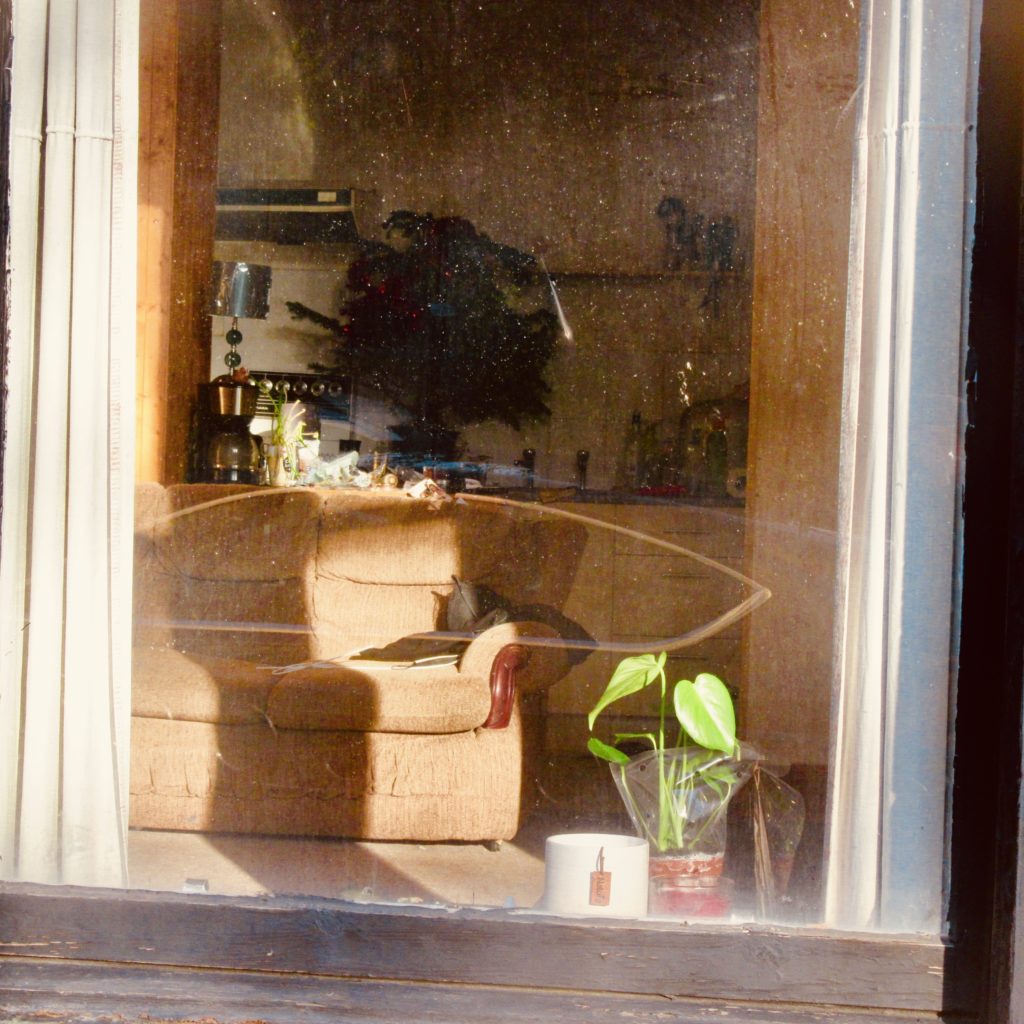
Pandemic Dreams, Second Box:
I’m looking for my son. I open the door of this large shed, he’s sitting under an old fashioned hairdryer with his hair soapy and wet. An old woman is there, she’s a hairdresser. I get so angry and shout — Hairdressers are illegal !
*
We climbed through this small square hole into some stranger’s living room. They were as surprised as we were but friendly and we stayed a while. The woman said she never liked the carpet going all the way to the wall anyway. It was a dark red Persian style. She gave my son scissors, and he was cutting a curved line into the carpet.
**
I had two spare children, who had been left at my house after a lesson and then been absorbed into the family by accident, for months or years. Suddenly I realised how much their parents must have been missing them, and rushed out, trying frantically to find them. On a train I met one of their grandmothers, and confessed my crimes, and she said, but kindly — Yes, it is time you returned them…
***
I’m in some kind of waiting room with a few other people. One is a girl, maybe 8 or 9. I know she’s adopted or something like that. We’re all trying to help or organise or something. I overhear her explain that her mother is 90 and hasn’t had her vaccination yet. I realise that she is still in touch with her birth mother and must be worried about her, even though she doesn’t live with her.
As she goes past me I pull her onto my knee. I’m not completely sure how she will respond but she stays. I’m holding her like a very small child. and I have a sense that I will adopt her or that she wants to be adopted and that the other people are okay with that and it will be a good thing. I’m almost surprised in the dream that although I didn’t have children and didn’t manage to adopt before, this is going to work out.
*

*
In my dream you were drawing yourself as a small figure in the distance and commenting that it is very difficult to get yourself right when your hair is swathed in some sort of scarf or mask. There was a crazy dance scene with Luke and the brilliant woman whom I dance with at the Petits Déjs Solidaires — Laëtitia, and various lithe and large black bodies, men and women, people from the Déj, and also security guards, cleaners, because the scene was set in the marble floored entrance of the Institute and I was concerned about how fabulously we were leaping – to We Got The Funk, no less, still ringing in my ears… on the very hard floor, on and on, like a huge jam with each of us picking up the energy in turn…
****
I had some work in an underground show in Dublin which most of my family had a piece in too. I went over for the opening which being now, was completely against all regulations. All my family and many friends were there. It wasn’t in any gallery I know but I remember you could see out to the street at knee level. It was a wild party, a long night filled with laughter and caper. I woke up happy, feeling I’d had the most amazing and carefree night out with many loved ones.
***
I was planning supper for tonight. It was to be for our friends; lean beef meatballs with lots of coarse black pepper and baby capers friend over a high heat so they remained pink and juicy inside. I thought of my friends saying how delicious they were. I saw our laughter, our eager chat, the enjoyment of a special bottle of wine. I felt our closeness. Then I woke up and remembered that nobody is allowed in my house.
*
I was sleeping rough in a simple black sleeping bag, in Hoxton Church, at the back of a raised platform. Down on the ground was some sort of gathering of tourists, people of all nationalities. The dream had a strange and apocalyptic feel to it.

I saw a big thrashing thing moving above me, but I was crouched down and my neck was too tight and sore to see it. It fell like a bird that had been bitten by the ceiling onto the floor. It was huge and without a shape all around me. I could see my face howling against the light lines of the floorboards and the dark shape of it still in the top corner of my eye. Even though it had fallen it was also still above me. My body was full of the feeling of something about to land. My sister was there and I knew I couldn’t explain it to her but really wanted to.
*
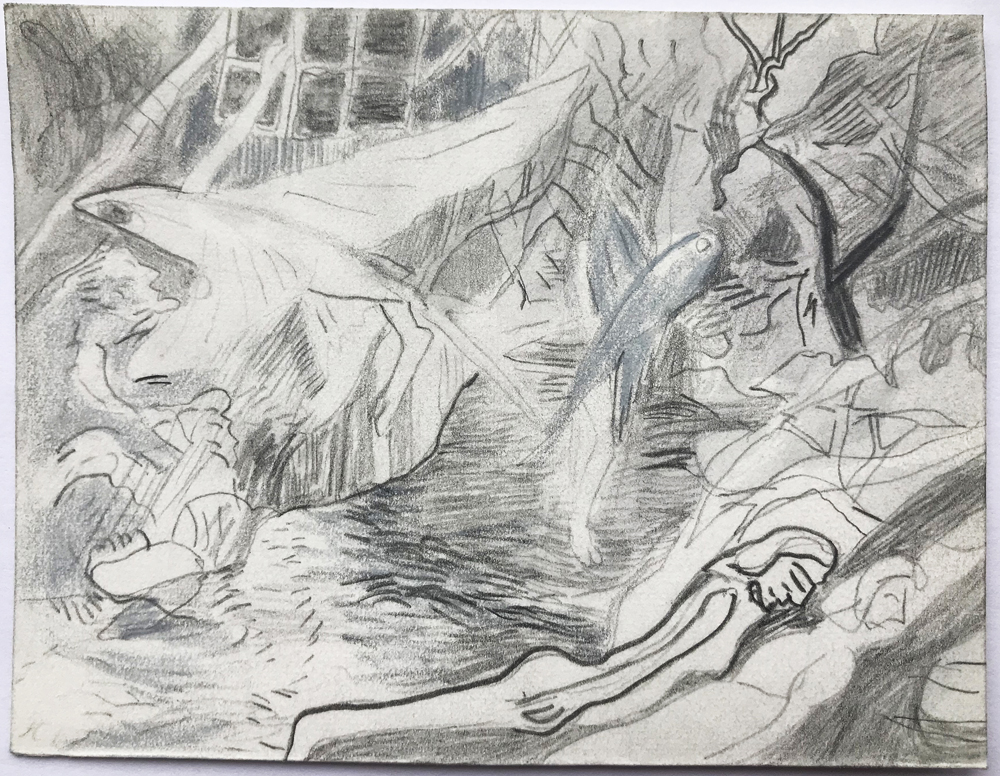
*
I dreamed last night about you and you were telling me how you had so many dream stories from people and how amazing they were, and I was thinking about how I couldn’t remember mine at the moment and how thin they were. I wasn’t unhappy in the dream. You were looking out the window in your kitchen and smiling calmly.
Thanks to Anna-Louise Milne, Claudia Lapping, Cybele Hay, Josceline Dimbleby, Daisy Richardson, Laura Murray, Perienne Christian, Aisha Farr and Sinéad Rushe for this week’s dreams. Drawings are from the series Phantasmagoria: Dream Drawings by Perienne Christian, 2013
February 9th to February 16th

Letter from Glasgow: Pandemic Dreams
At the start of this year, as we locked down once more for days of predictable confinement, I began to wonder about people’s dreams — about what people were doing and where they were travelling now, in the wider spaces of sleep.
I sent an email to thirty or so women friends, mostly artists and writers, asking them to share their dream journeys and encounters. At the time, many people reported that they were having difficulty sleeping, were dreaming thinly or fitfully, or that anxiety was affecting their ability to recall and recount their dreams. I remembered the intriguing dreams that friends had described spontaneously, in our email exchanges last spring, and regretted that I had not made the request earlier. But as we emerge from hibernation it seems that dreams are starting to leave their trace again. Some friends sent their dreams as drawings. Here is the first compilation, a sequence of our shared pandemic dreaming:
Pandemic Dreams (First Box)
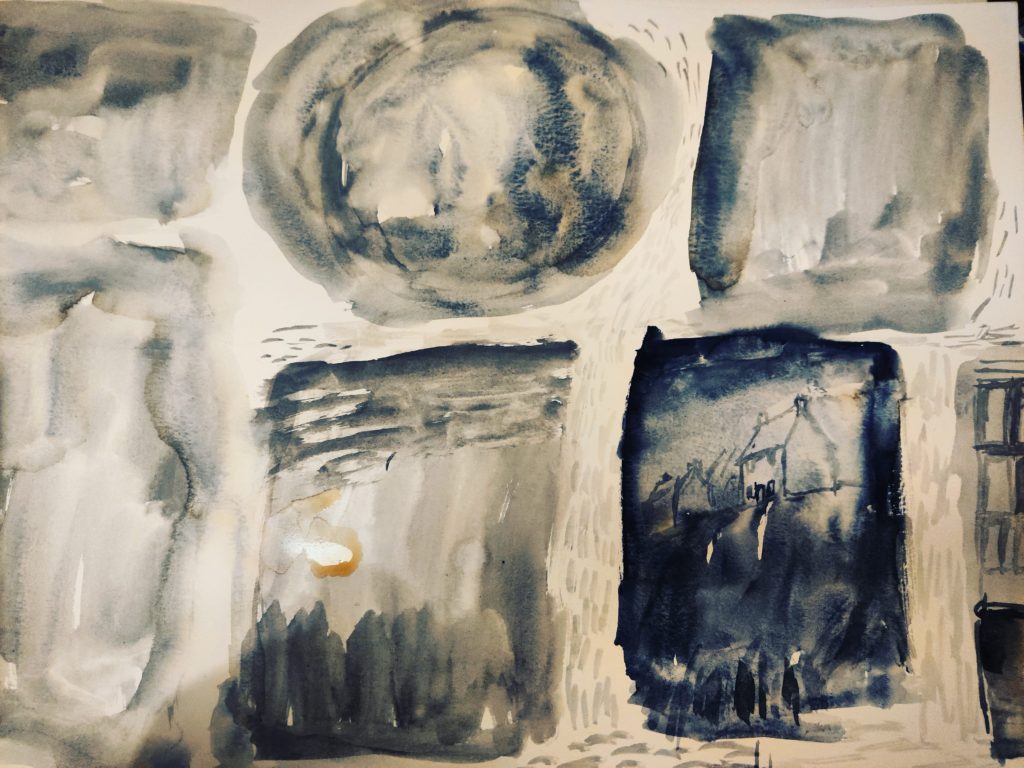
It’s sunny. I’m in a river with my friend. There are five rivers all joining together in a star shape, the current is pulling us round to the river on the right. It’s fun and we are going fast though I’m thinking we are going to have to swim against this current to get back.
*
Villages and cities by water are recurrent. I often feel I am trying to get somewhere in them and I am not sure where. Mum and I were climbing some structure that was a bit too high and I said Mum we have to climb down now which is harder! Then I woke.
*
Cycling through my childhood town, I turned swiftly onto a footbridge. The shabby chipboard panels that usually lined the bridge had disappeared revealing a beautiful curved old iron structure that I had never known was there. My surprise became shock as I realised the open spaces in the design were easily large enough to fall through. I had to warn others of the danger. I slowed and shuffled aside my bike tentatively, the unfamiliar view far below inducing a growing vertigo. As I approached the opposite bank the bridge began to move sideways. I was adrift at height, balanced precariously, knowing that there was nothing I could do but stay still and wait.
*
I dreamed I visited friends who had moved house to live under the great steel roofs of railway stations. Pandemic thinking was afoot: “where is the best place to be?” The answer had come, “as close as possible to a railway station, preferably inside it”. Over the walled garden of my friends’ house was a great arch of glass, pinned between the steel spans of the station, this was an inside space that had once been outside. Their faces were happy, beaming, but you could tell a compromise had been made. They were, after all, travel writers used to living in remotest Cornwall. “You get used to the sound of trains.” they said, “Come and have lunch!” With a bird’s eye view I could see the trains on the tracks beyond them and suddenly understood their beams. It was excitement, it was the sense of possibility that the trains represented. The trains were toing and froing full of people from familiar and unfamiliar places. And, well, anytime you could go and get in one yourself. The deep comfort of a moving train — there it was, behind them, in the background. They had given up the open sky to be close to it.

*
I was looking for a place that I might be able to rent for the coming Spring. The first room I saw was a disappointment, everything was covered with chintzy ruched material, the chairs and lamps and even the toilet. I hurried out as fast as I could into open country. On the road I saw a group of men approaching, a band or a hunting party, they were singing out in German, but I could tell that they were Austrian from their feathered caps and Loden jackets.The hunters passed by and I followed them up a path through a wooded hillside. On the left was a viaduct with golden pastoral views through each arch. Yes! That’s more like it, I thought. But on the other side of the path I saw large wooden beds, covered in moss, set out on the side of the hill as though for a small giant. I thought how nice it would be to sleep there, warm under moss with my face in the open air. Then I noticed a figure, a man lying like a felled tree trunk on the ground, covered in bark and moss, and from his head tangled roots were coming out, curved and entwined. Not from his feet, where the roots should be, but from his head, a twined crown, writhing, looking for water.
***
Dreaming of the sea every night — Cornish. The first, I was in a sailing boat made of white muslins, ludicrous but quite beautiful. The next night on board a container ship. A shift in materials but both times looking down into the sea ware. Last night swimming with a five year old friend, Robin, with lots of whitebait flicking around us. We were waiting for the dolphins to arrive but soon we started to be immersed in litter and plastic detritus.
**
In the top floor of a shopping centre in Glasgow, trying to find the way out, not panicking but slightly concerned I can’t see the exit. I know it’s there somewhere. My friends are in the basement in a shop looking at embroidered badges. Over the tannoy I hear “Happy Birthday Michael Stumpf. Zum Geburtstag Michael Stumpf!
***
I had a dream and you were in it. You were showing me a magazine, maybe the Crown Letter, but a physical one. You were getting it out from under the back of a sofa. You lifted up the loose fabric cover to reveal it. It started morphing into a different scene but I didn’t let it as I liked the painting on the front of the magazine and wanted another look. The dream kept morphing and made no sense. J. was there with a ten year old son. We kept sinking into holes in the mud. That’s all.
With thanks to Iona Roberts, Liz Dew, Laura Murray, Clem Cecil, Maud Hewlings and Annabel Wright for this week’s dreams and drawings. Part II next week.
February 2nd to February 9th

Letter from Glasgow: Ten Rooms
Starokonushenny Pereulok
Leconfield Road
Lychener Strasse
Malaia Bronnaia Ulitsa
Rue Marx-Dormoy
Copenhagen Place
Rue Cardinet
Rue des Mariniers
Kaloshin Pereulok
Keith Grove
Tired of waiting, I go back to each street in turn. I sit down at the table, I look out of the window. In each room I can remember the exact arrangement of the furniture, the direction of the window in relation to the sun, and the view from it.
I look out of the window.
On Lychener Strasse the leaves are always yellow, flickering in bright autumn sunlight, for somehow I’ve only visited Berlin in November. I look out from my friend’s window at the people on the pavement, the tall trees and the park stretching east behind them. The light feels different here, it is exciting. The windows are tall, they go right down to the floor, for I am back in the flat in the early days before the renovations were imposed, ceilings lowered, the old door and window frames smashed and replaced by smaller plastic ones. Pictured spaces assert their own time.
In North London it is Saturday morning, about ten or eleven, early Spring. The sun is on the other side of the street but we sit at the table in the bay window and look out at it, shining on the house opposite, as we butter toast. The morning feels full of promise: the light, the streets, the bricks of this city more solid and inhabitable than any of my cities, and yet I choose not to live here. I watch my aunt’s face, her shoulders in her patterned dressing gown, as she pours coffee and talks of family and the unconscious.
Moscow, the long street between the Boulevard Ring and Patriarch’s Ponds: now a sought after address, but my friends managed to stay put through the years of evictions and renovations. I am in the kitchen of their top floor flat, in my usual seat, sitting with my back up against the almost too hot cast iron radiator. The late afternoon sun comes in strong and red, and if you look out the window you will see the tall row of poplars, rustling, that have grown so much higher since I first arrived in this kitchen in February 1987. They are now almost taller than the buildings, as Masha always tells me, although everything else in the room is the same: the table, the wood parquet floor showing through torn lino, the broken tiles along the wall, the orange scarf hanging over the pendant lamp. I sit looking back into the room, where I have sat at so many conversations, political, literary, philosophical — the anxiety over the great gaps in my knowledge balanced by the thrill of the new landscape being mapped out before me, and the prospect of entering it, of walking through it, just by reading. This pressing sense of the amount yet to be read, that has only slightly lessened over the thirty four years of my visits. On the corner of the wall, always the yellowed piece of paper with a quote written out in felt tipped Cyrillic. Кто думает, что постиг всё, тот ничего не знает. Whoever thinks they have understood everything, knows nothing at all, sounding out in my head each time I walk past it to the corridor, a parting shot.
West London, an afternoon in early May, or September, when the season is distinctly yet always surprisingly more summery than in Scotland, so that I relax a little, as though abroad. My friend and I are talking on and on, drinking pots of tea, Assam or Iranian cardamom, as the sun comes through the low bay window of this dead end street. A cat claws at the seat of the narrow sofa on which I sit and sleep when I come to stay. I think of it as my sleeper berth, on a safe continuous train, moving through the piles of laundry and books and my old paintings that fill the room, keeping company with my friend.
In Paris, it is night. If I go over to the window there is a view straight up the street opposite and in the distance the lit profile of Sacré Coeur. But I am lying flat on my back watching the car lights transporting the curlicued balcony shadows across the ceiling in their nightly carousel. They slide and circle in lazy succession, and I slide with them, back and forth. I am listening to my friend talking, enjoying the cadence and energy of her speech, the rise and fall of the balcony, the continuous rhythm of the train from which I have just arrived.
A few long streets and an underpass west from Masha’s flat in Moscow is another room. It looks out onto a wide open courtyard. We sit in the space that was once a tiny kitchen, but was knocked through to join the main room in the nineties, in order to rent the flat to Americans. Still we huddle in the corner of the kitchen end, at the same small table that has always been here. A breeze stirs the bottom of the gauze curtain on the door to the balcony that is just ajar and hot May sun comes in. We are listening to Yuri as he talks of the space of Japanese painting and of the uninflected vastness of Russian country — the curtain stirring at the corner of my eye as I watch the images his words make on the far wall. Then it is night and winter and snow outside. The old kitchen wall closes us in again, there are jars of pickling cabbage on the balcony and the talk is of the unforeseen pleasures of Saltykov-Schedrin. Yuri always the provocateur, his daughter Ira and I listening as we have listened since we were twenty, hanging on his words, even if now as much for the rhythm and comfort of his voice as for any promise of revelation. We have listened together at this table that I have left and come back to for over thirty years, through late winter breakfasts that run into dusk, or short summer nights, or the slushy hiatus of Mezh-sezon, the thawing time. I hear the pitch and cadence of his voice but I cannot improvise the words.
These are the rooms that I return to readily, where I sink in to the conversations, the to and fro keeping us warm. I take my place at the table or on the lit-couchette. The other rooms that inhabit me are ones where there were no conversations. I do not want to go back to these streets but they are lodged just as stubbornly inside me: Copenhagen Place, Kaloshin Pereulok, rue des Mariniers, rue Cardinet. Lonely places, but I cannot remove them from my inventory. The endurance demanded by these rooms is borne out in the tenacity of their hold. They are rooms where there was no opening out, into the words of another or even through looking. I look out of their windows at the blank back walls of high rise flats, columns of identical plastic shutter blinds at the edge of the périphérique, or a dark internal courtyard, or the passing legs along the pavement from a low basement. Days and nights of silence in these rooms, sounding out Russian vocabulary in long columns, trying to work, to paint. There was no-one to talk to and the views were enclosed, resistant, but perhaps for that reason marked me insistently.
I wonder if, when the borders are open again, I might take a train and travel through these rooms, from London to Paris, to Berlin and on to Moscow. To join up the streets, even the ones I don’t want to go back to, without getting diverted, by train and on foot, back to the places inside.
January 26th to February 2nd
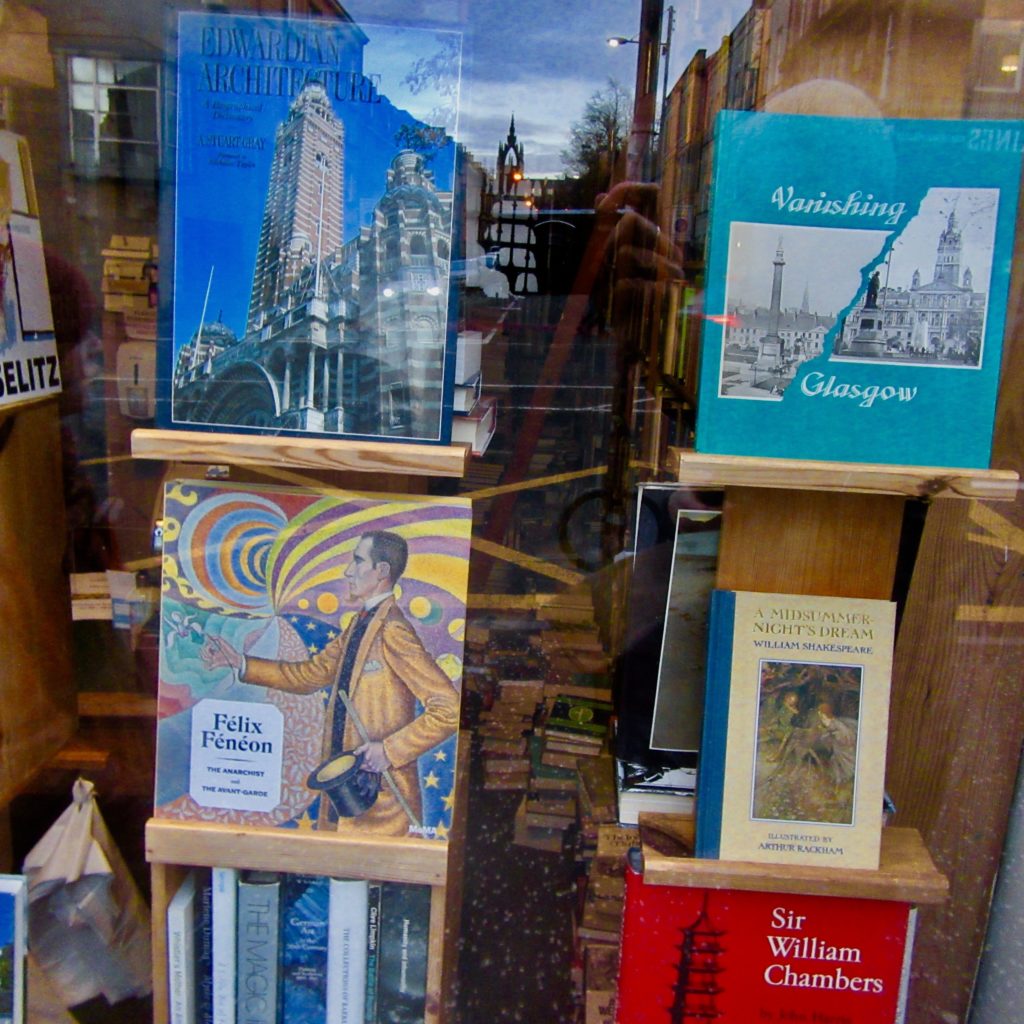
Letter from Glasgow: WAITING
The rooms of the houses opposite have become so familiar they are like rooms of my own house. I have begun to take them for granted. I no longer resist the pulling down of blinds. It is almost a relief when the cold nights compel this closing in and I take part in it, each of us shuffling the chains of cheap made-to-measure roller blinds you can buy online, in various shades of white, creamy yellow or beige. The light from inside transforms the flimsily dressed bay windows into large paper lanterns, taut and glowing. It is peaceful after the glitter and jangle of Christmas decoration. I roll down the blinds as the people opposite do, without regret, we shut ourselves in. Perhaps we have run out of things to offer each other.
The cough of the man in the flat below is the only signal of life in this building. At night it rises up through the floorboards, through my bed frame and mattress and lodges inside my head, as though he has also been enclosed, become something interior.
The streets are quiet, a prolonged hibernation, even as the light returns. When I walk out, I notice that I have stopped looking forward and move almost blindly. My feet and the ground below are more engaged than my eyes with the buildings before them. I set forth on the shut streets as though through fields, navigating the slope and contour of terrain underfoot, relearning the familiar paths as if walking with my eyes shut, through new and open country — no longer paying attention to the names of roads or to the map I am making, no longer reading the streets. I walk through books and streets: the ones before me, and the ones inside me.
January 19th to January 26th
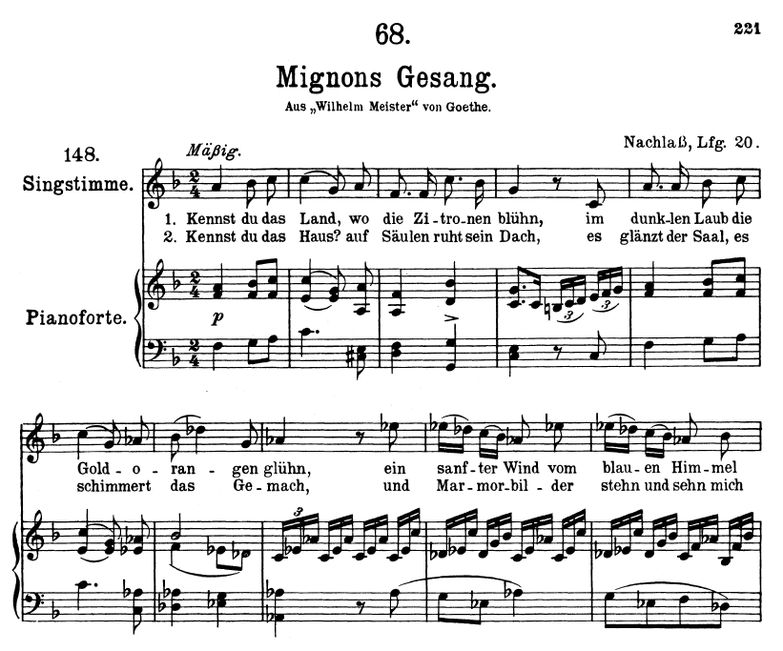
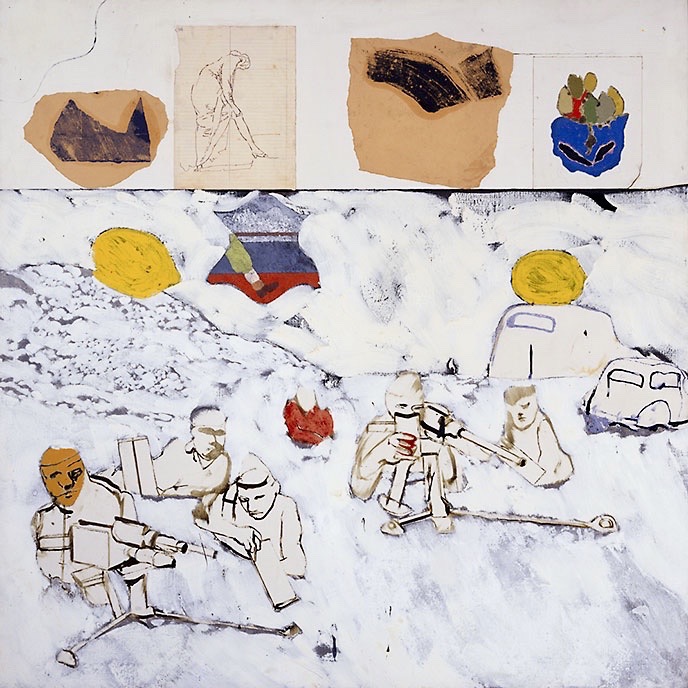
This painting of mine is just another little altarpiece among those many journeyman shrines which mark the graveyards of fascism. I’ve kept this painting many years. It swings in my attic, creaking nostalgia, and reminds me that fascism is not dead after all (as if one needs reminding). The picture recalls a lost period in my life, a loss I regret.
R. B. Kitaj interviewed by Richard Morphet, in R.B. Kitaj: A Retrospective, Tate Gallery 1994
Letter from Glasgow: Sehnsucht
17th January 2018 11.14 (London)
It’s very bright and freezing here today. I woke up to the news that the motorway between Scotland and England has been closed off by snow, which felt somehow allegorical even though they said it was open again now.
17th January 2018 11.40 (Glasgow)
The blizzards were amazing last night — and snow on a scale you only see in Russia— all brownish haze and making the sky seem immense with all of it hurtling towards you. Even as it began — real feather pillows being shaken stuff.. Now giving way to slush.
I walked to and from the Conservatoire last night as had been given a free ticket to a recital of Lieder. Settings of Goethe by Schubert, Mahler, Wagner and Wolf. I sat reading the translations on a sheet. I never realised the resonance of German names: Stephen Twig(g) becomes Stefan Zweig and Freud(e) is joy.. I love the strangeness of German and all its sehnsucht longing and nature rapture!
19th January 2018 at 10.02 (London)
Love the thought of you walking through the snow to the Conservatoire, it feels very like Moscow. G. has been in Hamburg since September and is so besotted with the sense and coherence of the public spaces. I think, worn down by the senselessness of the Uxbridge Road and the looming loss of Europe, she sees Germany as a promised land now. I’ve been carless for over a week from a puncture and at last walking around again and going on the bus, which has been bliss. Uxbridge Road for me every time…
I had to look up Sehnsucht — at last, a word for it!
19th January 2018 at 10.32 (Glasgow)
I’m trudging through the snow of Moscow in the winter of 1994-5 when I was staying with you. Last night was the City Halls and two blonde Dutch brothers playing Mozart concerto for two pianos, they wore matching high waisted jackets like eighteenth century boys. Afterwards we came out and the pavements were iced over and everyone went sliding.
I think I’m only just realising the prejudice we grew up with in England against the German language as somehow military and hard hatted. Listening to another Schubert/Goethe song: Kennst du das Land, wo die Zitronen blühn/Im dunklen laub die Gold-Orangen glühn? The “kenn” of German echoes the Scots “ken”. And the oranges gold against dark leaves are round and glowing like in medieval (Sienese) paintings. But Kitaj painted lemons in a snow blotted landscape, with machine guns. Icy and wet here now, with lumps of half-melted snow.
January 12th to January 19th
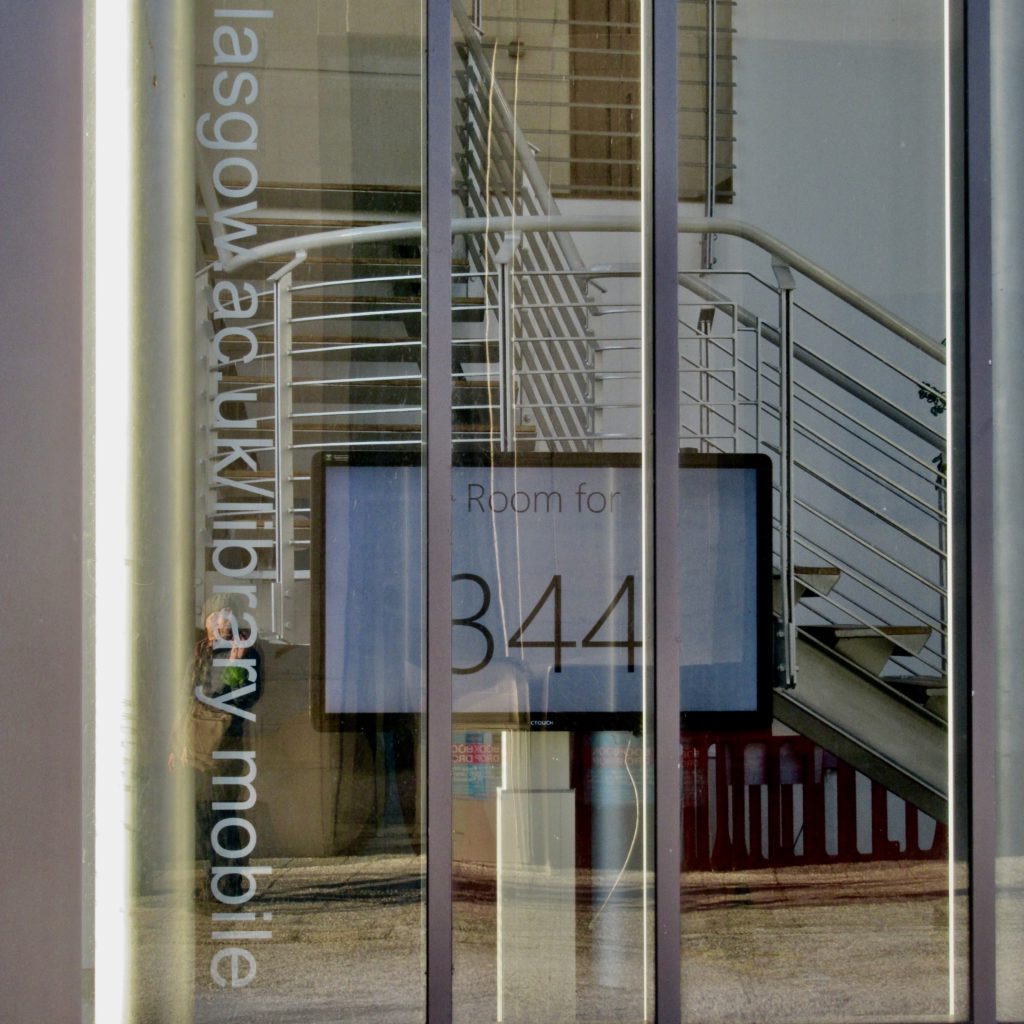
January 5th to January 12th

Letter from Glasgow: CLOSE UP
We are emerging from the darkest days of the year. On the latitude where I live this is significant. For almost a month the sun doesn’t rise high enough to surmount the adjoining wall of flats and enter my rooms, although my flat is high up. I am reliant on the bounce and reflection from the windows of the building across the road for what semblance of sun I receive.
I am used to charting my days by the movement of light through these rooms, from the east side of the flat where I wake, wash and breakfast, to the west where, when the days grow longer, the sun remains until evening. Room by room, I follow the sun. Now, reduced to waiting for chance deflections of borrowed sun, I must leave the house in search of it. I walk about the block and look into rooms along the wall that cuts off my light. They face south and are filling up, swelling full with light. Many of these rooms are rented to students and so are empty just now. I watch how the light makes the bare walls gentle with its glow. I imagine myself sitting at the window, leaning against the wall, feeling the warmth on my face through the glass.
I have become preoccupied with these empty rooms. Some of the ones whose windows I look up at belong to the student flat that lies empty across the stairwell opposite mine. I imagine that I can move through our shared wall into it, taking possession of this next door space and its light. I think of how I would use each of the rooms, this one for reading, this one for working at a desk, set just where the shadow of the window frame falls, the big corner one to play music in with friends, and perhaps a room to sleep in. I can picture the way that the light falls and moves through each of the rooms over the day. Their empty spaces seem to lie in wait for me and I feel sure that if I were to push the door it might yield and I would be there, and could walk freely through these empty sunlit rooms, that have become mine.
Back in my own crowded rooms, the light is just beginning to return, a short flicker of reddish shapes along the living room wall around half past two is all that it offers. A sliver of promise for the long days of spring. These small off-cuts of light quiver, marking the short afternoon in thinly calibrated moments. Their light and shadow dance is swiftly over but I make sure not to miss it. I note the time of their appearance so that that I can be ready and waiting tomorrow, to scoop up my own small share of sun.
From the window of this room where the light first returns at the turn of the year I can just see the rim of hills in the distance that marks the boundary of the city. The hills are swathed in snow that glows pink in the last of the sun. It glitters back from the windows of the houses that are set before them, laid out in a line like toy houses. I would like to be up there, feeling the snow underfoot, walking in the late sun, but we are confined to the city. More bounded even, since our legal limits are those of our local council, and these intersect the shape of our city like pieces of a puzzle. Maps are provided online for us to check the scope of our movement, to learn these new invisible frontiers that we had not been aware of. The line is drawn well before you reach the hills. We must remain in these neighbourhood circuits and in our own flats, taking imaginary walks through other people’s rooms.
I lean my camera up against the window to see if I can get a picture of this strip of hills, in the light that will last just an instant. I zoom the lens in as far as I can. I draw the hills up close to me. The walls of snow are now like private ramparts, holding us in. When it is dark I picture them, enclosing and immediate, as the photograph made them seem. A rearrangement of space, a reassurance.
December 15 to December 22
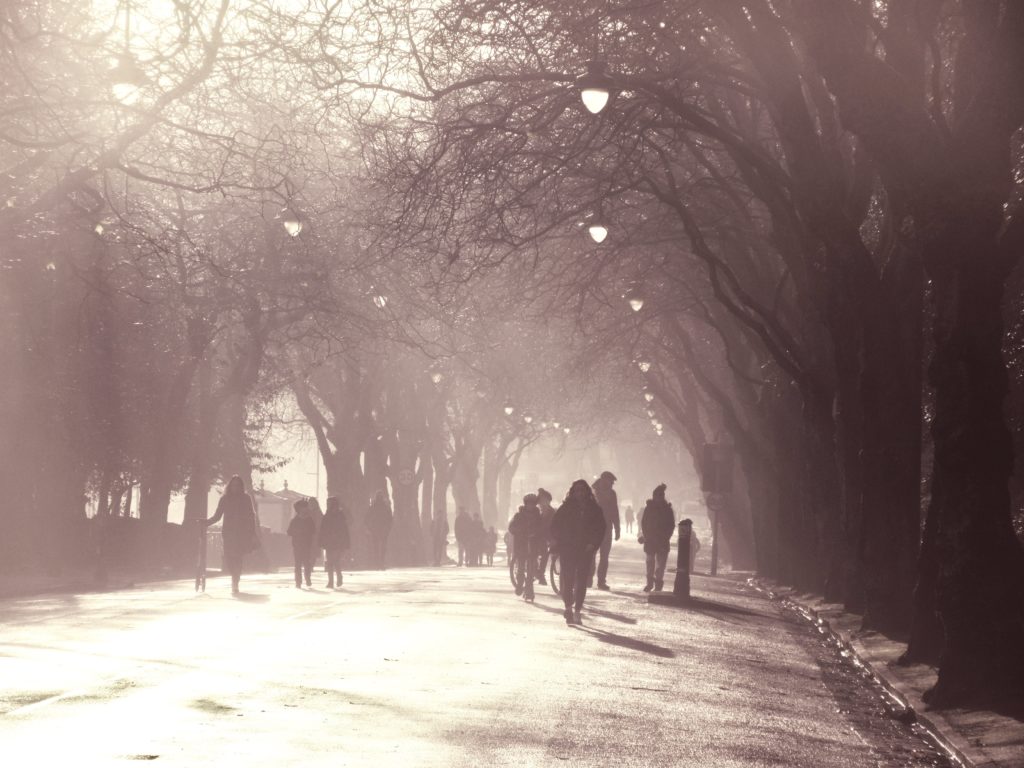
Letter from Glasgow: TUNNEL
At the beginning of May, in the middle of the first lockdown, the broad road that runs through the park was closed to traffic, to allow more space for socially distanced exercise. The familiar thoroughfare relaxed and spread into a scene of people walking, moving softly through the space under the generous arc of plane trees, just coming into leaf.
I had always thought of this passage of planes, strung through with bell shaped lamps on wires, as a nineteenth century scene, particularly in winter, after the trees are pollarded — they articulate their pencilled lines and knobbled branches like a stubborn Van Gogh drawing. But this spring, as the translucent leaves emerged and speckled the endless sun, the people walking through the light were a picture worthy of Seurat or Signac, of their Golden Age re-envisaging of the contemporary scene. The reclaiming of the road as a part of council organised Covid management is not exactly the anarchist transformation these painters had hoped for, and yet it felt different, exciting and strange — the diffused late spring light haloing the figures as you fell into silent step with the people around you, keeping your distance.
In the autumn the plane leaves fell in thick swathes and were left to pile up across the road. The shuffled bed of yellow, orange and ochres echoed the leaves that remained on the branches, and the sun still shone through, making a golden tunnel of leaf light. It was startling and unexpected, the abundance of leaves being left like that in the middle of the road to join the ones above, it felt reckless and celebratory, as though order had been ignored for the sake of beauty. This encircling tunnel of leaves lasted only a week, before the branches above became bare, and rain pulped the glowing bed below to a dark papery sludge.
Last Sunday afternoon, after days of darkness the sun was suddenly bright, so I set out for the park. I walked down through the University to meet the opening of the tunnel. The light was shining from the south through a dense frosty mist. Seurat’s Grand Jatte re-articulated in monochrome, a quiet silvery stillness. I was stopped short by this shock of light and air, this softly encompassing mist, and the figures suspended within it, moving silently through it. In the distance a trumpet was playing, warmly spiralling jazz.
Sometimes the focus shifts just slightly, and the world feels completely different. Suddenly you are at ease inside the space around you rather than looking into it, or remembering somewhere else, or hurrying away. As though you are welcomed back in, after an inexplicable estrangement, and you cannot work out how you returned, only feel the relief of being back — no longer held at a distance, reckoning, regretting — but simply here. The warm sun fills up my eyes and stops me from seeing. I walk into the light.
December 8 to December 15

Letter from Glasgow: THE ROOM INSIDE
The globe of the Chinese paper lampshade in my bedroom makes a shadow sun against the pale red light that spreads across my wall. Shadows of the tree’s last leaves flicker and inflect the watery light that seems to be surfacing from inside the wall. A grace of morning sun at the approach of winter in this dark country. We live in a dark country and we take it seriously. The long tunnels of darkness, and the sudden sun.
This morning the branches of the tree outside the window are bare, with a few last leaves hanging like paper fishes. There is a full rainbow arc across the street where we live. We would not have seen it had we not been struggling, late and in the rain. My daughter lingered in bed opening the doors of old Advent calendars, from the collection that I keep. She had been opening the windows for each day, holding them up against the light.
I write to friends in London, in Moscow, trying to describe the light here in winter, the comfort of this burnished sunlight, like the deeper yellow of leaves when the sugar has been concentrated inside them by the cold. I sift the light through the rooms of my house. I store it along shelves or in corners like a precious liquid. Beyond the window, the yellow tree.
Last night I walked out, down to the end of the streets that lead to the river. I stood at the top of the high bank, looking across the water to the lit up rooms on the other side, through the windows of the high houses. The windows were like paintings set in a wall, or the openings of an enormous Advent calendar, lit from behind. They had small figures in, and for once I was looking at these imaginary paintings as a depiction, as stories that draw you in, rather than unpicking juxtapositions of colour, surfaces and viscosities. From this far distance I could see heads, small animals, the edges of bits of furniture. I was thinking of the pleasure that could be had by giving yourself up to these imagined scenes and not just following or analysing the language of paint. I made a leap across the river and into the window world that had become a painting.
I wonder about these window worlds that we complete with a sort of inner seeing as though we know already what they contain. Looking in, we expand the scene. We articulate things that are only suggested in the shadows and shapes we are shown. This envisaged whole, this completing “illusion” is as specific as the measurable material that it haunts. How do we so readily elaborate what we can only half see? It is as though something already mapped out inside responds to the visual hints before us and evokes an entire picture in precise detail, it knows more than we can think through.
You walk on, and then find yourself stopped short, drawn back to a window that still nags at you, to wait a little longer before a half-obscured room for the familiar to show its face. You are compelled by these almost recognisable spaces, that seem as though they might answer a restlessness, allow you to pause.
In Margaret Oliphant’s The Library Window a young woman looks out through a window and sees a figure in an opposite room that only she can see, that only sometimes appears. It is a sort of midsummer ghost story, set in Scotland, at the opposite pole of the year to now, yet a season that is also ripe for haunting, when the light seems to be almost endless. The woman describes the way that the room unfolds itself to her in the evenings and how she begins to see papers, and books, and eventually, a flicker of animal movement. Her vision of the room fluctuates between a deep seeing into the room in its detail and intimacy and a sudden shutting down of that seeing, when the depth of the space vanishes and there is once more just mute surface, an impenetrable “false” window. One night the flicker of life becomes a man writing, she is the only person to see him and like the room itself he emerges slowly, like a grace. She is held by this elusive vision, a far more intense reality than the life around her, but she is unable to prove what she sees, even to herself. There is a sense that this looking out and longing is a sort of life sentence.
Sometimes a thing is half told and we have to fill in the gaps from our own obscurity, sometimes we happen on images that disrupt the telling. I think of the man seen in the room through the window, writing on and on. I look back out of my own window at the shadow of the tree, the sudden electric brightness of light in the garden. I must not leave it stored up — unrecognised, unspoken.
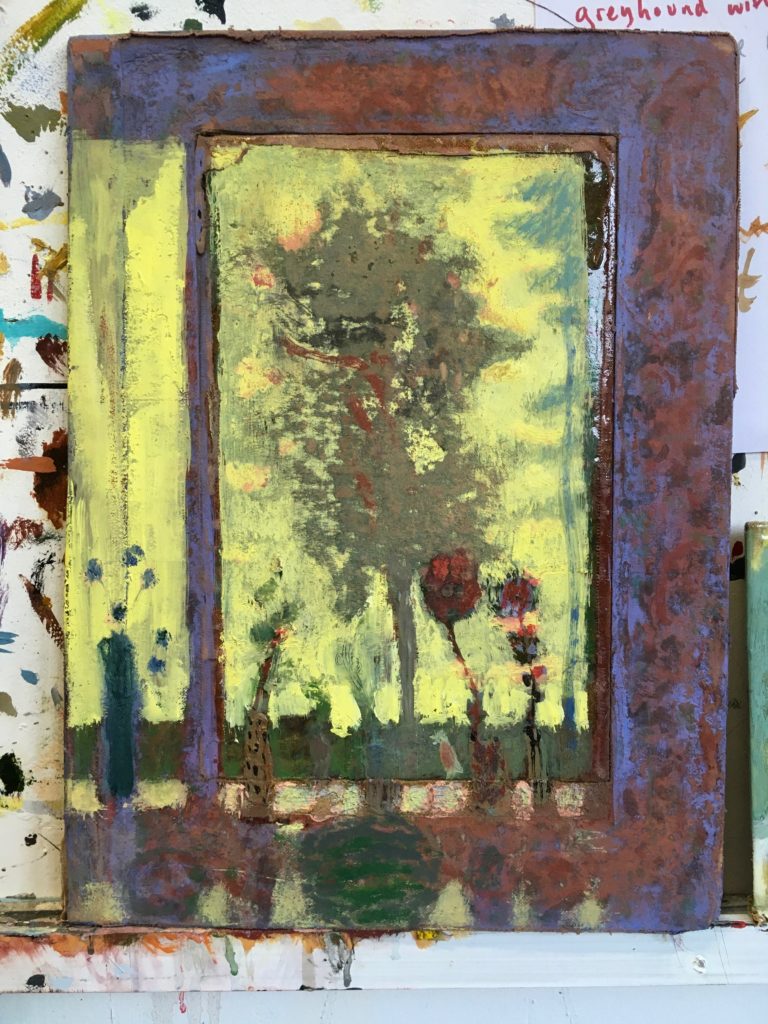

December 1 to December 8
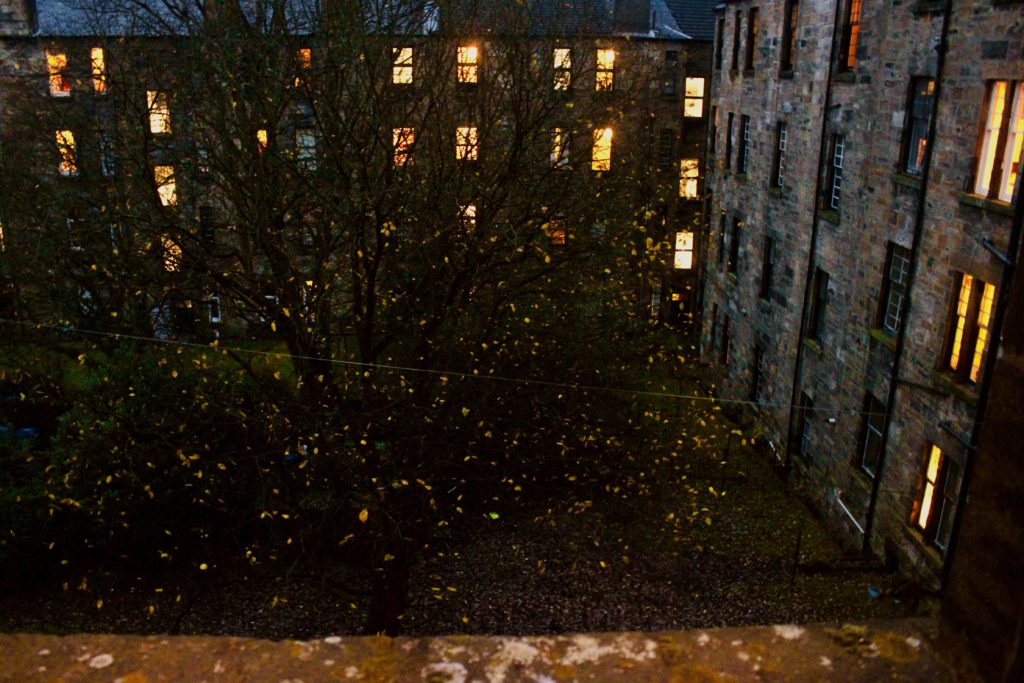
Letter from Glasgow: MUSICA ADVENTUS
The tree outside my back window holds its leaves when all others about have blown. The trees on our street are stripped bare in a night when a strong wind blows, an abrupt ending. But the tree at the back is protected from the wind on three sides by the enclosing back walls of tenements. Now it is the last space of yellow in a landscape of wet stone, slate and thin black branches.
Two autumns ago I set myself a work routine. I stopped going to the studio and set up a small card table in the window of my bedroom, looking on to the tree. I wrote at the window each day. I would usually begin with the tree, the spacing of the leaves and the light on it. The leaves held the space and made it open up, they seemed to expand the air around it, to articulate it, every day with slight variation. I returned in the morning to the window, the table and the yellow foolscap notepad, and wrote looking into the tree. It is strange how closely this self-imposed solitude and repetition, this narrowing of my circles, anticipated the days of the year now coming to a close. That autumn of my willed confinement I learnt how to make small circuits enormous and how to see the coast in the flecks of sandstone walls. I kept watch, inside and out. It was a lesson that eased my transition when restrictions on activity were no longer voluntary.
The following autumn I waited eagerly for the yellowing of my tree’s leaves but they never turned. They went from green to a deflated brown, smeared with black, there was no golden holding of the space. I worried that the tree had contracted some sort of virus. I even feared that I was somehow implicated, might have poisoned the tree by putting it into words. It is not as fanciful as it sounds. It has often happened when I draw a building that the next time I pass the site it has been demolished — as though we have a sense that attracts us to try to hold, in drawn or written lines, what is about to vanish. But I had been counting on the tree and its golden leaves.
This autumn though it revived. The ellipses deepen to a more orange yellow as they speckle the space more sparsely. The fallen leaves remain upside down on mossy ground, a pale pinkish scattering, accumulating slowly like coins of softest new leather. The rows of yellow windows are folded about the tree like an Advent calendar, they watch over and echo the yellows of the tree’s leaves. Each time I enter the room I check up on the tree, on the leaves that remain and inflect the space about it, keeping it open and resonant. I am reassured by its stillness, by its very gradual deciduation, which lends me endurance.
When I wake in the night I try to grasp at days past, to go back inside them and remember how it was there. It is a bid at finding my bearings in the night space of the house, and in the obscurity of my lived days. I calculate years and try to re-inhabit them so that they are not just gaps. It never makes for the settled reckoning that I am after. The very recent years of my children’s growing up are impenetrable dark pockets. I want to comfort myself by summoning their remembered presence in the night but they remain stubbornly in hiding, as though the children are keeping themselves hidden from me, playing a game where I am the ever more anxious seeker. I lie there reckoning distances. I add up the numbers between dates but these bare markings get me no further in my hope of being gently held within a pattern of years. I get up and cross the room to the window. Even in the dark, the leaves of tree are discernible. The branches dissolve into darkness and more than ever the leaves seem suspended in the space, holding their own, an elegant articulation, a promise. The leaves of the tree mark time in a way that seems liveable, they reassure me with a constancy when everything seems to be eddying away at ever gathering speed. I will stay vigilant until the last leaf has left.
November 24 to December 1
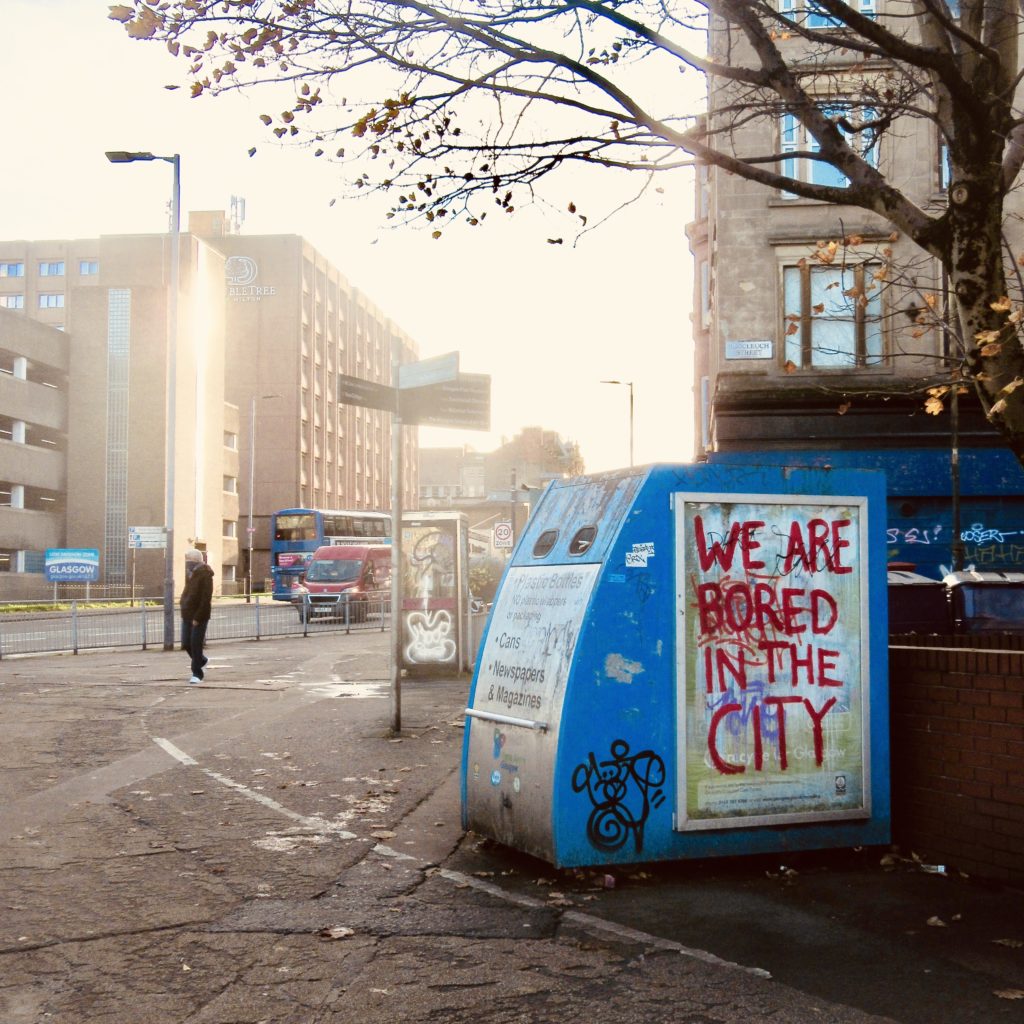
Letter from Glasgow: PROMISED LAND
I’m heading into town. It is the day before Glasgow locks down again, and everyone is out shopping. Early afternoon light through the last yellow leaves, a warm copper glow from the walls of buildings and a hubbub on the streets. The cafés are full and the pavements thronged. A Christmassy tinselled bustle compressed into a few days. It is a long time since I have been out with purpose and it feels strangely exciting. It’s only when I’m down on the Underground platform waiting for the train to the city centre, staring at posters for plays and concerts that never took place in April while a voice instructs us to wear a mask at all times, to not go near people, that I remember the pandemic that we are in.
I have become accustomed to the rhythm of my everyday circuit, crossing the park to school and back to the flat, crossing the flat to the kitchen window and back to my desk, day after day. In my small and mostly solitary circling there has been no dramatic change from the time before the lockdowns. I am just less interrupted in my work. It is different when you go into the city. I get on the train and sit down opposite a line of students, all talking through their masks, and I realise, actually take in that this scene is the present time, not the daydream time of work. That it is both banal and extraordinary, an image from dystopian fiction but also a fairly liveable everyday.
I said that my life had not changed much since the time before. Yet it must have, I have just become used to not going out, used to my subdued days. My unconscious is not so easily tricked. When I go to sleep I have vivid dreams of huge auditoriums, laid out for a performance. The empty seats are about to fill up with my friends. I dream a succession of courtyards or even cloisters, where groups of musicians are playing instruments, some of which I have never seen before. In the afternoon light they are playing a sort of experimental chamber music. These half open rooms are set in gardens and I move from one to the other through the gardens, each one is filled with people in a celebratory mood, standing, listening to the music, drinking, greeting each other. It is warm, and the golden sunlight fills the space. I wonder why I hadn’t noticed these gatherings before, as they seem to be well underway, in full swing. In another place, an open hilltop looking down on the city, people are standing and crouching in a circle, they are drawing and dancing. Everything is suffused with the rich yellow light of endless afternoon. It is tremendously reassuring and exciting, this Golden Age that suddenly surfaces over the ghosts of dark and empty city auditoriums that I try not to imagine, and it is so convivial. The musicians are there with us in the room, sitting up on the walls of the cloisters, leaning against the pillars and playing these extraordinary tunes! Leaning in, listening and responding to each other.
On the Dumbarton Road a man in Emmaus, the charity shop, interrupts my remembering of the dream. He tells me that the binoculars I am holding have been there for six weeks and no-one has bought them, he warns me not to, they are too expensive and too heavy. He doesn’t work in the shop, he is just one of the regular locals who hang about from curiosity, talking to the staff, nosing out new acquisitions and of course helping to advise the customers. I haven’t been here for a year, since last November, and I wonder why not, and only slowly remember. But I am grateful for the man, and for the other encounters in this tail end of town where people break into conversation in shops or at shop windows. I am cheered by the repartee from that other world, almost gone even before the prospect of a pandemic, of junk shop finds and pavement wit. Not a Golden Age, but something vital to this city, unexpected exchanges that leaven the heaviness. I put the binoculars up again and point them towards the rooftops beyond the shop window. I can’t get a focus.
November 17 to November 24

Letter from Glasgow: LYING LOW
I use the phrase repeatedly in emails to friends, to deflect too much expectation about how or what we are doing these days. What does it mean, to lie low? It is mid November, almost the ninth month of the pandemic, of all times it must be permissible now to lie low.
My mother writes, “I feel tearful for the first time in years — I think of myself as a specially cheerful person”. I can tell from the typed words that this new lability is difficult for her. She is of a generation for whom resolute cheerfulness is a badge of valour, the way to face down adversity.
I write back that sadness is not necessarily a bad thing, and venture that crying as much as laughter can be a way of showing or at least acknowledging love for the world.
She does not reply to this.
There is a gale outside, blowing the last birch leaves down the street. From the window I see myself below, in the middle of the road — which has become a flat winter field with yellow leaves flying. I take refuge in a ditch, hunkered down, out of the wind. The ditch runs straight across the field. I dug this ditch to keep me warm and hidden. I’ll pause here. I am sad but I am calm and that’s the main thing. And out of the wind. I watch the leaves fly past, chased by the wind. I may stay here for some time.
November 10 to November 17
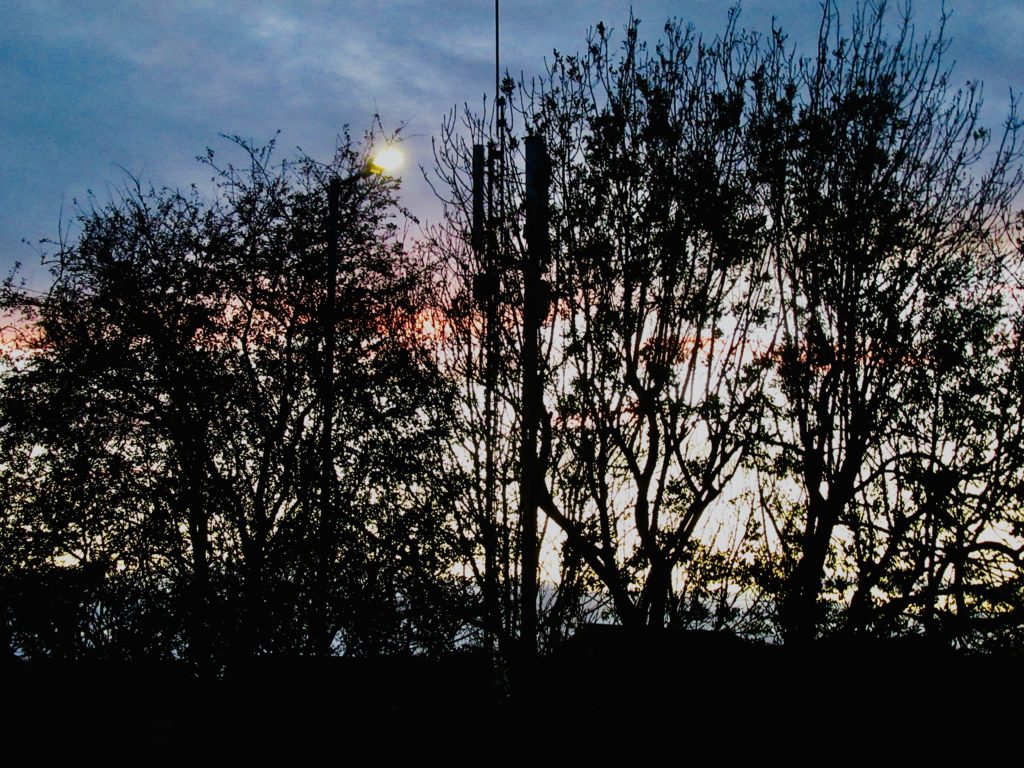
Letter from Glasgow: ELECTION SPECIAL
I used to get up early, a long time ago now. In my younger years I was incapable of lying in. I would wake in a state of quietly suppressed panic, a sense that time was running out on me, each morning. Once I had children I uncovered an adolescent capacity for sleep. For the first time in my life I could sleep until mid morning, if left. I can sleep ten, eleven hours now without stirring, I sleep with a new hunger.
Each year at this turn of the season I resolve to ignore the clock change and to keep getting up at the old time, which is now in the dark. It never works. My former urgency about the day has been outpaced by the claims of my dreams. I try to wake slowly, to stay inside the spaces I have been moving through in sleep, which I am sure hold clues to a parallel story as important as that of my days. The night narrative blurs and disperses too quickly, repeatedly jarred and interrupted by daily life. I keep missing vital parts of the sentence: waking distractions blow in like a wind and scatter the tentative suggestions that the dream puts to me. If I could only listen in long enough, quiet and attentive, this hesitant creature would say something to make sense of the pieces that surface and float about as I wake up.
I am especially aware of these separate lives at the moment. Turning on the news in the kitchen each morning is a conscious relinquishing of night time preoccupations. I turn on the radio and I give myself up to the confident commentators as fully as I gave ear to my dreams. I can’t claim that this switch of medium is too jarring, for I grew up in it. Political commentary is the family business. Like doctoring or music in other families, elections seem to be in the blood, the uncertain legacy of my paternal heritage. My father, his brother and their father before them were the inevitable election night TV “anchormen” from the nineteen fifties until three years ago, their forbears were print journalists. It is hard to avoid election night adrenaline.
What I wonder about is how the language of political discussion became so dominant — not only at our table, but at the childhood tables of many of my generation — as if it were the only possible way of speaking to one another, or at least the most important way. At years of family mealtimes it has been the voices of my brothers: the step, the half, and the one I grew up with, that sound most loudly at the table, seizing on the issue of the moment in a game of to and fro carried on with established proportions of fact, rhetoric and speculation. I have long tired of its assertive dynamic and I follow its rhythm but relinquish the logic to look about the room or to remember something utterly unrelated. Lately I have been thinking about this table talk and about who gets a word in. I wonder about the sort of conversations that were felt to be important at the table, in the world we grew up in, and ones that were not encouraged. How did it come about that these unyielding walls of language seems to be the only ones we have to speak to each other with? Why is it that we might want to say one quiet thing and end up led astray repeatedly by the rules of the game? I think about all the words, the conversations even, kept inside.
I imagine other tables, other families and conversations. My friend tells me of the hurly burly of talk and noisy intimacy that was part of her early childhood in Teheran. She sees the English reticence, the preference for political discussion as a sort of politeness. A formal distancing. Certainly in our English culture there is no threat of over intimacy — the “crawling into the soul” of your interlocutor — that the Russian conversational culture we both sought refuge in can be prone to. We spent many hours at kitchen tables in Russia, listening in. I idealised Mandelstam’s written accounts of the continuous improvisation of domestic table talk, with its sing song repetition and variations, half-phrases, half-words even, intonations, echoes and choruses that everyone is familiar with, a communication that is rhythmic and musical as much as conceptual — for diversion and reassurance as well as for argument. I found something similar in Natalia Ginzburg’s account of family talk (Lessico Famigliare, 1963) but I am wary that other people’s chaos is liable to look more inviting than the one we are born into.
I had been concerned that my current obsession with dream life was an evasion of the politics of the day. On the first night of the US election count I went to bed early. The next evening, as things became a little more hopeful, I gave in and channel hopped, from BBC to Sky, to Russia Today and Al Jazeera. The reassuring bath of commentary, of political babble, rocks me in its familiarity and yields a vivid dream: I was about to give a talk to students. I hadn’t written any notes but no matter, I would improvise. Then I realised I hadn’t prepared any images either. I regretted this. When I arrived for the talk there were a few students but the space was crowded with other familiars — there were my mother and father, separated for twenty eight years, standing at the far end of the room. I watch them, face to face, about to speak to each other directly. Someone hands me a muddied score, a sheet of music — entitled, what I first read as Fratres, as in Arvo Pärt’s composition, until I look more closely and the letters of the title rearrange themselves as Fathers. Is it for me to play, to sing? The song of the Fathers? Fathers and Brothers and the noise of political argument. The slenderest optimism about the renewal of debate in the US has become — with typical over egging of the dream pudding — an image of unresolved conversations in my life. I am subject to the political discourse on TV as to all the other unwitting inheritances I carry and it is futile to try and draw boundaries between the two.
The public discourse seeps in. It is there in the house you grew up in and in the table talk — the conversations that were and were not had. The domestic is the start of it all, as Mandelstam and Ginzburg showed so well — both kernel and scope of our speech — determining, by its attention and its prohibitions, that which remains unvoiced, the things we become preoccupied with.
November 3 to November 10
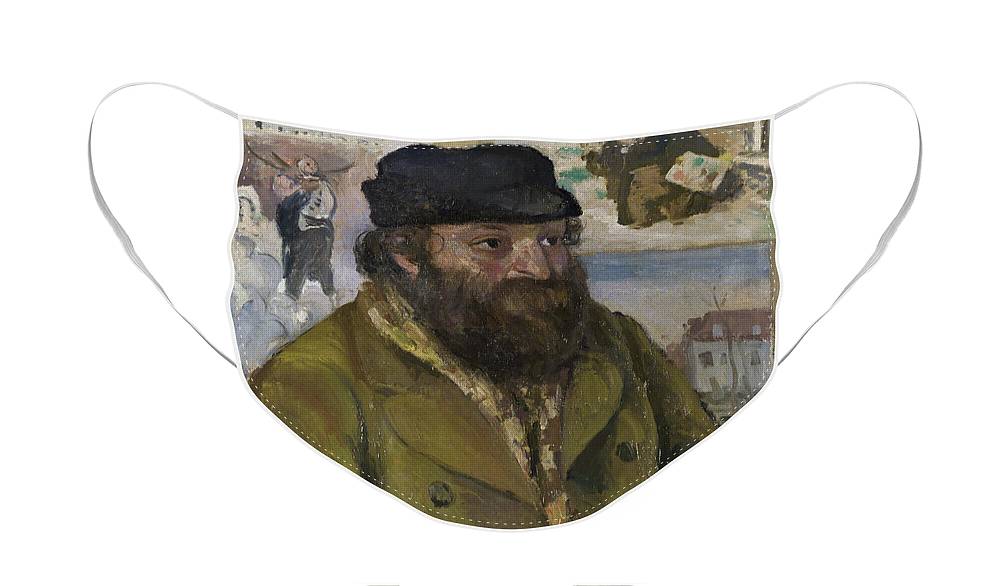

Letter from Glasgow: AFTER NATURE (28/10/20)
The natural world is getting louder again. Lately it seems to be demanding attention, insisting on our focus in the way that it did in the spring of early lockdown. It is noisier, more noticeable as we walk through subdued streets. This must be a sign that our ordinary distractions are in retreat and that soon, by choice or by curfew, we must go inward, to the measure of our ability, circumscribe our movements, make no plans, keep watch and listen, in and out. I enjoyed it last spring— that sudden vivid detail in the overgrowth — I enjoyed paying attention to it but I wonder what such attention will yield this time. Already the cushioning abundance of leaf yellows is being swept away in wind and rain. Then comes winter and its attenuations. I crave yellows. I sink in to Vuillard interiors of the 1890s, the glowing wallpaper worlds magnified on my laptop screen like a forest enclosure, a hushed space full of falling leaves, lit from within.
On the train last week I read an article about Pissarro and Cézanne.* I looked at the reproduction of Pissarro’s cabbage field, Le Champ de choux, Pontoise; purple, green and silver light, printed in the paper. I read the words describing the painting and I looked from the train window to fields of purple and green, fenland furrows and brassicas, picked out in silvery light. No person in the fields that fill the space of the window. No person in the carriage to distract me from looking. The world is sharp with detail now for the many months of not looking from train windows, not journeying through fields. Pissarro’s field is here where we are, says the writer. “Now as we live it, a unique kind of permanence” and he lets slip that it is also the “bleakest sea”, for it is hard to reconcile oneself to being alongside, even surplus to, a world that does not shape itself to our need or our seeing. Hard to keep putting the world into paint without being its hero, without narrating it or sensationalising it, without making a composition of it. These field paintings present a sort of self subduing, a short lived and tentative truce between painter and world. And then it was gone. Cézanne’s paintings, placed here alongside those of his elder friend and fellow painter, are reinforced in their effects of slightly dizzying displacement, estrangement even.
Modernity is Loss Of World. The writer himself disclaims this as a cliché, but one that “draws blood” with Cézanne. Such sentences read differently at the moment. The thought of loss of world has a new twist and is no longer just about painting, or picturing even, though it is also all the more about that. We are trying to feel a way back to the world, a way of being alongside the world, of being ourselves, without insisting always on our share or on more than our share. Take a deep breath, take in the leaves and the wet shadow prints on tarmac of the leaves that have been swept away.
* Strange Apprentice T.J. Clark on Pissarro and Cézanne, London Review of Books, 8 October 2020
October 27 to November 3

Letter from Glasgow: COMPANY (III)
Last week I went to London. I had been away from the city for almost nine months, the longest leave of absence in my life. I hardly believed I could get there again. I pictured it as an ominous tunnelling through darkness. I left in the dark, but after six hours on a train, silent and masked, there I was, in London at lunchtime, in the autumn sun. It was quiet, like Sundays or Bank Holidays used to be in this city many years ago. The pavements were bare enough of feet for their pale stone to echo the light of the high buildings on the streets and squares.
I worked for two days and on the third day I met my friend in a public garden in a square just south of Piccadilly. We are not allowed to meet in her home so we met there. We arrived almost at the same time and sat down on different benches on the same side of the garden, then I got up and saw her, sitting on a bench. We waved and stirred the air around us in enthusiastic gestures of embrace. Like this city, my friend and I have rarely been separated for so many months.
I sat down at the other side of her bench, which was set in and enclosed by a sturdy hedge of yew. We sat on the bench, looking forward, into the enormous plane trees and the yellow light, and we talked of our children, of books we had both read long ago, and the ones we were reading now. We let the pictures made by our words float across the yellow leaves that filled the square, across the strips of dusty sun and trunks of trees. The almost empty square was now full of pictures, from books and from our lives. We laughed the way you can only laugh when side by side.
For three hours we kept company. We got up once and made a circuit north to the vast Waterstones bookshop on Piccadilly. I stood in the stairwell and looked up the concentric silvered rectangles of the once department store. Each floor seemed immense. No-one was there and the bright coloured paperbacks set on tables in the empty space seemed flimsy and irrelevant. More than ever this Art Deco immensity felt like an ocean liner, where everyone had fled. Only one man sat waiting behind his perspex screen, to receive and calculate the cost of the three books that my friend chose.
The bookshop was oddly enervating. We left it and went back to the square, to resume the space that resists time — of friendship and talk, under those enormous autumn plane trees in the soft afternoon light, until it was time for me to go. Urgency reclaimed me and we said goodbye in a hurry as I ran off to make my train. I left London looking backwards. The slow and now silent train north through the fens. These days one must travel in silence. I look back as we leave London behind, and hold our conversation close.
October 20 to October 27
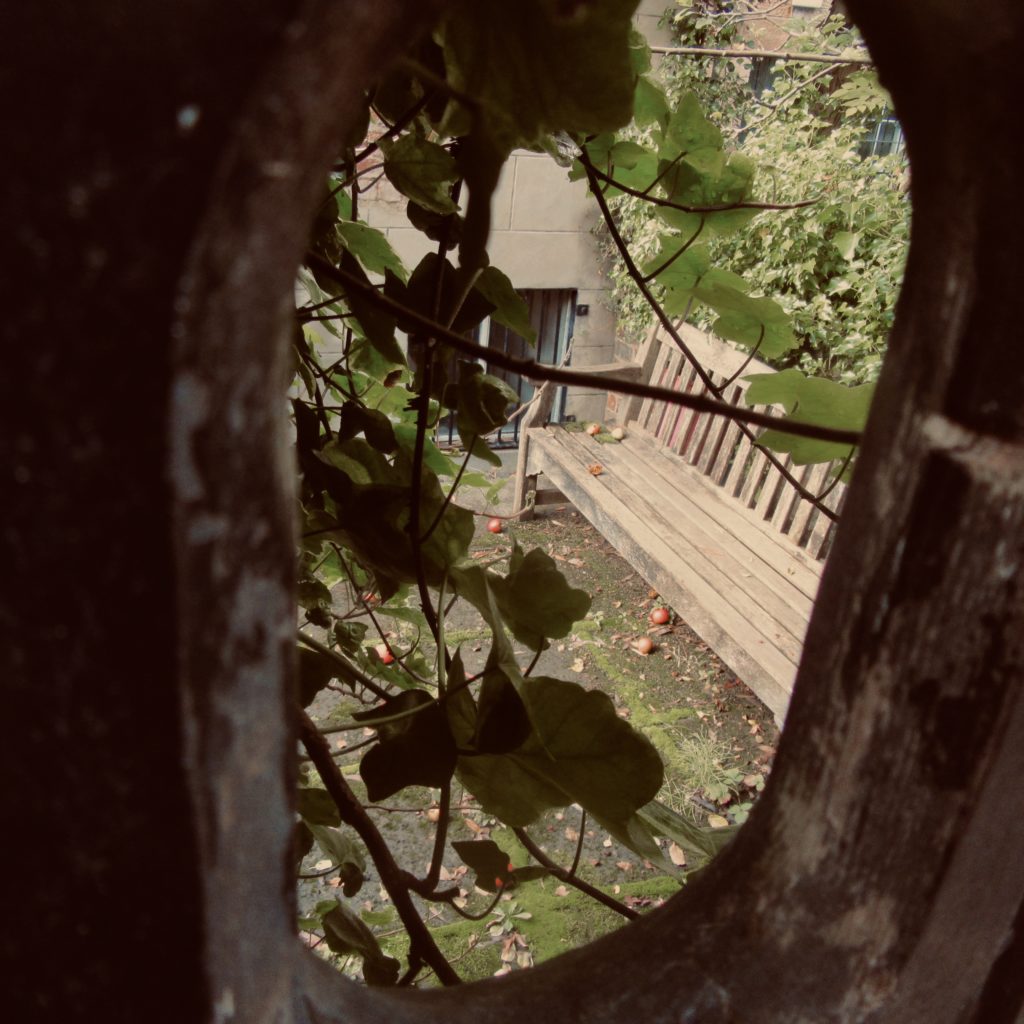
LOCKOUT
Conversation (…) is what explains us best. It supplies and shapes all our thoughts yet we think little of it because all vocal creatures use it.
Conversing with ourself is thinking when done consciously, dreaming when not. Conversing with others enlarges both faculties.
Alasdair Gray The Book of Prefaces, 2000
October 13 to October 20

Letter from Glasgow: COMPANY (II)
And in the morning the sun was shining and everyone was beginning their work.
My habits are the same as ever. I walk the children to school and then walk back towards my desk, turning over images I might work with when I get there. There should be more space for this now, now that I am not always about to be leaving, packing bags to travel for teaching, or to take the children to visit wider family. We are staying put. I stay put on my own in my room each day, as I always claimed I wanted. But most of my closest friends live in other countries and I have not even been to London, which is also another country, since February. This luxurious confinement is beginning to wear thin. I miss the company of friends, who put me at my ease, take me out of time for a moment and return me to my work with new air, light and purpose.
This morning I walked home as usual down the long wide road that runs east-west, from the motorway to the hill of the University. The street runs between the Art School and the University, but the motorway was rammed through this line in the sixties which meant that most of the large nineteenth century flats became cheap rents for students. The rounded end rooms of these sandstone tenements form turreted towers, four floors high. Each room has a curved window with five tall glass panes almost floor to ceiling, facing east, south and west. When the sun is shining it fills up the rooms. I love the look of these empty rooms, like watchtowers, full of light, and this morning, thinking about my missing friends, I put them here, each in a room of their own, filled with sun. The sun is coming in on them as they get down to their desk or easel and I am walking along the road, looking in. I wave up to them as I pass and they wave back. The morning is full of promise. We are waving, acknowledging each other at the start of our shared day’s work, and then I head home, the sun on my back, to resume my own, having drawn strength from their company.
Work as if you live in the earlier days of a better nation. In the late Alasdair Gray’s rewording of lines by a Canadian poet. There is something utopian in this picture that comes to me this morning of everyone, in sunlit rooms, waving and saluting each other’s solitary work. Alasdair Gray believed that we should work to realise utopias in our own cities, neighbourhoods and communities, in the measure of our means. In January 1987 he and a group of others responded to “the unease felt in the present state of society” and declared a Free University to be established from the living room of number 340 of this street, West Prince’s Street. It would be a place that anyone could come to, a space for sharing debate, knowledge and performance as well as books and cheap food. A common library and sitting room were important.
In 2010 a student at Glasgow University proposed their own room in a flat at 61, West Prince’s Street as a Room of Flexibility. It would be a part of Glasgow Open School, initiated the same year as a critical response to dominant modes of education, a sort of Free University of its own, with an emphasis on sharing and experimenting with ideas, knowledge and artistic practice. The proposal echoes much of the Free University’s declaration from the same street twenty three years earlier:
I’d like to propose space in my flat at 1/1 61 West Princes Street as space for flexible usage.
A bedroom with windows, floor space measuring 7 x 5m
A boiler cupboard that we could possibly use as a library
The space could be used as a place to find out information about the workings of the school, could be cleared for movement events, could be set up with tables and chairs, could be used for painting etc
The space is equipped with wireless internet access for all participants and visitors, it also has tea and coffee, and use of kitchen and bathroom
The space would incorporate a cupboard sized library of donated media which can be freely copied and used for study.
The idea might be seen as utopian. But it is also simple and now that the University and its libraries are closed, the tutors away and students left in their rooms, it may be what is needed.
West Prince’s Street is replete with topographic curiosities. A walking tour led by a well known crime writer last month took socially distanced participants to a famous Victorian murder site, to Glasgow’s first gay nightclub (opened before the law to decriminalise homosexuality came into effect in 1981), the flat where Postcard Records label began and to Glasgow’s Theosophical Society, but it does not mention numbers 340, or 61 (except as a notorious party flat along with the murder site at number 41). This seems a missed chance, especially as city walks were key to the philosophy of both the Free University and the Open School.
Work as if you live in the earlier days of a better nation. A message, and not just for Scotland. I am reading essays by the Chilean writer Alejandro Zambra. He speaks of the long hours spent talking to no-one that is part of a writer’s work: They say there are only three or four or five topics for literature, but maybe there’s only one: belonging. Perhaps all books can be read in function of the desire to belong, or the negation of that desire. To be or not to be part of a country, a community, a university, a family.
Belonging, which has longing in it.
October 6 to October 13
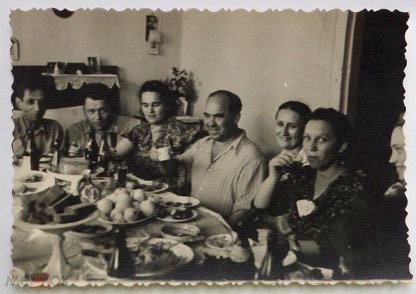
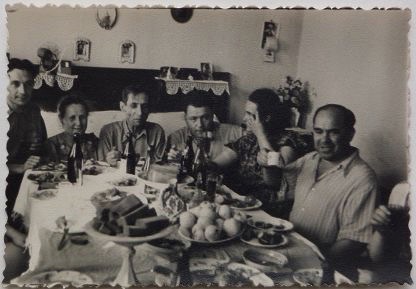
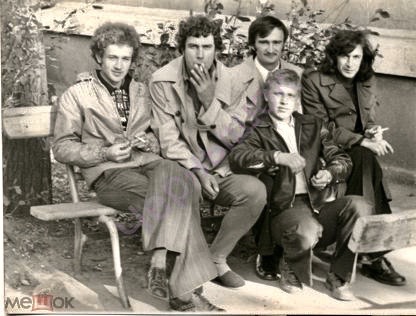

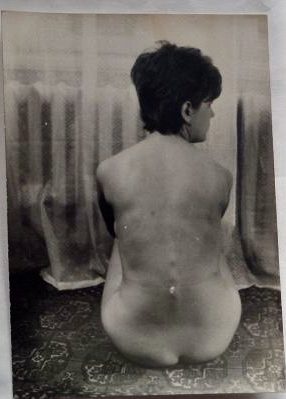
Letter from Glasgow: DISCARD
I photographed the firework postcard for my letter from Glasgow a fortnight ago and then lost it again. It was reclaimed by the sea of papers on tables, in boxes and across the floor of my room. I searched for it online, to remind myself of its existence, and found it on the site of the Russian secondhand trading site Meshok. A meshok is a bag, it could be a rucksack or a string shopping bag with holes in it, both imply expeditions, a bundle to carry essentials for a journey. You would carry one with you at all times in the days of shortages, in case you chanced on a sudden delivery: apples, bananas or even bottles of Kabernet red wine, being sold directly from the lorry. I found the missing postcard in Kazan, on sale for just ten roubles, about ten pence. I emailed a friend in Russia, and within half an hour she had replied, saying that she had bought the postcard, it would be sent to Moscow and she would bring it to London this autumn and post it to Glasgow. It arrived in Moscow this week and Polia sent me a photograph of the postcard emerging from its envelope, with a stamped form detailing its progress, through customs inspection at various airports, from Kazan.
I had lost the postcard, but I found the website, and was soon immersed in its pages. The array of disparate objects being sold here reminded me of the street sellers who used to stand on the Moscow pavements in the nineties, a small cloth laid before them, and on it their spaced out offerings. A spoon, some embroidery, a reproduction of a painting in a frame, a calendar, not necessarily that year’s, a half full packet of tea, a single egg, potato or a few carrots, strands of dill, even a portion of a loaf. It was as if people were offering their very last possessions, as though, like assiduous bailiffs, they had brought out from their houses anything that was not fixed down, everything but the kitchen table and the bed. The old women stood behind their squares of cloth waiting stubbornly in the sleet as passers by sized up what was on offer.
The online market does not quite have this pathos, but like the squares of cloth on the pavement it provides a frame for things that you might not otherwise notice. There is an entire section for lids, stoppers and bottle tops. Soviet-era jars and bottles, with or without their contents, empty biscuit boxes made of rough printed cardboard, yellowed receipts, train tickets, official forms and passes are going for high prices. The photographs though, are cheap. They are sorted by era: Pre-revolution. 1918-29, The Thirties, Second World War, then 1946 to 1989. Amateur photography became widespread in Russia after the Second World War, partly thanks to Russian acquisition of equipment and technology from Germany as “reparations”. It was encouraged by the state, but there were rules. The explosion of low cost mass photography was not quite the universal liberating medium that Rodchenko and other avant-gardistes had imagined. These unspoken constraints are evident as I trawl through the home photography on the website.
There are persistent themes: work outings, friends at the dacha or the beach, weddings and celebrations. The images are tagged simply: Youth, Happy Women, Swimming fashions. They make me think of the artist Boris Mikhailov. His photographic series, Beach at Berdiansk, Sots Art, and Luriki, made in the seventies and eighties, subvert the naivety and restraint of these domestic scenes. Mikhailov was an amateur, an engineer in a camera factory who took a series of nude photographs using a work camera and lost his job. Then he became a photographer and retouched old family photographs for a living. Although not taking pictures of naked people was one of the rules there are many examples of its infringement on the website, tagged Soviet Erotika. The photos are amateur, domestic, and usually no more disturbing than the back view of a woman, reassuringly solid of build, with strong thighs and idiosyncratic curves. This back to camera view, often with the woman kneeling on a homely blanket, seems to be a favourite, with a diaphanous swathe of nylon netting to one side. There are front views as well, but these are also demure, the woman usually hiding her face from the camera. One of the tags is Drunk People, although these appear to be just groups of smiling people. They are certainly not drunks in the sense of the homeless alcoholics, that Mikhailov photographed and made famous in his later work.
The unwritten rule of not taking pictures on the street, unless of a family member at a park or tourist landmark means that everyday street scenes are tantalisingly rare. I rummage through these photographs as I might through a box at a market stall, almost at random, but needing to glance at each one in case I might miss something. Now and then something draws me in, a strange glance, or something unusual in the framing. I pause at pictures where the aesthetic conventions have gone awry, a blurred face in the foreground, a camera getting too close, or at an angle, but these are the exception, and mostly the compositions are almost indistinguishable. There are many zastolye, gatherings around tables laid modestly, or piled up with food and bottles. I look into the faces, meeting the camera’s eye, sometimes sombre, and wonder who might be missing from the feast, through the ordinary depredations of war or the less ordinary means of state liquidation. The repetitive anonymity of the images is oddly compelling — the same scenes again and again of constrained permitted pleasures, in lives underscored by fear and prohibition.
One seller has laid out his slightly curled and blurry prints on a faded green baize card table for display. There are portraits, groups, and a series of tourist locations — unpeopled shots of municipal fountains, ornamental urns and classical arches in provincial cities that remind me of the photographs in Kabakov’s Labyrinth installation, which I last saw in Moscow four years ago. In this work a long dark corridor is lit by dim bare lightbulbs, and a series of photographs and typed texts laid on brown paper and old wallpaper are hung in unglazed frames along the wall. The photos were taken by Kabakov’s uncle and beneath them are the typescripts of his mother’s account of her desolate progress through a series of rooms and provincial cities. The narrative is devoid of wit or personal embellishment, like the repetitive and uninflected images above it, an almost impassive rendering of a life of barren poverty, insisted on relentlessly as you move along the corridor, frame after almost but not quite identical frame. The viewer or reader becomes mired in this seemingly endless journey — urgent to get to the end, but bound to read every word, to look at every monotonous image, the very emptiness itself making for an almost intolerable intensity.
I was thinking about my own boxes of photographs and cards, and the loss of the postcard still nagged at me. I have been wondering if I should file my images more rigorously, but I can never work out what system I should use. As soon as I think of one, I know that it might exclude another, perhaps more generative pattern, and sometimes I think it is better to just keep all the images in boxes, in no particular order, and hope that the ones I need will surface at the right time. Such deliberations remind me of another work by Kabakov: The Man Who Never Threw Anything Away, where the complexity of deciding what things should be saved and what should be put in the bin becomes so fraught with decisions about order and value that it is decided that everything must be kept. Kabakov’s tale ends with the evocation of a vast cosmic rubbish dump, containing everything that has ever been discarded, a submersion in and resurrection through rubbish… It’s hard to say what kind of image this is, he wrote in 1977, maybe it’s an image of a certain civilisation slowly sinking under the pressure of unknown cataclysms, but in which nevertheless some sort of events are taking place. The Meshok website is like one of Kabakov’s imagined rooms where every last bus ticket or piece of string has been kept and assigned value. I am glad that I can only see the objects on a screen, for if they were set before me in real life, I might feel a responsibility towards them, to keep them safe, and then I would have to decide how to file them.
Last night I dreamed of a journey I was making back to this city from the other side of Europe, from Russia, even, by train and by sea. I had a huge suitcase with me and into it I was tipping endless small things, a mountain of buttons, papers and packaging. I don’t know why I am hauling all this detritus with me but it seems that I have no choice. It is an uncertain journey and I don’t know if I will be able to take all of these things with me, still less whether I will have time to realise the work that might transform these random things into something more coherent. When I wake up I remember that the difficulties of making such a journey are not just part of the dream, they actually exist. There are so many travel restrictions to negotiate now that my path would be fraught with obstacles. I am used to the obscure impediments encountered in journeys that I make in my dreams, but to wake up and realise that a real life journey could be even harder to accomplish is new.
September 29 to October 6

Letter from Glasgow: VIRTUAL
Today’s Guardian shows a photograph of the University cloisters that I was walking through in last week’s Letter. Six hundred new students have been told to self-isolate in their halls of residence and more than a hundred have tested positive for the virus. The gentle revelry that went on in the night spaces of the building is over. The virus can of course spread fast in crowded halls of residence and multiple occupancy flats, yet the students were encouraged to come back, in spite of libraries remaining shut, and teaching being entirely online. A few days ago I bumped into a woman I know a bit, she lives in our neighbourhood, in a university flat. She is from Poland, finishing her PhD. She told me that the open air cloisters were going to be booked for teaching sessions, where just a few students could learn from a tutor, leaning against the pillars in these airy spaces. She was pleased at the thought that these imitation Medieval spaces might find part of their original purpose — a space for disputation, a forum for Socratic dialogue even.
It is unlikely to happen now. This locked down spring I used to wave from the kitchen window seat where I would sit in the mornings, to a theatre student, as he opened his curtains in the corner flat opposite. I knew he studied theatre as the window was near enough to be able to read the titles of the text books on his desk. I never saw him on the street, and now he is gone. At night, across the back courtyard, the windows of student flats on the other side make a lit pattern of orange and red, pale pink and bluish rectangles, seen through silhouettes of the branches between. The patterning of light and colours rearranges itself a little each year, and variously each evening. I keep company, as I prepare food in the dusk of autumn evenings, with the lights on in other kitchens, steaming up with cooking. I watch the students coming and going, although now there will be less going out, and the lights will go on longer in the evening, holding their pleasing pattern of oranges and pinks. It was always harder after the end of term, in winter, when they went home for the holidays. The darkest days, and a wall of solid black, unmitigated by any lit signs of life. So I am grateful for their presence now, at this turn of the year, as the inner light slowly gains hold over the outer, but I don’t envy them.
In the building where I live I pass groups of students each day on the stairs. They are the majority inhabitants here, living five to a flat, and their faces change each summer, just as we are beginning to learn their names. The permanent residents stay hidden behind their doors, either recluses or “sheltering”, or both. These turn of century “European” apartments, or tenements, with their shared stairwells and high front doors, remind people of Berlin, or of Russia. For me they are a compromise, allowing me to pretend that in some way I am still living in Moscow. The arsenic green walls in my kitchen, that I peeled through layers of paint and paper to uncover, sustain this illusion, and the way that the doors to rooms lead off from a central hallway. Old canvases stored two metres high up on makeshift shelves, next to outdoor shoes and a sledge in the low lit space between the outer and inner front door feel the most Moscow-like place of all. And then there are my bookshelves, storing my yellowed Soviet journals, postcards and editions of Russian collected works, Belinsky to Zoschenko.
I had been reading this week about Russian communal flats, early Soviet kommunalki, their ethos and evolution. I found a website dedicated to the kommunalka, where you could make virtual journeys from room to room, watch interviews with the inhabitants and read articles on daily life in these spaces divided up from large pre-revolutionary private apartments. I read about the ideals that championed bare lightbulbs and unveiled windows over bourgeois lampshades and curtains. I used to be a great fan of the bare bulb, and there is of course one coming out of the wall in the between door space, though I have sneaked in some highly bourgeois lampshades, half broken, hand-painted, with fringes even, salvaged from our studios. I keep my windows uncovered and approve the unofficial etiquette of not drawing blinds or curtains in this neighbourhood. I’m not sure if it is to do with a Socialist spirit but it feels important now, when almost no public or communal life is permitted, to see and be seen by the people who live across the road, or across the back gardens, to communicate quietly as we all go about our ordinary tasks.
I am pleased that the photographs I took of my stairwell — the light and peeling paint and tangle of unconcealed cables — are almost indistinguishable from the images of the chernyi khod or back (literally — black) entrance that leads to my friend’s father’s studio in Moscow. These stairs connected by a back door to the kitchens of larger flats and were used by servants and tradespeople before the revolution. This now blocked off stairwell space was a source of inspiration to Yuri. He spoke of its dereliction that enclosed him in a sort of parallel world, at times a more palpable reality. Thirty years ago we used to climb the stairs to his attic studio, to draw, drink tea or listen to Yuri talk. It is the staircase that he still climbs today, more slowly now, in spite of so many threatened reclamations by property developers in the lawless post perestroika years. I want to go back and sit there around the low table, I can feel the rough material of the unsprung sofa and hear my friends telling their stories of the different places they lived in, communal flats and other flats, in Moscow of the fifties and sixties. I want to sink deep inside my other language, as essential to me as iron in the blood.
I emailed an image from the communal flat website to my friend in London, who had lived in a kommunalka off Moscow’s Gorky Street in the early nineties. She told me vivid tales of shrieking reprimands endured whenever she infringed one of the many unwritten housekeeping obligations. The image I sent her was a broad corridor with shiny brown lino, a nineteenth century pillar half concealed by a rough partition, yellowed walls fissured with cracks and exposed wires, and a brown bakelite telephone in the corner. She wrote back straight away: It’s so odd the way that you can feel sights in your body and also smell things instantly just from pictures… That is what we must do for now, finding these imaginary places to walk around, tripping off our nostalgia. So I continue walking this halfway house, one foot in my flat, travelling off through windows, or my computer screen, and all my journeys are virtual, which means almost, but not quite.
September 22 to September 29

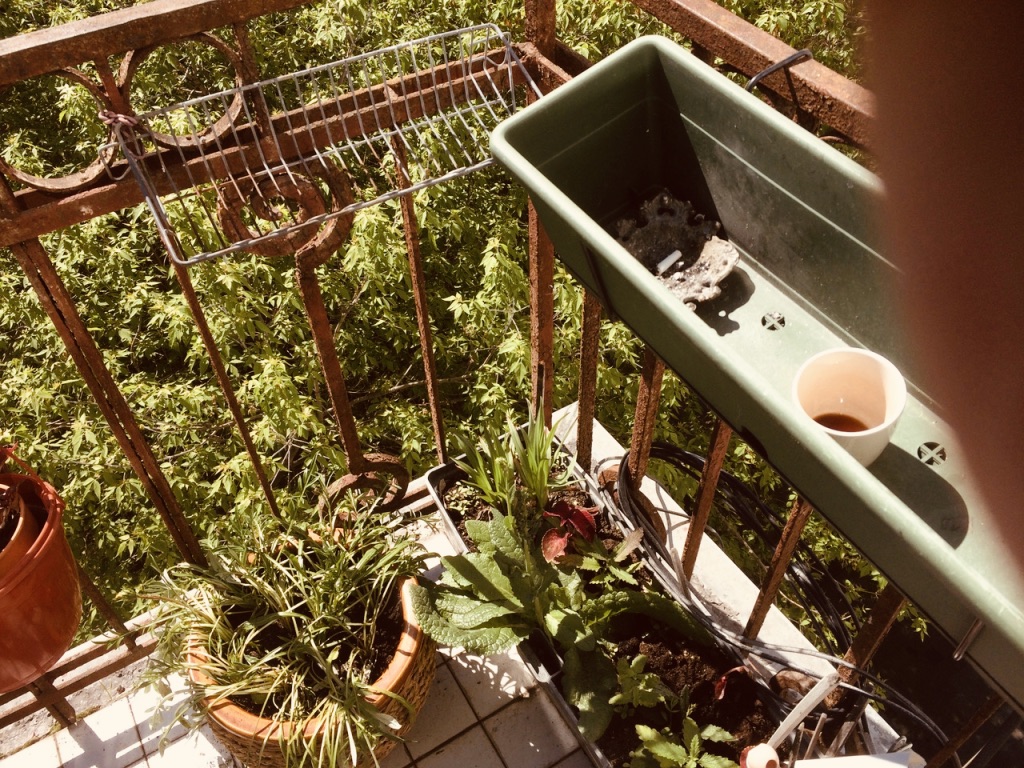
Letter from Glasgow: ASH
The yellow days edged with airy sharpness that used to signal September, and the return to school, are missing this year. Instead there are monsoon rains. It rains day and night and just when you thought it could rain no more it starts to rain again. In the large communal gardens by the park the mossy tree trunks, soft earth paths and blackened branches of rhododendron glow in a dank swelter. I look in through the railings and think of Victorian colonial city gardens in India, or Africa. Calcutta, not Glasgow.
I have lived here, in a rainy country, for twenty years, but it is the first time I have taken an umbrella out. We cross the park to school, trying to balance this flimsy umbrella to cover both me and my smaller daughter. I was given the umbrella by a friend, it is almost ornamental, swirled with a sludgy green painted pattern. As we walk into the park I notice other people under their umbrellas. They are, like me, relaxed and upright because although the downpour is enormous, the temperature is warm — sultry even. Steam is rising from the path making a smoky curtain, and the umbrella figures are silhouetted against the haze. I think how elegant they look and I remember a painting by Peter Doig of a man walking by a wall, in Trinidad, holding an umbrella, also with painted swirls, against the sun. With this thought of Trinidad, and the unseasonal steaminess, the park, and everyone in it, takes on a holiday mood, an unlikely elegance and exoticism.
I went home and forgot about the strange weather. But when it got dark I realised that I hadn’t left the house since morning. I walked out, down the street and into the University. The air was still properly warm, and smelt sweet, as though of tobacco plants. The gates of the University were wide open although it was past ten o’ clock. A student sped in ahead of me on a skateboard. Inside, groups of students were strolling about, skateboarding, wandering in the open grounds and through the courtyards of the building whose classrooms and lecture halls they are not allowed to enter. Here in the dark, in these night cloisters and quadrangles, they seemed to be improvising the student life denied them by day. There was a smell of dope and undergrowth. I walked out to the brow of the hill, where the pointed towers, windows and gatehouses are lit up orange-red along its length. This massive neo-Gothic façade takes up the whole of the hill, blocking out any sense of the city beyond it, like a boundary wall. The building faces south over trees, the rooftops and lights in the city below. A band of reddish haze was stretched the width of this southern horizon. The haze made the scene unfamiliar, almost foreign, and must be something to do with this unseasonable heat. From this summit stepped lawns slope down steeply. The students were sitting, alone and in groups, on the stone benches and on the grass at the brink of these sloped lawns, looking out into space of the night sky. They too were tinted by the reddish light. It looked as if they had just been watching a firework display.
These colours of warmish red, this dark warmth and nighttime holiday mood accentuated the sense of foreignness. But the scene reminded me also of a postcard that I had for many years kept stuck on my wall. It was a dark painting from a postcard set that I had bought in Moscow when I was a student there thirty years ago. It showed a firework display over the city. In Russia, a firework display is a “salute” . On official celebration days we used to see them from my friend Masha’s balcony, which looked south in the direction of the Kremlin.
Now you can no longer see the fireworks, as an oversized private apartment block has been built on the street where she lives, blocking out the view, hiding the dome of a church in the mid ground and the distant red Kremlin star. The new building, like most in Moscow, has dodged the planning regulations. Masha’s son made a solitary protest against it when it was being built, he got drunk one night and drove his car into the building site. He was charged, fined and deprived of his license, which was unlucky as he was earning a living as a taxi driver at the time.
I wanted to find the postcard, although I knew it had not been up on my wall for years. The next day was cool and there was no rain. I hunted for the postcard for most of the morning, through bookshelves, and inside books. I did not regret the time, for I also removed the dust that lay like a fine film of ash on my shelves, that I had not dusted for months, not wanting to disturb the postcards propped against the books. Eventually I dug it out, from a brown envelope in a box, under a shelf. The image was darker than I remembered and the reddish buildings lit up by the lone firework were not the Kremlin, as I had thought — the conventional backdrop to the painting genre of Soviet firework celebrations — but the construction site of a new housing estate on the outskirts of the city, with cranes high over the dim outline of some domed churches. At first I was disappointed that it was not the view we used to see from the balcony, but then I thought that it was good as it was, with the lit cranes and building site almost fading into dark.
Outside the sky was cold and colourless again, and I remembered that almost nothing was going to happen.
September 15 to September 22
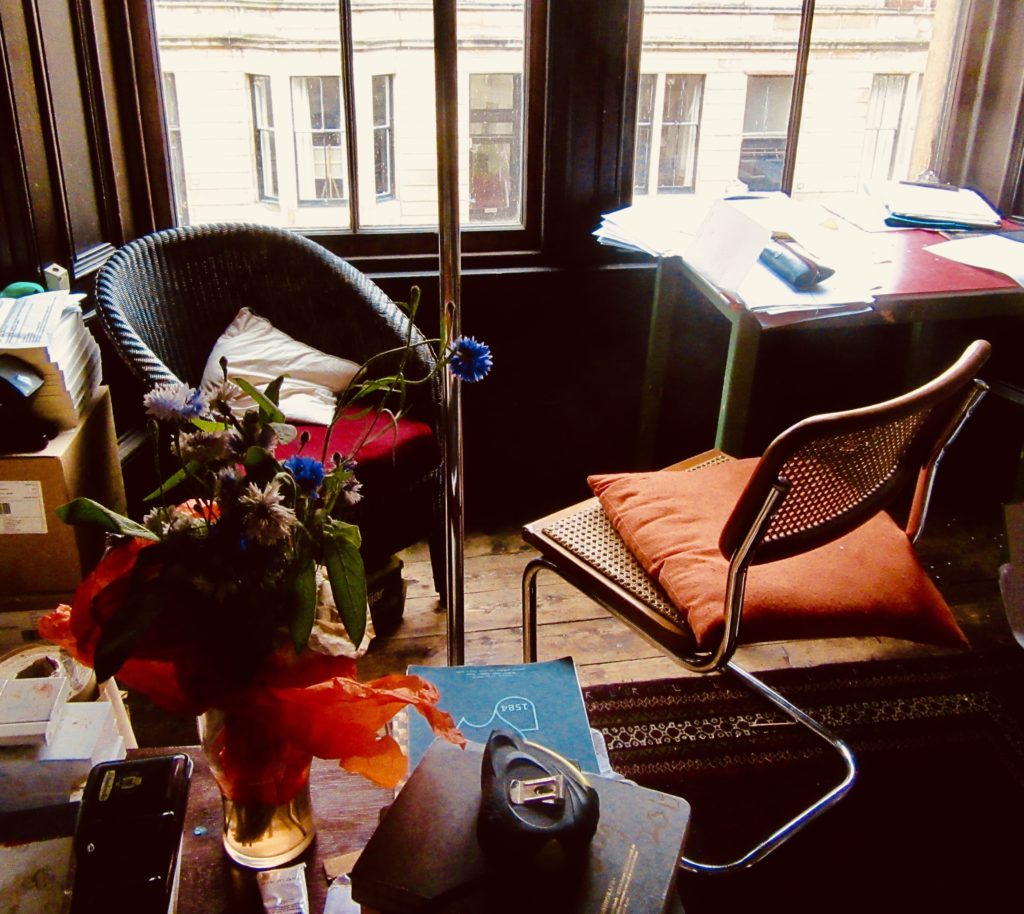
Letter from Glasgow : AUTONOMY
The cornflowers from my birthday are losing their blue, they are leaching their deep blue daily, becoming papery grey. I don’t know where the blue goes to. The dark orange tissue that they are still wrapped in dissolves its colour into the pint glass where they stand, and the water becomes pale orange, like paint water.
Outside the colour is yellow, gaining each day as leaves fall and stick down on wet pavements. There is also a spotting of red, from the rose hips and rowan berries that are abundant this year. And there is the acid yellow smear of the high-vis vests of delivery men in the rain. Soon it will be autumn, the yellow season.
What if you were to inhabit space, and move through it, navigating only by colour? Marking your way by the movement from an orange to an orange, or a red to a red. Fixing yourself in space in relation to the disposition of colours. It would not be any more arbitrary than the attempt to make sense of space by the linear divisions of days, dates, and numbered years. In fact I suspect that trusting to colour to find your bearings might be more comfortable — gentler, less vertiginous. This density of colour here connects you to that blur over there, and so you would feel more held in space, or the space itself might seem more reliable.
I used to want to make paintings that I could inhabit, I imagined canvases that a person could enter into and move about inside. Perhaps this was the same instinct, to find colours that might open up the space around you and allow you to move through it. But my default is line, drawn or written lines, entangling or seeking infinite space. I am used to lines and perhaps they seem safer to me, I am habituated to them. They offer an illusion of precision. I hold out my pencil. I make a measurement from here to here. I experiment with various calibrations. I fill in the rectangles of the desk diary. I drew a diagram of past months and years, ruling twelve lines against a spiral of seven or nine concentric circles like a tree trunk, to catch and inscribe in its incremental segments the events and recurrences laid down in those dates. I keep notes. Sometimes I even dare to look back at notes from other months in other years, but not often. Today I am trying to forget these and letting myself follow light, and colour. I am testing the water, seeing if I can keep afloat that way.
My friend sent me a book for my birthday. I opened it that morning and sat down by my window and read the first chapter, which was the story of a woman, in mid life, on her birthday. It is the morning of her birthday and she is wearing a tobacco brown robe and tobacco brown slippers. She is writing a letter to her son. By the end of the chapter she has changed into her tobacco brown trousers and is rubbing her feet through tobacco brown socks.
I looked up cornflower blue to try and find out why the pigment leached so fast from the flowers. I found that the cornflower, and its rare pigment, has a long association with romantic longing: “This blue flower stands for desire, love, and the metaphysical striving for the infinite and unreachable.” So said the internet, or as the Norwegian scholar H.H. Boyesen put it, this simple blue field flower symbolises: “a trembling unrest, a vague sense of kinship with the infinite, and a consequent dissatisfaction with every form of happiness which the world has to offer.” There is not much information about the fading though.
It is the tobacco brown, rather, that gives me my bearings, a sense of kinship, at the turn of my year. Tobacco brown as pictured in a book, a woman writing a letter who dresses entirely in tobacco brown. Lines to escape by, colours to sink into. I am trying to learn how to inhabit the space I am in without having to picture it or write it down, without needing to be seen. To open it up, from inside out and make the room enormous, as I know it could be. Like beginning all over again, without fear.
September 8 to September 15

Letter from Glasgow: COMPANY
The students have been moving back in. They have come back to the city and have rented their rooms for the year but the university buildings on our street remain closed, so they stay in their rooms. From my desk I look down to a woman in her window, sitting at a similar desk to mine, at a similar laptop, glasses on. Behind her there is a wardrobe, a large bed, lamp and a low table. This is her room. She must be thirty years younger than me but I imagine that I know what it feels like to be her as we sit here opposite each other. I note the rhythm of her work and I approve it. She is consistent, concentrated, she begins early and after about two hours she gets up and leaves the room for twenty minutes or so, I presume to drink coffee, as I do. And then she resumes. She will do three or four hours of desk work at a time, including the break, as I do. I feel happy at our coincident rhythms, although I begin a little after her, since I start work later than I used to — in the time before I had children to get up, feed and deliver to school. So I don’t mind if she is there before me, and leaves the desk a little earlier than I do. I feel that we are still keeping pace, keeping company.
I am disconcerted, though, when she is away from the room for any length of time. Once she was away for a whole day, or even two. The lights in the room were off. I did not keep watch to see if she returned home to sleep that night in her room, but I wanted to. I worry that she has lost her momentum. I am also a bit concerned as she has started painting. When she moved in she set up a variety of canvases around the room, one on an easel and one on the floor, leaning against a table, and several propped against the bay window. There is also a huge painting against the wall next to her large bed, it is the only painting facing me, but it is hard to decipher. I had assumed that these were paintings she had made as a hobby, perhaps over the summer, and that she had decided to surround herself with them to decorate the bare high walls of the room that she is renting. But she has begun painting them again! Now she is no longer sitting at her desk, the two of us held in a silent complicity of reciprocal study. She is on the floor, and she is painting, dabbing relentlessly at her painting and I am at my desk, writing helplessly about rooms and rooms in paintings, and not being able to paint. A long time ago I would have been painting as if my life depended on it, but lately I have kept putting it off and I would rather write about what cannot be put in a painting. I am trying to find out the things that can or can’t be painted, can or can’t be disclosed, in paint language or in words. But the woman opposite, who I now see half-obscured, as a shoulder and an elbow, painting intensely, disturbs and distracts me and I find that I want her to stop. I feel that she was so much safer at the desk. I am worried for her, on the floor with her paints. I am worried about her and the strangely dressed men whom she invited round the other day to look at her paintings. She has been here less than a month and already I am feeling protective of her.
She used to be always alone, but now I count the cups left out on the low table in the centre of the room and often there are two, or three. Once she covered her windows with canvases so that she was walled in, and I could only see the crosses of stretcher bars and the backs of canvas. I could not see into the room at all for several days. I found this disconcerting and wondered if she had noticed me watching her. But I do not think that our eyes have ever met. In fact I am surprised that she has shown so little notice of my room, above her, when I am so endlessly vigilant of her space. She has never looked up, unless when I am not there. But when she put those canvases up like shutters across her window I felt bereft. I thought that it would be too punishing for me to have to keep on working in this way, shut out, while she painted or wrote or did who knows what, unseen by me, or I by her. I moved back to the other side of my room and worked with my face to the wall. However after a few days she relented and I could see back in to the space. I was surprised to notice how dependent I had become on her, and in such a short time. I do hope that she stops the painting soon, it is starting to disturb me, and anyway she looks so much more assured at her desk, deep in concentration, as I am. Soon it will be time for us to break for coffee.
September 1 to September 8
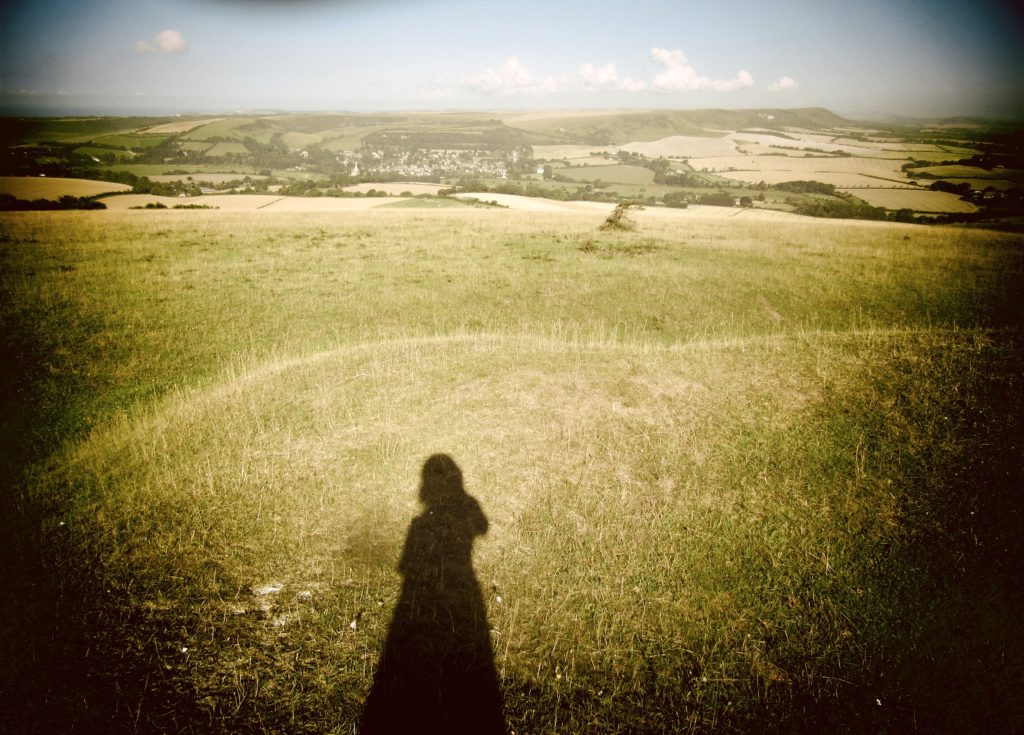
MAP 3: Sussex July 2020/London May 1982
Kaleidoscope
I went to visit my father in England for the first time since the lockdown. I found him in his study reciting old diary entries into a tape recorder: “May 1982, The Pope..”. The small red leather appointment diaries, gold embossed with each year, are stacked before him on the desk, and there are more in piles at his feet. There were large desk diaries as well, that he began to use in the last twenty years, but the small appointment diaries are more familiar to me, with their pale blue air mail paper pages and perforated corners that I could not believe anyone ever took the trouble to tear off.
He said, it is strange, I never remember anything but now that I am going through these diaries things come back, from just a few words. He discovered that his sister in law used to come to our house in Putney once a week, to play her viola, and he would accompany her on the piano. I must ask her what we played, he said.
It is rare that he mentions Putney, where we grew up, the site of his first marriage, and I am touched by this life that suddenly swells vivid and detailed from such tiny scrawled entries.
Sometimes I wake up and I think of all the images that we each contain, so many scenes forgotten and remembered. I have photographs on the wall opposite my bed of some of these scenes from twenty, thirty years ago; there are more gaps than images now as the blu-tack slowly loses its stick and the photographs fall down one by one behind the radiator to gather dust. There are photographs, and photograph sized gaps, and I lie in bed and try to fill in the gaps. I often did not take photographs, having a superstition that picture taking could blur or even erase your perception of the thing itself, that it might turn out to be the opposite of possession. But I don’t know where these pictures in the head are kept, or how they are ordered. I know that they emerge suddenly, as if from nowhere and are summoned by unlikely prompts.
I lie in bed and watch the images on the wall and in my mind. I think of my friends; each of us a walking house of images that we recall perhaps daily or maybe just once. I think of all of the things seen, taken in and stored inside my different friends in the hundreds of years and places that we have lived between us. We are each of us living kaleidoscopes of pictures, in words and image, even as we stutter and jar our own movement, the inward sweep and scope of what might be seen, through our habits and our fear.
What happens to it, this endless variety? How can we even do justice to it, bring it forth to share it? On Prestwick beach my daughter and I stand in the shallows as the light fades, these long flat tides that run in like wide leaves or sheets, fanning out across each other, each sheet of water rilled by a shaft of interior light. My daughter is filming it all on a phone, the light moving in the water, the shadows and movement and the darkening silhouette of Arran opposite. She is excited by it and doesn’t have my inhibitions about photography. I watch her and realise that this is what we do each August just before the schools go back, jumping waves in the sea shallows at sunset and trying to make it last forever.
August 18 to August 31
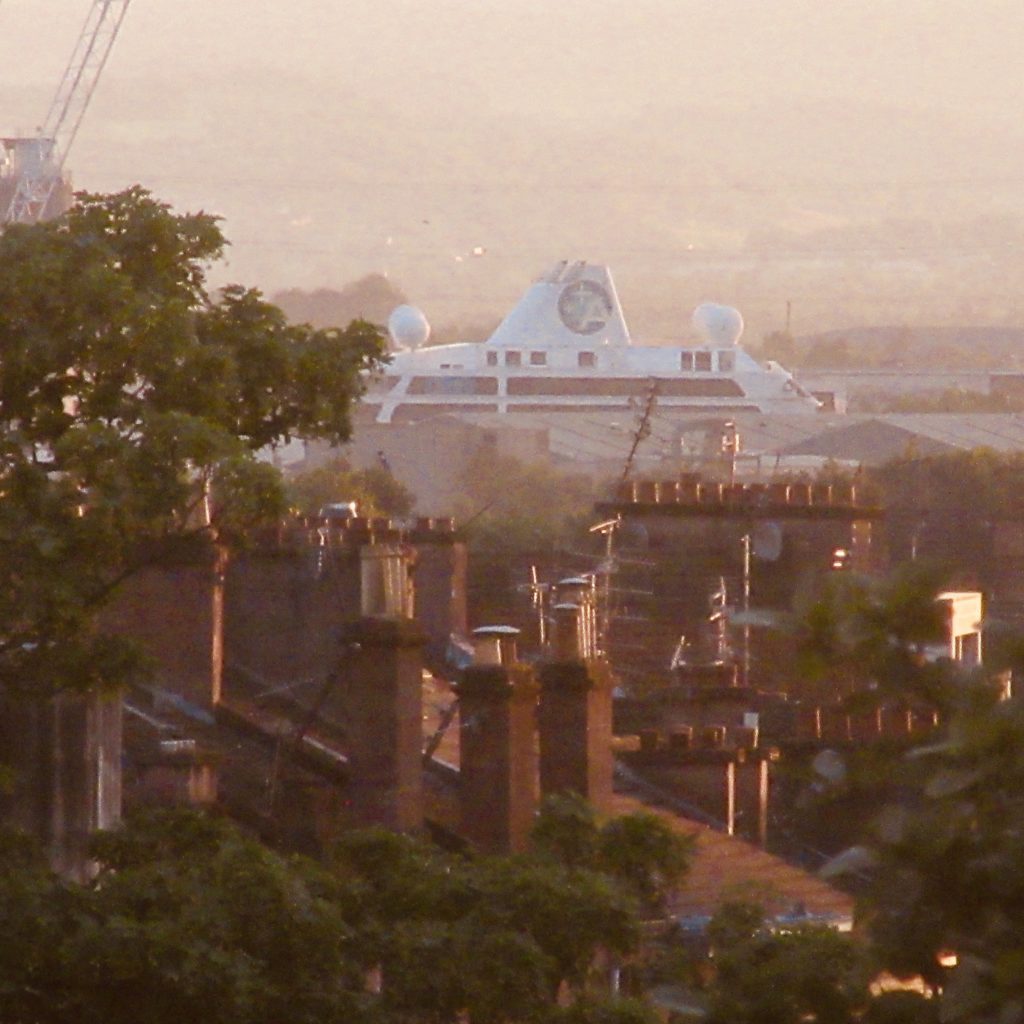
MAP 2: Glasgow August 2020/Russia September 1997
Harbour
Back in Glasgow, I resume my walks around the empty University. The other evening, on the path that leads to the Zoology building, I was stopped short by the sight of a ship seemingly lodged in the rooftops of a descending street. What looked like a white crown against the darkening sky was, I realised, the crested funnels of an immense cruise ship, one of three being harboured in the city until cruise tourism resumes, in some unknown future when it is deemed safe.
I was once on a cruise. It was over twenty years ago. I was asked by an elderly sculptor, a former boyfriend of my mother, to accompany him on a voyage along the Volga, Moscow to St Petersburg. He was over eighty and I was in my twenties but he used to take me to exhibition openings. We used to have tea and talk about drawing and as he knew that I spoke Russian he asked if I would come with him as his guest. He had always wanted to visit Russia and liked to play old records of Boris Godunov as he worked, the deep nasal voice of Chaliapin that so moved him.
Our ship was the Surkov, named after a celebrated Soviet World War II sniper. The war loomed large on our cruise. Most of the passengers had fought in it or if they had not actually fought they remembered it vividly, and so as we moved along the Moscow canal to join the open Volga, through the vast concrete locks built by gulag prisoners in the 1930s, the conversation would come back each evening to famous battles, to Stalingrad, the Blitz, and Berlin. We drank a sweet Georgian wine called Stalin, whom everyone at the table remembered as an actual man on newsreels and in the papers, the living face of Russia.
“The last time I was on Russian territory was in occupied Berlin”, said one of our fellow travellers, a Jewish man who had emigrated from Germany to America in 1938, and fought in the war in Europe soon after. It occurred to me that this was also a reason for the separate sittings for dinner. On the Swiss-owned cruise ship, the German tour groups ate early, at six, and the English speaking groups were seated two hours later. It may have only been a question of space, but it also avoided awkward conversation as it turned out that we couldn’t stop talking about the war.
I was almost the only person on board young enough not to have been alive in the war, but I listened avidly and wrote it all down. I had a lot of time for writing down as the Sculptor would retire early. I could not go to the ship’s bar as I had spent almost all my roubles on old books in Moscow, before we set sail, and anyway it might have been hazardous. It was hard enough avoiding the lascivious tweaks and squeezes of the old men on board by day.
At dinner, a woman psychiatrist from Oxford remembers lying on the beach looking up at the sky and identifying the aircraft shapes. The Sculptor had taught aircraft identification in the war, using models and silhouettes. He was in awe of the mighty Russian army and described the powerful construction of their T-35 tank: “Otherwise, you and I would be here, still speaking our own language, but under the power of Berlin!”. Someone else starts to talk about the Russian troops in Occupied Berlin. The American soldiers had been given lectures on “The Russian Character” to help them. “It was alright if you had an American uniform, but if not, if you were a woman…” said the Jewish, ex-German, American. He complained that there are no good maps on board our boat, and that predictably the good diagrams of lock construction are only in German.
There is a Scottish doctor, recently widowed, who tells us of how he watched Wittgenstein pushing trolleys as a porter, in the underground passageways of Guy’s Hospital during the Blitz. The doctor was a medical student then and at the time, he says, he was only interested in medicine but now: “Tractatus Logico-Philosophicus is my Bible, especially the start.” He and the Sculptor become good friends and retire frequently to the doctor’s cabin for long talks and single malt.
I am reading The Book of Lies by Agota Kristof, and Over The Frontier, by Stevie Smith, which is full of the tension and anticipation of this approaching war that everyone is remembering. It is about an imaginary journey, a military adventure, crossing frontiers from England to Germany in 1936. It was written at the same time that Stalin’s canal was being built and published the year that the American Jewish man left Germany for good. I am reading it again now, by chance, twenty three years after our Volga journey. I copied out a passage from it in my notebook then:
There can be no good art that is international. Art must be vigorous and gesund, must use the material at hand. Oh the folly and weakness of foreign travel in search of inspiration. We carry our own wilderness with us, our emptiness or our fullness, no matter.
It is the last cruise of the season, and stocks are running low. Soon there is no more Stalin wine nor even the Moldovan Kabernet and we are being encouraged to pay three times the price for French Bordeaux. The crew could easily obtain more local wine in St Petersburg, our final stop, but they are under pressure to use up the existing supplies. I organise a protest which my elders take to with surprising alacrity. There is a restlessness, the rebel spirit is alive and well.
At night, the now familiar rhythm of argument in Yorkshire voices through the wall from the couple in the cabin next to mine, as they write up their holiday diary each evening: “No, I told you, the day after that it was the Kremlin..”
On one of our stops, after processing between the wooden churches on the Volga banks, our imperious guide urging us all to walk faster, we paused. Our guide had to go off, and she instructed the Sculptor to hold up the Surkov flag for our group until she came back, which he did obediently, having been in trouble from the first day for repeatedly interrupting or looking too long, or wandering off. The rest of the group laughed to have this now familiar maverick in charge. I took a photograph of him as he stood there, it was one of very few I took on the journey and I can picture it precisely, although by this time I was in the habit of no longer developing any films. I slightly regret this, as the Sculptor died four years later, by which time I had moved to Glasgow. The undeveloped cartridge must still be about somewhere. I wonder how the captured image would compare with my remembered one. It is probably too late to tell.
August 4 to August 11

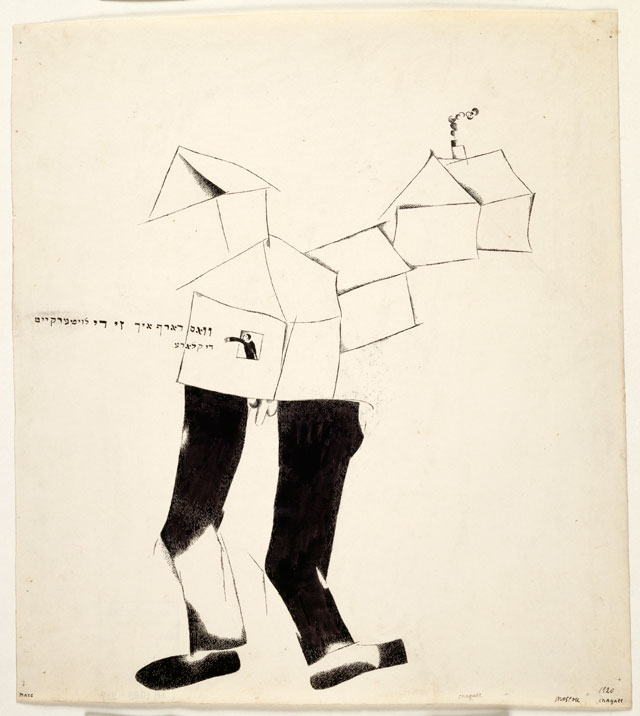
MAPS: a series
Map (OED): Something looked at intently from which you take your bearings.
MAP 1: Lancaster July 2020/Liverpool October 2013
Chagall’s Box
October 2013. I took the train from Glasgow to Liverpool, changing at Wigan North Western to the train made from old bus carriages, that clatters slowly west to the coastal city. My journey is to see Chagall’s Murals for Jewish Theatre that have travelled to Liverpool from Moscow, on their last day of exhibition. They were painted in 1920, in the hunger and chaos of Russian civil war, preserved by luck through Soviet years. The theatre was known as “Chagall’s Box” and is temporarily Chagall’s Box on sea, on the Mersey, set adrift from 1920s Moscow and beached up in 2013 Liverpool.
The room is full of noisy, cheerful visitors, greeting each other in Yiddish and English, under paintings of the wedding feast. There is a party mood and they stride to and fro between friends and relations, three generations or more beneath the painted table high above, set with plates and trident forks, grooved glass soda siphons, tiny triangles of vodka glasses, soup spilling out letters and a man upside down wound into his chair, eating. There are dishes full of fruit — grapes and pears, fishes, unplucked hens on a plate, even a boy on a plate.
The painting opposite it fills the entire wall, twelve metres long, with its world — Chagall and palette, a monocled man in a suit clasping another by the legs, faces peering from behind planes and curves and lines. Flattened echoes of Constructivism, but gentler; red and black giving way to pastel paint and an absorbing sagey green. Here is El Lissitsky bearing a tray of bowls and bottles on his head at the top edge, Malevich peeing on a pig at the bottom. A knife that looks that it might be spearing a pregnant belly but is in fact a circumcision. And Chagall, Tom Thumb size, lecturing from the leaf of a beanstalk. Chagall, lately bruised from his rejection by the avant-garde of revolutionary painting: I told them a square on a canvas was an object neither more nor less than a chair or a cupboard.
Underneath, the party whirls, the excited buzz of North West England’s diaspora who continue these letters, these rituals, still distinct and mysterious to the outsider. At the corner of the next room is The Village Walking, familiar to me from books but never seen. I stop and look close then stand back and listen to the talk of those who pause here, for many do. An old man, humorous eyes, long beard and skull cap sounds out the letters of the hand inked Yiddish, an unfurling scroll of speech: What use to me, the lucidity, the clarity? to his wife who nods and smiles, at the black walking legs and downward pointing penis balanced beneath precarious rooftops. From the window of an ink drawn house a man leans out and ejects his Yiddish lament from Grief, the poem of Mourning.
Lucidity no longer makes sense. Clarity and Lucidity have been negated by events — fear and furies rule. I try to hold and fix it all in my mind, to take it home inside me, its clarity, its surprise.
Chagall’s Box. A man abseils into the world, or rides the circumference of a painted world, snug behind a stage set hill, umbrella in hand, laughing at his own ingenious device. Playful cosmologies, large breasted curves you could jump between; playing hide and seek between worlds as the Chagall self does, in leaps of scale. Hebrew letters swirling through the air like confetti; Chagall at play, discoursing, animating, setting friends, enemies and animals in motion to join the dance in the midst of civil war, embattled by visual and personal politics. Knives, pears, letters, soup plates and banners of words. A panorama peopled from a specific history that is still speaking, to the people looking, laughing, wondering, deciphering; and from the window the Mersey, late afternoon sun and the ferry coming back into harbour.
July 21 to July 28
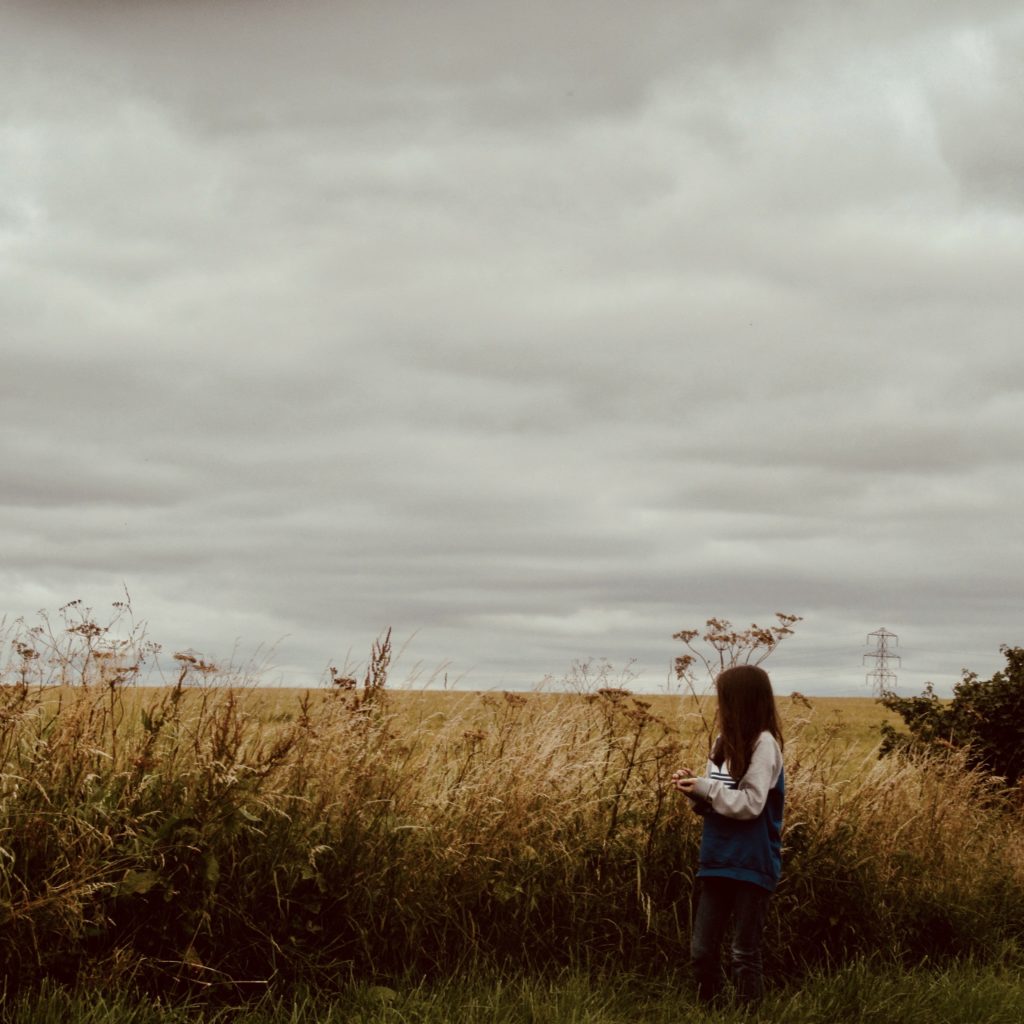
July 14 to July 21
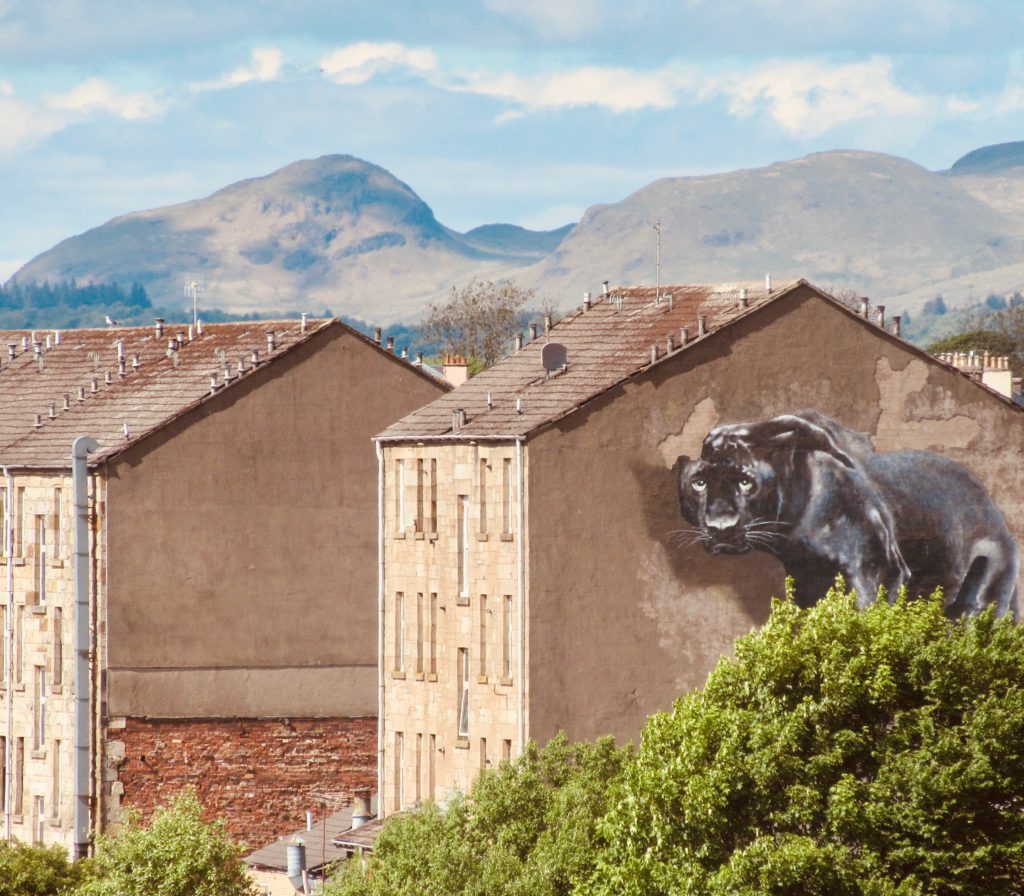
Letter from Glasgow: LOOP
Tomorrow we will drive out of the city, leave it behind and cross the border. We have been lent a small car by friends who have gone to live abroad. The car broke as soon as they handed it over and sat for several days in a garage. I had been hoping that somehow it might not get fixed. I fear cars, and I avoid them. But my stalling concerns the displacement itself more than its means.
Since we were told to stay put I have been circling spaces of the city on foot. Mostly it is just a loop of the streets where I live, three horizontals and two verticals on a hill, but it encompasses libraries, wildernesses and wildflowers. Some days the circle is even smaller: out of the back door, down the the sloped path to the bin sheds at the end of the garden, returning by the side lane and along the pavement to the front door of our shared close. The larger circle goes right to the end of my street, across the road, through the gates and out the other side of the long neo-Gothic University building that walls in my territory at one edge of the hill, down to the river and back through the park. The river runs low through the city, with steep banks becoming tall tenements on each side. When it rains it rises to an umber rush, swollen with sunlight, a warm milky brown, flecked with green willow leaves that it draws down into itself as it navigates the bends with thrilling speed.
I am not constrained by these concentric circles, because of the trick of changing scale. The gentle slopes of daisies and small patches of long grass growing above knee high walls in my neighbourhood can change themselves into enormous fields that stretch before me like an endless country. The sandstone walls become the mottled sand of a beach at the tideline, just by looking.
The canal marks the furthest circle of my lassoing walks. It is raised above the city like a rim. At this height I am exposed, no longer tracing the low paths of pavement or river and their hidden worlds. Here I am the one who has grown, and I look down like a sudden giant on the city laid out in miniature before me, almost in my lap. I stop and see the University and its traceried spire, smaller than the tip of my finger, that marks the end of my street; the library in whose meadows I go to read, whose straight tower and curved roof at this distance show a more convincing outline of the Sienese hill town that their 1960s architect modelled them on. The canal contains the city firmly like a rope. I count the rooftops and name the streets, following their patterns, walking with my eyes.
The canal path leads west to a field of concertina locks, where the roofs peter out with a view to the hills. A few last houses mark the edge of this city, where many more have been pulled down. A large black panther looms, staring back at the city from the blind wall of a tenement, painted freehand on the sandstone; behind it the hills, hovering. The hills are the dusty grey green shades of an Italian fresco, with the same sense of an almost painted-in distance, a scenery painting for the stage, that has been dropped down behind the outline of rooftops and corners of buildings that articulate the end of the urban.
This recent containment has never been a confinement, for all the underlay of anxiety. I have had no craving to get to the hills. I have walked them in my mind’s eye, and watched the light and striating shadows of the quick clouds on their slopes from the corner of my window. I have not felt the restlessness that I felt so often in ordinary times, that drives me to set out on journeys beyond my city. So it seems perverse to take to the road, especially when I cannot configure the space that lies before me, I cannot sense the pattern or the rhythm of it. I know how to inhabit the space of a page, of a room, a painting and the loops made by my walks. I have forgotten the rest and at times I even doubt the world beyond these city walls. Perhaps I will learn it again.
July 7 to July 14
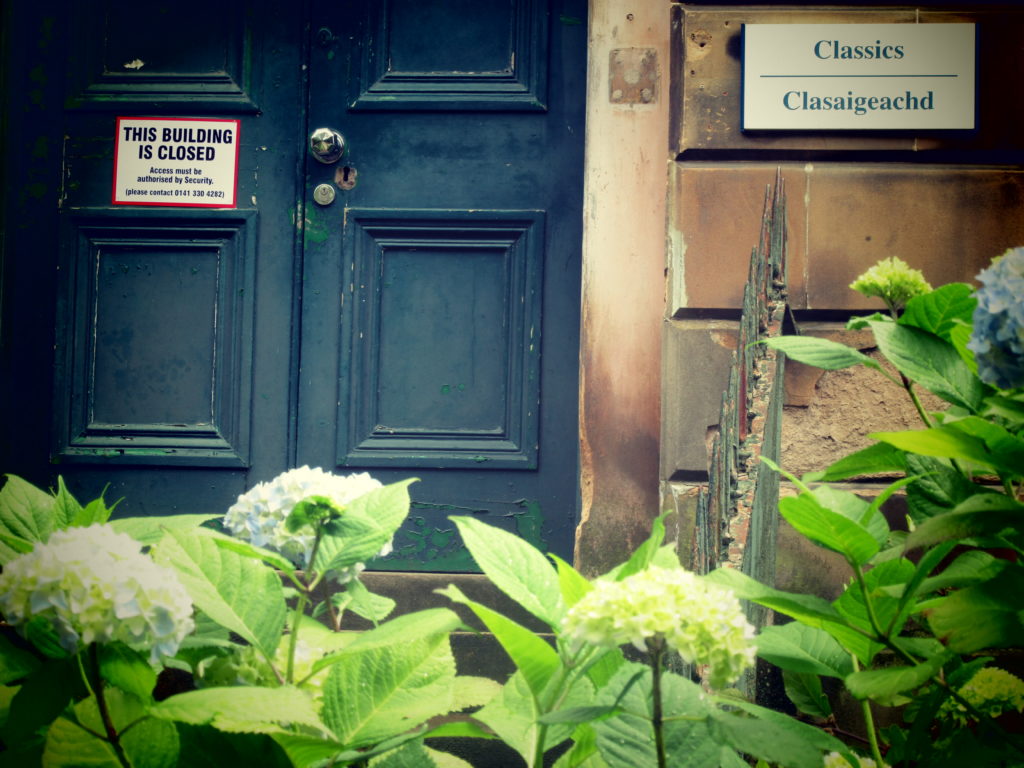
Letter from Glasgow: THE UNIVERSITY IS CLOSED
It’s just after midsummer, the last hour of the day. I have not left the house since I got up so I decide to go out — a late turn around the block. I set off up Glasgow Street to the brow of the hill. The air is warm and completely still. A heap of honeysuckle is tumbled over the railings of a front garden and I plunge my face right inside to breathe the smell of it. As I pull my head out I notice a man outside the hostel the next door down, leaning against the railings, watching me. He keeps watch as I pass and then looks back to his phone. I walk on, stopping to look west through the gap in buildings where the sky is smeared a dirty yellow. It is twenty past eleven. These are the nights that we winter for.
The endless light of midsummer in this northern city makes for a sort of hyper-alertness, accentuated by the ongoing loss of timetables. On the left of the street many of the rooms are still lit up at nearly midnight, curtains open, embracing the imperceptible transition from day to night. On the right, the buildings are empty and dark. From the outside they look like the houses opposite, with bay windows, stained glass detail and turret roofs, with front gardens full of roses and peonies. They look like a neighbourhood. Only the darkness, the odd glint of reflected light from strips of glass in the false ceiling gives the game away. I live on the hill of the University. Most of the houses on these streets are actually University departments, and the University has been closed now for months.
The buildings are deserted and silent but their gardens keep on growing. I walk past rampant beds of roses, magnolia and poppies, they glow in the half dark, before the unlit windows. By the doorways, the signs: School of Humanities, Celtic and Gaelic, Scottish Literature, Centre for Robert Burns Studies and even Historical Thesaurus. I browse the streets like library shelves, noting the flowers in each front garden — their colour and variety. I inventorise the flowers, noting the blooms specific to the department indicated at the doorstep. Modern History: lily, vetch and red hot pokers. English Literature: montbretia, fuchsia and wild poppies. History of Art: fennel, campion and dandelion. Medieval History: foxglove, thistle and meadow sage. Music: peony, celandine and mallow. Classics — Clasaigeachd: striped roses, phlox and hydrangea. Philosophy — Feallsanachd: the shiny fans of Fatsia Japonica or Paperplant.
In a lane between the backs of the houses that hold Engineering on the lower side and Counselling one street up, I have found hidden walled gardens — a row of beehives under wild cherry branches, apple and pear trees, bushes of rosemary, gooseberry and redcurrants and a spreading fig, a secret abundant country. It is a dead end lane, but most days I steal up here, and back again, noting the the ripening fruits.
The grass is feathery and overgrown on the hill between the library and the round reading room, at the far end of my street. The slope is stepped with human length blocks of heavy wood with curved semi circles of white porcelain at one end, like Ancient Egyptian headrests that we drew in museums as schoolchildren. At the start of lockdown they looked so inviting, but I was wary of warnings against shiny surfaces, the prohibition on lying down. Recently though I have lain out on these coffin blocks in the afternoons, placed my neck into the porcelain hold, and looked up at my book, or at the oak and chestnut leaves above.
I like living in the University. I am reassured by the libraries, the students and the endless cycle of learning around me. I have lived here for eighteen years but still feel myself to be passing through. The neighbourhood is largely transient: students who change rooms each summer, carrying their bundles between stairwells and parents’ cars, and a few permanents — a mix of shabby bohemians, artists and musicians and some semi-retired academics with little inclination for home improvement. If the University was not here, the houses not concealing classrooms and offices, then the gardens of fruits and flowers and wild grass might have long given way to the chipped stone driveways of private houses further west. I must be grateful for learning, even if it seems terminally on hold.
It is almost completely dark. I walk past the poster advertising a lunchtime lecture that never took place at the end of March and come back towards my house through the back shared garden. I look up into the space around me, the walls set with orange red rectangles and spaced by black tree branches and think that I have known it better, loved it better and more precisely in the last three months than in all the eighteen years I have been here. I think about the University that has stopped, the grass growing over it, the dark library shelves and the books unread while the gardens glow, chaotic and abundant, and wonder when it will begin again.
June 30 to July 7


Letter from Glasgow: WITHOUT TIME
At first it seemed like a reprieve. The injunction to stay at home, to cancel onward life. It was something I had always imagined I wanted. Especially when leaving on a journey, looking back into my room, the waiting shelves of books, as I picked up my bag to leave it. Leaving behind a room full of promise, a great fat pocket of time, about to be trodden into streets.
Then I notice how hard it is to let time be, how much I need to mark it. I make timetables proposing a virtuous apportionment of hours, for myself and for my children. We do not keep to them. Instead I take cues from my surroundings; slowing to the rhythm of light, air and sound, trying to establish where I am in space through the echoes in the back court: the burr of wood pigeons and the soft melodic cough of the man in the flat below. These establish the rhythm of each day. The diary, its page of daily rectangles, is not enough.
I have to learn how to inhabit this given space. At the start, I keep falling asleep. The economy is described as “in hibernation”, a sort of deep freeze, from which it should emerge as fresh as peas. The image is meant to reassure but no-one really believes it to be so simple. There is a Russian word that surfaces when I am writing to a friend in Moscow: Безвременье, Bezvremenye. It means a sort of stopped time, a non time — out of time, even. It can also mean a heavy time, a dark time of stagnation or calamity. But I do not hear it so negatively.
Time out of time, without time. A time of suspension, a holding time. Except that this is not a time for holding anyone but the people inside your house. If you have people in your house.
I can spend a long time watching a net curtain blowing in and out of the sun from a shaded window in the wall I look onto from the back of my flat. I follow its rise and furl and feel the pulse of the slow breeze. It is a way of putting myself in place, of finding myself held.
Before digital photography I used to take a lot of photos but eventually I stopped developing the films. I liked the moment of capture, but I did not want to see what I had made. In fact I feared this with a stubborn fear. Perhaps the trapped images were too much proof of loss. I hold on to the films still though, degrading in their plastic capsules, steadily releasing the captured light to merge back into dark, a quiet coalescence. I cannot throw them out but I refuse to develop them and eventually the unseen images will return to darkness. It is a bit like the notebooks lined up in rows above my desk. I need each month of every year to be accounted for and placed in order, decades of words laid down. But I avoid taking them down to look inside.
We chart time backwards. At the start, friends with extra hours to hand sent photographs from twenty, thirty years ago, rooted out from shoeboxes where they might have remained unlooked at for as many years again. I glance at them and wonder if I felt older then, or now. On the radio they play “live” performances from years ago. What year is it tonight?
I find it hard to believe in onward time. I don’t believe that this can be a time of ageing or increment. It should be a time without anniversaries — a non quantifiable time marked only by light, the stir of wind and the quiet sounds echoed in the back courtyard.
My children prove otherwise. I had thought that if I stopped being so restless, always on the move, that my children would elude me less, might pause their fast morphing into young adulthood. But my constant attention seems only to accentuate the speed of change. They outstrip me more forcefully for being observed at close quarters. I can almost hear them growing. They emerge each morning a little longer, the down on my son’s top lip a little darker. It’s the same, I think, with this new noticing of changes in trees and flowers. I see them more sharply now, but they seem to leaf and spread, bloom and fade faster, more noisily for being watched.
Bezvremenye. Outside of time. This word for time without time should not invoke heaviness but light and air. A hiatus that does not have to be constantly marked or put into words. A space where you don’t need to take notes because you can inhabit it fully and to overflowing, without anxiety — without fear of loss or risk of oblivion. A space that holds everything, permanently vivid and immediate.
At quarter past four each afternoon two women come down Glasgow Street and turn into my road. They walk slowly, speaking Polish. I presume them to be mother and daughter but of course they may just be friends. From the lane on the other side of the building, at closer to five o’ clock a mother about my age, her daughter and her mother from the flats opposite take their turn around the block. They process past my window: the grandmother with a stick, her daughter keeping pace with her, the granddaughter running out ahead. This is the clock.
I keep an eye on my territory. I am faithful to it, vigilant. There is talk of easing but I am reluctant to move.
June 23 to June 30
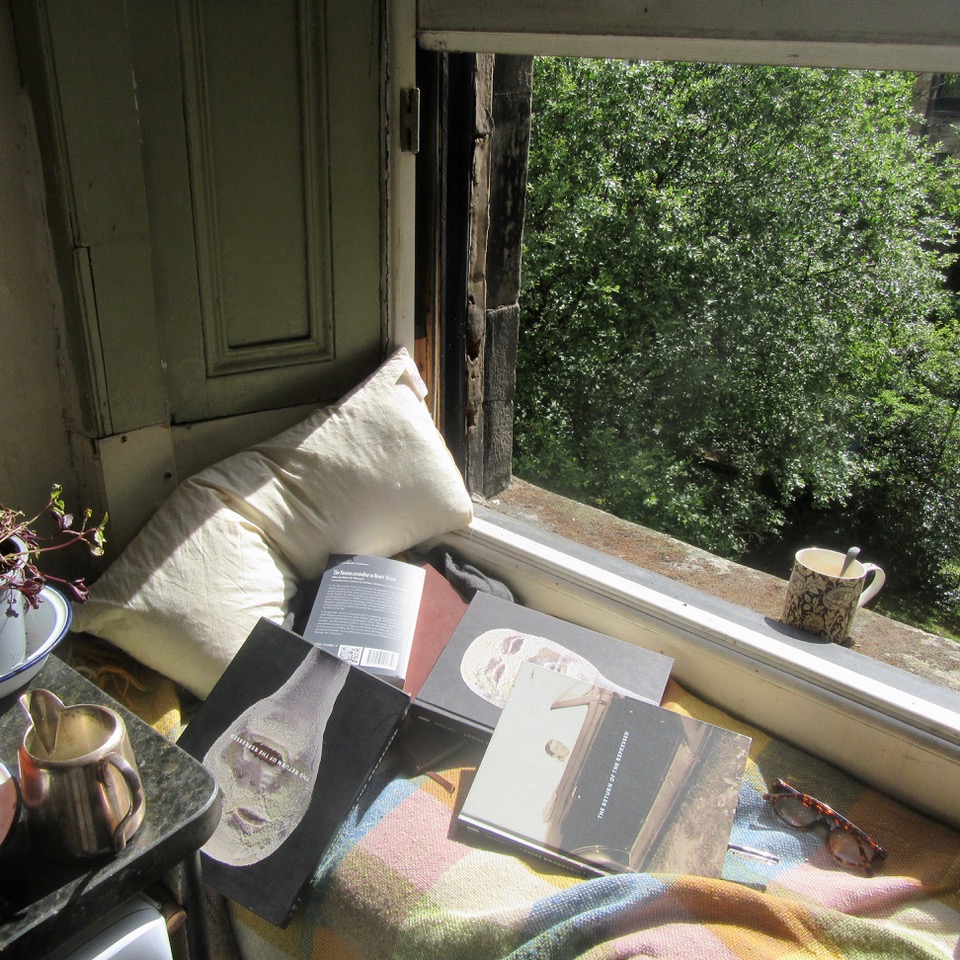
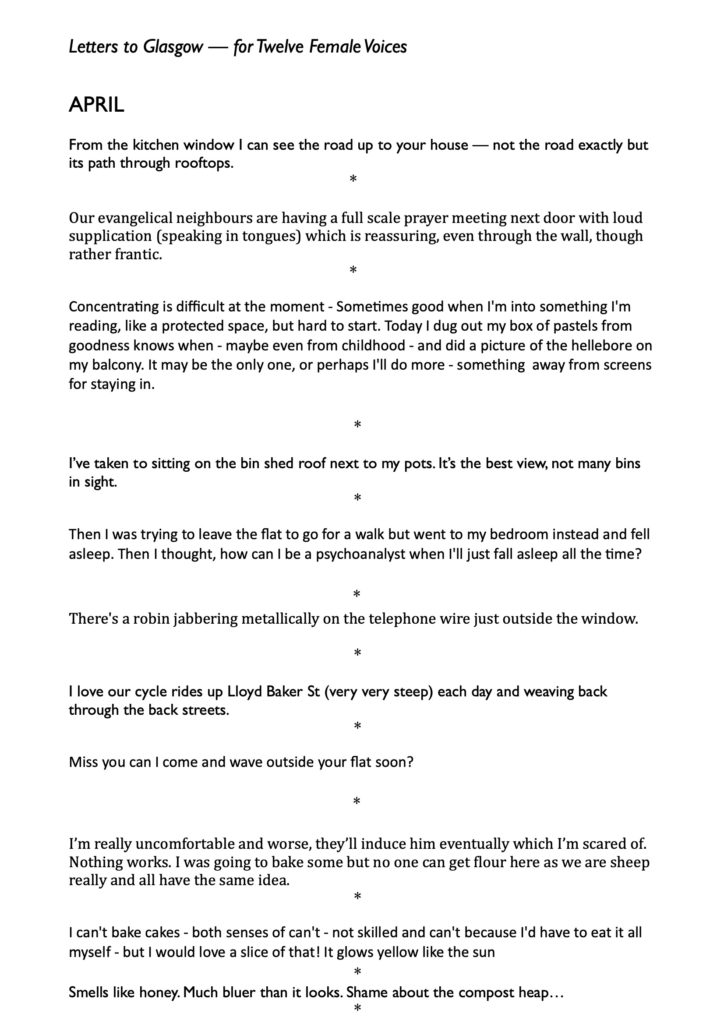

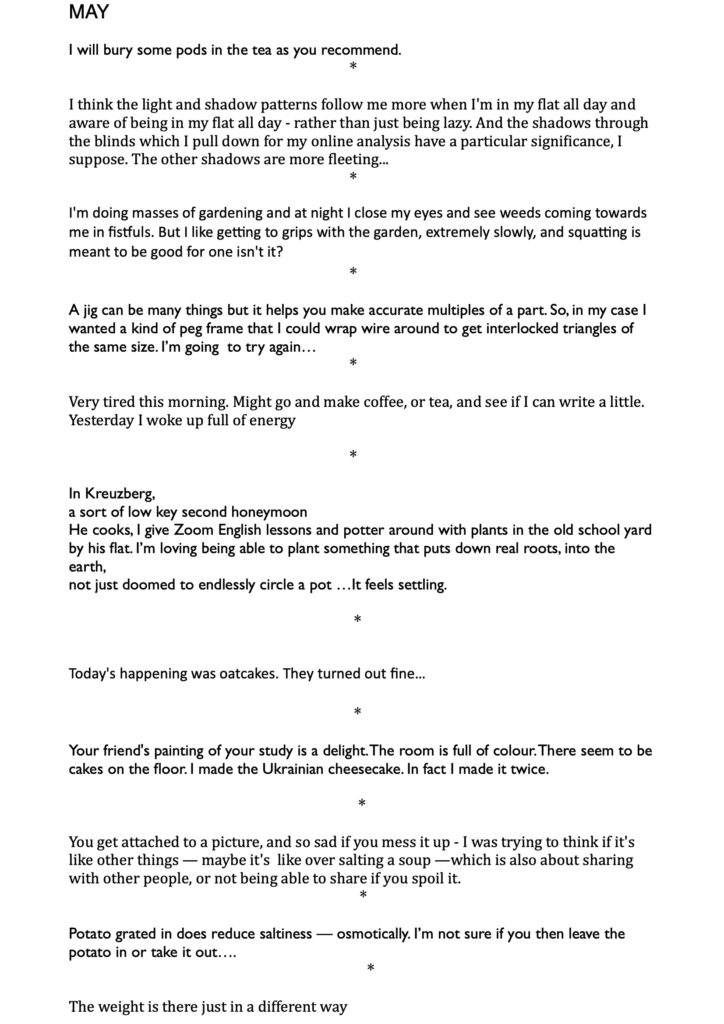

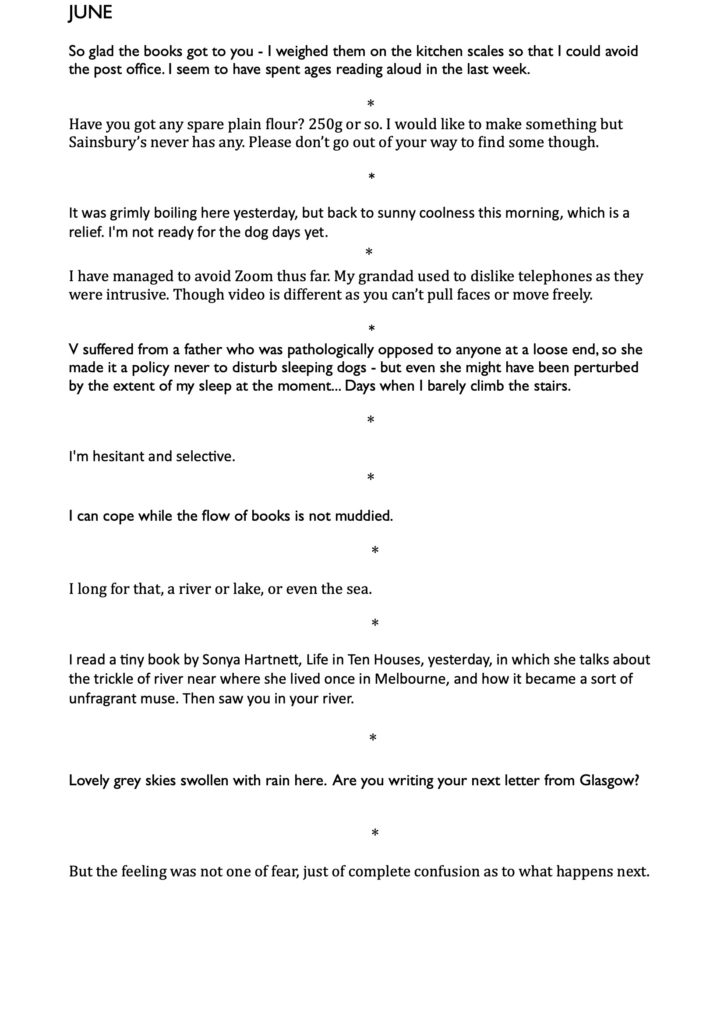
June 16 to June 23
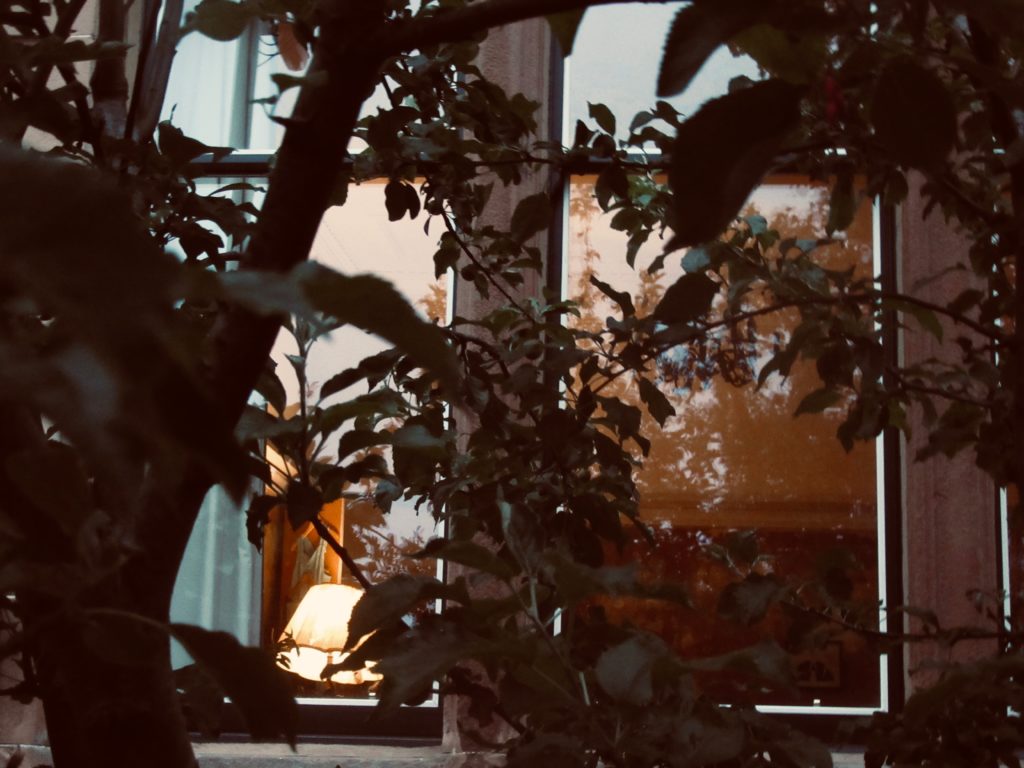
Letter from Glasgow: WITHELD
My daughter is reading a book about a woman who breaks into people’s houses because she thinks they hold a part of her. Something she needs to steal back.
At least that’s how she tells it. I think of this, when I am out walking, in the evenings especially. I look in to rooms that glow against the dusk, waiting for something that catches my eye. In this way you might notice something that feels more fully yours, more recognisable than any of the rooms that you have just shut the door on. It’s not exactly the shape of a room, nor any particular objects or furniture, or even the light that does this — but something that is the sum of these material conditions and yet escapes them. A precise, yet unnameable thing — a shape without mappable contour or definition but with colour perhaps: dark yellow or reddish orange or even deep green, blurred at the edges, and a weight that you sense within. It is not certain whether this weight is something that enters you from the seen space or is solicited from inside you, by looking. It is something that seems to have been always there — more intent, more intimate and close than the surroundings you have consciously made for yourself. Something that you have mislaid, or forgotten.
You are caught off guard. Stopped short by the sense of it, this sudden hold. Sometimes, you retreat, go back on your steps and pass by the window again, more slowly this time, to see if you can sustain the feeling for longer. You may linger, at an angle, behind the garden hedge; although these days when everyone is at home it does not do to linger at people’s windows too long. Better to pass and pass again, two or three times, affecting purpose, gathering flashes that imprint and layer themselves on your inner eye. The thought of breaking in is vivid — all the more tantalising now that any incursion, even unwitting, on another body is taboo. We cannot countenance just how much we are not allowed to touch, and the impossibility of actually grasping what we need makes for fantasies of a violent and spectacular shattering. To suddenly smash those front windows and enter the forbidden space. The image shocks and compels; a transgression that is defiant and exultant. A woman breaking in to claim something of her own — refusing the passivity of mere reverie —to rupture the dream space that is forever withheld.
But I keep walking. I think of the woman in my daughter’s book smashing glass. It merges in my mind with a video I saw long ago in Paris: Pipilotti Rist’s film of a woman walking down the street, in a slowed down bouncy way, bearing a long flower, a lupin, or is it a red hot poker? She is wearing a floaty dress, her hair is loosely tied, and she walks in step to the humming, trance like music, springing gently along the pavement. As she walks she smiles and swipes with this flower at the windows of the parked cars along the kerb. The glass smashes and clatters but the mood music hums gently on, holding her, holding us. A passing policewoman smiles and salutes her. The woman is radiant, exulting and self-sufficient as she buoys along, swinging the flower. There is something in this that connects to the woman in my mind breaking into houses, and to my belief in her, in her right to steal in, to shatter windows, to take back that which has been lost or denied her.
I keep on walking, quietly, in the shadows.
POLYPHONIC MANIFESTO

June 2 to June 9

Letter from Glasgow: BETWEEN THE CLOCK AND THE STREET
I watched the film Permanent Vacation again the other night. I didn’t pay too much attention to the words. It was this image I was after. A girl in a room, looking out. I found the shot, but it was the street scenes that held me — lower Manhattan, derelict at the end of the seventies — empty abandoned streets that are suddenly immediate, right up front and now. I want to follow these streets on and on. I imagine a film that splices together continual streets, one leading into another, from seventies New York to nineteen fifties Moscow, or Rome, or Prague and on through cities I have never walked. A continual street without end. It would be seamless, in the way that Christian Marclay so deftly spliced spiralling staircases, minute to minute, in his twenty four hour The Clock. As in that film you feel that you have to keep on walking, you can’t break off.
But I am compiling images of rooms, not streets. I am making a slide talk for the students whom I haven’t seen since February: Between the Clock and the Bed, Munch’s late painting where he stands like the grandfather clock at his side in a small room filled with his paintings, receding into the space behind him. There is a photograph of him in that same house, surrounded by the same paintings, more clearly defined by the camera. I put in a photograph of Chagall, newly arrived in Paris, sitting on the bed with his wife and daughter, and around them his landscapes of left behind Vitebsk set in the decorative curls and scrolls of drapes or carpet that have been hung on the walls of their new apartment, Russian style. They are tented in by the dark drapes, with windows only to the East.
Then there is a photograph of Bonnard, painting Marthe in the bath, canvas pinned up roughly to the wall, seemingly untroubled by the flamboyant overgrowth of the wallpaper all around it as he pursues his self-sufficient, almost immaterial world of purple, turquoise, gold within the canvas.
I sit in my room, the sheet covering the window, and I click through these images for the thirty boxes on the screen: the students, also in their rooms, these stamp sized squares, revealing slight blurs of colour or light, the indications of a surrounding in muted colours, withholding any sense of the space between us. It is the first time I have shown slides like this, to thirty separate rooms. Usually we are all in one room and every nuance, every slip or focus of attention from the viewers is palpable. But now I am not sure how to reach them, if I reach them. It is hard to judge distances.
I wanted to show images of rooms that were also about the possibility of flight from the room, of painting down the wall, opening up a new space and inhabiting it as you make it. A painting sized window out. But I wonder if this is what they want, or if the image of Bonnard pushing his brush right up against the wallpaper to make his bathroom world seems a world away. But February is a world away, and maybe Bonnard’s room is closer than ever?
It is hard to judge distances. One compensation of this hiatus we inhabit is the immediacy of reports from the past: in a film, a photograph, or in the streets that I walk through reading. The Bloomsbury squares and pavements full of incident in Virginia Woolf’s diary of 1915, or New York’s Riverside Drive in 1968 that itself gives way so suddenly to wartime Mecklenburg in Uwe Johnson’s Anniversaries. The density of sky over the Hudson summoning the banks of the left behind river close to the Baltic Sea. I read scattershot, but am able to inhabit these places more fully than ever. Time has stopped and I am less interested in a narrative arc, a drama or romance than these fixings of place; how it was, at a certain time, in a certain place; the word pictures that allow me to walk through these remote but immediate worlds.
After the talk, I leave the screen and go out for a walk, to rest my eyes. I walk up the hill on the opposite bank of the river, where the houses rise steeply. In a lane that runs between the backs of two rows of houses I am stopped by the sudden space of a high window, looking straight out through the window on the other side, as if the wall had given way into an infinite space of light and green. Is this the sort of opening I was trying to get across?
At the end of the film the hero leaves the city on a boat, and as the boat pulls out the jazz saxophone that has played throughout the film starts up again, a mordant improvisation through which emerges the drift of, yes, the familiar notes of Somewhere Over The Rainbow, stuttered and spiralling, in a minor key. I am tired of Rainbows, but this is pitch perfect. The camera hovers at the end, holding the whole of the city island in its hand. Is the boat still pulling out, or staying still?
It is hard to judge distances.
May 26 to June 2
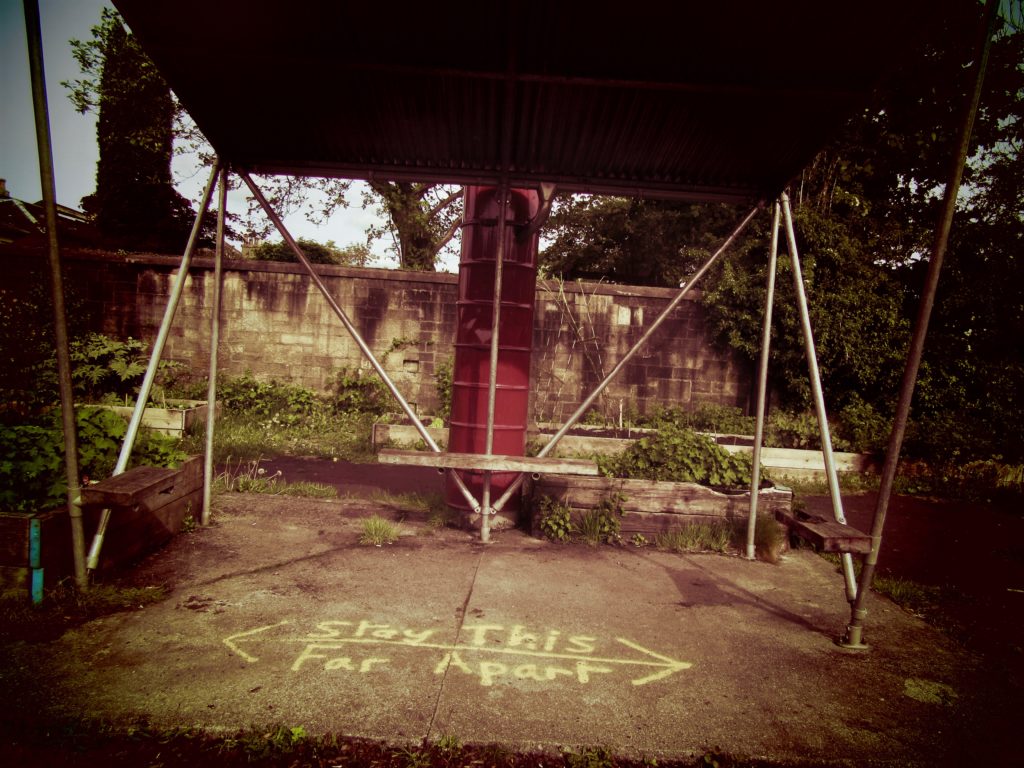
Letter from Glasgow: STAYING APART
Friday night. The wind pushes the tree about outside my window. It stirs and turns it. I see it with my eyes shut — enormous, churning and stirring, moving me through the night. Then I let myself see a little further, picturing the empty theatres, concert halls, bars and night clubs dark and silent at the centre of the city. I do not normally allow this, it is too unnerving. I return to the rhythm of the tree.
Yesterday, after sixty days of keeping to the house, to the neighbourhood, I made a break for it. I agreed to pick up a parcel for someone from the ASDA on the outskirts of town. It would mean a walk of several hours, a journey. It was a warm afternoon and I set off at a brisk stride, excited by what I might see, at the chance, even, of the unpredictable. I chose the way through houses, rather than along the river. I wanted my journey peopled, if only by buildings.
At the point where the grander flats near the river give way to more run down streets, I cut through a low level estate, set in an old army barracks. It is quiet, a few people sit outside their doors. This is not my territory and I must observe discretely. I am looking for what is different since I was last here in the time “before”. Most of the shops were boarded up anyway so that is nothing new. I find a path through undergrowth that I guess leads to an abandoned modernist school I once came across this way. It is concealed in the overgrowth of trees and brambles. I am relieved to find that it is still here, the playground with its markings, moss and broken glass. I take in the light falling on yellow walls of empty classrooms through wide windows.
Across the playground a man stands waiting in a doorway. He is young and he watches me a bit edgily, as I do him. We assess each other for potential danger; a risk not of contagion but of interference. I take some photographs of the windows and he seems reassured. I leave the playground, find a gate out to an unfamiliar new estate. I walk through it, guessing my way. I haven’t got a smartphone or a map and I had forgotten you can’t approach people for directions any more.
In the tiny front garden of one of the houses a family are cutting grass. I try to work out what language they are speaking in, I think it might be Tamil; the man has an elegant tiger tattoo. He nods as I pass. I head up through the estate, back to the main road where a woman with shopping bags alerts me to the chance that this is my turning. When I have collected the parcel I don’t want to go straight back. I keep heading out, through uncharted estates, cul de sacs, navigating roughly with an eye on the hills.
I find a turning into a park. An old Victorian sort of park with a path through wide chestnut trees, in candled bloom, that remind me of the broad commons in the city I grew up in. There is a row of red sandstone mansions at the top looking out. One has a monkey puzzle tree outside. I walk up and find two overgrown bowling greens enclosed by tall hedges, and rusty tennis courts sprouting weeds. A world of leisured modest grandeur, long decayed and overgrown.
By the garden walls of the mansions a small community garden has been planted, in beds made from old wood planks. A shelter has been put up in the centre, from scaffolding poles, planks and corrugated iron. It reminds me of an image from a book of photographs of bus stops in remote outposts of the former Soviet Union. On the ground, yellow spray paint marks arrows and the injunction: Stay This Far Apart.
I sit up on some railings, looking at the shelter, the wall behind it and the rusty tennis courts. A couple are on a bench nearby, facing towards the hills. They are drinking Irn Bru. The late sun comes straight through the raised bottle, a distinctive amber.
I sit and wait. The light shifts slightly. The couple get up to go. A phone rings, “I’m in the queue at ASDA” says the woman. I follow them out of the park, keeping my distance. Stay this far apart.
May 19 to May 26
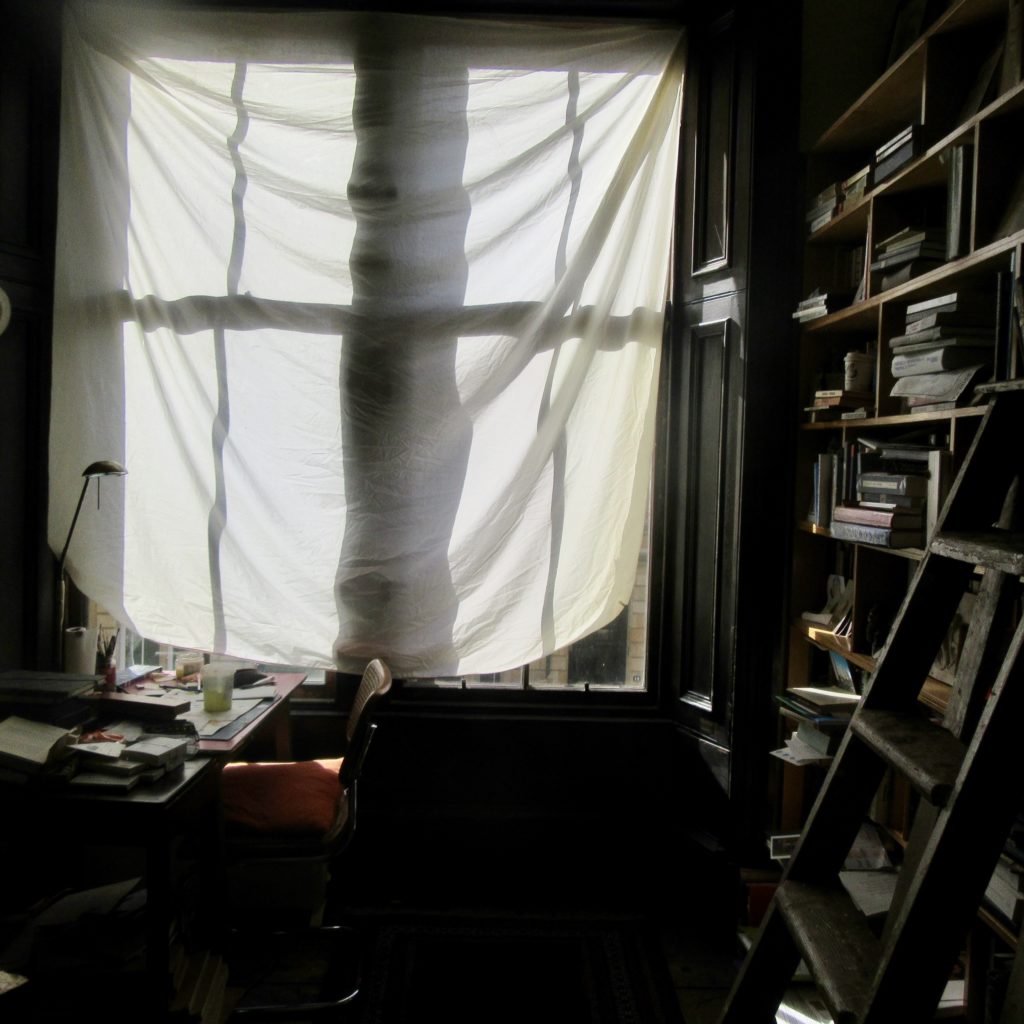
Look at what the light did
The light is so bright now. And too thin, as though it has lost a layer. It is so sharp it is unnerving, it might actually cut. A complete absence of diffusing haze from planes or cars or everyday pollution.
A change in the atmosphere.
This almost etiolated light seems to make the shadows flicker more quickly, nervously. Shadow darts of birds swoop silent but startling at the edge of your vision and then vanish.
In the evening the light comes in full blast to my work room. It hits the books on their birch ply shelves that I had made for them four years ago. Russian books sit on Russian birch. The light makes a square that effaces all detail, like the over exposed part of a photograph.
The other day I noticed how bleached the books are becoming. They are leaching pigment before my eyes. The strong covers of red or orange or yellow and even blues are fading and dissipating. Like plastic bottles or buoys that float in on the sea tide, picked clean and pale by the sea. The light erodes the spines and the titles also, words dissolving, almost indecipherable.
What if the words leaked away from the pages also, and there was nothing left? I imagine these books becoming entirely white, the letters and spines turned by the sea light, eroded, excoriated, worn away.
Small albino worms, blind in the dark earth.
I have never worried about this before. I used to enjoy the way the light fell in, early evenings on the golden shellac varnish. I used to come out from the shadows of the kitchen opposite, and lean in the doorway, indulging the glow along my shelves, following its fall, book by book.
Now I am anxious. Words are vanishing while I look at the light, while I look the other way. I must take immediate action. I go to the cupboard in the hallway and pull down a large thin sheet, it is too big for my bed. I fetch a ladder and I loop the corners of the sheet around the cup hooks that have always protruded from the top edges of the window recess, from when this flat was full of students I suppose. The sheet is too high up for me to adjust it in any way and so it must hang there day and night.
The room is shrouded now, like furniture in a shut up house.
A measure of protection.
May 12 to May 19

Letter from Glasgow: GHOSTS
What does the world do when it is no longer looked at?
Each morning I take up my watchpoint in the kitchen window seat, to be ready for the light when it first strikes through the tree.
The few cars on the road the other side of the rooftops roar past like the sea. Bachelard first helped me to notice this. The seagull cries confirm it. The noise strengthens each morning now.
This city is the closest to the sea of any that I have lived in. The weather is tidal. You can feel the fret in the air, sometimes almost smell the salt in it.
When I lived in Moscow I was far from the sea. I look out from my window and practice my favourite trick of changing place. Now I am here, now I am on Masha’s balcony. I am leaning out over her treetops on Malaia Bronnaia. I am slightly higher than the trees, looking down, not into, the branches, as her balcony is two floors higher than mine. I rise up easily. I am looking out, immersed in her tree branches like a sea at my feet, with the street beyond that leads in the direction of the Kremlin.
I am slightly nervous that the balcony might give way — the rusty metal struts are exposed in the concrete that is soft and dark grey, like the sunflower seed halva that we used to buy as a treat when I lived here, thirty years ago. I look down on the broken tiles and cigarette butts from all Masha’s cigarettes, smoked in secret pleasure, at night or in the early mornings, in hiding from her husband, in the company of her cat.
I step back into the flat, past the cat sat in a square of sun on the parquet, and follow the the wobbly wooden blocks, avoiding the gaps, back across the room, along the smooth dark lino corridor and open the thick padded door that gives way softly, to the kitchen.
I pour myself some zavarka, the cold stewed tea brew from the night before, and add some boiled water. I sit down at the table, reach for an issue of Iskusstvo Kino, the Soviet cinema journal, from the thirty or forty copies piled up on the sideboard. Something from the late eighties or early nineties. And I wait for Masha to emerge.
I write to my friends. I want to to tell them that I am still here. I am still at their table, moving through their rooms. I am on the balcony.
Masha waves.
May 5 to May 12
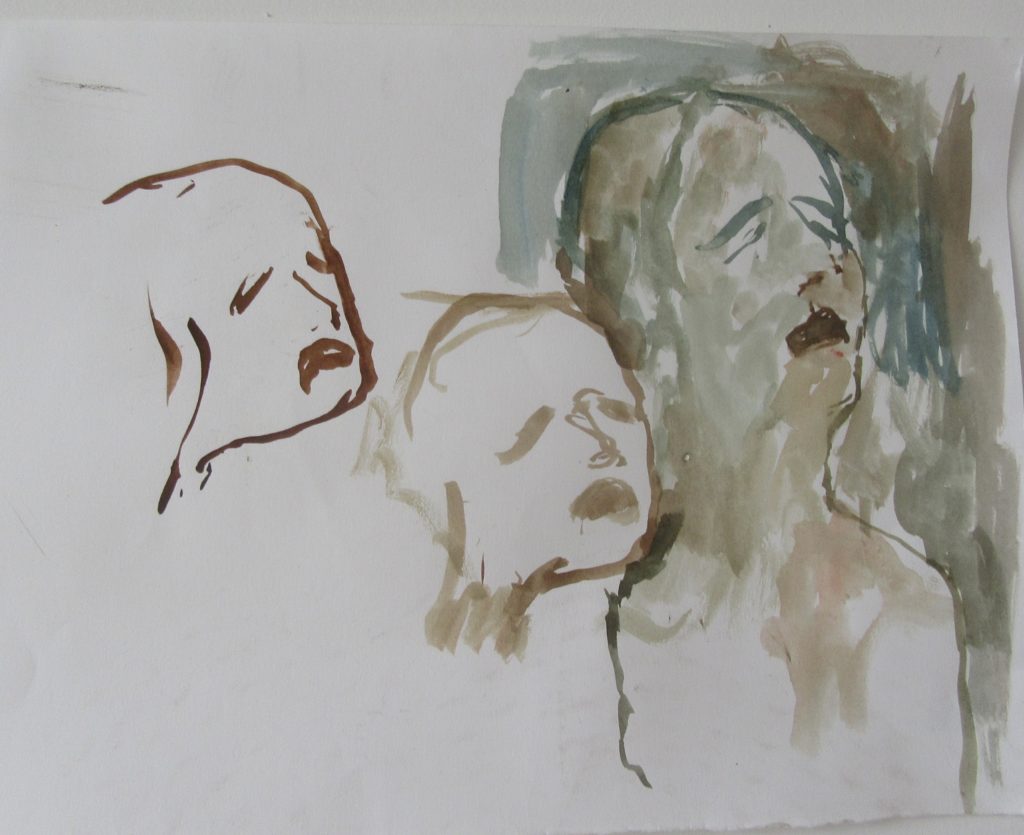
Letter from Glasgow: TREE SHADOWS
I used to joke that the only residency I’d apply for would be one in my own home. Well, I have my wish. Only I didn’t imagine so much cooking.
I’m at home, two floors up, with my books, my drawings, my piled up drafts and files of writing, thirty three years of notebooks on the shelves, and also with my children, who must be fed and attended to at intervals.
It is not exactly how I imagined.
It was a relief at first to stay put. I have often longed to stay put, to stay in, hidden, while the world went on at full tilt, not noticing my absence. It is different when all the world is staying put as well.
I move through the rooms of my home, following the light faithfully, catching every last drop. I watch the way the light falls, bounced from the windows of the tenements opposite, making shafts that cross the hallway of the flat and meet the light coming in directly from the East facing windows opposite. I move through the rooms on the East side until midday and then wait until the sun has rounded the corner of the building and starts to come in from the West. I watch the way the light cuts shafts and angles through the trees, slicing the high branches, along the street and in the back garden, where the birds have taken over and flit freely, marking their territory. A bullfinch flies up into the last of the sun, a flash of perfect orange red, as a finger nail moon rises over the slate roofs to the East.
The streets are silent but it is an insistent sort of silence. A sort of humming, a nervous drone. It is disconcerting.
I don’t like it this quiet, says my daughter, on the first or second day of staying in.
My friend Sinéad sent an email, maybe a month in. “This is a time for non-productivity, if you can”, she writes. I am much cheered by her words, They answer my instinct which is to watch, to wait, to pay attention.
In the first month I drew each day, but less urgently now. I am reluctant to launch into new endeavours and this is not an ordinary deferral, a failure of will power. I think my friend is right about watchfulness.
She herself is not so free, having been engaged to direct a play: Antigone, in California this term, and unable to travel, is now directing it remotely by internet, following American hours. They will make the piece digitally, a leap of faith for someone whose work is so much about embodiment.
But I know that she is also watching, and waiting.
Another friend, a violinist, turns up one morning with a box of seedlings that she leaves on my doorstep. I wave down to her from my window. She lives alone. So far she is glad of the respite from a frenetic timetable of practice and performance. She is cooking, varnishing her floorboards, following the sun from room to room around her flat, like me. But for how long?
I am grateful for the light, every drop of it., through leaves, through blossom, on the sandstone walls of the tenement flats where I live. My flat is a ship moving imperceptibly slowly through trees. The leaves are the sea and the sandstone wall is my beach, especially at the back of the building where it loses its smooth facing and reveals the ripple and mottle of shell fossils, ruckled like sand, in pale blonde and golden and reddish bands, like the different densities of sand as the tide recedes. The surfaces pitted and scored, or suddenly flecked by rain.
Light and the shadows of things pattern my day. They offer a precision that you can attempt to be true to in words. The way that a tree makes shadows on a wall, blurred and watery or in sudden sharp edged focus, or both at once. But at night I wake and worry about how much of the world is not being looked at. I picture yellowed walls in the emptied corners of far off cities who remain neglected, unseen. They no longer have anyone to look at them, to keep watch as the shadows change in late afternoon; to be held by them, to maybe even put them into words.
Liza Dimbleby lives in Glasgow. She has also lived in London, Paris and Moscow. She has led drawing walks in all these cities and also in Orkney and Siberia.
www.lizadimbleby.com instagram: @lizadimbleby




